Show HN Today: Discover the Latest Innovative Projects from the Developer Community
 ShowHN Today
ShowHN TodayShow HN Today: Top Developer Projects Showcase for 2025-07-16
SagaSu777 2025-07-17
Explore the hottest developer projects on Show HN for 2025-07-16. Dive into innovative tech, AI applications, and exciting new inventions!
Summary of Today’s Content
Trend Insights
The projects showcased today highlight a clear trend towards empowering users with technology. We see a surge in AI-driven solutions that simplify complex tasks, from music production to data analysis. Developers are building tools that directly address user needs, whether it's automating documentation, making data exploration faster, or making app development more accessible. The prevalence of open-source projects underscores a commitment to community collaboration and transparency, inviting developers to build upon existing frameworks to create something even better. The combination of these trends suggests a future where technology is not just powerful, but also intuitive and accessible to a broader audience. Embrace the hacker spirit: experiment, iterate quickly, and always build for a specific problem. Don't be afraid to explore novel approaches and push the boundaries of what's possible!
Today's Hottest Product
Name
SynthGenie – Natural Language to Sound Design for Hardware Synths
Highlight
This project uses AI to translate natural language prompts into MIDI commands, allowing users to control hardware synthesizers by simply describing the sound they want. This is a significant step towards making music production more accessible and intuitive. Developers can learn how to integrate AI with hardware and explore new possibilities in human-computer interaction within the music space.
Popular Category
AI & Machine Learning
Developer Tools
Open Source
Productivity Tools
Popular Keyword
AI
GitHub
Open Source
LLM
API
Technology Trends
AI-powered Automation: Leveraging AI for task automation, including code generation, documentation, and content creation.
Local-First Applications: Developing applications that prioritize local data storage and processing for enhanced privacy and performance.
Simplified User Interfaces: Focusing on intuitive and easy-to-use interfaces, often using natural language or visual tools, to lower the barrier to entry for complex tasks.
Integration of AI with Hardware: Integrating AI with hardware, particularly in music production, demonstrates new use cases for hardware control and interaction.
Tools for Enhanced Data Management: Creating tools for better data exploration, management, and visualization.
Project Category Distribution
AI & Machine Learning (25%)
Developer Tools (30%)
Productivity & Utilities (25%)
Content Creation & Media (10%)
Other (e.g., Games, Finance) (10%)
Today's Hot Product List
| Ranking | Product Name | Likes | Comments |
|---|---|---|---|
| 1 | ZeroRank: Elevating Search Accuracy with Elo-Inspired Reranking | 157 | 52 |
| 2 | Twiorg: Interactive Storytelling with Emacs and Twinery | 124 | 17 |
| 3 | Chronos: Giving LLMs a Sense of Time | 79 | 36 |
| 4 | DataRamen: Local-First SQL Explorer | 45 | 51 |
| 5 | Cobble - The Daily Word Constructor | 21 | 15 |
| 6 | CivicHub: Open-Source Political Platform | 11 | 4 |
| 7 | GitGuard: Declarative PR Automation Engine | 11 | 4 |
| 8 | HN v0.2.1 - Native macOS Hacker News Client | 7 | 6 |
| 9 | TXT Blah Blah Blah Lite: Offline AI Reasoning Engine | 5 | 7 |
| 10 | CanvasFlow: An Infinite Note-Taking Canvas | 4 | 7 |
1
ZeroRank: Elevating Search Accuracy with Elo-Inspired Reranking
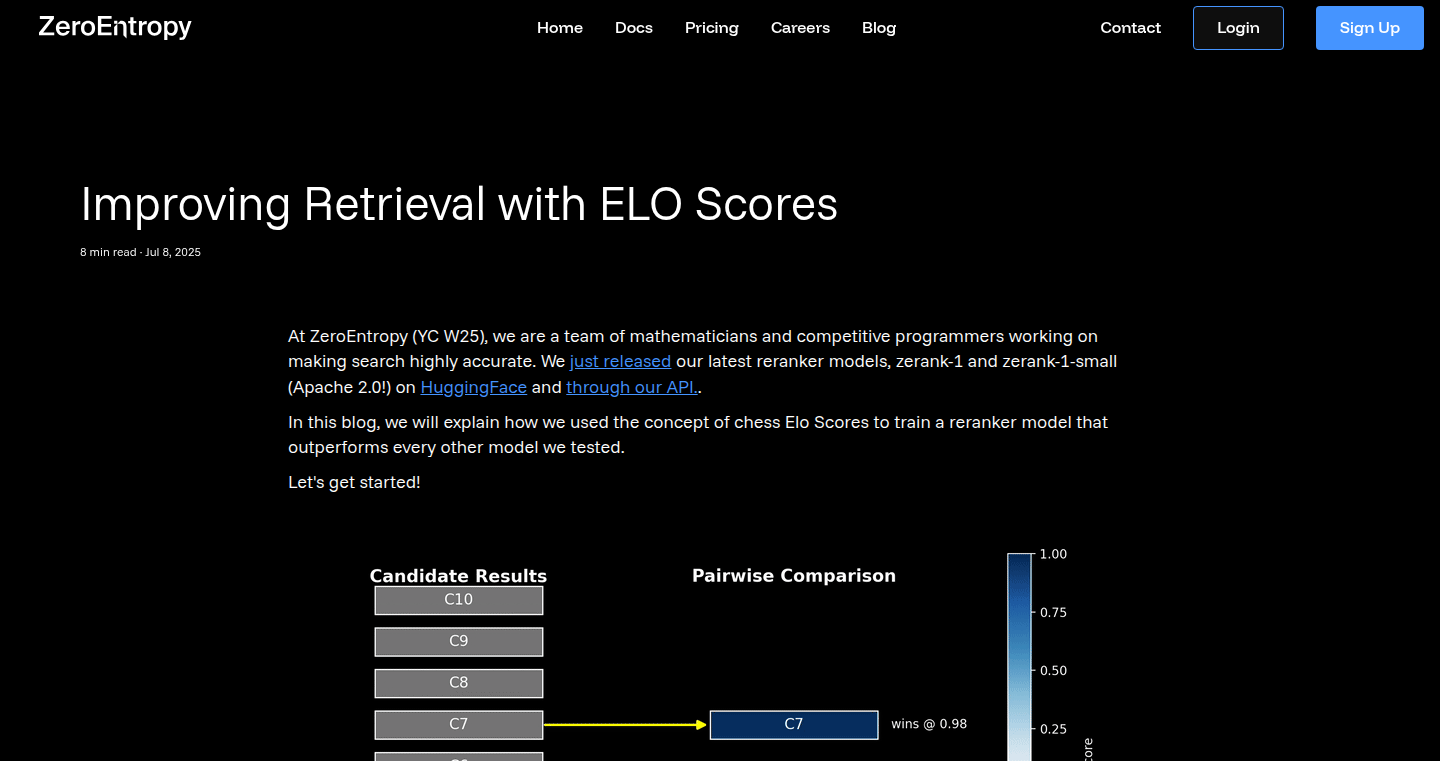
Author
ghita_
Description
ZeroRank introduces cutting-edge rerankers, zerank-1 and zerank-1-small, designed to significantly improve the accuracy of search results, especially for Retrieval-Augmented Generation (RAG) and AI agents. The core innovation lies in its Elo score-inspired training pipeline. Instead of traditional methods, ZeroRank uses an Elo-style rating system, commonly used in chess, to compare documents. This allows the model to learn from pairwise comparisons of documents, creating a more nuanced understanding of document relevance. This method includes collecting soft preferences between documents from LLMs, fitting an Elo-style rating system to the comparisons to give each document a score, and normalizing relevance scores across queries. The open-source version (zerank-1-small) offers a practical solution for developers seeking high-accuracy search infrastructure. So this means your search results will be better, making it easier to find what you're looking for.
Popularity
Points 157
Comments 52
What is this product?
ZeroRank is a search reranking model, like giving your search results a second opinion to improve accuracy. It uses a new training method inspired by the Elo rating system, which is used to rank chess players. This method trains the model by comparing pairs of documents based on how relevant they are, then assigns each document a score. This score helps rank the search results more accurately. The model also normalizes scores across different searches to ensure fairness. So this helps you get the best search results possible.
How to use it?
Developers can integrate ZeroRank into their search applications through an API or by using the model directly from Hugging Face. This can be used to rerank results from existing search engines, like ElasticSearch or other custom search solutions. The core idea is you send your search results to ZeroRank, and it gives you back a more accurate, better-ordered list. For example, you could plug this into a customer support chatbot that uses a search function to find relevant documentation. You can use ZeroRank to refine those search results and get the most relevant answers. So this means less time spent searching and more time getting things done.
Product Core Function
· Pairwise Document Comparison: This compares documents to determine which is more relevant to a search query, using the soft preferences collected from multiple LLMs. This gives a richer understanding of document similarity. So this means you get better ranked documents by letting the model compare them side-by-side.
· Elo-style Rating System: Employs an Elo-style rating system to calculate absolute scores for each document based on the pairwise comparisons. This transforms relative comparisons into a ranked system. So this means search results are better prioritized because it calculates how good each document is.
· Bias Correction: Corrects for biases across different search queries to ensure consistent relevance scores. This step makes sure the search results are accurate across various searches. So this means your search results are consistently high-quality regardless of what you're searching for.
· API Integration: Provides an API for easy integration into existing search systems, allowing developers to quickly improve their search accuracy without significant code changes. So this means developers can easily improve the search quality of their applications.
Product Usage Case
· E-commerce search: Enhancing product search by reranking results based on relevance. Imagine a customer searching for 'red running shoes'. ZeroRank can improve the ranking by considering factors beyond keywords, such as customer reviews or how recently the product was added. So this helps customers find the right products faster and increases sales.
· Customer Support Chatbots: Improving the accuracy of chatbots. When a customer asks a question, the chatbot searches for an answer, and ZeroRank reranks the documents for the most relevant information. So this means the chatbot provides better answers and improves customer satisfaction.
· Internal Knowledge Base Search: Improving search within a company's internal documents. When an employee searches for information, ZeroRank can provide more relevant search results. So this saves employees time and boosts productivity.
· RAG applications: Enhancing the performance of RAG systems by reranking the retrieved contexts, giving better responses in those applications. So this means the system will provide more accurate and relevant responses.
2
Twiorg: Interactive Storytelling with Emacs and Twinery

Author
dskhatri
Description
Twiorg is a clever toolset that bridges the gap between two powerful worlds: Twinery, a platform for creating interactive fiction, and Emacs, a highly customizable text editor. It allows authors to write and manage their 'Choose Your Own Adventure' style stories in Emacs using Org Mode, a plain text format ideal for organization and content creation, and then seamlessly convert them into Twinery's format for interactive presentation. This innovative approach empowers writers with the flexibility of Emacs and the interactive capabilities of Twinery, streamlining the storytelling process.
Popularity
Points 124
Comments 17
What is this product?
Twiorg is a set of tools: a Story Format for Twinery called Twiorg that exports a Twinery story file to an Org file, and an Org export backend (ox-twee) that does the reverse. Basically, it lets you write complex interactive stories in Emacs, a powerful and versatile text editor, using a simple, plain-text format called Org Mode. Then, it converts your work into a format suitable for the interactive platform Twinery, allowing you to create digital books with branching storylines. So, it's like using LEGO bricks (Org Mode) to build a fancy house (an interactive story) using a construction manual that fits the LEGO kit (Twinery).
How to use it?
Developers use Twiorg by installing it within their Emacs environment. They write their stories in Org Mode, structuring the text and adding the interactive elements like choices and branching narratives. Twiorg's tools handle the conversion. First, you export the Twinery file to an Org file with Twiorg. Then you can edit the Org file with Emacs. When finished, you can use the export backend ox-twee to convert the Org file back to a format Twinery can use, thus creating the interactive book. This allows authors to leverage Emacs' powerful editing features, version control, and plain-text focus, streamlining the creation of their interactive stories. So, if you're a writer who loves the efficiency and flexibility of Emacs, this tool gives you a way to create engaging interactive stories easily.
Product Core Function
· Org Mode Story Writing: Write your story in Emacs using Org Mode, a plain text format. This makes your story easy to edit, version control, and organize. So, you get a simple and powerful way to manage your story content.
· Two-Way Conversion: Seamlessly convert between Org Mode and Twinery formats. This allows you to write in Emacs and preview/publish in Twinery. So, you can enjoy the best of both worlds – Emacs’s power and Twinery's interactivity.
· Interactive Story Structure: The tool supports creating branching storylines, choices, and different paths for readers to follow. This is the core of the interactive experience. So, you can create engaging stories where readers make their choices.
· Emacs Integration: Fully integrated into Emacs, leveraging the editor's features like syntax highlighting, code completion, and version control. So, you benefit from all the features of a top-tier text editor for your story creation.
· Digital and Physical Book Production: The project extended to creating both digital and physical books. This allows for versatile output from the same source. So, it provides you with options of how to publish and reach your audience.
Product Usage Case
· Interactive Children's Books: This project's initial use case was creating interactive children's books about entrepreneurship and money management. The tool was used to build the story, incorporate interactive elements like choices, and visualize transactions. So, if you are a children's author, this is a perfect way to create fun and educational content.
· Educational Games: The tool can be applied to create educational games where users make decisions that affect the game's outcome, teaching them about different concepts. So, you can develop engaging learning experiences.
· Game Books and Interactive Novels: Use it to create adventure-style books with multiple story paths, allowing readers to make choices and shape the narrative. So, it empowers you to create interactive game books.
· Training and Tutorials: Create interactive training modules or tutorials that allow learners to explore different scenarios and learn through decision-making. So, you can create engaging training materials.
3
Chronos: Giving LLMs a Sense of Time
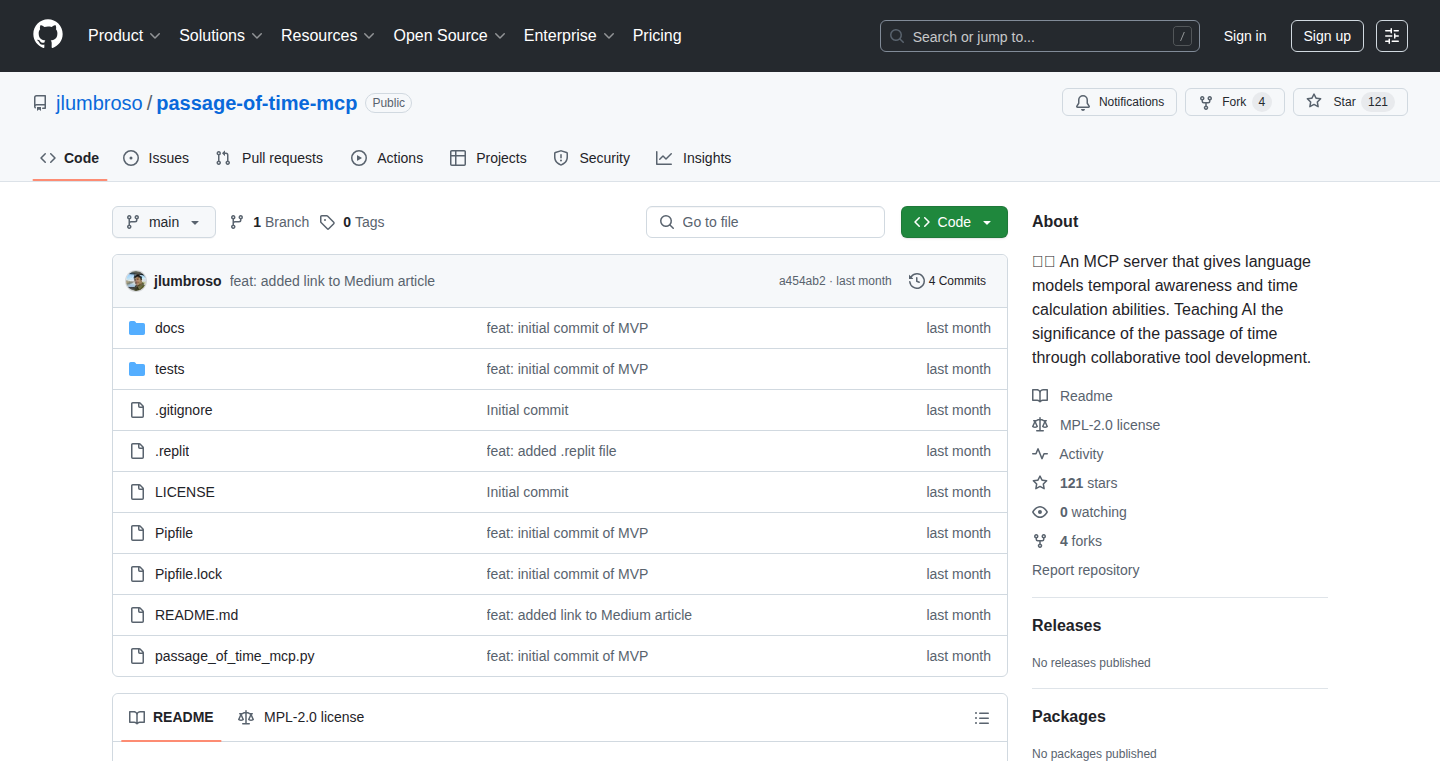
Author
lumbroso
Description
Chronos is an open-source Model Context Protocol (MCP) server designed to give Large Language Models (LLMs) a crucial understanding of time. It allows LLMs, which typically operate in a static text environment, to perceive and reason about the passage of time, similar to how humans experience it. This is achieved through a set of functions that provide temporal awareness, enabling the LLM to understand time differences, identify pauses, and even recognize patterns within a conversation, like the structure of a story. This is significant because it moves LLMs beyond simple text processing to a more dynamic understanding of context. So this helps LLMs to act more human and be more efficient at dealing with temporal data.
Popularity
Points 79
Comments 36
What is this product?
Chronos is a system that adds temporal perception to LLMs. It's like giving an AI a clock and a calendar. It uses functions like `current_datetime` and `time_difference` to provide the LLM with real-time information. The innovation lies in expanding an LLM's awareness beyond just the text it's given. This enables LLMs to understand how much time has passed, the sequence of events, and the rhythm of communication. So you could create a chat bot that understands how long you've been talking and can keep track of important dates or appointments.
How to use it?
Developers can integrate Chronos into their LLM applications by connecting their LLM to the MCP server. The server provides a set of time-related functions that the LLM can call upon. These functions provide the LLM with temporal context, allowing it to make time-aware decisions. Think of it as providing the LLM with extra 'senses.' So, to use it, developers need to establish a connection between their LLM and the MCP server, then the LLM can use the given functions for its tasks.
Product Core Function
· current_datetime: Provides the current date and time. This allows the LLM to be aware of when events are happening. So this is useful to schedule meetings or set reminders.
· time_difference: Calculates the time difference between two points in time. Helps the LLM measure durations and understand the pacing of events. So you could calculate how long a project will take based on the work that needs to be done.
· timestamp_context: Allows the LLM to understand context of when things happened. This lets LLMs reason about order of events. So the LLM can correctly analyze a timeline of events, say, understanding the events in a medical history.
· Pause detection: Identifies the length of pauses within a conversation. Helps LLMs understand conversational flow and user intent. So you can create a more natural conversational chatbot or analyze conversation patterns for marketing purposes.
· Rhythm reasoning: Enables the LLM to understand the rhythm of the conversations. So, you can teach the LLM to understand a person's speaking style.
· Three-act structure labeling: Helps the LLM to recognize a conversation's beginning, middle, and end. Useful for analyzing stories, scripts, or other structured communications. So this allows the LLM to summarize books more effectively.
Product Usage Case
· A customer service chatbot can understand the duration of a support request and escalate the issue if it's taking too long. So this is great for improving user experience and optimizing support efforts.
· A writing assistant can help structure a story by recognizing the beginning, middle, and end of a scene and suggesting appropriate transitions. So you can use this to create more engaging content and improve your writing workflow.
· A meeting summarization tool can track the time spent on different topics and highlight the most important points discussed. So it's perfect for creating concise and accurate summaries of meetings.
· A project management tool can estimate the time needed to complete a task based on the progress made over time. So you can improve task estimation and improve project planning.
4
DataRamen: Local-First SQL Explorer
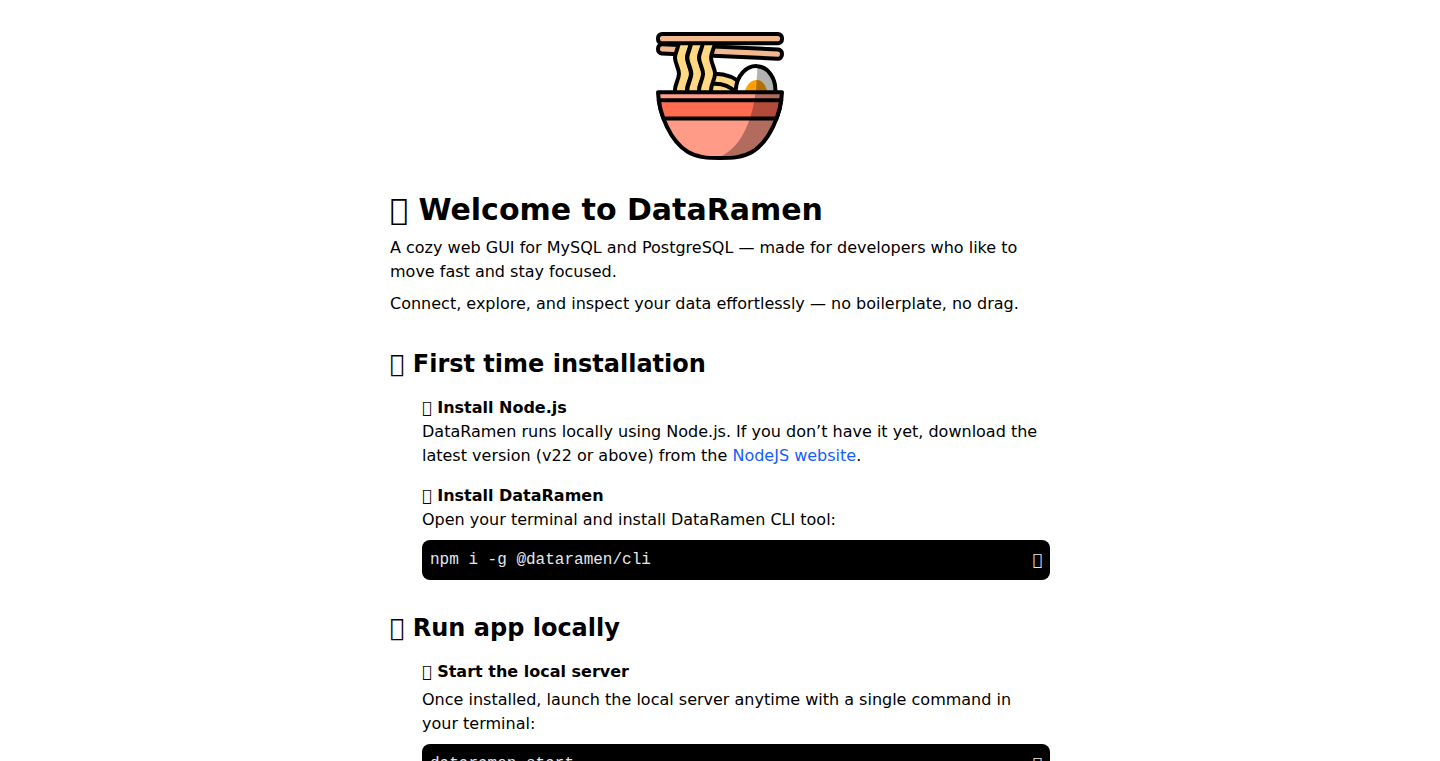
Author
oleksandr_dem
Description
DataRamen is a local-first SQL explorer designed to make data exploration and querying faster and more intuitive. It allows users to connect to their databases locally via the command line. The tool's primary innovation lies in its automatic joins and related data navigation features, enabling users to explore relationships between data without writing complex SQL queries. It streamlines the data exploration process, making it similar to working with a spreadsheet. This simplifies data analysis, especially for those who frequently need to extract insights from databases. This is a significant advancement, as it reduces the friction associated with repeated SQL query writing.
Popularity
Points 45
Comments 51
What is this product?
DataRamen is a command-line tool that acts as an intuitive SQL explorer. It connects to your databases locally, so your data never leaves your machine. The core innovation is its ability to automatically handle joins and navigate related data. When you explore a table, you can instantly see related records in other tables with a right-click. It's like having a built-in data relationship map. It also provides keyboard-driven navigation for quick operations. This uses a different approach than traditional SQL interfaces, making data exploration more user-friendly and efficient. So this allows you to access and understand your data faster, without the need to write or remember complex SQL queries.
How to use it?
Developers can install DataRamen via CLI. After installing, you connect to your databases. You can then explore your data by navigating through tables, filtering results, and using the automatic join features to see related data. You can edit or insert rows directly and save your queries in tabs. DataRamen supports multiple databases, allowing you to search and analyze data across different systems. This simplifies the process of data exploration and analysis for anyone working with SQL databases, and it’s particularly useful if you are dealing with multiple datasets or complex relational data. The benefit is it saves time and reduces the need to write the same SQL repeatedly.
Product Core Function
· Automatic joins and data navigation: Automatically displays related records from other tables based on relationships like foreign keys. This saves time, preventing the need for manual query writing. This simplifies exploring relationships between different datasets, allowing users to identify connections and analyze data.
· Keyboard-driven UI: Uses keyboard shortcuts for common operations like navigating tables and filtering data. This accelerates your workflow, making it faster to move between different tables and query data. This enables quicker data analysis by reducing the need to use a mouse or click through menus.
· Named tabs with saved queries: Allows you to save queries in different tabs for comparing or cross-checking data. This helps with organizing and comparing data, which is helpful when you are working with multiple queries or analyses. This enhances productivity when working on multiple tasks or reviewing results over time.
· Instant edit and insert: Permits quick edits or row additions with a single click. This simplifies data input and editing, eliminating the need for complex query writing. This is useful for quickly updating or modifying your data without needing to write complex SQL statements.
· Multi-DB support: Connects to multiple databases simultaneously. This lets you analyze data across several different systems. This makes it easier to compare data from different sources and analyze your data, especially when you have different datasets.
· Search across all columns: Enables searches across all columns. This is useful for finding data even when you don’t know the specific column. This simplifies searching and locating the right information without the need for specific column names.
Product Usage Case
· Data analysis for a business: A marketing analyst can connect to a database containing customer data and sales data. They can use DataRamen to quickly navigate relationships, find customers, and understand their purchase history without writing complex SQL queries.
· Web application development: A developer uses DataRamen to examine the database tables that hold application data. They use the 'automatic joins' feature to easily explore related information (e.g., users and their orders), which aids in understanding and debugging the application. This helps with improving app performance by quickly spotting and addressing issues related to database queries.
· Data auditing and reporting: A data analyst uses DataRamen to connect to a database that stores financial transactions. They can use the query saving feature to create reports on a daily basis. They can also utilize the automatic join function to find linked data, helping the data analyst to quickly view transactions and identify any inconsistencies.
5
Cobble - The Daily Word Constructor
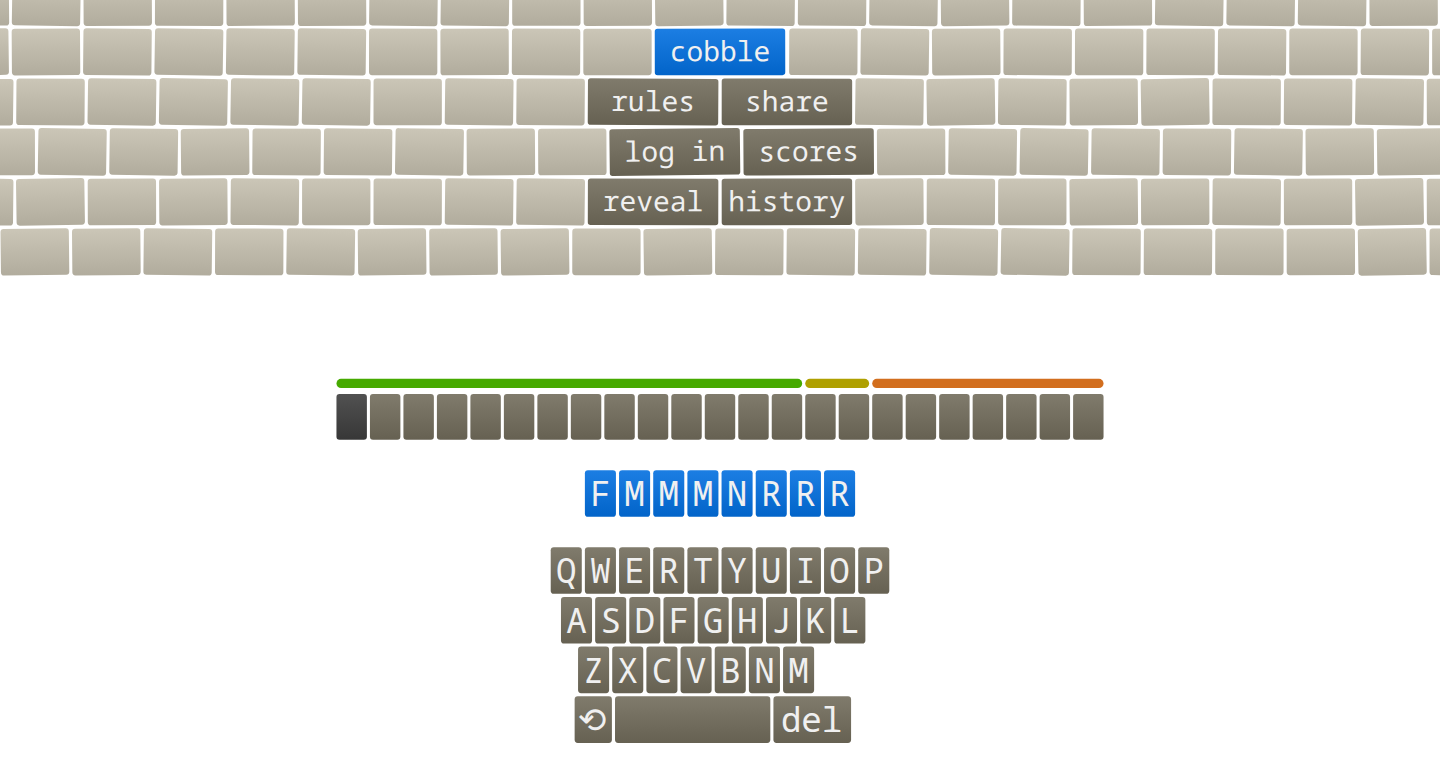
Author
wolfred
Description
Cobble is a word game where you are given a set of letters and you have to create two words using all the letters. The project focuses on algorithmic word selection and constraints satisfaction, offering a unique challenge beyond traditional word games. The core technical innovation lies in efficiently searching through a dictionary and applying constraints like length limits to find the shortest possible word combinations. This tackles the problem of generating complex word puzzles that are both challenging and fun.
Popularity
Points 21
Comments 15
What is this product?
Cobble is a daily word game that presents a word puzzle to users. It works by using an algorithm to sift through a dictionary of words and find the shortest two-word combination possible using the given letters. Think of it as a very smart word puzzle generator, constantly refining the problem by the day. It’s about finding elegant and concise solutions within the constraints. So what this does is to make word games, more challenging, more rewarding, more intellectually stimulating.
How to use it?
Developers could potentially integrate the core word-finding algorithm into their own word game applications or educational tools. This could be achieved by accessing the API, feeding it a set of letters, and receiving the optimal word pairs. This allows them to quickly create novel puzzles. They could use it for language learning apps, where students can learn new vocabulary by constructing words. The project's focus on efficiency is particularly useful for real-time or resource-constrained environments.
Product Core Function
· Word Combination Generation: The core function takes a set of letters as input and generates possible two-word combinations using all the letters. This uses efficient string matching algorithms to reduce search complexity. This is valuable because it provides the basis of the game.
· Dictionary Integration: The system uses a dictionary of words to validate and refine possible word combinations. This involves fast lookups and efficient database searching to find valid word combinations. So this can be used by developers to make sure that the words used are real words.
· Constraint Application: The algorithm applies constraints such as word length limits and overall solution brevity to guide its search for optimal solutions. This adds a strategic element to the word game and helps generate more interesting puzzles. This feature helps provide different level of difficulty.
Product Usage Case
· Educational Word Game Development: A developer creates a new word game for children. The Cobble algorithm is integrated to automatically generate a daily puzzle using different letter combinations, and with different difficulties, improving engagement with the app and building new levels.
· Language Learning Application: A language learning app leverages the Cobble engine to provide users with word puzzles. Each puzzle uses letters tied to the current lesson's vocabulary, reinforcing learning. The system provides an easy way to test and build up vocabularies.
6
CivicHub: Open-Source Political Platform
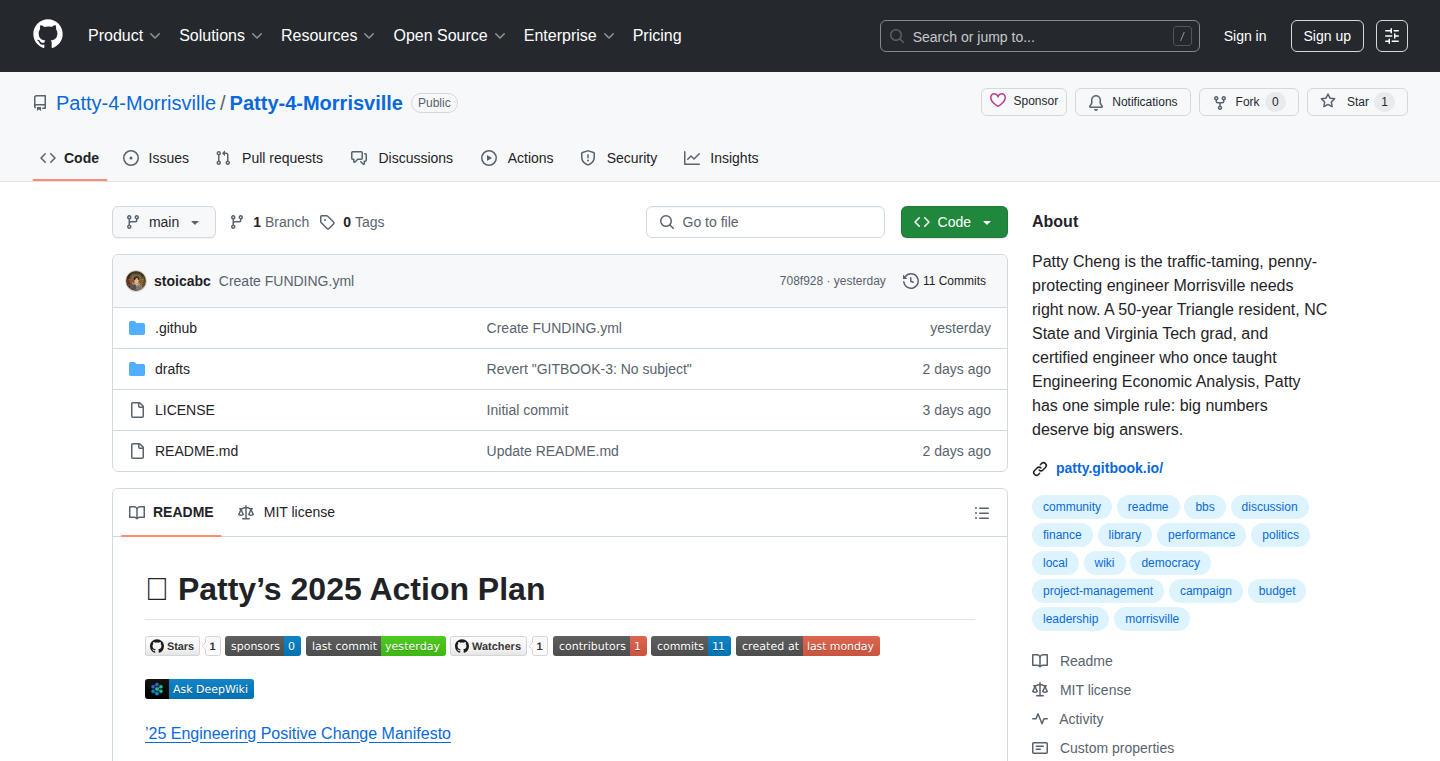
Author
lewis232
Description
CivicHub is a platform built on GitHub, aiming to revolutionize how local politics works. It creates a space for open discussions, collaboration, and transparency in local governance. Using GitHub's features like wikis, issue trackers, and discussion forums, it allows citizens and politicians to work together on policy proposals. It moves beyond traditional partisan divides and encourages community-driven solutions. The core innovation is applying the collaborative spirit of open-source software development to the world of local politics, fostering a more inclusive and effective civic engagement. So this provides a new way for citizens to participate in the local policy making.
Popularity
Points 11
Comments 4
What is this product?
CivicHub takes the collaborative nature of open-source software development and applies it to local politics. Imagine a GitHub repository, but instead of code, it contains policy proposals, community discussions, and project management tools. Citizens can contribute to policy ideas, track progress, and engage in open dialogue with politicians. This fosters transparency, allows for a more inclusive decision-making process, and encourages community ownership of policy. It uses GitHub's built-in features like wikis for creating policy documents, issue trackers for managing tasks, and discussion forums for debates and idea-sharing. So this allows communities to shape their local government.
How to use it?
To use CivicHub, politicians and community members create GitHub repositories dedicated to specific policy areas or projects. Within these repositories, they can create wiki pages to document policy proposals, use the issue tracker to list tasks and gather feedback, and use the discussion forum to debate ideas and collect community input. Developers can use the platform by contributing to policy ideas, providing technical expertise, or building integrations to enhance the platform. So this is how you get your voice heard in a local government.
Product Core Function
· Policy Proposal Wikis: Use GitHub wikis to document policy proposals in a structured and collaborative way. This allows for clear documentation, version control, and community input on each proposal. (So this makes it easy to understand and contribute to policy ideas)
· Issue Tracking: Leverage GitHub's issue tracking system to manage tasks, track progress on policy initiatives, and collect feedback from the community. (So this provides a central place to track and contribute to all your local projects)
· Discussion Forums: Use GitHub discussions to facilitate open discussions, debates, and idea-sharing related to policy proposals and community projects. (So this allows community members to engage in meaningful conversations and voice their opinions)
· Version Control: Leverage GitHub's version control to track changes to policy documents, allowing for transparency and accountability. Everyone can see how the policies change overtime. (So this provides a history of all changes made to the policies)
Product Usage Case
· Policy Development: A local council uses CivicHub to develop a new recycling program. They create a wiki for the program's proposal, an issue tracker to manage community feedback and tasks, and a discussion forum to debate ideas. Citizens actively participate by contributing ideas, suggesting improvements, and tracking the progress of the program, resulting in a more comprehensive and community-supported program. (So this builds better policies with your community)
· Transparency and Accountability: A community member uses CivicHub to track the progress of a local infrastructure project. They monitor the project's progress, the budget, and the project timeline in the issue tracker. They can also view all the discussions and decisions made by the council on the wiki. The openness of the platform fosters accountability, ensuring that the project is completed as planned and on time. (So this makes your local government open to everyone)
· Community Engagement: A local politician uses CivicHub to engage with the community on a proposed new park. They create a wiki to display the park proposal, and issue tracker for suggestions, and use the discussion forum to collect feedback. The open communication encourages community members to participate in the decision-making process and makes them feel more connected to the government. (So this gives the community a voice in local projects)
7
GitGuard: Declarative PR Automation Engine
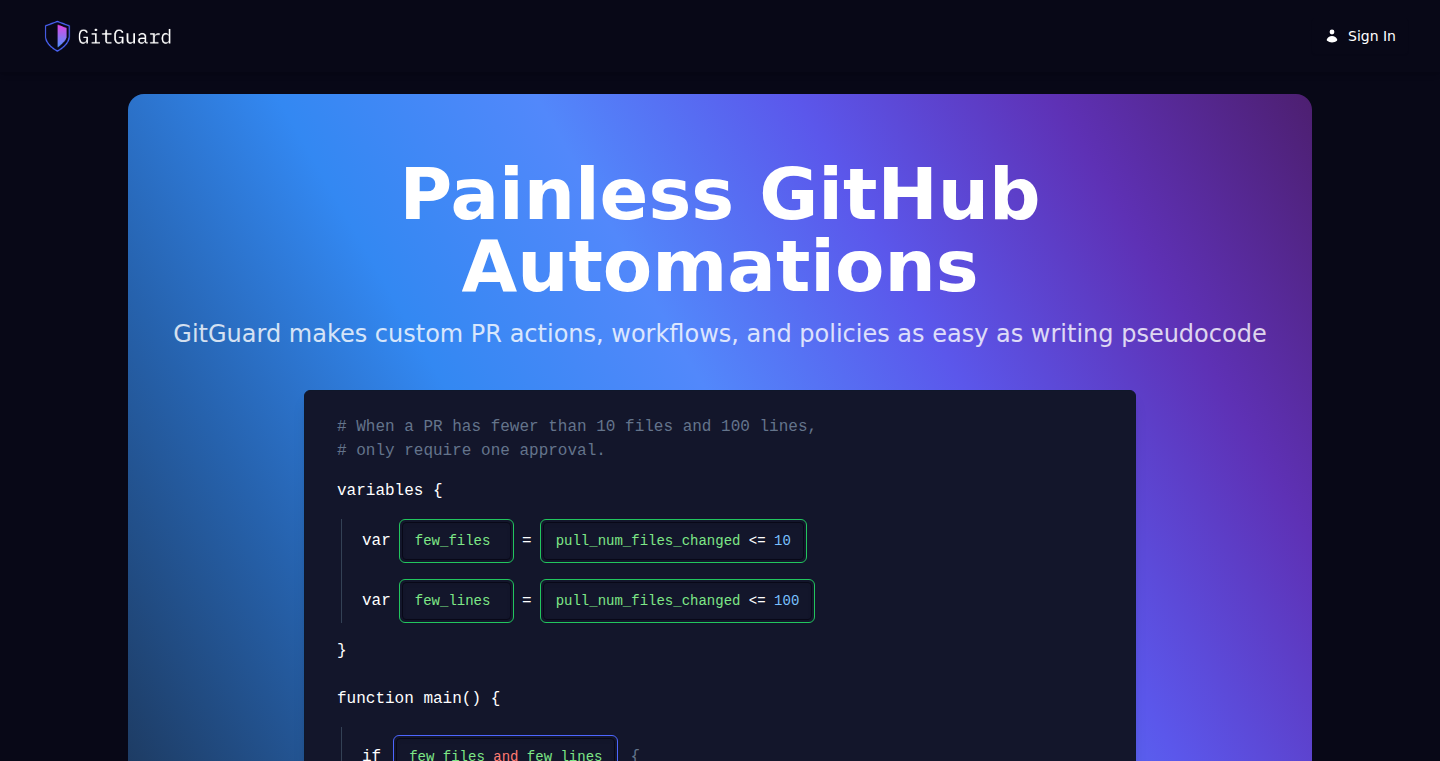
Author
habosa
Description
GitGuard is a tool designed to automate and enforce pull request (PR) policies within a GitHub repository, written in a custom, easy-to-understand language. It addresses the common problem of teams struggling to manage PR checks and automations, which often involves cumbersome custom scripts and inconsistent enforcement. The core innovation lies in its declarative approach, allowing developers to define policies in a simplified, pseudocode-like DSL, which leads to faster, more reliable, and maintainable PR checks, providing instant feedback on policy compliance directly on the PR, without relying on potentially slow CI/CD pipelines.
Popularity
Points 11
Comments 4
What is this product?
GitGuard is like a smart gatekeeper for your GitHub PRs. It lets you define rules (policies) that your PRs must follow before they can be merged. The core idea is to move away from complex scripts and embrace a more user-friendly language to define rules like: 'When a specific file is changed, require review from team Y' or 'If the PR is very large, require multiple approvals'. GitGuard evaluates these rules instantly on every PR, giving immediate feedback to the developer. So this is useful because it automates tedious tasks and keeps your code consistent.
How to use it?
Developers use GitGuard by writing policies in its custom DSL and integrating it into their GitHub repositories. They can define rules that trigger actions based on PR metadata or content changes. For instance, you can set up rules to automatically add labels, request reviews from specific teams, or even block a PR from merging until certain criteria are met. This is valuable because it allows teams to customize their PR workflow and enforce best practices seamlessly. You can integrate it by simply installing the GitGuard app on your GitHub repository and writing your policy definitions. The policies are then executed automatically on every PR.
Product Core Function
· Policy Definition with DSL: GitGuard allows writing rules in a simplified language similar to pseudocode. This eases the creation and maintenance of PR automation rules, improving code readability and maintainability. For example, you can easily specify review requirements, file restrictions, and other PR-specific constraints. So this is useful because it simplifies complex automation workflows.
· Real-time Policy Enforcement: GitGuard instantly checks PRs against defined policies, providing immediate feedback directly within the GitHub UI. This eliminates the wait time associated with typical CI/CD pipelines, significantly improving developer productivity and the feedback loop. So this is useful because it allows you to catch errors early in the development process.
· Automated Review Request: GitGuard automatically requests reviews from specific teams or individuals based on defined rules (e.g., changes to specific files). This saves time and ensures the right people are reviewing code. So this is useful because it helps to get the right people looking at your code and reduces the chance of errors.
· Customizable Labeling: The system allows you to add labels to PRs based on policy results. Labels can indicate breaking changes, required reviews, or compliance status. This is useful for categorizing and prioritizing PRs for easier management. So this is useful because it allows you to organize and triage your pull requests easily.
· Emergency Bypass: GitGuard facilitates the addition of policies to facilitate exceptions (e.g. hotfixes) so that urgent changes can bypass standard checks. This allows for quicker response in critical scenarios while maintaining overall policy compliance. So this is useful because it ensures that you can quickly fix critical issues while still following your standards.
Product Usage Case
· Enforcing Code Review Standards: A development team uses GitGuard to ensure that any changes to the authentication module require a review from the security team. This guarantees security experts review critical code changes before merging. So this is useful because it enforces code review standards.
· Preventing Large PRs: A team uses GitGuard to automatically label PRs with more than 500 lines of code as 'needs-additional-review'. This helps to identify and manage large pull requests to ensure careful review. So this is useful because it helps to manage and review complex changes more effectively.
· Compliance and Policy Enforcement: A company uses GitGuard to enforce a policy requiring all PRs that include breaking changes to be labeled as such and include a specific documentation link. This helps communicate changes to stakeholders. So this is useful because it helps to improve communication around breaking changes.
· Automated Labeling: A project manager is using GitGuard to automatically label PRs as 'Needs Documentation' when changes affect documentation. This automates a traditionally manual step. So this is useful because it improves workflow automation.
8
HN v0.2.1 - Native macOS Hacker News Client
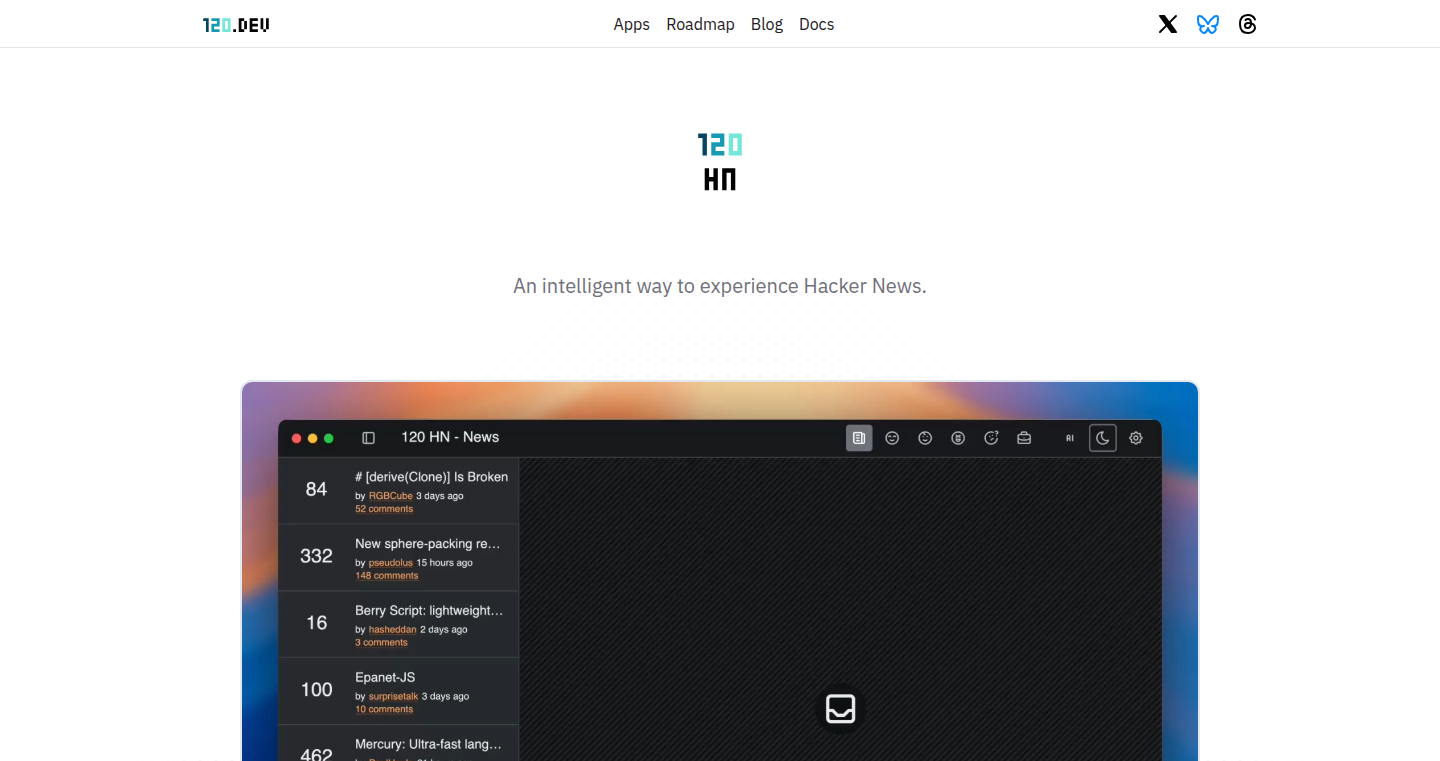
Author
120-dev
Description
This is a native macOS application designed for reading Hacker News, offering a better and more efficient way to browse the site. The key innovation lies in its improved AI summaries of HN articles, making it easier for users to quickly grasp the essence of a post and its discussions. It also remembers window size, position, and sidebar state, enhancing user experience. Future releases plan to incorporate local LLM support for more advanced features.
Popularity
Points 7
Comments 6
What is this product?
It's a specialized app built just for Hacker News, optimized for macOS. The core of it is using Artificial Intelligence (AI) to automatically summarize the comments on each story. This is a big deal because it lets you get the gist of a discussion much faster than reading through everything. The app also makes browsing feel smoother with features like remembering where you left off.
How to use it?
You simply download and install the macOS application. After opening, you'll have a dedicated interface to browse Hacker News. You can read articles, see comments, and quickly understand the main points of discussions thanks to the AI summaries. So, if you are a regular Hacker News user and want a better reading experience, this app is for you. You don't need to integrate anything; it's a standalone tool.
Product Core Function
· AI-powered Summarization: The app uses AI to create concise summaries of Hacker News discussions. Value: Saves time by allowing users to quickly understand the key points of a conversation without reading all the comments. Application: Ideal for busy developers who want to stay informed about tech trends but have limited time to read detailed discussions.
· Native macOS Experience: The app is designed specifically for macOS, providing a smooth and integrated user experience, including features like remembering window size and position. Value: Provides a more comfortable and efficient way to browse Hacker News compared to using a web browser. Application: Suitable for users who want a dedicated, distraction-free environment for reading Hacker News.
Product Usage Case
· A developer frequently checks Hacker News for new technology trends and solutions. Instead of spending a lot of time reading through endless comments, the AI summaries help him quickly understand the main points of a discussion, allowing him to save time and focus on relevant information. He can then quickly identify valuable insights without needing to sift through every single comment.
· A tech enthusiast uses the app to stay updated on the latest developments in programming languages and software tools. The app's ability to remember window settings and its native macOS integration ensures a user-friendly experience, making it easy and enjoyable to follow various tech discussions. The enthusiast benefits from the streamlined experience offered by the app, keeping up with tech news more efficiently.
9
TXT Blah Blah Blah Lite: Offline AI Reasoning Engine
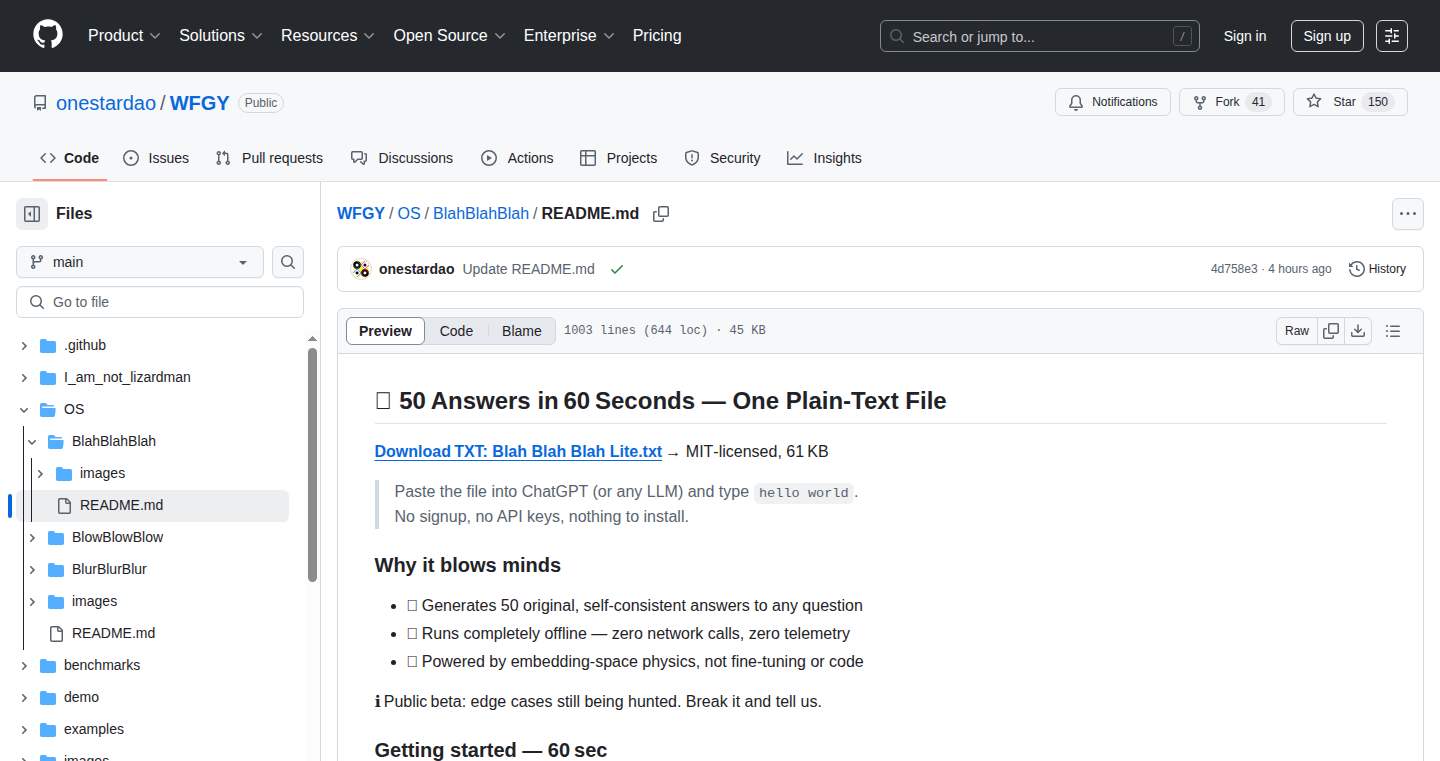
Author
TXTOS
Description
This project introduces an open-source, plain-text AI reasoning engine that works entirely offline. It leverages a technique called "semantic embedding rotation" to generate 50 coherent and consistent answers within 60 seconds. The key innovation is its ability to function without relying on internet connections or external APIs, making it lightweight and portable. The developers claim that this model achieved a perfect score (100/100) across evaluations by six major AI models (ChatGPT, Grok, DeepSeek, Gemini, Perplexity, Kimi). So this is useful because it allows anyone to experiment with and use an AI reasoning engine without needing powerful hardware or internet access.
Popularity
Points 5
Comments 7
What is this product?
This is a simple AI engine built using plain text (.txt files) that avoids external dependencies. Its core technology is "semantic embedding rotation", which is essentially a way of representing and manipulating the meaning of words in a numerical form (embeddings) to do AI reasoning. The engine doesn't need to be trained and doesn't call any external APIs, making it fully offline. The goal is to provide a simple, accessible, and fast AI solution. So this means you can run an AI engine on almost any computer without requiring internet or expensive hardware.
How to use it?
Developers can download the .txt file and paste it into any existing LLM chatbox (e.g., models that accept text input). They can then type prompts (like 'hello world') to see the engine generate a set of responses. This allows developers to integrate the engine into their own applications or experiment with different prompting techniques. It's designed to be beginner-friendly, so getting started is easy. So this is useful if you're a developer who wants to quickly test ideas or create custom AI-powered applications without needing to learn complicated frameworks or pay for cloud services.
Product Core Function
· Offline Reasoning: The engine works entirely offline, eliminating the need for internet access. This makes it usable in environments with limited or no connectivity. So this allows you to use AI when and where it's most needed, regardless of network availability.
· Semantic Embedding Rotation: The core technique used for reasoning. This is a method of processing the meaning of words to produce consistent results. So this provides a new way to tackle AI problems without relying on heavy training or external APIs.
· Anti-Hallucination: Uses techniques like semantic boundary heatmaps and advanced coupling logic to reduce 'hallucinations', which are instances where an AI generates incorrect or nonsensical information. So this ensures the engine's outputs are more reliable and trustworthy.
· Lightweight and Portable: Runs as a single .txt file, making it easy to copy, share, and use on any device. So this makes the engine accessible and easy to integrate into any project.
· Fast Generation: Generates 50 coherent answers in about 60 seconds. So this gives you quick and efficient results for rapid prototyping or experimentation.
Product Usage Case
· Prototyping AI Applications: Developers can quickly prototype AI-driven chatbots or information retrieval systems. So this means you can quickly test different approaches to building AI applications without having to set up a complex environment.
· Educational Tool: The project provides a simplified model that can be used to teach and learn how an AI engine works. So this helps understand the underlying principles of AI without complex technical requirements.
· Offline Knowledge Base: Integrate it into systems where an internet connection isn't available, such as embedded systems or isolated networks. So this means you can build AI-powered applications for environments without internet, like scientific instruments, or industrial control systems.
10
CanvasFlow: An Infinite Note-Taking Canvas

Author
stagas
Description
CanvasFlow introduces an infinite canvas for note-taking, moving beyond the constraints of traditional linear note formats. It employs a graph-based approach, allowing users to connect ideas and thoughts visually. This project addresses the problem of limited space and rigid structure in existing note-taking applications, promoting a more flexible and organic way of organizing information. It emphasizes the relationships between ideas, offering a more intuitive and potentially more insightful experience compared to simple text-based notes. So this makes your notes more dynamic and allows for a better understanding of the relationships between different ideas.
Popularity
Points 4
Comments 7
What is this product?
CanvasFlow is essentially a digital whiteboard that never runs out of space. Instead of writing notes in a long, scrolling document, you can place them anywhere on a vast canvas. The core innovation lies in how it links those notes together. It uses a graph structure, meaning you can draw lines connecting related ideas. This helps you see the connections between different pieces of information, something traditional note apps often struggle with. So this allows for a more visual, interactive way to organize your thoughts.
How to use it?
Developers can use CanvasFlow in various ways. They can integrate it into their own note-taking applications, building on the graph-based structure to create unique features. They might also use it as a basis for creating educational tools, or even for visualizing complex data sets. The API and underlying architecture would be of interest to developers. So, you get a new way to visualize and interact with data.
Product Core Function
· Infinite Canvas: The most fundamental function is the ability to add notes anywhere on a virtually limitless canvas. This avoids the limitations of scrolling documents and provides freedom for spatial organization. It is extremely useful for project planning, brainstorming, and mapping complex relationships.
· Node Creation and Editing: This allows users to create and edit individual notes (nodes) on the canvas. Users can add text, images, or other types of media. This means you can easily add rich content to each idea and organize them.
· Connection/Link Creation: Crucially, users can connect different notes with lines or arrows, forming a visual graph. This function lets you make explicit connections between related ideas, revealing patterns and relationships that might be hidden in a linear text. This is very useful in understanding the underlying structure of your work.
· Zoom and Navigation: Smooth zooming and panning functionalities are essential for navigating the vast canvas. It allows users to focus on specific sections and to zoom out to see the overall structure. This is critical for maintaining perspective on larger projects or maps.
Product Usage Case
· Knowledge Management: A developer could use CanvasFlow to build a personal knowledge management system, connecting notes about different topics, forming a web of understanding. For example, building up a database of interconnected information on machine learning algorithms or software design patterns. This becomes a dynamic encyclopedia, not just a collection of notes.
· Project Planning: Project managers and developers can use CanvasFlow to visually map out projects, tasks, and dependencies. Notes represent tasks and connecting lines show task dependencies. So, you can spot bottlenecks or potential issues in a very intuitive way.
· Brainstorming and Idea Generation: Facilitating brainstorming sessions, where users can quickly jot down ideas and connect them visually. The spatial arrangement allows for a more fluid and creative thought process compared to traditional list-based brainstorming tools.
11
PIT (Phono In Terminal) - A Terminal Image Viewer with RGB Colors
Author
FerkiHN
Description
PIT is a lightweight image viewer designed to display .png and .jpg images directly within your terminal using actual RGB colors, even on older systems. The core innovation is its zero-dependency design, achieved by writing the entire application in C and using only stb_image.h for image decoding. This means it doesn't rely on external libraries like X11, SDL, or curses, making it extremely portable and runnable on a variety of platforms, including Linux, macOS, WSL, Windows Terminal, and even embedded systems. It compiles to a small size (~250 KB) and offers CLI options for image manipulation like zooming, flipping, resizing, and background fill. So, it's a simple, efficient way to view images right in your terminal without needing a separate graphical interface; so this is useful if you are working on a remote server and still want to view images quickly.
Popularity
Points 3
Comments 5
What is this product?
PIT works by reading the pixel data from an image file (PNG or JPG) and translating those pixel colors into the appropriate ANSI escape codes to render the image directly within the terminal's text-based interface. The core technology lies in the use of the `stb_image.h` library, a single-header library for image loading and decoding. This approach eliminates dependencies, minimizing the application size and maximizing portability. The project is written in C, allowing for fine-grained control over the system resources, and optimizing its performance. So, this is useful if you want to display images in a terminal environment without bulky dependencies and a lightweight codebase.
How to use it?
Developers can use PIT by downloading the source code from the GitHub repository and compiling it for their target platform. The application can then be run from the command line, taking an image file as an argument. Various command-line options are available for adjusting image display (zoom, resize, etc.). Developers can integrate PIT into their scripts or other terminal-based tools to include image viewing capabilities. So, you can use this when developing a script that needs to render images inside a terminal.
Product Core Function
· Zero-dependency image rendering: PIT uses the stb_image.h header file to decode images, which allows it to work on systems without any other installed dependencies. It keeps the program simple and easy to distribute. So, it's useful for creating minimal, standalone applications.
· Cross-platform compatibility: The project is written in C and has no platform-specific dependencies. The program runs on various operating systems and terminal emulators such as Linux, macOS, Windows Terminal and Termux, making it flexible for development and deployment. So, it's useful for developers needing a unified solution across multiple environments.
· CLI options for image manipulation: It provides various command-line options, such as zoom, flip, resize, and offset. Users can control the presentation of the image from the command line, making it useful for scripting and automated tasks. So, it's useful for developers who need to incorporate image display as part of a bigger script or a terminal tool.
· RGB color support: It displays images using true RGB colors within the terminal by converting image colors into the terminal’s RGB color space. This makes the image look more realistic and enhances user experience. So, it is useful for displaying images with good visual quality in the terminal.
Product Usage Case
· Remote server image previews: A system administrator can use PIT to quickly preview images on a remote server via SSH without needing a graphical interface. They can rapidly assess visual contents without needing to transfer image files or use a browser. This saves time and bandwidth. So, this is useful for those who frequently work with images on a remote server.
· Embedded system development: PIT can be incorporated into embedded systems with limited resources, allowing developers to display images in a terminal environment on devices. This is useful for debugging and system monitoring. So, it is useful for those building embedded systems or working with restricted hardware.
· Scripting and automation: Developers can incorporate PIT into shell scripts to display images during automated tasks or build terminal-based applications. This functionality helps provide visual feedback during the processing of data. So, it is useful for developers looking to add a visual element to their scripts.
· Educational purposes and learning: Students and programmers can use PIT's source code as a demonstration of how to implement image rendering in a terminal, and learn how to handle different image formats without relying on complex libraries. So, this is useful for anyone interested in learning about terminal graphics and image processing.
12
CopyMagic: Local-First Clipboard Search Engine
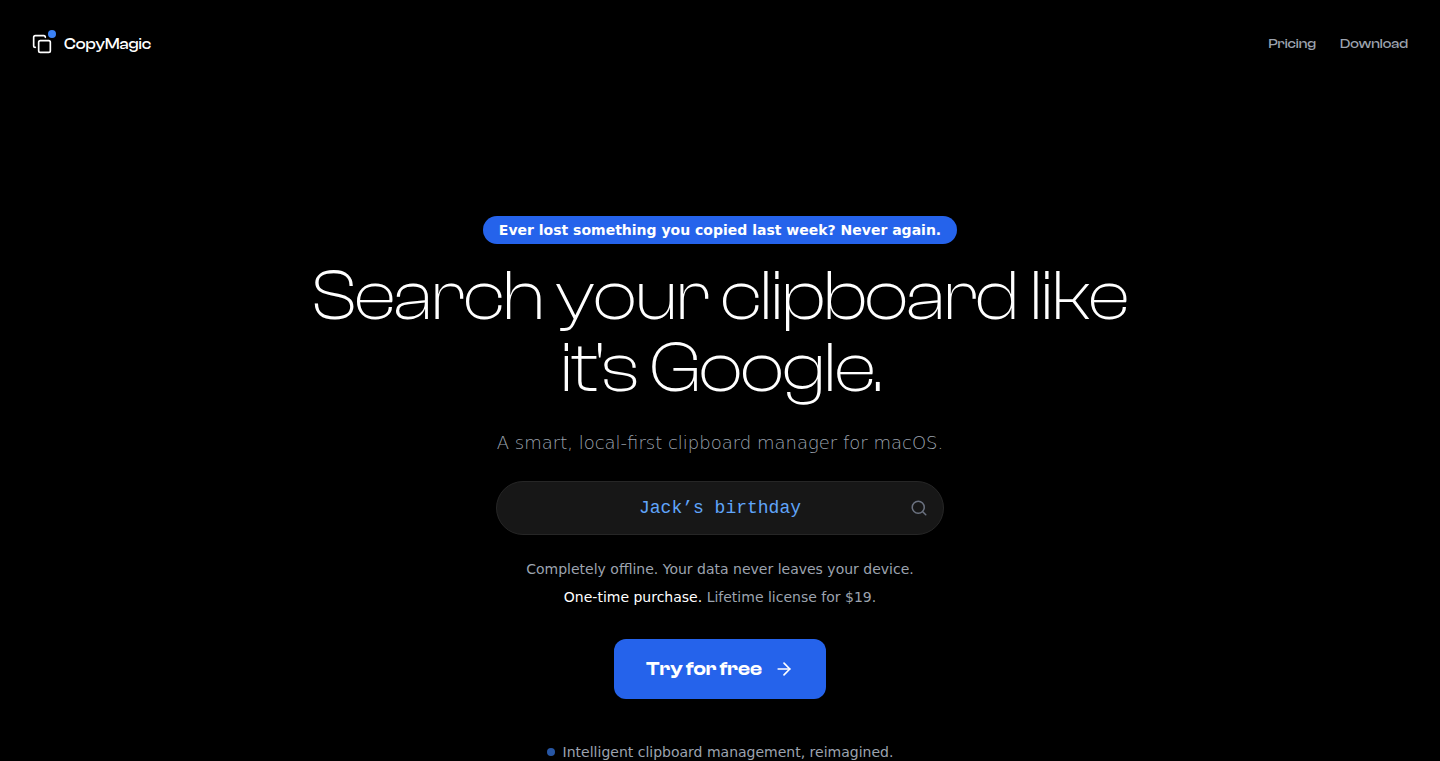
Author
rtk0
Description
CopyMagic is a clipboard manager that takes a clever approach to saving and searching your copied text. Instead of just storing everything you copy, it lets you search through your clipboard history using natural language queries, kind of like searching on Google, but for your copied data. The key innovation here is that it's 'local-first,' meaning all your data stays on your device, increasing privacy. It's solving the problem of finding that specific piece of information you copied hours, days, or even weeks ago without having to manually scroll through a long list.
Popularity
Points 8
Comments 0
What is this product?
CopyMagic is essentially a smart clipboard. It saves everything you copy, but the magic lies in its search functionality. It uses techniques similar to how search engines work, but on your own device, allowing you to quickly find a specific piece of information. For example, you can type something like "flight ticket details" and CopyMagic will find any copied text related to flight tickets. This also means that since it's local-first, your sensitive information, like passwords or private conversations, never leaves your computer. So this is useful because it saves time when you need to find something you've copied before.
How to use it?
You use CopyMagic by copying text as you normally would. Then, when you need to find something, you open CopyMagic and type in a search query, like you're using Google. The application will show you a list of relevant items from your clipboard history. You can integrate this into your workflow seamlessly by using it as your main clipboard manager. It can be especially useful for developers working with a lot of snippets of code or text and anyone dealing with a lot of data that is copied and pasted.
Product Core Function
· Smart Search: This is the core of CopyMagic. It allows you to search your clipboard history using natural language, enabling quick access to specific pieces of copied data. This is useful for anyone needing to recall information quickly.
· Local Storage: All the copied data stays on your device. This is a crucial feature for privacy and security, ensuring your information isn't stored on external servers. It's especially valuable for sensitive data such as login details.
· Clipboard History Management: The application keeps track of everything you copy, providing a full history for you to refer back to. This is incredibly useful when you need to retrieve something you copied a while ago and have forgotten where you got it from.
· User-Friendly Interface: CopyMagic provides an easy-to-use interface for searching and managing your clipboard history. This is important because it makes the technology accessible to everyone, not just tech experts.
Product Usage Case
· Code Snippet Retrieval: A developer copies a function, and later needs to reuse it. Instead of searching through multiple files, they can use CopyMagic to search for a keyword, and get the right piece of code, improving development efficiency.
· Customer Support: A customer support representative can use CopyMagic to quickly find answers to frequently asked questions. The support rep can copy and paste the answers from their internal documentation, search using keywords related to the customer's problem, and quickly retrieve information during a customer interaction, thus improving response times.
· Research & Note-Taking: Researchers and students can quickly find past research notes. They copy important text from articles, and then use CopyMagic to search for those phrases later when writing their paper. This helps in recall and reduces time spent on tedious searching through multiple resources.
· Personal Productivity: Anyone dealing with a lot of text can save time by using this, from finding email addresses to searching through shipping details. It's generally useful if you need to revisit something you've copied to your clipboard.
· Privacy-Conscious Users: Those who prioritize their privacy are provided a local-first solution for managing and searching their clipboard history.
13
MemGPT: Interactive Memory Enhancement for LLMs
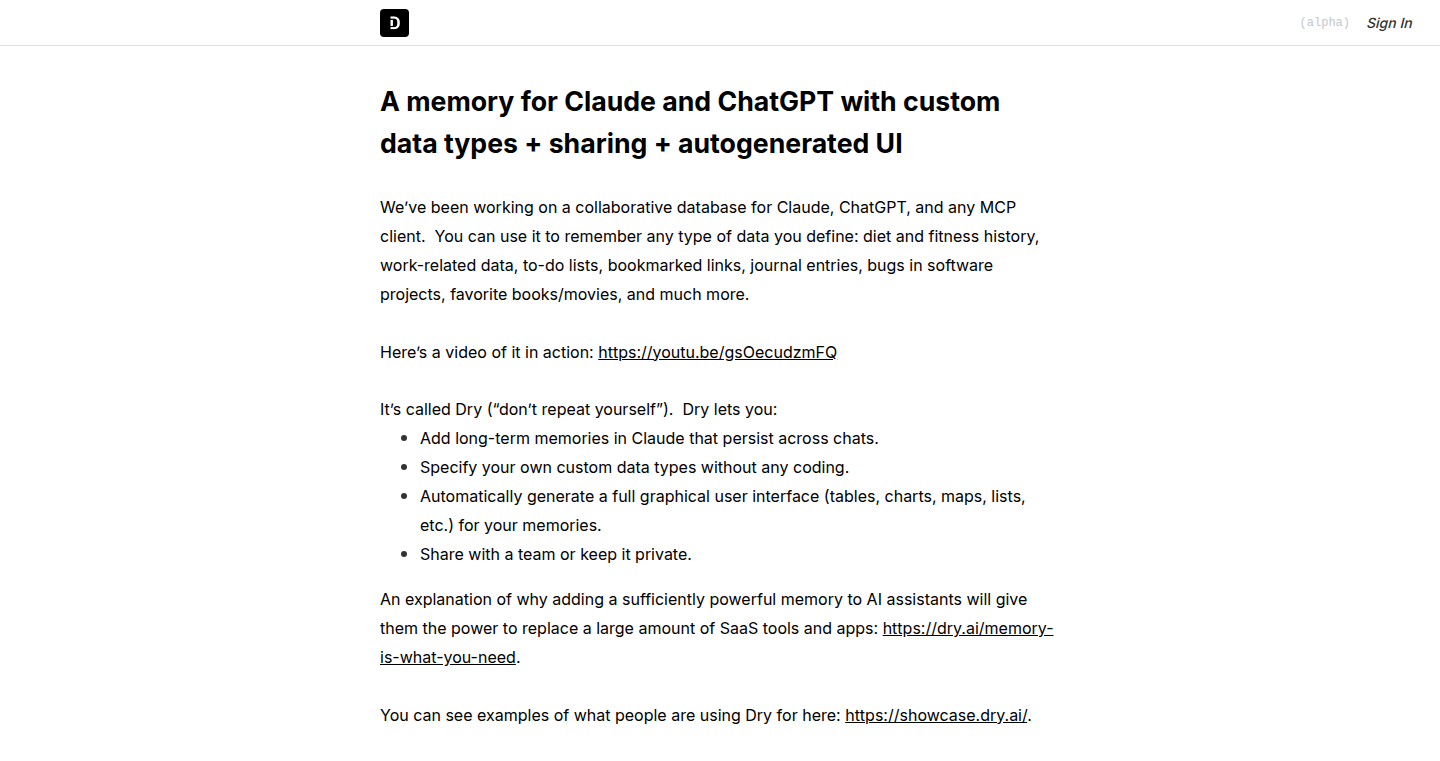
Author
nickcassimatis
Description
MemGPT is a tool that enhances the memory capabilities of Large Language Models (LLMs) like Claude and ChatGPT. It allows users to inject custom data types, share and interact with persistent memories through a user-friendly graphical interface (GUI). The core innovation lies in its ability to give LLMs a more robust form of memory, akin to how humans recall and use information. This addresses the fundamental limitation of LLMs' short-term memory, enabling them to retain and utilize much more data and context over extended interactions.
Popularity
Points 8
Comments 0
What is this product?
MemGPT fundamentally expands an LLM's memory by allowing it to store and retrieve information beyond the standard context window. It provides a system for users to define the type of data they want to store, making retrieval more effective. Imagine giving your AI assistant a detailed journal and it being able to recall specific information based on your prompts at any time. The GUI provides an easy way to manage and visualize this memory. So this helps you utilize the large language models with much more context for extended conversation.
How to use it?
Developers can integrate MemGPT into their applications by using a set of APIs (Application Programming Interfaces) to interact with the extended memory. You can provide the tool with custom data types, e.g., the format of your own documents, then load data to it and interact via an LLM by prompting with queries on the data. This can be integrated with any application that uses LLMs, such as chatbots, virtual assistants, and even automated data analysis tools. So you can augment any application that currently uses a large language model.
Product Core Function
· Custom Data Type Support: Allows users to define the structure and organization of data stored in the extended memory. Technical Value: This enables the LLM to understand and retrieve information more accurately. Application Scenario: Imagine you're building a research assistant; you can define a data type for scientific papers, including abstract, authors, and references, letting the LLM recall specific information from the papers effectively. So this improves the accuracy of your AI assistant's responses.
· Persistent Memory Storage: Provides a mechanism to store and retrieve information across different conversations or sessions. Technical Value: This bypasses the typical limitations of an LLM's context window, allowing it to 'remember' information over time. Application Scenario: For example, a customer service chatbot can maintain a consistent understanding of a customer's history, providing more personalized and helpful interactions. So this enables a much more powerful and personalized chatbot.
· Interactive GUI for Memory Management: Offers a visual interface for managing, editing, and sharing the extended memory. Technical Value: Simplifies the process of managing complex data and allows for easy monitoring and debugging of the system. Application Scenario: Developers can visually inspect the memory contents, understand how the LLM is using the information, and modify the memory structures as needed. So this eases the debugging and adjustment of your LLM application.
· Sharing Capabilities: Allows multiple users to collaborate on and share the same memory. Technical Value: Enables teamwork on a shared data set, allowing to build and share knowledge in teams. Application Scenario: Imagine team members collaboratively building an AI that can access all the organization's internal documents and use them to reply to user questions. So this enables easy collaboration on a common knowledge base.
Product Usage Case
· Building an AI-powered research tool that can remember and synthesize information from multiple documents, saving time for research.
· Creating a more effective customer service chatbot by providing it with a long-term memory of customer interactions, allowing for more personalized support.
· Developing a virtual assistant that can retain and recall personal information over multiple sessions, improving the user experience.
· Creating interactive educational tools where the LLM can store knowledge learned over time and use it to adapt to the user's learning progress, facilitating knowledge-based interactions.
14
Doctor: Automated Documentation Generator

Author
complex_city
Description
Doctor is a tool designed to automatically generate documentation for your code. Instead of manually writing documentation, which can be time-consuming and often outdated, Doctor analyzes your codebase and automatically creates documentation. The key technical innovation lies in its ability to parse code structure and infer meaning, saving developers significant time and effort. It solves the persistent problem of keeping documentation synchronized with the evolving code, making projects more maintainable and accessible.
Popularity
Points 2
Comments 6
What is this product?
Doctor uses techniques like code parsing and analysis (think of it like reading your code's blueprint) to understand how your code works. It then automatically generates documentation, including descriptions, function signatures, and even usage examples. The innovation is in automating this tedious process. So, this means less time spent on documentation and more time focused on building cool stuff.
How to use it?
Developers can integrate Doctor into their development workflow. Simply point Doctor to your codebase, and it will generate documentation in various formats (like Markdown or HTML). You can then incorporate this documentation into your project's README, a separate documentation site, or even your IDE. This simplifies collaboration and onboarding of new developers. For example, you could use it for a new API you are developing. So, it offers a streamlined way to document your code, reducing manual effort and keeping everything consistent.
Product Core Function
· Automated Code Parsing: Doctor analyzes your code to understand the structure, functions, and variables. This means you don't have to manually describe every element of your code. So, you can have a clear understanding of your code without reading every line.
· Documentation Generation: Doctor generates documentation in various formats (e.g., Markdown, HTML). This saves you time and ensures your documentation is accessible. So, it allows you to easily share your code's inner workings.
· Dependency Analysis: Doctor analyzes your code's dependencies. This is particularly useful for understanding how different parts of your code relate to each other. So, this helps you keep track of your code.
· Integration with IDEs and CI/CD pipelines: Doctor can be integrated into your IDE or CI/CD pipeline. This provides automated documentation generation during development and build processes. So, your documentation is always up-to-date.
Product Usage Case
· API Documentation: You're building a REST API. Doctor can automatically generate documentation for your endpoints, request/response formats, and parameters, reducing the effort required to describe your API. So, you can create a good API experience for other developers.
· Open-Source Project Documentation: You're maintaining an open-source library. Doctor can automate the documentation of your code, making it easier for other developers to understand and contribute to your project. So, you can attract contributors more easily.
· Team Collaboration: You're working in a team. Doctor can create documentation that helps new team members quickly understand the project's architecture and codebase. So, it makes it easier to onboard new team members.
15
DomainLand: Your Unused Domains' New Home
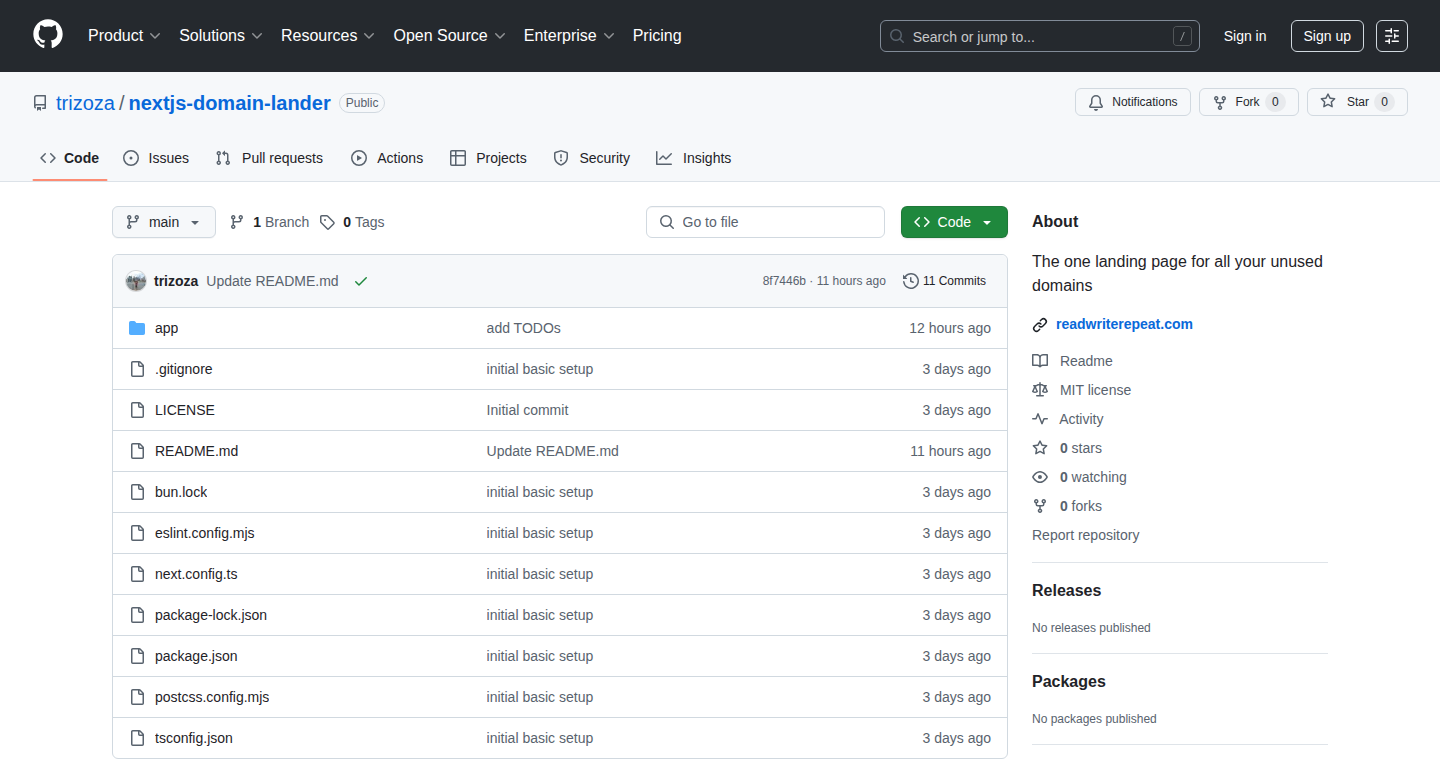
Author
trizoza
Description
DomainLand is a simple service that turns your unused domain names into a single landing page. It automatically redirects all your dormant domain names to one central, customizable page. The innovation lies in its streamlined setup and centralized control, offering a hassle-free way to utilize underused digital real estate and point visitors to your main online presence, solving the problem of wasted domains and missed traffic opportunities.
Popularity
Points 6
Comments 2
What is this product?
DomainLand allows you to easily manage all your unused domain names by pointing them all to a single, customizable landing page. Think of it as a unified entry point for all your online identities. Its core technology is based on DNS (Domain Name System) and redirect configurations, automating the process of forwarding domain traffic to a single target URL. The innovation comes from its simplicity and efficiency, allowing users to avoid manually configuring each domain individually, saving time and effort.
How to use it?
Developers use DomainLand by updating the DNS records of their unused domains to point to the service's provided address. The developer then sets up the central landing page on the service platform. Once the DNS propagation is complete, anyone visiting any of the unused domains will be automatically redirected to this landing page. This is especially useful if you have multiple websites, projects, or personal brands associated with different domain names, allowing visitors to find all your resources in one place. For example, you could use it to consolidate multiple project websites to a single portfolio site.
Product Core Function
· Automated Domain Redirection: This automatically redirects traffic from all your unused domains to a single page. So you get a centralized point for all your online presence, ensuring visitors will always find the content you want them to see.
· Customizable Landing Page: Allows you to design a landing page tailored to your needs. This gives you control over how visitors see your presence, letting you promote your main website, list projects, or provide contact information. So you can craft a consistent brand experience across all your domains.
· Simplified DNS Management: DomainLand simplifies the DNS configuration process by providing clear instructions and automating a significant part of the set up. So it reduces the time and expertise needed to manage multiple domains.
Product Usage Case
· Consolidating Multiple Projects: A developer has multiple side projects, each with its own domain. Using DomainLand, the developer redirects all domains to a single portfolio website showcasing all the projects. So that anyone visiting an older project domain will automatically land on the portfolio, increasing the chances of being found and showcasing more of their work.
· Preserving Brand Identity: A company has acquired several domain names for future projects or to protect its brand. Using DomainLand, they redirect all these domains to their main company website. So if someone types in a related domain, they'll still find the company's official site, preventing confusion and protecting the brand's online presence.
· Managing Personal Brands: An influencer purchases different domain names based on their various interests. They can redirect all of these domains to a single landing page that contains all their social links and content. So it provides a centralized hub for all their online activity, which makes it easy for followers to connect with them across different platforms and activities.
16
Floaty: Pocket-Sized Collapsible Stand

Author
jorjordandan
Description
Floaty is a cleverly designed, ultra-portable stand for laptops, phones, and tablets. The key innovation lies in its compact, foldable design achieved through numerous prototypes and 3D printing. This stand is small enough to fit in your pocket and light enough to be compared to a AA battery, yet provides stable support for devices. It tackles the problem of portability and ergonomics by offering a convenient solution for elevating your laptop or holding your phone at an optimal viewing angle. So, it means you can work comfortably anywhere.
Popularity
Points 2
Comments 4
What is this product?
Floaty is a physical product, a stand designed to be lightweight and foldable for portability. It uses the design principles of 3D printing to create a structure that can be quickly printed and assembled. The design focuses on stability and ease of use, providing an elevated angle for laptops (like MacBooks) and serving as a phone/tablet stand. The innovation is in the balance of portability, stability, and ease of manufacturing (3D printing). So, it means you're getting a practical and portable way to improve your device's usability.
How to use it?
Developers can use Floaty by simply deploying it. The stand itself is the product. You can place your laptop on it to elevate the back and get a better angle for typing or viewing. Alternatively, you can use it as a phone or tablet stand. If you have access to a 3D printer, the designs are freely available, letting you customize and create your own versions. The stands are extremely useful for developers who work on the go, in coffee shops, or in any environment where desk space is limited. So, you get a versatile tool that enhances your mobile productivity.
Product Core Function
· Compact & Foldable Design: The stand collapses to a small size, making it easily portable. It tackles the common problem of bulky laptop stands. So, it means you can easily carry it around without adding significant weight or bulk to your bag.
· Laptop Elevation: It elevates the back of a laptop, providing a better typing angle and improving ergonomics. The innovation lies in its clever shape to support the laptop's weight without sacrificing its portability. So, it helps to reduce neck and shoulder strain, making long coding sessions more comfortable.
· Phone/Tablet Stand: It can be used as a stand for phones and tablets, offering an improved viewing angle. This adds extra value by providing a stable platform for video calls, watching videos, or reading documents on your mobile devices. So, it makes your mobile device usage more convenient and comfortable.
· 3D Printable Design: The design files are available, allowing users with 3D printers to create their own stands. This reflects the hacker spirit of open-source hardware, encouraging modification and customization. So, it gives you the freedom to iterate, customize, and save money by printing it yourself.
Product Usage Case
· Remote Work: A developer working remotely can easily carry the stand in their bag and set up a comfortable workspace wherever they are. So, it means you can have an ergonomic setup in any remote environment.
· Coffee Shop Coding: A developer working in a coffee shop can use the stand to elevate their laptop and improve posture while coding. So, it helps in creating a better work environment.
· Conference/Travel: Developers attending conferences or traveling can use the stand to make mobile work more convenient on the go. So, you can improve your working efficiency when traveling and attending conferences.
· Home Office Ergonomics: Someone with a small home office can use the stand to help manage space, improving posture and workspace ergonomics. So, it provides a simple and effective solution for improving your home working experience.
17
Geopic for OneDrive: A Desktop Photo Map
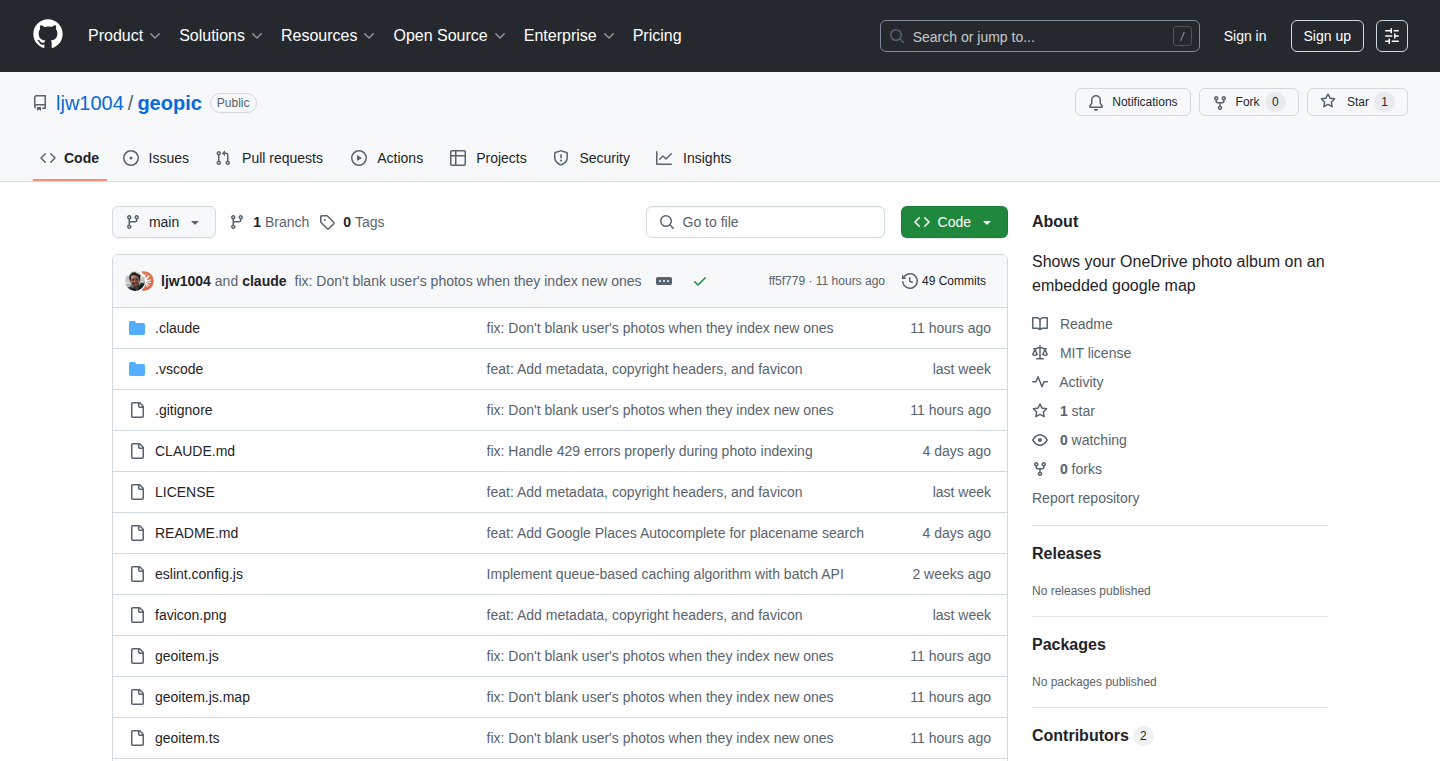
Author
ljw1004
Description
Geopic for OneDrive is a desktop application that allows users to visualize their OneDrive photo collections on an interactive map, filter photos by date and keywords. The project focuses on efficiently handling large photo collections with a custom clustering algorithm and optimizing thumbnail loading. This tackles the problem of lacking a map view in OneDrive, offering a way to explore photos geographically and provides insights into how to create efficient and scalable mapping applications.
Popularity
Points 4
Comments 2
What is this product?
Geopic for OneDrive is a desktop application that takes your photos stored in OneDrive and displays them on a map. It cleverly uses your photo's location data to pinpoint them on the map. The innovation lies in its ability to efficiently handle a massive number of photos, something commercial photo services like OneDrive don't natively offer. It solves a technical limitation by providing a map view and filters based on date and keywords. So, if you're like the creator and have a lot of photos stored in OneDrive, this allows you to see where you took them all over the world. The core technology is around creating a custom marker clustering that's way more efficient for displaying thousands of images on the map (the original version could get very slow).
How to use it?
Developers can use Geopic by forking the open-source project on GitHub and adapting it to work with other cloud storage providers or extend its functionality. To use it, you'd install the application on your desktop, connect it to your OneDrive account, and the app will display your photos on a map. Geopic integrates with the OneDrive API to fetch photo metadata. Technical users can potentially use the code as a starting point for developing similar tools for other cloud storage platforms or integrating photo mapping features into their existing applications.
Product Core Function
· Geographic Visualization: This is the primary feature. It displays photos on a map using their location data. Value: It offers a new way to experience your photo collection, letting you explore your photos based on where they were taken. Application: Ideal for travel enthusiasts or anyone wanting to visually relive their memories.
· Date and Keyword Filtering: Allows users to filter photos based on date and keywords from the photo metadata. Value: It enhances photo search and discovery. Application: Quickly find photos from a specific trip or event or related to a keyword.
· Custom Marker Clustering: A custom algorithm is implemented to efficiently group map markers when many photos are displayed at the same time. Value: Improves performance and user experience when dealing with thousands of photos. Application: Enables the application to handle large photo collections without slowing down the user's browser.
· Optimized Thumbnail Loading: The application uses optimized methods to load photo thumbnails. Value: Reduces data usage and improves loading times. Application: Ensures a smooth and fast user experience, especially on devices with limited internet bandwidth.
Product Usage Case
· Personal Photo Management: Imagine you have thousands of photos on OneDrive. This application provides a way to visualize them on a map, making it easy to browse your travel history or relive specific moments geographically. So this allows you to find where your photos were taken, which would be a very fun experience.
· Custom Mapping Application: Developers can use the custom marker clustering code as a foundation for any mapping application that needs to handle a large number of markers, going beyond the limitations of existing libraries. So it provides code you can reuse.
· Cloud Storage Integration: If you have photos stored on other cloud services like Google Drive or Dropbox, this project can serve as a blueprint for creating similar map views on other platforms. So it enables developers to build for other cloud storage.
18
Contextual Tic-Tac-Toe Champions: GPT-4.1-mini vs. GPT-4.1
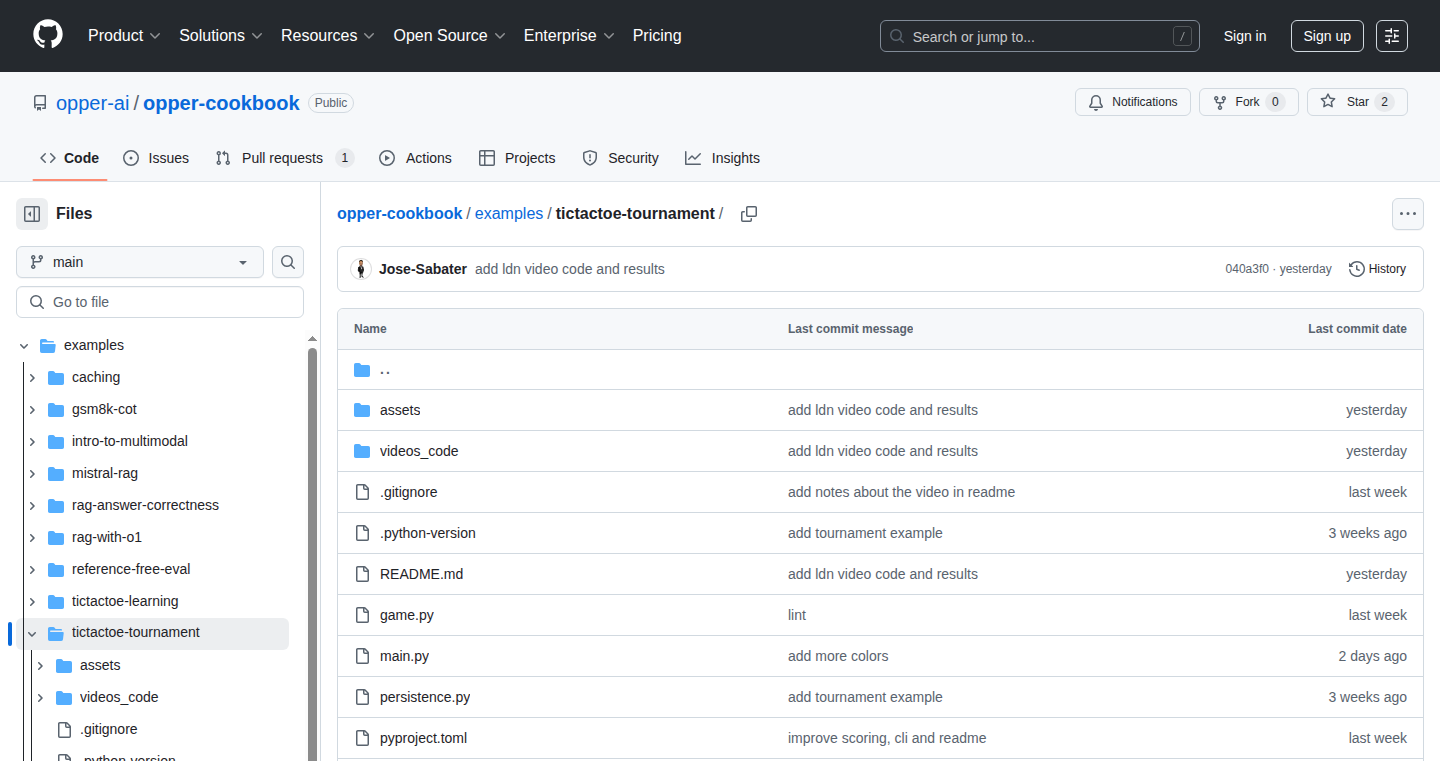
Author
farouqaldori
Description
This project demonstrates how to boost the performance of a smaller AI model (GPT-4.1-mini) to outperform a larger model (GPT-4.1) in a game of Tic-Tac-Toe. The key innovation lies in 'context engineering,' which means providing the smaller model with relevant examples of winning moves just before it needs to make its own move. This highlights the power of targeted information in AI, enabling a faster and more efficient model to achieve superior results.
Popularity
Points 5
Comments 1
What is this product?
This project is a clever experiment in AI. It uses two different AI models to play Tic-Tac-Toe. The core idea is to see if a smaller, faster AI model can win against a larger, more powerful one. The trick is to give the smaller model helpful examples – like a cheat sheet – right before its turn. This method, called context engineering, shows how important it is to give AI the right information at the right time. So, it’s about making AI smarter by feeding it the right context. This challenges the idea that bigger AI models are always better.
How to use it?
This experiment is more for AI researchers and developers. They can use the code and the method to test their own AI models and see how context affects performance. The code is likely available in a repository. You can take the code, modify it, and apply the context engineering technique to other problems and AI models to see how specific examples can boost their performance. For developers, this means you can potentially use smaller, cheaper AI models and still get great results by carefully preparing the input data. So, you can optimize the performance of your own AI-driven applications.
Product Core Function
· AI Model Comparison: The core function compares the performance of two AI models (GPT-4.1-mini and GPT-4.1) in Tic-Tac-Toe. It demonstrates that a smaller model, with the right context, can outperform a larger one. This is valuable for anyone looking to optimize AI model selection for speed and cost. You can use this approach to select the most efficient AI model for any task.
· Context Engineering Implementation: The project uses dynamic context engineering. It dynamically feeds the smaller model examples of winning moves before each turn. The value lies in showing how to use specific, timely information to significantly boost AI performance. This is useful for developers aiming to improve AI model accuracy and efficiency, especially in constrained environments.
· Tournament Simulation: The project sets up a 100-game tournament to evaluate the models’ performance. The value here is the quantitative assessment of the impact of context engineering. You can use this to validate and demonstrate the effectiveness of your AI optimization strategies.
· Code & Repo Availability: The project includes the code and full write-up in a repository. This allows other developers and researchers to replicate and adapt the method. The value is that it makes the knowledge accessible to the community, enabling experimentation and further improvements in AI. Anyone can learn from the techniques and expand on the method.
· Performance Analysis: The project analyzes and reports the performance differences between the two models, with and without context engineering. This provides clear evidence of the impact of context. The value is that it provides a case study in how to effectively evaluate the impact of different engineering choices in AI. You can directly apply the analysis to your own projects.
Product Usage Case
· Predictive Maintenance: Imagine you are building an AI system to predict equipment failures. You could use the context engineering method to give the AI model specific examples of failures and the context leading up to them. This would increase the accuracy of the model. So, you can make better predictions and reduce downtime.
· Fraud Detection: In financial transactions, you can use this technique to help AI models spot fraud more effectively. Feed the AI model examples of fraudulent transactions just before analysis. This helps the model pick up on patterns faster. The result is improved accuracy and quicker fraud detection.
· Customer Service Chatbots: Enhance a chatbot’s ability to provide accurate answers by giving it examples of previous conversations with successful outcomes. This allows the chatbot to understand customer intent quickly. This leads to happier customers and improved efficiency in customer service operations.
· Medical Diagnosis: You could give an AI medical diagnosis tool specific examples of similar cases and the resulting diagnoses. The AI system can improve its ability to provide accurate diagnoses. This provides medical professionals with more reliable tools.
19
Readmenote: Real-time README Previewer
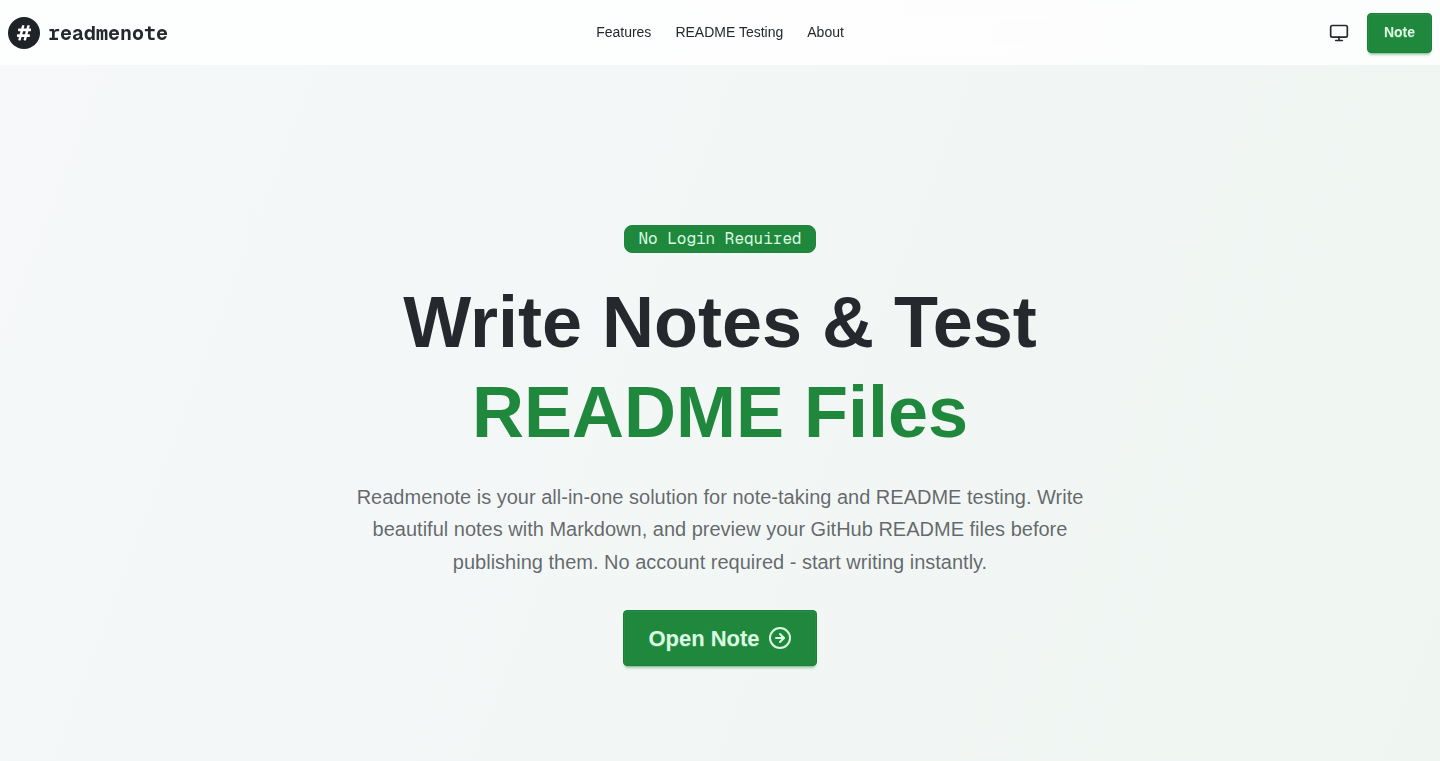
Author
kukuhsain
Description
Readmenote is a web application that allows you to create and preview notes using GitHub's Markdown style, specifically designed to see how your content will render in a README file. It solves the common problem of developers having to commit changes to a repository just to see how their Markdown will look. The core innovation lies in its real-time preview feature, powered by react-markdown, allowing instant visualization of your text formatting within a browser. So this is useful for immediately visualizing how your text will appear when using Markdown.
Popularity
Points 3
Comments 3
What is this product?
Readmenote is a free, no-login-required web app that lets you write notes using the same Markdown format used by GitHub (for things like README files). It's built using technologies like react-markdown (a tool for converting Markdown to HTML) and NextJS (a framework for building web applications). The core idea is to give you a live preview as you write, so you instantly see how your text will be formatted, saving you the hassle of constantly committing changes to a repository just to check the formatting. So this is a useful tool for understanding and using Markdown.
How to use it?
Developers can access Readmenote directly through a web browser (https://www.readmenote.com/). You simply type your Markdown text into the editor, and the preview panel updates in real-time to show you how it will appear when rendered on GitHub. It's particularly useful for creating or editing README files, documentation, or any content formatted with GitHub-flavored Markdown. You don't need to install anything; just open the webpage and start writing. It's a quick and easy way to check your Markdown formatting. So you can use this tool directly inside your browser.
Product Core Function
· Real-time Markdown Preview: This is the heart of the application. As you type your Markdown, the app instantly renders it into the formatted output, allowing you to visualize the final appearance. This saves significant time and effort compared to traditional methods of editing Markdown and checking the results on GitHub. This helps you format your texts and documents more efficiently.
· GitHub-Flavored Markdown Support: The app supports the specific Markdown syntax used by GitHub, including features like code blocks, tables, and task lists. This ensures that your notes and README files will look exactly as intended on GitHub. This ensures that your documents looks exactly as intended on Github.
· Browser-Based Data Storage: The notes are saved in your browser's local storage. This means your work is preserved even if you close the browser or refresh the page, eliminating the need for logins or external storage. So it is a easy and safe way to keep your notes.
Product Usage Case
· README File Creation: A developer is writing a README file for a new open-source project. They use Readmenote to preview how different sections, such as the project description, installation instructions, and usage examples, will appear. This allows them to format the README perfectly before committing it to the repository, ensuring a professional and easy-to-understand presentation. So this is useful for all README files creators.
· Documentation Editing: A team is updating the documentation for a software library. Using Readmenote, they can quickly see how changes to the documentation text, including code snippets and formatting, will look before integrating them into the main documentation system. This eliminates the need to build and deploy the documentation to check for formatting errors. So this is useful for writing and editing documentation.
· Collaborative Note-Taking: While not designed as a collaboration tool, Readmenote can be used as a quick way for multiple developers to preview and share their Markdown notes before integrating them into a larger project. They can copy and paste the Markdown text and preview the output, ensuring consistency in formatting. So it can be used for collaboration.
20
RealEstateAgentAI: Smart Assistants for Real Estate Professionals

Author
edgware674
Description
This project leverages the power of AI agents to automate and enhance various tasks for real estate agents. It uses large language models (LLMs) to understand and respond to complex requests, manage client interactions, and generate personalized content. The core innovation lies in providing a highly customized and efficient AI assistant, streamlining agent workflows and potentially improving client satisfaction.
Popularity
Points 3
Comments 2
What is this product?
This project builds AI agents specifically tailored for real estate agents. Think of them as smart assistants powered by AI. They use advanced language models – the same technology that powers things like ChatGPT – to understand what agents need, like summarizing property details, crafting email responses, or even generating social media posts. The innovation is in applying this technology to a specific industry, providing a focused tool to solve common problems.
How to use it?
Real estate agents could use this by integrating the AI agents into their existing communication and workflow systems. For instance, the agent could send an email draft request with property details and the AI assistant generates the response. Agents can also use an API to integrate the AI agent into their CRM or other software. So, this is like having a 24/7 virtual assistant that can help agents focus on building relationships with clients, showing properties, and closing deals.
Product Core Function
· Automated Email and Communication: The AI agent can draft professional emails to potential clients, schedule showings, and follow up on leads. So, this saves you time by reducing the repetitive writing tasks and helping you respond to clients promptly.
· Property Information Summarization: Agents can input property details, and the AI agent generates concise summaries for marketing materials and client presentations. So, you save time, and the summaries help highlight the key features of the property quickly.
· Client Interaction Management: The AI can analyze client inquiries and provide personalized responses, answering questions and offering relevant information. So, you're providing a consistent and high-quality service, even when you are busy.
· Content Generation for Marketing: The AI assists in creating social media posts, blog content, and marketing brochures. So, you can generate engaging marketing content more easily to attract potential clients and property sellers.
Product Usage Case
· Drafting Listing Descriptions: An agent needs to create a compelling description for a new property listing. They provide the agent with the property details (e.g., square footage, number of bedrooms, and special features), and the AI agent generates a draft that is optimized for online listing platforms. This saves time and effort while ensuring that the listing is well-written and attractive to potential buyers. So, you can list your properties faster and get better results.
· Responding to Client Inquiries: A client emails an agent with a complex question about local schools, amenities, and comparable properties. The AI agent analyzes the email, gathers relevant information from various sources, and provides a detailed, personalized response. The agent has more time to focus on client interaction and generate sales leads. So, you can respond quickly and provide clients with comprehensive information, enhancing their experience.
· Generating Social Media Content: An agent needs to promote a new open house on social media. They provide the AI agent with the open house details, and the AI agent generates a catchy social media post with engaging visuals and key information. This helps attract more potential buyers to the open house. So, you can easily manage and automate your marketing activities.
21
IPA Pronouncer: Instant English Pronunciation via Web
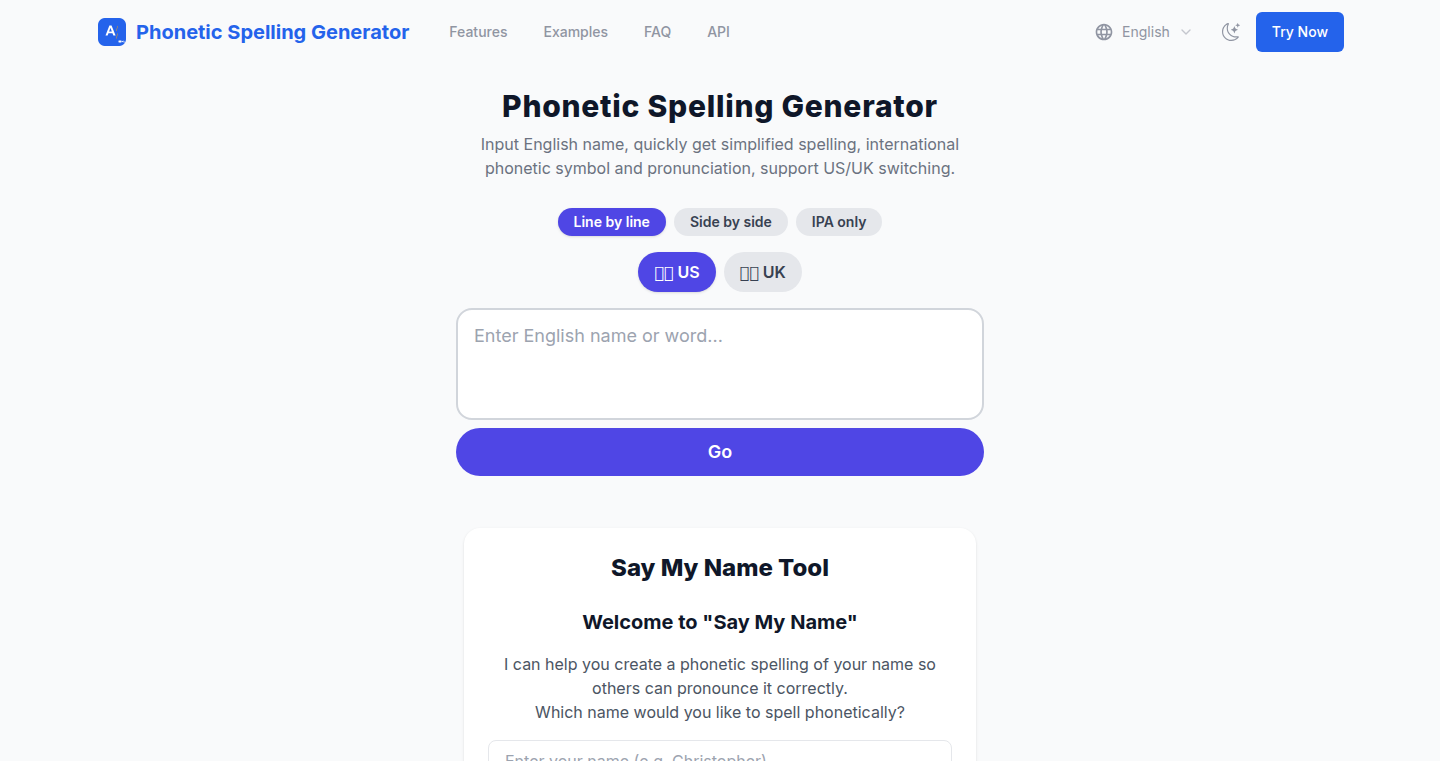
Author
combineimages
Description
This project is a web-based tool that instantly provides the International Phonetic Alphabet (IPA) pronunciation for English words. It solves the common problem of needing quick and accurate pronunciations, especially for non-native speakers or anyone learning a new word. The technical innovation lies in its ability to rapidly look up and display the IPA symbols, making it a very efficient way to learn how to pronounce a word correctly.
Popularity
Points 4
Comments 1
What is this product?
It's a simple web application that takes an English word as input and outputs its IPA pronunciation. The project likely uses a dictionary database or a linguistic model to map English words to their corresponding phonetic representations. So, instead of spending time looking up pronunciations in a dictionary, you can get the answer instantly.
How to use it?
Developers can easily integrate this into their projects via an API or by simply embedding the web application. For example, it could be used in language learning apps, text-to-speech systems, or even as a tool within a writing assistant. Think of it as a pronunciation lookup library that’s readily available. You’d use it by sending the English word as input and then displaying the output IPA symbols in your application.
Product Core Function
· Instant Pronunciation Lookup: This is the core functionality. It allows users to quickly find the IPA pronunciation of any given English word. It saves time and frustration by providing immediate access to the phonetic transcription. So this is useful for anyone learning English or working with English text.
· User-Friendly Interface: The project's interface is likely clean and easy to use. It will help users quickly understand how to input words and view the pronunciations, making it accessible to both technical and non-technical users. So this is useful for a wide variety of users.
· Potential API Integration: A well-designed project might provide an API, enabling other applications to easily access the pronunciation data. This facilitates integration into other language learning tools, speech synthesis systems, and various applications. So, this is useful for integrating into larger projects.
Product Usage Case
· Language Learning App Integration: Imagine a language learning app where users can tap a word and instantly see its IPA pronunciation. This tool would fit perfectly, helping users understand how to pronounce the words correctly. So this will allow users to learn pronunciation alongside vocabulary.
· Text-to-Speech Enhancement: Developers creating text-to-speech applications could utilize this tool to improve pronunciation accuracy. By using the IPA data, these apps could synthesize speech that sounds more natural and precise. So this can improve the quality of text-to-speech systems.
· Vocabulary Builder: This can be used in a vocabulary builder application. Users can input the word and see its IPA pronunciation which then can be saved along with the definition and example sentences. So this will help users better understand words and how to pronounce them.
22
KisanAI: A Flask-powered WhatsApp Agricultural Assistant
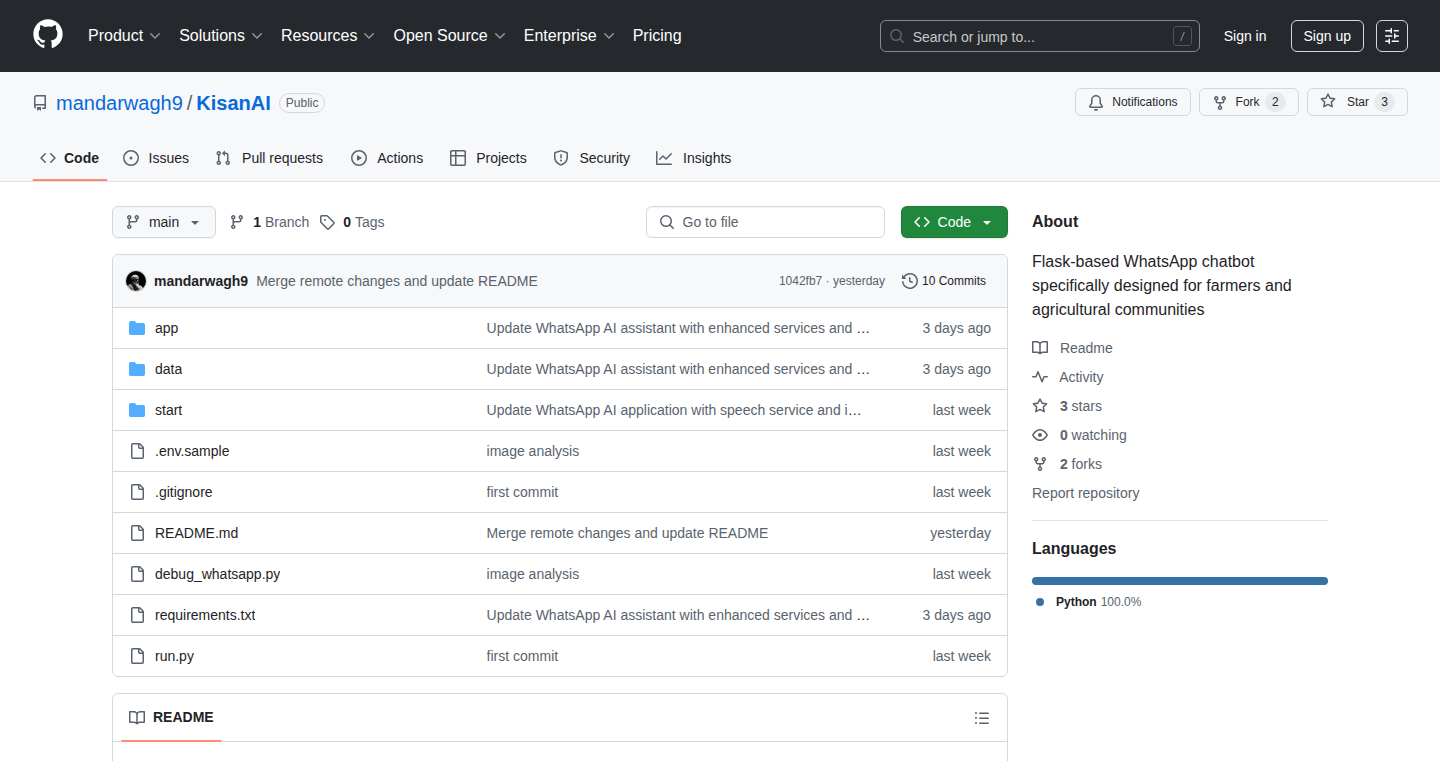
Author
mandarwagh
Description
KisanAI is a Flask-based chatbot, specifically designed for farmers, that leverages Google's Gemini AI to provide smart agricultural assistance via WhatsApp. It addresses the critical need for accessible and accurate farming information, including crop disease identification, market updates, and government scheme details. The innovation lies in its integration of AI for intelligent responses, voice message support, multilingual capabilities, and conversation memory. This empowers farmers with immediate, personalized advice and information directly on their phones.
Popularity
Points 2
Comments 3
What is this product?
This project uses Python's Flask framework to build a WhatsApp chatbot. It integrates with Google's Gemini AI, which is a powerful artificial intelligence model. The core idea is to provide farmers with immediate answers to their agricultural questions. For example, if a farmer has a plant disease, they can send a picture, and the AI will try to identify it and give recommendations. It also provides market prices, government schemes, and support for different languages. So this is a smart assistant for farmers, providing practical advice on their phones. So this is very useful because it puts important farming knowledge directly into farmers' hands.
How to use it?
Developers can use this project as a starting point to build their own chatbots. They can customize the AI model, integrate different data sources, and add new features. To use it, the developer needs to set up a WhatsApp Business account and connect it to the Flask application. Farmers can then interact with the chatbot by sending text or voice messages. So, if you are building agricultural solutions or want to experiment with AI chatbots, this project provides a solid foundation. So this allows developers to create specialized solutions tailored to specific needs.
Product Core Function
· Agricultural Intelligence: This function uses AI to provide answers to farming questions, offering advice on crop management and agricultural practices. It's like having an expert in your pocket. So this helps farmers make better decisions about their crops.
· Crop Disease Detection: By analyzing images sent by farmers, the AI can identify plant diseases and recommend treatments. This helps farmers quickly diagnose and address problems. So this protects crops and reduces losses.
· Market Price Information: The chatbot provides real-time information on crop prices and market trends, helping farmers make informed decisions about when to sell. So this helps farmers get the best price for their produce.
· Government Schemes: It provides information about government subsidies, schemes, and farmer benefits, ensuring farmers are aware of available support. So this helps farmers take advantage of available resources.
· Voice Message Support: Farmers can send audio messages, which the system automatically transcribes. This makes it easier for farmers with low literacy to interact. So this increases accessibility.
· Multilingual Support: The chatbot supports different languages, making it accessible to a wider range of farmers. So this breaks down language barriers.
· Knowledge Base: The chatbot integrates a comprehensive agricultural knowledge database, offering a broad range of information. So this provides farmers with easy access to important data.
· Conversation Memory: The system remembers the chat history, providing personalized advice based on previous interactions. So this enhances the user experience.
· WhatsApp Integration: Seamlessly integrated with WhatsApp Business API for convenient communication. So this allows farmers to use a familiar platform.
· Secure Communication: Uses HMAC signature verification to ensure secure communication via webhooks. So this protects user data and privacy.
· Response Validation: Provides quality assurance for AI-generated agricultural advice, ensuring accuracy. So this helps ensure the information provided is correct.
Product Usage Case
· A farmer can use the chatbot to diagnose a potential disease in their tomato plants by sending a photo. The AI, through image analysis, would suggest possible diseases and recommend treatment, saving the farmer time and potential crop loss. This application directly addresses a key problem in agriculture and provides immediate value.
· A cooperative can integrate the chatbot to provide its members with real-time market prices and government scheme updates. This enhances communication and ensures farmers have timely access to crucial information, fostering better decision-making and community support. This directly benefits farmers by providing market information and government programs in their pocket.
· An agricultural extension officer can use the chatbot to automate the answering of frequently asked questions. This allows them to focus on more complex issues, improving the efficiency of their work. This provides extension officers with a tool to efficiently assist a larger number of farmers.
· A software developer could use the codebase of KisanAI as a template to build a chatbot for different fields, like healthcare or education. They can change the AI model, and change the data sources to customize the features for those areas. This showcases how the project can lead to new innovative applications.
· A technology company can use the KisanAI project to develop a new business by offering a customized and more advanced chatbot for a subscription service, providing various agricultural advice to farmers. This can generate revenue and also contribute towards the advancement of agricultural practices.
23
IncentivizeThis: Bounties for Online Engagement with AI-Powered Verification and Solana Payouts
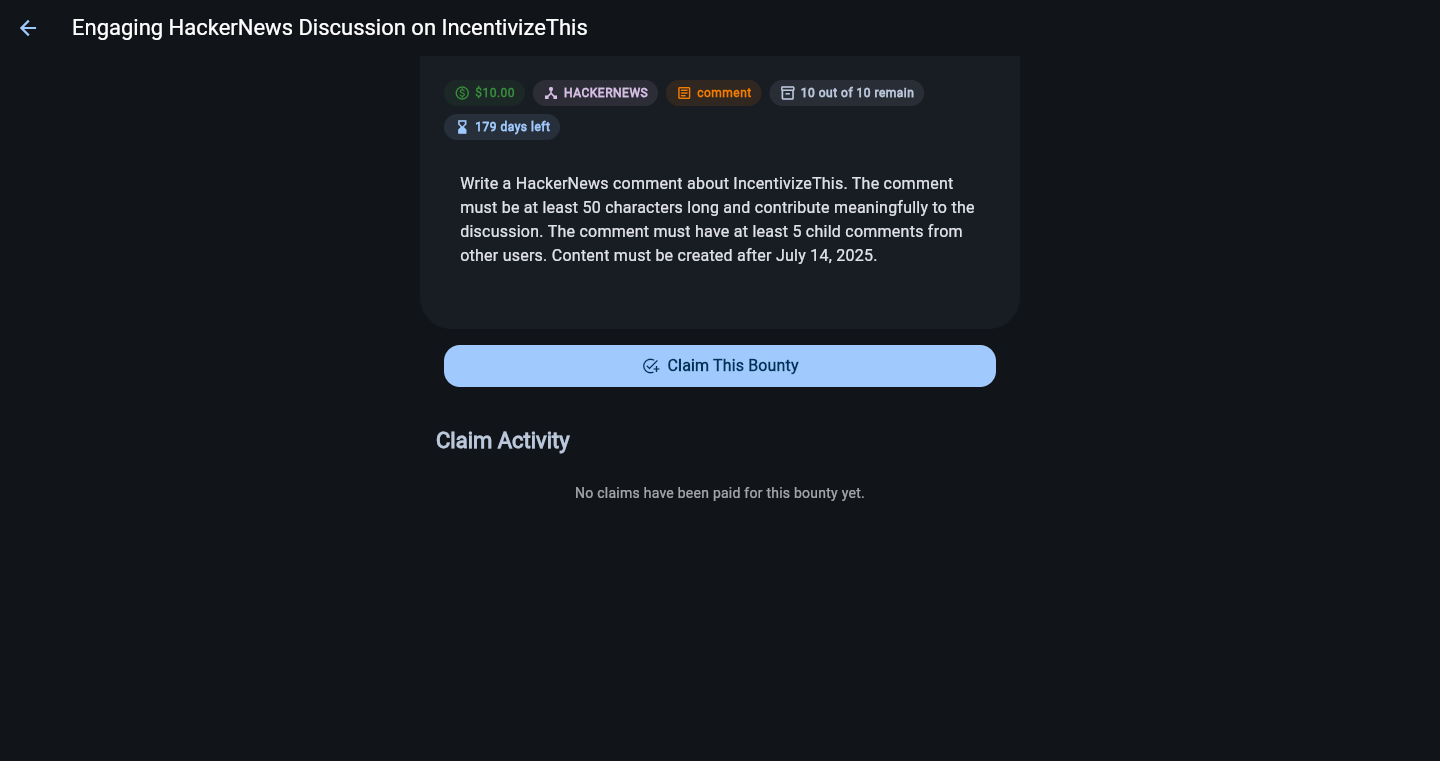
Author
graerg
Description
IncentivizeThis is a platform that uses bounties to reward users for generating specific types of online content and achieving certain metrics (e.g., upvotes). It moves away from traditional advertising, encouraging organic engagement. The platform leverages Temporal workflows for reliable bounty management, "AI" for verifying content fulfillment, and Solana for fast cryptocurrency payouts. This innovative approach incentivizes valuable user contributions in a new way.
Popularity
Points 1
Comments 4
What is this product?
This platform allows businesses to offer rewards (bounties) for user-generated content that meets specific criteria. The core idea is to replace traditional advertising with incentivized organic content creation. The technology uses "AI" to check if the content meets the bounty's requirements (like mentioning a business and getting enough upvotes). It uses Temporal workflows to make sure the bounties are managed reliably, even if something goes wrong. Payouts are made using Solana, a fast and efficient cryptocurrency, to ensure users receive their rewards quickly. So this gives businesses a new way to get attention and engage with users, while also giving users a chance to earn rewards for creating content.
How to use it?
Businesses can use IncentivizeThis by defining specific content requirements and metrics (e.g., Reddit comment mentioning their business with 100+ upvotes). They set a bounty amount, and users create content to try and meet the criteria. When a user's content meets the requirements, the "AI" verifies it, and the user receives the bounty payment via Solana. For developers, this means integrating with the platform's API (details would be available on their site) to create bounties, monitor performance, and manage payouts. This could be integrated into existing marketing and community management tools. This means developers can build tools to help businesses manage bounties and track their effectiveness. Businesses would likely interface via the website or API to create and manage their campaigns.
Product Core Function
· Bounty Creation: Businesses can define bounties specifying content requirements and rewards. Value: Provides a structured way for businesses to incentivize specific types of user engagement, driving relevant content creation. Application: Enables businesses to request reviews, social media mentions, or other content types in exchange for a reward.
· AI-Powered Content Verification: "AI" analyzes user-generated content to ensure it meets the bounty criteria. Value: Automates the process of verifying content fulfillment, reducing manual effort and ensuring fairness. Application: Automates the process of verifying content. If the bounty asks for a comment on reddit with more than 100 upvotes, the AI determines whether the upvote criterion has been fulfilled.
· Temporal Workflow Management: Uses Temporal to ensure bounty lifecycles are reliable and durable, even in case of failures. Value: Guarantees the integrity of the bounty system, ensuring that bounties are always processed correctly and users are paid. Application: Ensures bounties are always honored, even if there are technical issues during the process. If a server goes down in the middle of a verification, the system can recover and ensure the payment is processed.
· Solana-Based Payouts: Uses Solana for fast and efficient cryptocurrency payouts. Value: Enables quick and low-cost transactions, allowing users to receive their rewards quickly. Application: Provides a streamlined payment process, improving user satisfaction and encouraging participation in the bounty program.
Product Usage Case
· Marketing Campaign: A business wants to promote a new product and sets a bounty for engaging comments on a specific forum mentioning the product and garnering positive feedback. Developers could build a tool to track the progress of these bounties and analyze their effectiveness. This provides a low-cost way to generate organic buzz and reviews.
· Community Engagement: A company needs to build a following on a social media platform and create content. They offer bounties for quality comments and posts, encouraging users to create specific content about their brand or product. Developers can create bots to identify content that fulfills the requirements of the bounty.
· Research and Feedback: A company offers bounties for users that provide feedback on a product. Users would be rewarded if they submit feedback on their product. This allows them to gain insights on user feedback by incentivizing them to do so.
24
WorldSnap: Real-time Photo Mapping

Author
stagas
Description
WorldSnap is a project that displays real-time photos on a world map. It grabs images (currently cat pictures) and pins them to the map based on their geographic data. The technical innovation lies in the real-time mapping of images, demonstrating how visual data can be dynamically linked to location. It addresses the challenge of visualizing a constant stream of image data on a global scale, providing a simple but compelling example of geo-visualization.
Popularity
Points 4
Comments 1
What is this product?
WorldSnap is a web application that takes photos and places them on a world map in real time. The core idea is to connect visual data (images) with geographical data (location). It uses a mapping technology to display images dynamically based on their associated coordinates. This project shows how to visually represent information that is tied to a specific location, which is great for various location-based services. So, this is great for showing a real-time data stream associated with locations.
How to use it?
Developers can use WorldSnap as a starting point to visualize location-based data. Imagine building a platform that displays photos from users in real-time, like a social media app. You could use the underlying mapping technology to map anything with a location, like traffic data, weather information, or even real-time reports of something like stock transactions. Integration would involve connecting your data source to the mapping service. So, you can use it to display any geo-location data you have on a map.
Product Core Function
· Real-time image mapping: This core feature visualizes images dynamically based on their geographical coordinates. This is valuable for any application needing to represent data on a map with constantly updated content. Applications include social media feeds, live event tracking, and more.
· Data visualization of location data: The project demonstrates how location data can be used to create a compelling visual experience, providing developers with a simple example of using location data. This is useful for making data easier to understand.
· Simple integration: The project's architecture is designed to be relatively simple, making it easier for developers to understand and integrate into their own projects. This is useful for quickly prototyping ideas or for educational purposes.
Product Usage Case
· Social Media Feed: Visualize where user-uploaded photos are being taken in real time. This could be integrated into a social networking site to create a dynamic world map of photo uploads. For example, you can show where your followers are taking photos now. So you can see the world's image data in real time.
· Event Tracking: Track the location of events or activities, displaying them in real-time on the map. This could be used by news outlets, sports websites, and event organizers. For example, show where the Olympic games attendees are. So you can track events happening around the world.
· Data Monitoring: Display sensor data, such as temperature or pollution levels, on a world map. The mapping technology is a general technology, therefore it can be used for many types of location based data. So you can visualize any location based data on the map.
25
Hoff: Declarative DOM Manipulation
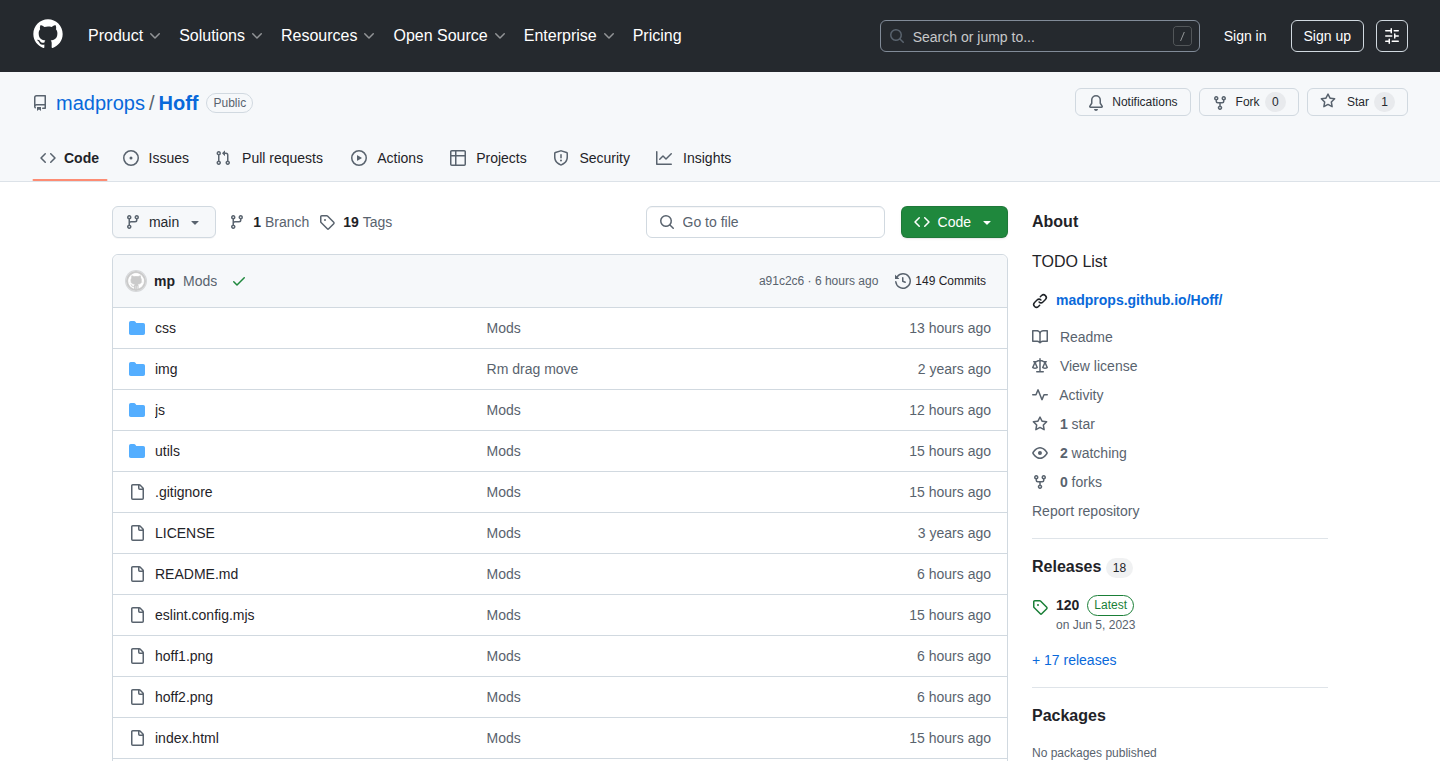
Author
complex_city
Description
Hoff is a project that simplifies the way developers interact with web pages by allowing them to describe the desired structure of a webpage (the Document Object Model, or DOM) in a more straightforward and efficient way. It's like giving developers a blueprint for their webpage, rather than making them build it piece by piece with code. The innovation lies in its declarative approach, making the creation and modification of web page elements much more manageable, and easier to understand. It tackles the problem of complex and verbose JavaScript code often used for dynamic content manipulation, making it more efficient and maintainable.
Popularity
Points 1
Comments 4
What is this product?
Hoff takes a different approach to building web pages. Instead of developers writing a lot of JavaScript code to create and change parts of a webpage, they describe what they want the page to look like. Hoff then figures out how to make that happen. It's like telling a builder what kind of house you want (the blueprint), and the builder takes care of the construction. This improves the development process by making it easier to understand and change how the page looks. It helps developers by providing a concise way to express the desired structure of web pages, reducing the amount of code needed and making the entire process more organized. So this allows you to quickly and simply manage dynamic web content without extensive coding.
How to use it?
Developers can use Hoff by including its library in their project, and then writing code that describes the structure of the webpage. This code is usually simpler and more readable than the traditional JavaScript code needed for DOM manipulation. You define the elements you need and how they relate to each other, like specifying headings, paragraphs, and images, and their order. The library handles the actual creation of the web elements in the browser. You could integrate this in your web app to dynamically generate and update sections of your web pages based on data or user input, providing a smooth and interactive user experience.
Product Core Function
· Declarative DOM manipulation: This is the core concept. Instead of telling the computer *how* to create elements, you tell it *what* the elements should look like, and the library takes care of the details. It simplifies the process of building and modifying webpages, because you write less code. So this makes it easier to manage and update web pages.
· Simplified web structure description: Provides an easier way to express the HTML structure and how different elements are related. You describe how you want things to look, which makes it easier for developers to see what the page is going to do. So you'll find it easy to understand the page's structure at a glance.
· Efficient updates: The library efficiently handles changes to the web page when the underlying data changes. This reduces the amount of manual coding required, and therefore reduces errors. So you have more efficient web apps with automatic updates.
· Improved code maintainability: The code written with Hoff is typically easier to understand and modify, making it simpler to maintain over time. This means easier updates and faster debugging. So you have a code that is organized and easier to update.
Product Usage Case
· Dynamic forms: Imagine you want to generate a form for users to fill out. With Hoff, you can define the structure of the form (fields, labels, buttons) in a declarative way. When the user interacts with the form, or data changes, Hoff can update the form elements efficiently. So you can quickly develop interactive user interfaces for your web application.
· Real-time dashboards: If you need a dashboard that updates constantly with new data (like stock prices or sensor readings), you can use Hoff to update only the parts of the webpage that need to change. You describe the visualization requirements, and the library handles the updates. So you have dynamic and reactive dashboards.
· Web application prototyping: You can create and modify web page elements easily with Hoff to experiment quickly, which is especially useful when prototyping different user interface ideas. So you can rapidly build and test different web application layouts.
26
RapidChart: AI-Powered Diagram Generation for Technical Design
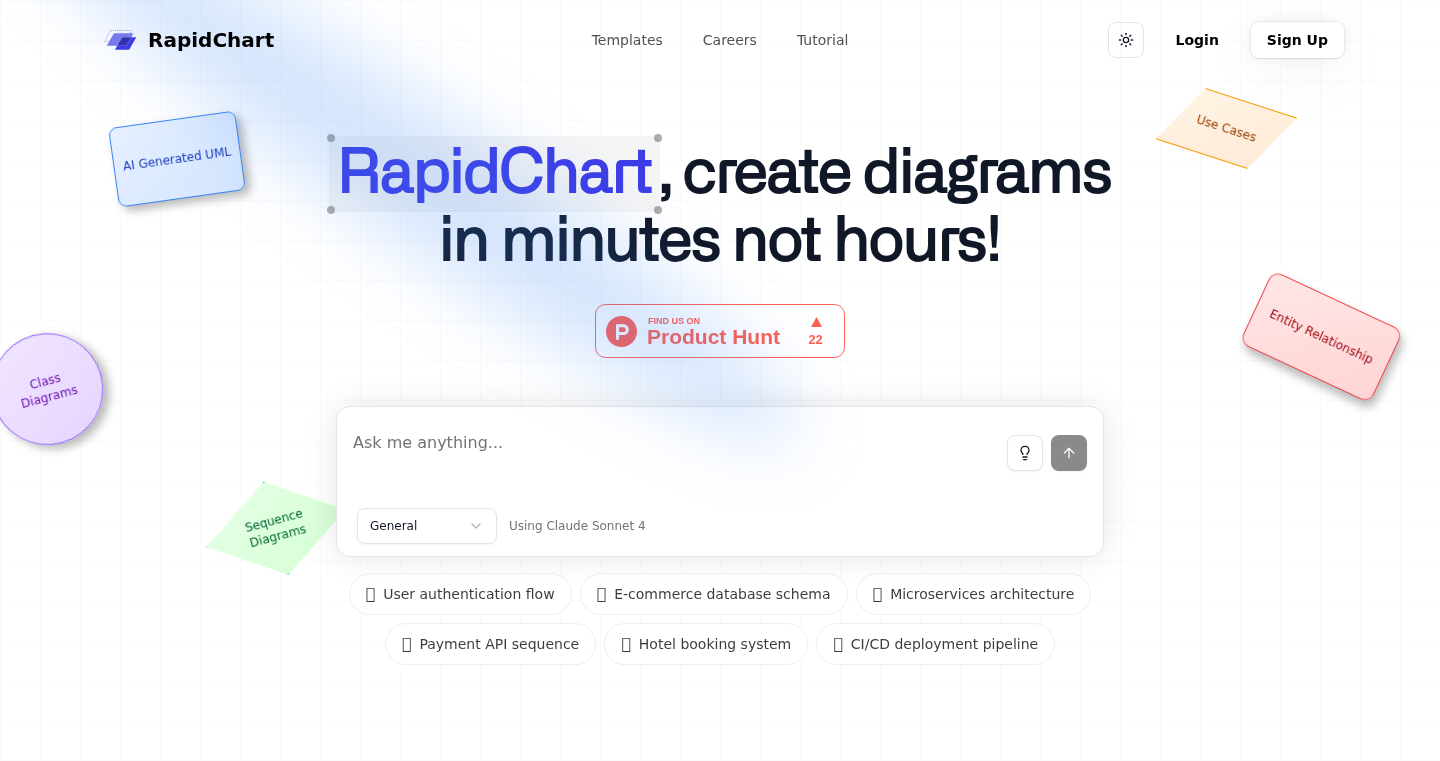
Author
SamiCostox
Description
RapidChart is a tool designed to quickly generate technical and system design diagrams. It tackles the common problem of tedious diagram creation by offering a cursor-based interface and AI integration. The key innovation lies in its ability to use AI, like GPT-4 and Claude, to assist in diagram generation, making the process faster and more efficient. This project addresses the time-consuming nature of manual diagramming, providing a streamlined solution for developers to visualize complex systems.
Popularity
Points 4
Comments 0
What is this product?
RapidChart is a diagramming tool that simplifies the creation of technical diagrams. It works by providing a cursor-based interface for rapid diagram construction. The innovative part is its integration with AI models. You can leverage these AI tools to automate parts of the diagram creation process, suggesting layouts, relationships, and even generating the diagrams from textual descriptions. So, it is like having an AI assistant that helps you create diagrams, saving you time and effort. This is different from traditional diagramming tools, which often require manual drag-and-drop and alignment, which can be very time consuming.
How to use it?
Developers can use RapidChart by inputting textual descriptions or prompts. The tool then utilizes AI to generate diagrams based on this input. Developers can iterate through different diagram variations suggested by the AI and customize the diagrams as needed. The diagrams can be used to document system architecture, data flow, or any other technical aspects of a project. You can embed them in documentation, share them in presentations, or use them for team collaboration. The tool's ease of use and AI capabilities allow you to quickly visualize complex ideas, making communication and understanding of technical concepts much easier.
Product Core Function
· Cursor-based Interface: RapidChart uses a cursor-like interface, allowing for faster diagram creation. This streamlines the process of drawing diagrams compared to traditional drag-and-drop tools. So this speeds up diagramming, helping you focus on the design rather than the tools.
· AI-powered Diagram Generation: The tool integrates with large language models (LLMs) like GPT-4 and Claude, enabling the generation of diagrams from text-based prompts. This automates a significant part of the diagramming process, reducing manual effort and time. You can describe what you want, and the AI will create the diagram for you.
· Customization Options: RapidChart offers full customization options, allowing users to adjust the generated diagrams to their specific needs. This flexibility ensures the diagrams accurately reflect the technical details of the project. So you can make sure the diagrams match exactly what you need.
· Iteration with AI: The tool lets users iterate with AI, selecting different variations and refining the diagrams based on AI suggestions. This iterative process helps users find the best representation of their system design. So this is like having a brainstorming partner that helps you refine your ideas.
Product Usage Case
· System Architecture Documentation: Developers can use RapidChart to quickly create diagrams of their system's architecture, including components, connections, and data flow. This is useful for understanding, documenting, and communicating how the system is structured. This helps everyone on the team understand the system easily.
· Data Flow Visualization: The tool can be used to visualize data flows within a system, showing how data moves between different components. This aids in understanding the data processing logic and identifying potential bottlenecks. This makes it easier to debug issues and improve performance.
· API Documentation: Developers can create diagrams illustrating how different APIs interact, which can be included in API documentation or shared with other developers. This simplifies the process of understanding and using APIs. This makes working with APIs much easier.
· Presentation and Collaboration: Technical diagrams generated using RapidChart can be used in presentations and shared with team members to improve understanding and collaboration. This improves communication and saves time during meetings.
· Technical Design Reviews: Diagrams can be generated during technical design reviews to visually represent the proposed design and facilitate discussions. This enhances the quality of technical reviews and ensures everyone is on the same page.
27
DataNormalizer: Quick Normal Distribution Checker
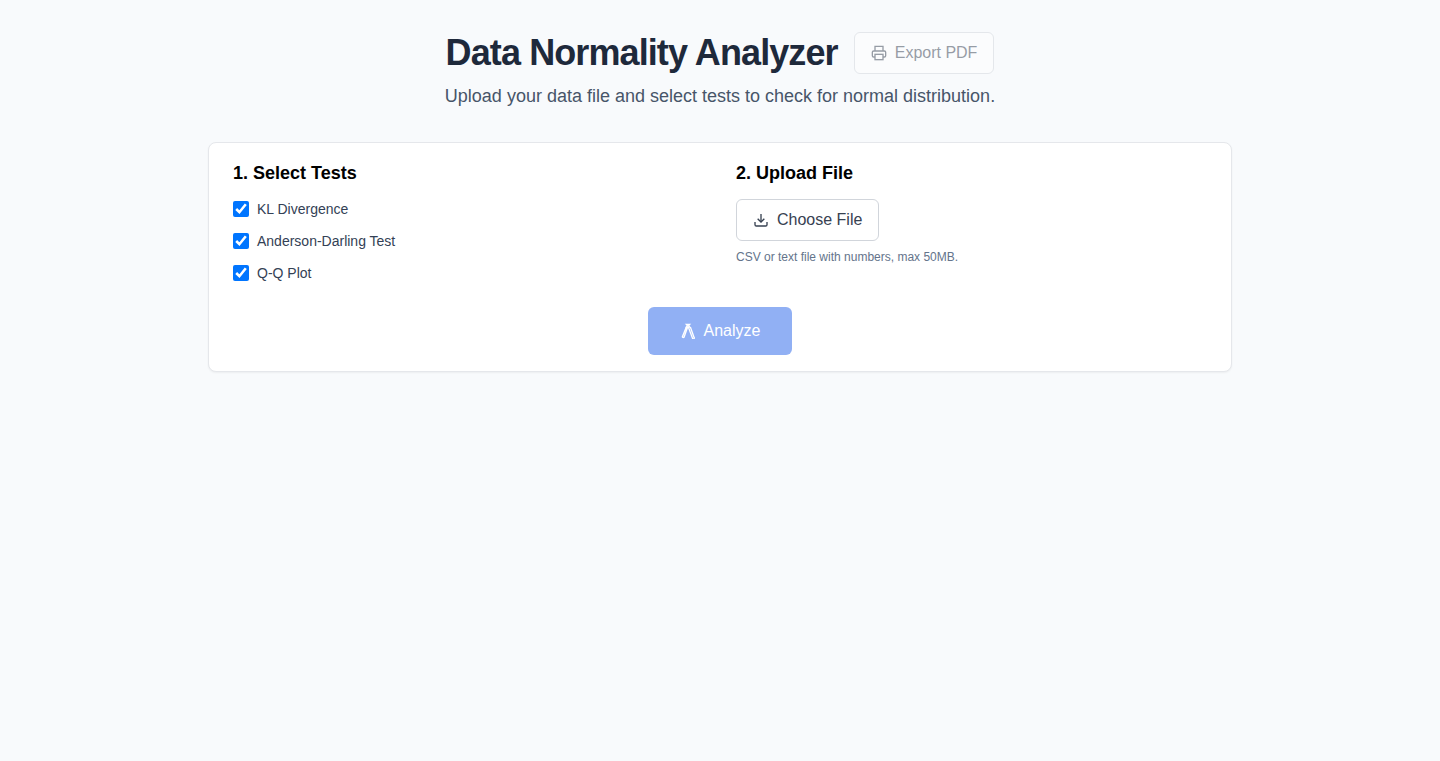
Author
shaishai
Description
This project is a simple, web-based tool that quickly checks how closely your data resembles a normal distribution. You upload a column of data (like from a CSV file), and it calculates a score showing how similar your data is to the bell curve of a normal distribution. It uses a method called KL divergence to compare your data to a normal distribution with the same average and spread. This is useful because many statistical tests assume your data is normally distributed, and this tool helps you quickly check if that assumption is valid. So it provides a quick way to understand if your data fits the common statistical assumptions, saving time and potential errors.
Popularity
Points 2
Comments 2
What is this product?
DataNormalizer is a web application that analyzes your data and tells you how close it is to a normal distribution (the famous bell curve). It does this by comparing your data to a theoretical normal distribution using a technique called KL divergence. Essentially, it measures how different your data is from the perfect bell curve. This is valuable because many statistical analyses depend on the assumption that your data follows a normal distribution. This tool removes the need for coding and lets you check it quickly.
How to use it?
To use DataNormalizer, you simply upload a single column of data from a CSV file. The tool then automatically analyzes the data and gives you a score. This score indicates how well your data fits a normal distribution. You can use this to quickly validate the data prior to performing different statistical analysis or visualizing your data. For example, if you're working on a project to understand customer behavior, you can check if the time spent by each customer on a website or other user behaviours are normally distributed. This can help confirm whether you can use certain statistical tools that rely on that assumption.
Product Core Function
· Data Input: Accepts data in CSV format, allowing users to easily upload and analyze their data. This makes it user-friendly and accessible for non-technical users.
· KL Divergence Calculation: Computes the KL divergence between the user's data and a normal distribution with the same mean and standard deviation. This is the core of its technical functionality. The calculation provides a numerical score to determine if your data fits the normal distribution.
· Result Output: Presents the analysis results in a clear and concise manner, likely providing a score or metric indicating how closely the data resembles a normal distribution. This helps people know quickly and clearly the characteristics of their data.
· Web-Based Accessibility: Being a web application, it eliminates the need for installation or complex setup, making it immediately accessible to anyone with a web browser. This means it's easy to use for testing different datasets.
Product Usage Case
· Analyzing Sensor Data: Imagine you're collecting data from a temperature sensor. You can use DataNormalizer to check if the temperature readings are normally distributed. If they are, you might be able to use more advanced statistical analysis. So it allows data scientists to test their data properties easily.
· Understanding User Behavior: Suppose you're studying how long users spend on a website. You can use DataNormalizer to see if the time spent by users is normally distributed. Knowing this helps inform the use of statistical methods for user-behavior analysis. This lets a product manager confirm whether a feature's usage is normally distributed.
· Evaluating Survey Results: When analyzing survey data, like the responses to a question, you can determine if the data can be considered normally distributed, which is often necessary for statistical testing. This allows researchers to confirm if their survey results can be used within their existing model, for example, A/B testing. This allows for quick confirmation of data assumptions.
28
RealBackgammon: A Backgammon Board with Realistic 3D Dice Simulation

Author
stagas
Description
This project is a digital backgammon board that strives for realism. The creator, driven by the desire for a backgammon experience with realistic mechanics, like the 3D dice roll, built this. It allows users to play a full game on a single device (computer or mobile). It focuses on simulating physical world elements, like the dice roll, within a digital environment, presenting a more immersive gaming experience.
Popularity
Points 2
Comments 2
What is this product?
RealBackgammon is a digital backgammon game that simulates the physics of a real backgammon board, particularly the dice rolls. Instead of simple random number generation, the project likely uses a 3D model and physics engine to simulate how dice tumble and land. This adds a layer of realism and visual appeal not commonly found in digital board games. The core innovation lies in the implementation of realistic physics and the use of 3D graphics to create a more engaging and convincing game environment. So this provides a more immersive and visually appealing backgammon experience compared to traditional digital versions.
How to use it?
Developers could use this project as a starting point or inspiration for creating other board games or simulations requiring realistic physics. They could learn from the 3D dice implementation and adapt the code to their own projects. They could integrate the dice simulation into other games or educational applications. It is used on computers and mobile devices. So developers can leverage its core components to build realistic physics simulations in their projects.
Product Core Function
· Realistic 3D Dice Simulation: This feature models how dice behave when thrown, simulating the physics of their motion and eventual landing. This enhances the game's realism and visual appeal. This can be useful for any game needing a realistic random element.
· Backgammon Game Logic: The project implements the rules and mechanics of backgammon. It allows users to play a complete game, covering piece movement, scoring, and win conditions. This allows users to fully engage with a realistic backgammon game.
· Cross-Platform Compatibility: The ability to play on both computers and mobile devices is key. This demonstrates the project's adaptability across different devices. Therefore, it offers a convenient experience for players, allowing them to enjoy the game wherever they are.
· User Interface: The project must include a way for users to interact with the game, including controls to move pieces, roll dice, and manage their game state. The interface makes the gameplay smooth and helps the user keep track of the current status of the game.
Product Usage Case
· Developing a physics-based game: Developers can analyze the dice physics code to learn how to simulate realistic movements in their own games. They can apply similar techniques for other elements like card shuffling or object collisions in a racing game.
· Building educational simulations: The 3D dice simulation could be adapted to teach probability and statistics by demonstrating how random events occur. It's a good way for students to understand the concepts of probability.
· Creating a digital board game platform: The project's architecture and gameplay mechanics could be used as a blueprint for building a platform where players can play various board games with realistic physics. This could bring a new dimension to digital board gaming.
29
Claude Code SDK for Ruby
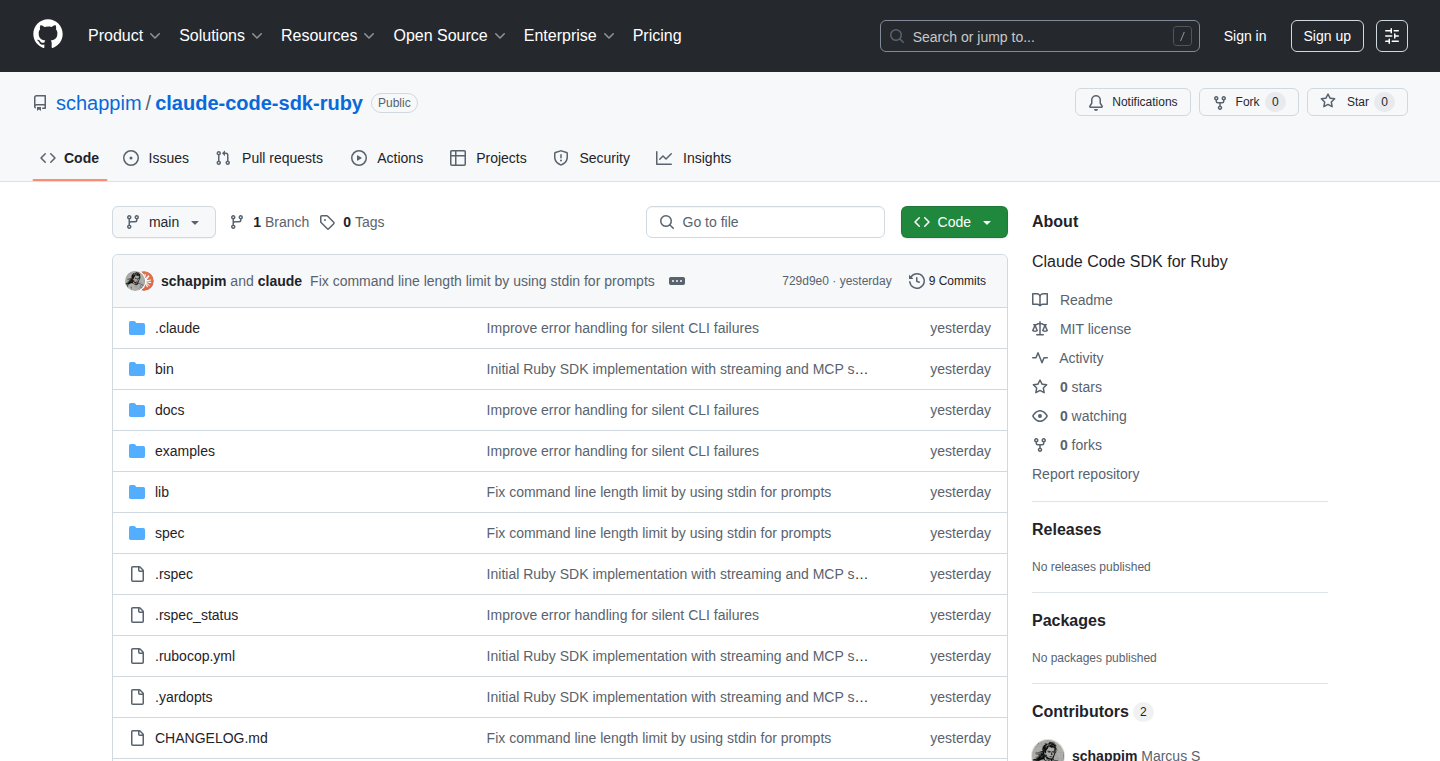
Author
schappim
Description
This project offers a Ruby Software Development Kit (SDK) that simplifies interaction with the Claude AI model, specifically for tasks involving code. It addresses the need for developers to easily integrate advanced AI code assistance features into their Ruby applications. The SDK provides a straightforward way to send code to the Claude model, receive code completions, and leverage the model's capabilities for tasks like code generation, debugging, and refactoring.
Popularity
Points 4
Comments 0
What is this product?
This is a Ruby library that lets developers talk to the Claude AI model, which is very good at understanding and generating code. The key innovation is a simple and easy-to-use interface for Ruby developers. It abstracts away the complexities of directly interacting with the AI, making it simpler to build code-related AI features into their own Ruby applications. It's like giving Ruby developers a powerful new code-writing assistant. So this allows for the direct interaction with a powerful language model for code-related tasks without requiring extensive knowledge of the underlying AI technology.
How to use it?
Developers can use the SDK by installing it in their Ruby project and then using its methods to communicate with the Claude AI. They can send code snippets, prompts, or specific requests, and receive code completions, suggestions, or even entire code blocks back. This can be used in any Ruby project that needs to leverage AI for code-related tasks – think about automated code generation, intelligent debugging, code refactoring tools, or even AI-powered code completion within a Ruby editor. So you can integrate cutting-edge AI code features into your Ruby projects with minimal fuss.
Product Core Function
· Code Completion: This allows developers to send code snippets and prompts to Claude and receive suggestions for completing the code. This can save developers time and improve code quality by providing intelligent suggestions. So this helps you to speed up coding and reduce errors by using AI to anticipate and suggest the next lines of code.
· Code Generation: Developers can provide prompts to Claude to generate entire code blocks or functions. This is useful for quickly prototyping, creating boilerplate code, or generating complex algorithms. So this allows developers to quickly create code templates, generate repetitive code, or even create complex algorithms based on descriptions.
· Code Debugging: Developers can send code and receive assistance in identifying and fixing bugs. This can significantly reduce the time spent debugging. So this allows you to find and fix problems in your code faster by using AI to analyze and suggest solutions.
· Code Refactoring: The SDK enables developers to refactor code to improve its readability, maintainability, and performance. This is done by leveraging the AI to identify and suggest improvements. So this improves code quality and makes it easier to maintain your projects over time, using AI to suggest better ways to write code.
Product Usage Case
· Automated Code Completion within a Ruby IDE: Integrate the SDK to provide developers with real-time, AI-powered code completion suggestions as they write Ruby code in their IDE. This is a natural extension of existing code completion tools, using AI to provide more intelligent and context-aware suggestions. So this enhances your development environment by automatically suggesting and completing code snippets while you're typing, saving time and improving accuracy.
· Building an AI-Powered Code Refactoring Tool: Develop a tool that analyzes Ruby code and suggests improvements, such as renaming variables, simplifying logic, or optimizing performance, using the Claude AI. This can dramatically reduce the effort required to maintain and improve code quality. So this helps you automate the process of cleaning up and optimizing your code, making it easier to understand and maintain.
· Creating a Chatbot for Code Assistance: Build a chatbot interface where developers can ask the Claude model questions about their Ruby code, such as 'How do I fix this error?' or 'How can I improve this function?' This can provide developers with immediate access to AI-powered assistance. So this allows you to get instant help with your code, asking questions and receiving intelligent solutions through a conversational interface.
· Automated Code Generation for Testing: Use the SDK to generate test cases automatically, based on the functionality of Ruby code. This reduces the amount of manual effort required to create and maintain tests. So this lets you create test cases automatically, ensuring your code is thoroughly tested and reliable.
30
MCP Server: Code Infrastructure with Natural Language
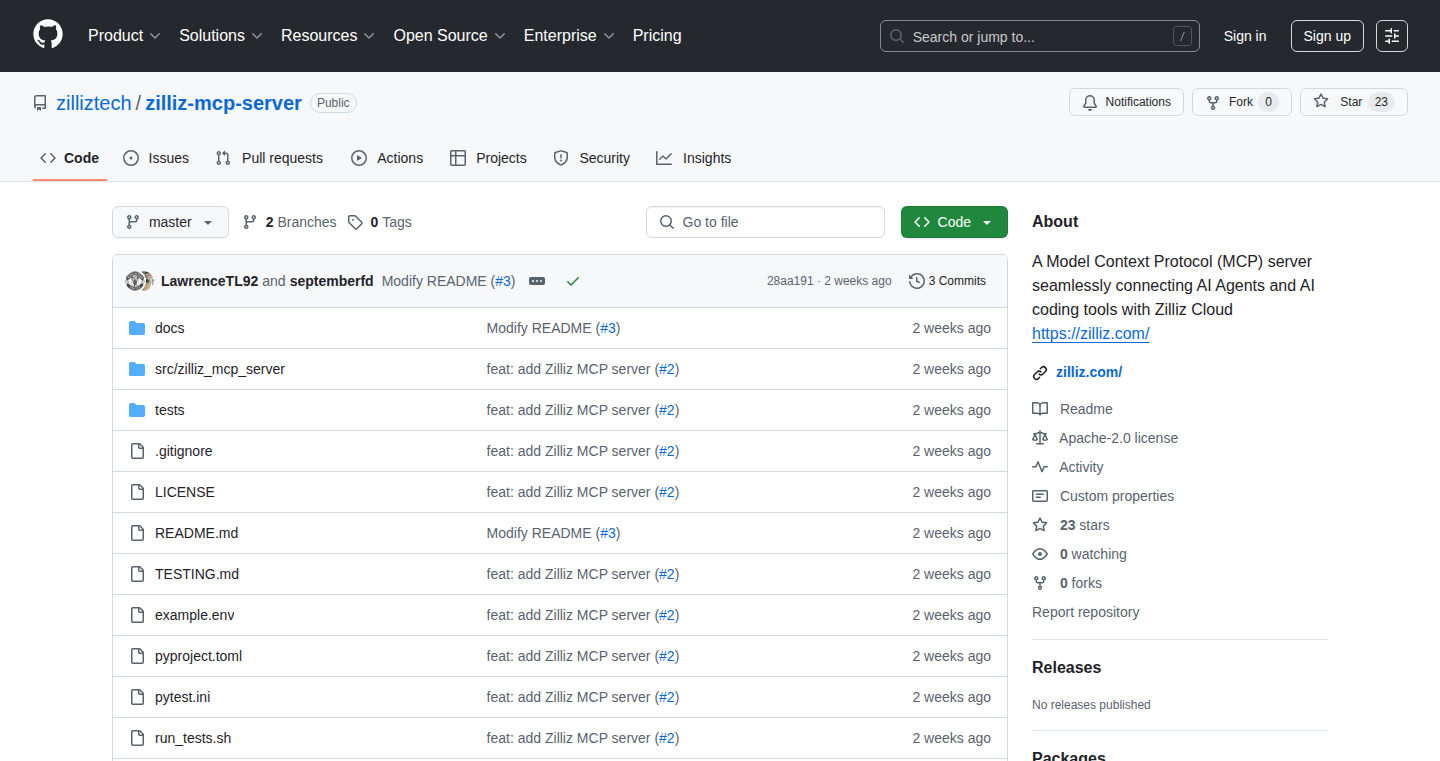
Author
Fendy
Description
MCP Server lets you control your infrastructure using plain English instead of complicated code. It focuses on using natural language to manage server clusters, scale resources, and monitor their status. It tackles the complex problem of infrastructure management by allowing developers, SREs, and data engineers to interact with systems using intuitive language. This dramatically simplifies tasks like scaling, monitoring and exploring data.
Popularity
Points 3
Comments 0
What is this product?
MCP Server is a system that translates instructions written in natural language into actions for managing server infrastructure. Imagine telling a computer, "Scale up my database server," and the server automatically adds more resources. The innovation lies in the underlying technology that understands your instructions and translates them into the appropriate code to manage the servers. This uses techniques to understand the context of the language used. So this will help you automate complex infrastructure tasks without needing to write complex code – so you can focus on what matters: building your application.
How to use it?
Developers can use MCP Server by writing plain English commands to control their infrastructure. For example, you could say 'Create a new server cluster with 3 nodes' or 'Monitor the CPU usage of my database server'. This allows easy integration into existing development workflows through API calls or command-line tools. The server then executes these commands by interacting with the infrastructure platform. This will help you quickly setup and manage your infrastructure, reducing the time spent writing complex configuration code.
Product Core Function
· Natural Language Command Execution: Converts English instructions into infrastructure management tasks. The value is that it simplifies complex infrastructure management tasks like scaling, monitoring, and deployment. For you, this means you can manage your infrastructure without needing to write detailed code.
· Automated Scaling: Automatically adjusts server resources based on natural language instructions. This enables dynamic resource allocation and optimizes costs. It means your infrastructure can handle varying workloads without manual intervention.
· Real-time Monitoring: Provides insight into the operational status of servers using human-readable reports. By being able to monitor server metrics, you can identify issues and potential problems before they impact your users.
· Data Exploration and Querying: Allows users to explore and query data using natural language, simplifying data analysis tasks. You can use it to quickly understand what your data is telling you, helping you find insights without needing to write complex database queries.
Product Usage Case
· A startup uses MCP Server to quickly deploy and scale its web application servers. They can instruct the system to add more servers during peak traffic times without writing complex scripts, solving the problem of handling unexpected traffic spikes and ensuring good performance.
· A data engineer uses MCP Server to query the performance data from a database using natural language. This speeds up the analysis process, allowing the engineer to quickly identify performance bottlenecks by asking questions directly. It helps in faster data analysis and informed decision-making.
· An SRE uses MCP Server to set up automatic monitoring and alerts for the health of critical services. They can set up alerts triggered by the system based on English instructions, such as 'Alert me if the CPU usage exceeds 80%'. This increases the reliability of the infrastructure.
· A developer uses MCP Server to quickly set up a testing environment with the infrastructure specifications, they can create multiple environments as per specifications, thus helping them test their apps in different settings.
31
ImageAlchemy: A Suite of Lightning-Fast Image Manipulation Tools
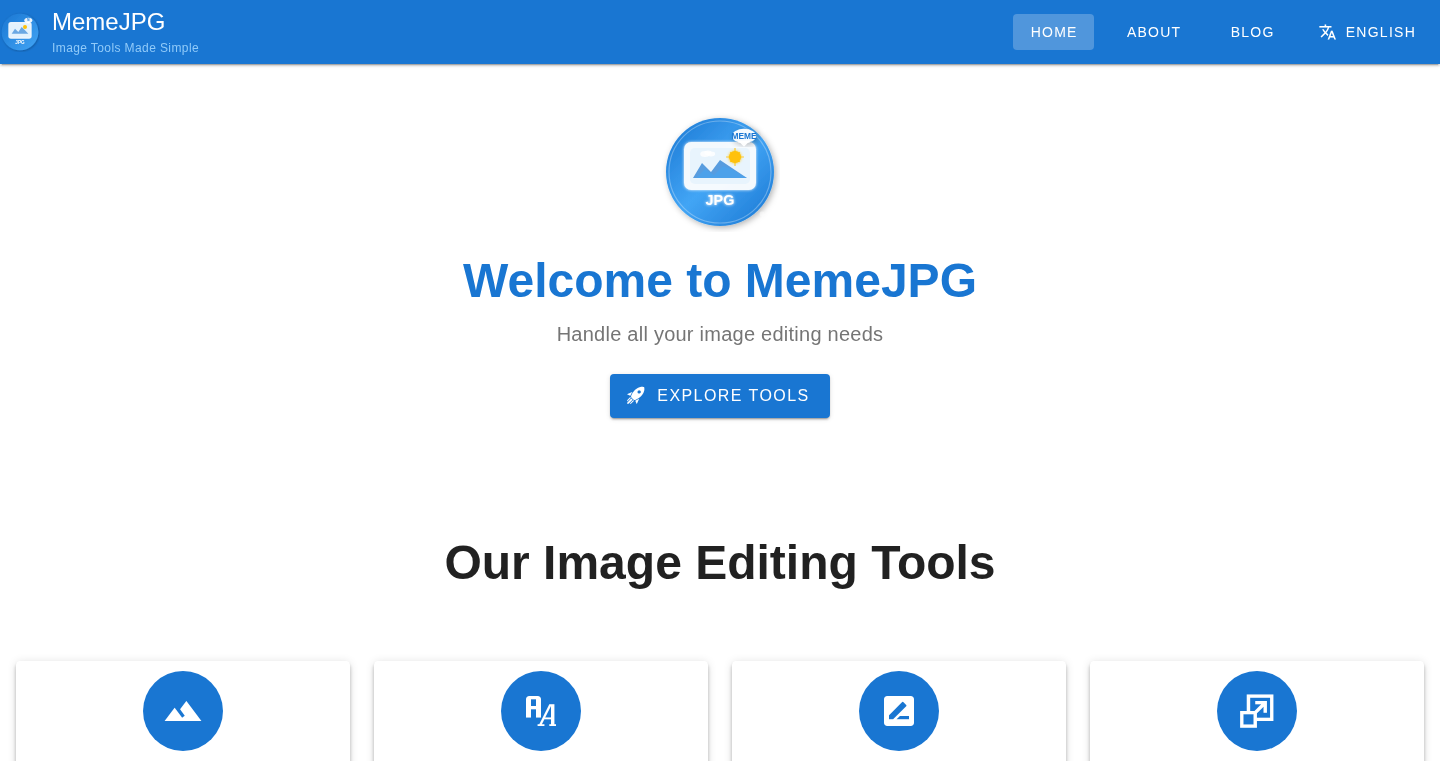
Author
yyh0808
Description
ImageAlchemy is a collection of over ten free image processing tools developed in a few days, focusing on speed and ease of use. It addresses the common developer pain points of needing quick, reliable image manipulation without complex dependencies. The project's core innovation lies in its streamlined approach to image processing, offering a variety of functions, from resizing and format conversion to more advanced operations like color correction, all wrapped in accessible command-line utilities. So this is useful for quickly manipulating images without a heavy library.
Popularity
Points 3
Comments 0
What is this product?
ImageAlchemy is a set of command-line tools. Think of them as little helpers that you can use to change and modify images. Instead of using a complicated program like Photoshop, you can use simple commands in your computer to do things like resize, convert, or adjust the colors of images. The innovation is in how quickly these tools work and how easy they are to use – designed to get things done fast. So this allows you to quickly change images using simple commands.
How to use it?
Developers can integrate ImageAlchemy into their projects via the command line. For example, you can use a script to automatically resize all images uploaded to a website or convert a batch of images from one format to another. It's also great for automating image preparation for web applications or game development. You simply provide a command with the image file name and the desired operation. So you can automate image tasks directly from your projects.
Product Core Function
· Image Resizing: Allows you to change the dimensions of images to fit different screen sizes or requirements. This is useful for optimizing images for web pages and mobile apps. So it means you can adapt images to fit any screen.
· Format Conversion: Enables conversion between various image formats (e.g., PNG, JPEG, GIF) without quality loss. This is crucial for compatibility across different platforms and devices. So it means images work everywhere.
· Color Correction: Provides tools to adjust brightness, contrast, and color balance. Useful for improving image quality and consistency. So it enhances the appearance of your images.
· Batch Processing: Permits applying the same operations to multiple images at once, saving time when working with large numbers of files. This significantly boosts productivity when you need to modify many images. So it means quicker results for a whole batch of images.
· Metadata Removal: Offers the ability to remove metadata (like camera settings or location information) from images, which can be important for privacy or reducing file size. So it helps to protect your privacy and make files smaller.
Product Usage Case
· Web Development: A web developer needs to optimize images for a website. They use ImageAlchemy to automatically resize all uploaded images and convert them to WebP format for faster loading times. So the website runs faster and uses less data.
· Game Development: A game developer needs to prepare assets for a game. They use ImageAlchemy to convert image formats, resize textures, and reduce file sizes, ensuring efficient performance. So the game runs smoothly.
· Automation Scripts: An automation script is used to process a batch of images, such as resizing or adding watermarks. This is done by running the ImageAlchemy commands within the script, and the result is a set of finished, prepared images. So you can automate image operations with a few simple commands.
· Content Creation: A content creator wants to quickly create thumbnails for their videos or blog posts. They use ImageAlchemy to batch-resize and crop images, optimizing them for social media. So creating optimized thumbnails takes only a few seconds.
32
Roll a Dice: A Serverless Randomness Engine
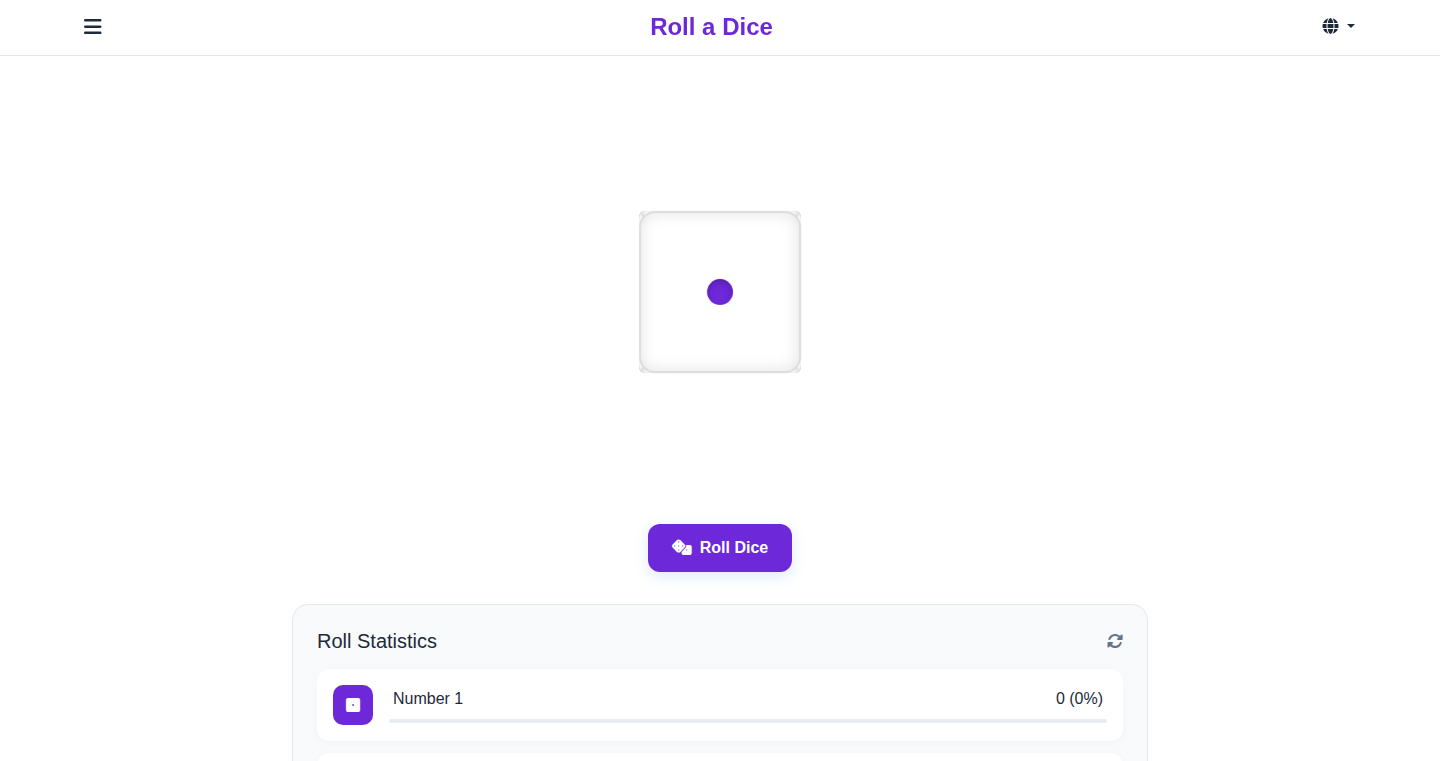
Author
artiomyak
Description
This project, 'Roll a Dice,' is a serverless implementation for generating random numbers, essentially a digital dice roller. The innovation lies in its simplicity and serverless architecture, eliminating the need for managing servers. It leverages cloud functions to provide on-demand, scalable, and cost-effective random number generation. It addresses the need for verifiable, reliable random numbers in various applications, such as online games, simulations, and even cryptography, without the overhead of traditional server setups.
Popularity
Points 2
Comments 1
What is this product?
It's a system to generate random numbers on demand, like rolling a digital dice. The magic happens in the cloud, using 'serverless' technology – meaning you don't have to worry about maintaining servers. The core is a cloud function that can be triggered by any request. It uses a method to generate a random number, such as using a pseudorandom number generator (PRNG) seeded with a source of entropy from outside (e.g. time, user events). The PRNG generates seemingly random output, ensuring that each roll is unpredictable and consistent. So what? This is great for games, simulations, and anything needing unpredictable results, and you pay only when you use it.
How to use it?
Developers can use this by making simple API calls to the cloud function. You send a request, and you get a random number back. This can be integrated into any application that needs randomness. For example, a game developer could use it to determine dice rolls in a virtual game, a scientist could use it to simulate random events, or a financial analyst could use it for generating simulated market data. This is done by using standard HTTP requests, making it easily usable in almost any programming language and platform.
Product Core Function
· Random Number Generation: This is the heart of the project. It uses a random number generator, seeded with a source of randomness to create unpredictable outputs. Application: essential for games, simulations, and anywhere randomness is critical, like choosing a winner or simulating events.
· Serverless Architecture: The system runs on cloud functions, which means no server management. This simplifies deployment, reduces costs (pay-per-use), and automatically scales to handle any amount of traffic. Application: perfect for projects with fluctuating needs or limited budgets, as it removes operational overhead.
· API Endpoint: The service exposes an easy-to-use API, enabling easy integration into applications. Application: making it simple for any application or service to use the random number generator. The service can be seamlessly integrated into existing applications without a lot of setup time.
· Scalability: The serverless nature provides automatic scaling. The cloud provider takes care of automatically increasing or decreasing resources to handle usage spikes. Application: Great for projects that might experience sudden surges in usage without requiring proactive infrastructure management.
Product Usage Case
· Online Gaming: A game developer needs to simulate dice rolls for a virtual board game. They can call the API each time a player needs to roll, getting a fair and unpredictable result every time. Benefit: The game is easily built, scalable, and the backend is greatly simplified.
· Simulations: A researcher is working on a climate model. The project simulates random weather events. By using the random number generator, they can create realistic fluctuations in the simulation. Benefit: Enables more accurate and diverse simulation runs.
· Cryptographic Applications: While not primarily designed for full cryptography, it could be used as a component. A developer uses the random numbers to help seed a more robust cryptographic solution. Benefit: Gives more control over randomness in key generation or other functions.
33
Seal.codes: Browser-Based Content Authenticity Verification
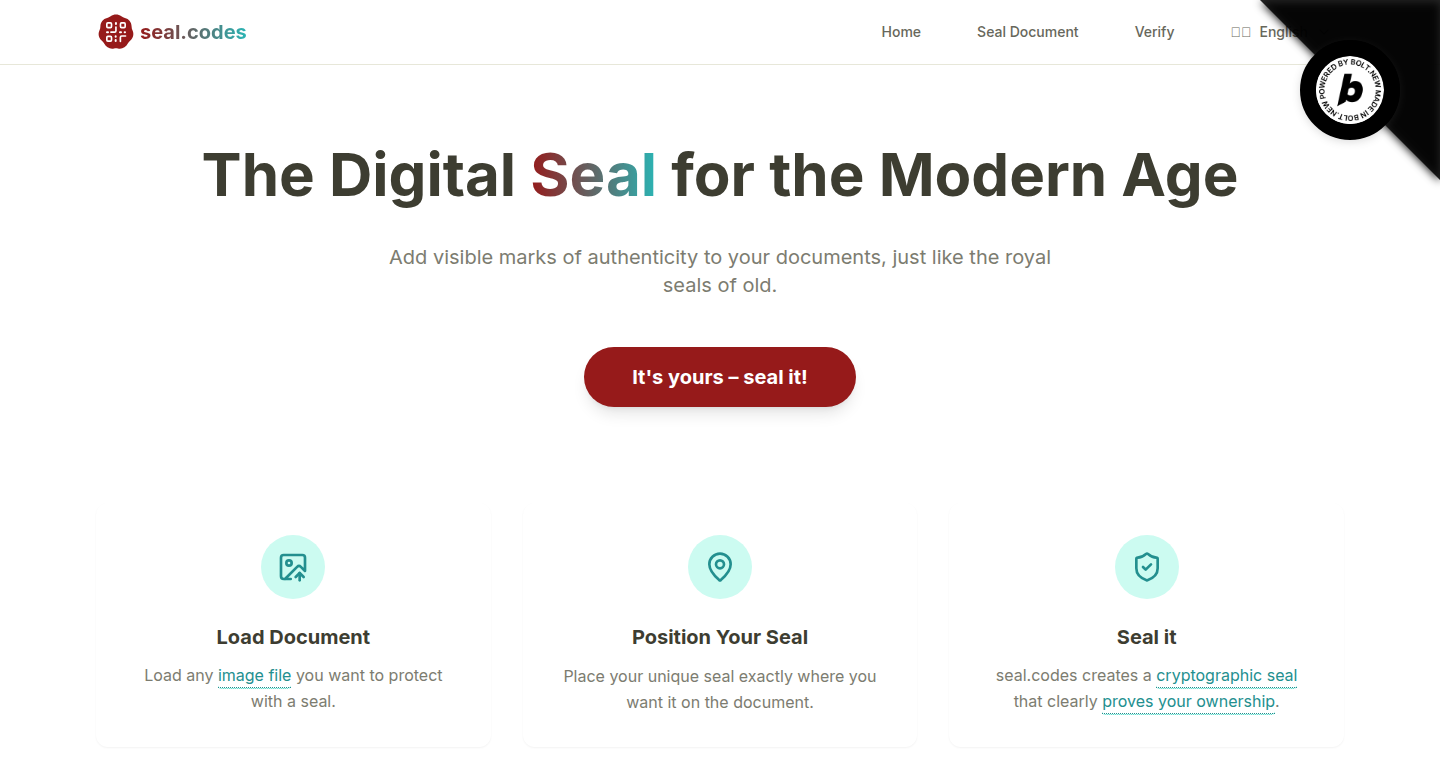
Author
utsavanand2
Description
Seal.codes is a tool that lets you verify the authenticity of content, like images, directly within your web browser. It uses a simple, browser-based approach, generating unique QR codes linked to your social accounts to act as digital seals. If the content is altered after the seal is created, the seal breaks, indicating tampering. This is a lightweight alternative to more complex methods like blockchain, offering a user-friendly way to prove your content's origin and integrity without relying on external servers, ensuring data privacy and cost-effectiveness.
Popularity
Points 2
Comments 1
What is this product?
Seal.codes works by creating a digital 'seal' for your content within your web browser. It generates a QR code that essentially links the content to your social media profile. This QR code acts as a 'digital wax seal'. When you create the seal, the content's data is used to generate the QR code. If the content changes, the QR code changes too, so if someone tries to modify the content, the seal breaks, and the verification fails. This technique avoids needing a central server or complicated security protocols. So this is like having a digital signature, proving that the content you created is the one that is displayed to everyone.
How to use it?
Developers can use Seal.codes to integrate content verification into their web applications. You can use it when developing content management systems (CMS) or social media platforms, where content integrity is important. You create the seal using a snippet of JavaScript or directly integrate it into the HTML and CSS to generate a QR code for your content. The QR code can then be embedded near the content, and anyone can scan it to verify its authenticity. So you can ensure that the content displayed by your application is exactly what you intended.
Product Core Function
· Browser-Based Verification: The entire process happens inside the user's web browser. This eliminates the need to upload content to a server for verification, ensuring data privacy and reducing latency. This lets you verify content quickly and privately, which is important for user experience and data security.
· QR Code-Based Seals: Uses QR codes as a simple, visual representation of content authenticity. Each QR code is unique to the content and links to the creator's social media profile, making it easy to verify and establish trust. This approach provides an easy-to-understand visual cue of content authenticity.
· Tamper Detection: The system detects alterations to the content. If the content is changed after the seal is created, the QR code changes, indicating the content is no longer authentic. This provides a simple mechanism to trust the integrity of the content.
· Privacy Focused: No content is stored on any server. All processing happens in the user's browser. This approach ensures data privacy and minimizes the risk of data breaches. This provides extra security by not storing any sensitive data on external servers.
Product Usage Case
· Social Media Platforms: A platform could integrate Seal.codes into its image-sharing features. Users could generate seals for their images, and other users could scan the QR code to verify the image's authenticity. This would increase trust and combat misinformation on social media.
· Content Management Systems (CMS): A developer building a CMS can include Seal.codes functionality for all uploaded images and documents. When the user uploads a file, a QR code is generated. This lets the users verify that the documents and images on their website haven't been tampered with.
· E-commerce Websites: Online stores could use Seal.codes to verify product images. By generating a seal for each product image, customers would be assured that the image displayed is the actual product being offered. This increases consumer confidence and helps in detecting fake products.
34
TypeCraft: Chrome Extension for Contextual Typing Practice
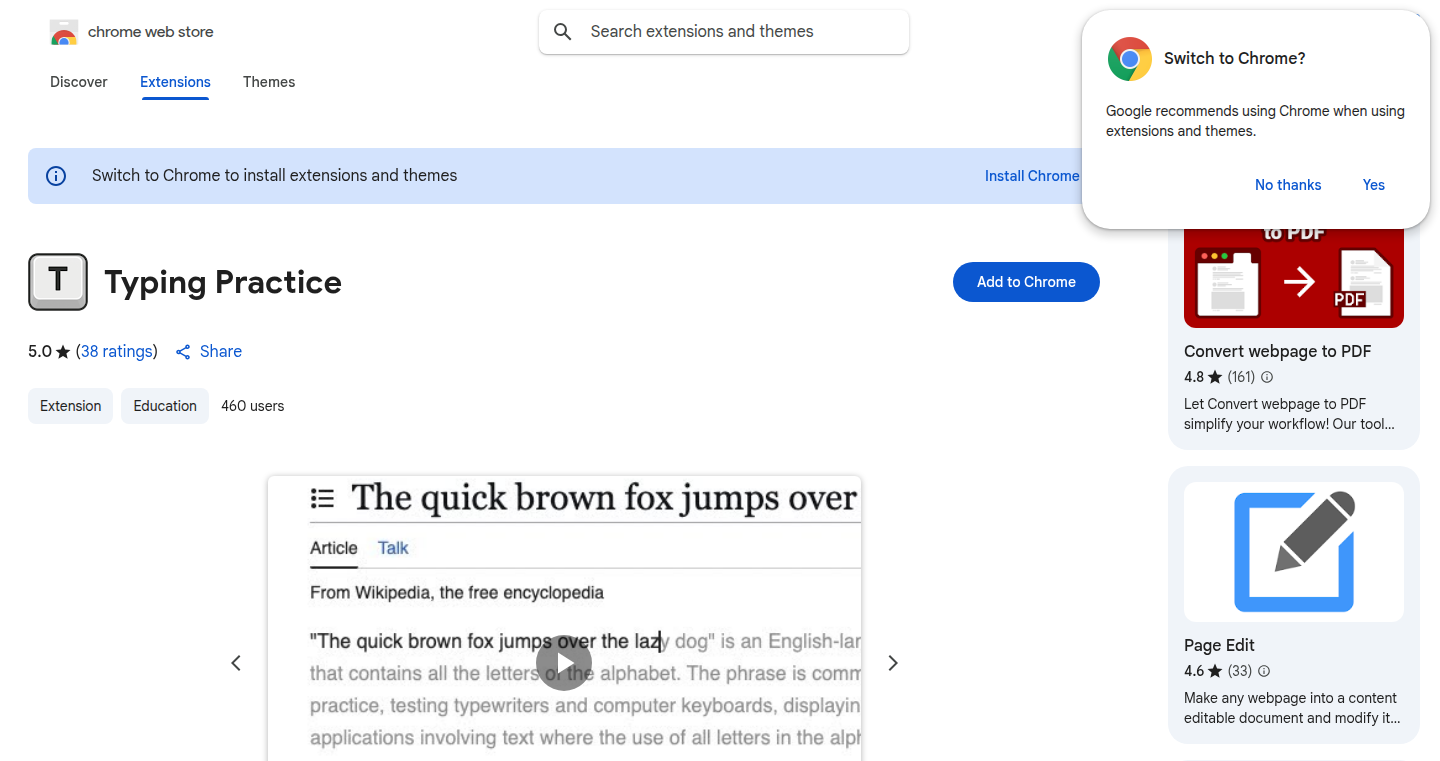
Author
maximcus
Description
TypeCraft is a Chrome extension designed to help users practice typing skills by directly interacting with text from any website. The key innovation lies in its ability to overlay typing challenges onto the content you're already reading, thus making practice more relevant and engaging. It solves the problem of generic typing practice not translating well to real-world writing by providing a contextual and personalized learning experience.
Popularity
Points 3
Comments 0
What is this product?
TypeCraft is a Chrome extension that allows you to practice typing directly on any website's content. Think of it as a smart typing tutor that integrates with your daily reading. Instead of typing random words, you type the words and sentences from the website you're currently viewing. This leverages the power of spaced repetition and contextual learning, making it more effective and enjoyable. So, it's like turning your reading into a typing lesson. This is achieved by using a JavaScript-based overlay and text extraction techniques. The core idea is to make typing practice less tedious and more applicable to real-world usage. So what does this mean for you? It means less time spent on repetitive typing exercises and more time getting better at typing the actual words and phrases you need.
How to use it?
Developers (or anyone who uses a computer and wants to improve their typing) install the Chrome extension. When browsing any website, they can activate TypeCraft, and the extension will highlight text for typing practice. The extension allows users to customize the practice experience, adjust difficulty, and track progress. It's integrated into your daily browsing, offering immediate feedback and personalized learning. You can use this while reading news articles, blog posts, or even code documentation. The integration is seamless; you browse the web as usual, and TypeCraft adds an extra layer of learning. So, it’s a simple install, start browsing, and start typing!
Product Core Function
· Contextual Typing Practice: TypeCraft selects text from the current webpage for typing practice. This function's value is in making practice directly applicable to the user's reading and writing habits, improving real-world typing speed and accuracy. It solves the problem of generic typing exercises lacking relevance. If you often write emails, it is beneficial for you to improve the typing speed related to business.
· Customizable Difficulty Levels: Users can adjust the difficulty, such as character sets and word length. This allows for personalized practice tailored to individual skill levels. The value is in providing a progressive learning experience. It ensures users are challenged appropriately. For beginner to advanced levels, this function provides great adaptability.
· Real-Time Feedback and Progress Tracking: The extension offers immediate feedback on accuracy and speed. It tracks progress, providing data-driven insights. The value is in enabling users to monitor their improvement. Helps users stay motivated and measure learning effectiveness. By providing real-time metrics, you know how well you are performing.
· Website Compatibility: Works on any website. This feature's value is in providing flexibility and wide usability, which means you can practice typing anywhere online. From news websites to social media, this function ensures accessibility to practice the target typing skills.
Product Usage Case
· Journalists and Writers: Practice typing news articles directly from news websites. They can improve speed and accuracy in their specific niche. This is applicable to those who need to transcribe quickly.
· Coders: Practice typing code snippets or documentation from sites like Stack Overflow. This could improve their coding speed and prevent typing errors. Helpful for coders who need to type code quickly.
· Students: Practice typing from course materials or research papers. They can improve their typing speed while studying, thereby improving their note-taking and information processing capabilities. Relevant for learning and remembering important information.
· Bloggers and Content Creators: Practice typing their own drafts and blog posts. Improves the ability to create the content faster. The time to write the content will be much shorter.
35
Furnace: Blazing-Fast Rust-Powered ML Inference Server
Author
gilfeather
Description
Furnace is a high-performance machine learning (ML) inference server built entirely in Rust. It distinguishes itself by eliminating the need for a Python runtime, resulting in a compact, fast, and efficient solution. This means it can run your machine learning models quickly, with inference times as low as sub-millisecond (around 0.5ms for models like MNIST). So, it helps accelerate machine learning applications without the overhead of Python dependencies.
Popularity
Points 3
Comments 0
What is this product?
Furnace is a specialized server designed to run pre-trained machine learning models and make predictions (inference). The core innovation lies in its architecture: it's written entirely in Rust, a programming language known for its speed and memory efficiency. This is a departure from many ML inference servers that rely on Python. By using Rust and the Burn framework (for neural networks), Furnace avoids the performance bottlenecks often associated with Python. This translates to faster prediction times and smaller deployment sizes. So, it offers a lean and mean way to deploy and use your machine learning models.
How to use it?
Developers can use Furnace to serve their trained machine learning models. After cloning the repository and building the Rust code, you can launch the server with a simple command, specifying the location of your model and the port to listen on. Then, you can send prediction requests via a REST HTTP API (like `/predict`). Furnace supports health checks (`/healthz`) and provides model information (`/model/info`). So, you can easily integrate it into your existing applications or build new ones that require real-time predictions.
Product Core Function
· Zero Python Runtime: Furnace runs as a single Rust binary. This means you don't need to install Python or manage complex dependencies. This simplifies deployment and reduces the server's footprint. So, it makes your deployment easier and faster.
· Sub-Millisecond Inference Time: Furnace is optimized for speed, achieving inference times as low as 0.5ms for certain models. This allows for real-time applications such as image recognition, speech processing, or any other application where speed is critical. So, your applications will respond much faster, enhancing the user experience.
· REST HTTP API: Furnace exposes a REST API for easy integration with other applications. This enables developers to easily send input data and receive predictions over the network. So, you can easily connect your applications to the machine learning models hosted by Furnace.
· Production-Ready Features: Furnace includes essential features for production environments, like graceful shutdown (so it doesn't abruptly stop), robust error handling (so your system can continue to work even with issues), and CORS support (so that your server can be accessed from different domains). So, your machine learning applications will be more reliable and easier to manage.
Product Usage Case
· Real-time Image Recognition: Imagine building a mobile app that identifies objects in images. With Furnace, you can deploy a pre-trained image recognition model and get real-time predictions with extremely low latency. So, you can create responsive and interactive mobile apps that analyze images as users take pictures or upload them.
· Voice Assistant with Low Latency: Develop a voice assistant that responds instantly to user commands. Furnace can process speech recognition models very quickly, resulting in a smoother and more natural interaction. So, you can create voice assistants that feel responsive and work well in real time.
· Fraud Detection in Financial Transactions: Implement a fraud detection system that analyzes transactions in real-time to identify suspicious activities. Furnace's speed is crucial for catching fraudulent transactions before they cause financial harm. So, your financial systems can become more secure and better protect users.
36
GitWise: Natural Language Git History Explorer
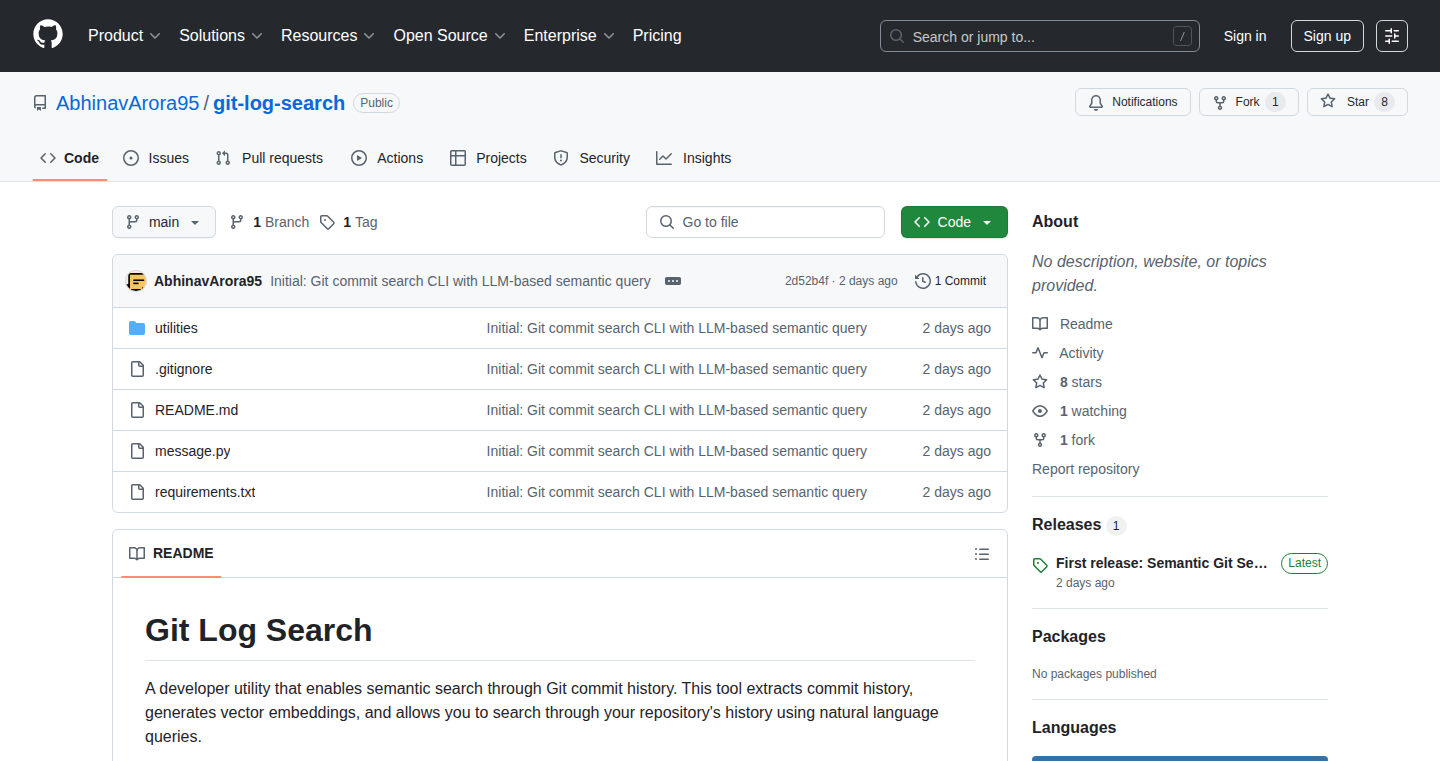
Author
abhinav95
Description
GitWise is a command-line tool that lets you query your Git commit history using plain English. Instead of sifting through endless commit logs, you can simply ask questions like "When was the login feature added?" or "What changes were made to the authentication flow?" It uses a clever combination of technologies: it converts your commit messages into numerical representations (embeddings), stores them efficiently, and then uses a powerful language model (GPT) to understand your questions and find the relevant commits. So, instead of manually searching, you can now use natural language to explore your code's history. This helps you understand your code's evolution faster and more intuitively.
Popularity
Points 3
Comments 0
What is this product?
GitWise works by transforming your commit messages into 'numerical fingerprints' using techniques called 'embeddings'. These fingerprints capture the meaning of the commit messages. It then stores these fingerprints in a local database. When you ask a question in plain English, the tool uses a large language model (like GPT) to understand your question and compares it to the stored fingerprints to find the most relevant commit messages. So, it's like having a smart search engine for your Git repository that understands human language. This innovation simplifies the process of understanding your code history, making it faster and more accessible.
How to use it?
Developers use GitWise through the command line. You install the tool, configure it with your chosen language model and embedding model, and then start asking questions about your Git repository. For example: `gitwise "When was the sign-up page created?"`. It can be integrated into your existing workflow. This simplifies code exploration, enabling developers to quickly understand code changes, identify when specific features were added, and troubleshoot issues by tracing the origin of code. You can set up a local ChromaDB to store your embeddings locally, or choose cloud providers. The CLI provides commands to list, update, and manage your embeddings.
Product Core Function
· Natural Language Querying: The core feature allows developers to query Git history using plain English. This significantly improves the ease of exploring code changes compared to manually searching commit logs. The main value proposition is an intuitive interface for understanding the evolution of the code.
· Semantic Search using Embeddings: GitWise uses embeddings to represent commit messages. This enables the tool to understand the meaning of your queries and find related commits, even if the exact keywords don't match. This feature is invaluable in understanding the 'why' behind the code changes.
· Local Storage with ChromaDB: The tool stores embeddings locally using ChromaDB, a vector database. This enables fast search performance and ensures privacy. This functionality makes it easy to track and manage your embeddings for faster querying.
· Integration with GPT and LangChain: GitWise leverages the power of GPT and LangChain to understand natural language queries and find relevant commit messages. This provides a more intelligent and user-friendly experience for developers. This helps developers to quickly get answers to their code-related questions without detailed technical expertise.
· Command-line Interface (CLI): The Typer-based CLI allows developers to easily interact with the tool, list embeddings, and manage their usage. This is accessible for developers with different skill levels.
Product Usage Case
· Debugging a Bug: A developer encounters a bug. Using GitWise, they can ask "When was this specific function last modified?" GitWise then provides a list of relevant commits, allowing the developer to quickly identify the changes that introduced the bug and fix it. This saves time and reduces debugging effort.
· Understanding Code Evolution: A developer wants to understand how a specific feature evolved over time. They can ask GitWise "What changes were made to the user authentication flow?" GitWise then highlights the relevant commits, providing a complete picture of the changes and their evolution. This facilitates a better understanding of the code's design.
· Onboarding New Team Members: When new team members join, they can quickly understand the code base using GitWise by asking questions like "Where is the code for X located?" or "How does Y work?" This simplifies knowledge transfer within the team.
· Code Review: During code reviews, developers can use GitWise to easily trace back the history of a particular code block by asking "What's the context around this piece of code?" This allows for a deeper understanding of the code being reviewed.
37
Starscout: Natural Language Search for GitHub Stars

Author
itzlambda
Description
Starscout solves the problem of finding starred GitHub repositories when you don't remember the exact name. It uses vector embeddings, a clever technique that turns text into numerical representations, to enable natural language search. This means you can type in a question like "find repos about image processing" and Starscout will find relevant repositories, even if the exact keywords aren't in the repo name. The project started with a Python backend and was later rewritten in Rust for performance. It also features a global search option to explore all indexed repositories. This highlights the innovative use of vector embeddings for information retrieval and the developer's focus on performance optimization.
Popularity
Points 3
Comments 0
What is this product?
Starscout is a search tool for your starred GitHub repositories. It allows you to search using natural language, not just keywords. It works by converting the text of your query (e.g., 'image processing') and the repository descriptions into mathematical vectors. Then, it compares these vectors to find the most relevant repositories. The project demonstrates the power of vector embeddings in search and the benefits of rewriting a project in a more performant language like Rust. So what this means is, you can quickly find the repositories you need without remembering the exact name. If you have a lot of starred repos, this can save you a ton of time.
How to use it?
Developers can use Starscout by connecting it to their GitHub account. You then enter natural language queries into the search bar. For example, if you starred a repo about 'building a web server with Node.js', you can just type that into the search bar. The tool then returns the most relevant results. You don't need to remember the specific repo name or exact keywords. Integration could involve authorizing the app to access GitHub stars and then using the provided search interface. So, it’s an easy to use tool that boosts productivity.
Product Core Function
· Natural Language Search: This allows users to search for their starred repositories using everyday language, rather than specific keywords. Technical value: leverages vector embeddings to understand the semantic meaning of search queries and repository descriptions. Application: quickly finding relevant repositories without needing to remember exact names or keywords. So, you can spend less time searching and more time coding.
· Vector Embedding-Based Ranking: The system ranks search results based on the similarity of vector embeddings. Technical value: utilizes advanced machine learning techniques to improve search accuracy. Application: provides more relevant results compared to a keyword-based search, leading to better discovery of useful resources. So, it helps you discover the best resources more quickly.
· Rust Backend for Performance: The project's backend was rewritten in Rust for improved performance. Technical value: Rust offers better speed and efficiency, particularly when dealing with large datasets. Application: faster search results and improved responsiveness, even with a large number of starred repositories. So, it delivers quicker search results.
· Global Search Feature: The optional global search capability allows users to search across all indexed repositories, not just their starred ones. Technical value: provides broader search capabilities and helps discover new projects. Application: finding new and potentially valuable repositories beyond the user's existing stars, expanding their knowledge. So, it helps you find new resources you might not have otherwise found.
· GitHub Integration: Connects directly to a user's GitHub account to access their starred repositories. Technical value: streamlines the retrieval of user-specific data. Application: simplifies the process of indexing and searching the user's starred repositories. So, this makes it seamless to find your starred repos.
Product Usage Case
· A developer is looking for a specific library about machine learning but can't remember the exact name. They type "GitHub repos for deep learning" into Starscout and the relevant repositories appear, saving them time and effort. This is the perfect use case for developers and researchers.
· A developer has starred a large number of repositories over several years. When they need to find a project related to a specific framework, they use Starscout to search using natural language and quickly locate the required repository. This demonstrates the power of the app in retrieving the repositories even with a large collection.
· A developer discovers a new repository through the global search feature. They are looking for projects related to a certain topic, and by using the global search feature, they can discover projects they hadn’t starred yet. This highlights the ability to discover new repos.
· A developer is looking for repositories in the Python or Rust ecosystem. With a natural language query, they quickly can get relevant repositories to their project. This improves the developer workflow.
38
MetaMCP: Unified MCP Aggregator and Gateway
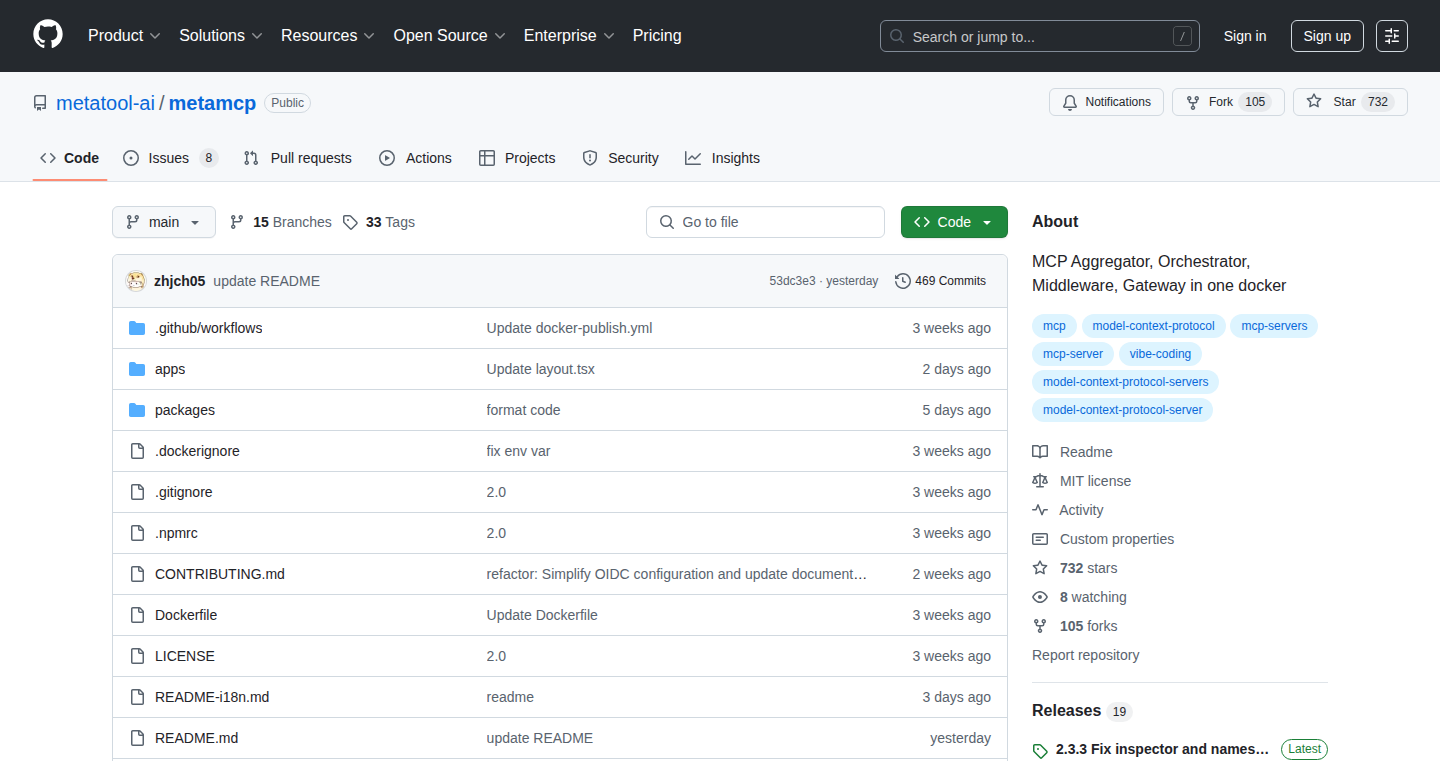
Author
jczhang141
Description
MetaMCP is an open-source tool that acts as a central hub for multiple MCP (presumably, model control plane or similar) servers. It simplifies managing these servers by grouping them into namespaces and exposing them as unified endpoints. The core innovation lies in its middleware system, which allows developers to add functionalities like filtering, logging, and potentially AI-powered guardrails. The project aims to solve the complexities of interacting with multiple MCP servers, improve performance with pre-warmed sessions, and offer a debuggable environment.
Popularity
Points 3
Comments 0
What is this product?
MetaMCP is like a smart router for MCP servers. Imagine you have several different servers handling different AI models or tasks. MetaMCP allows you to combine these servers into one accessible point, like a single door for your AI infrastructure. It uses namespaces to organize your servers, and then presents them to you as unified endpoints using technologies like SSE or SHTTP, making it easier to interact with them. The coolest part is the middleware feature: you can add extra components, like a filter to remove unwanted tools, or even a logging system to keep track of everything. This allows developers to streamline their workflow and customize the behavior of their MCP servers. So this is useful for developers who work with multiple AI models and want an easier way to manage them. It gives you more control and flexibility.
How to use it?
Developers can use MetaMCP by deploying it as a pre-built Docker image. You simply point MetaMCP to your existing MCP servers. Then, through the MetaMCP's interface, you can access and manage these servers through unified endpoints. You can plug in different middleware, such as filtering unused tools or integrating logging. You can even create custom middleware to add specific features. The integrated inspector allows for easy debugging and troubleshooting. This makes it straightforward for developers to integrate and manage multiple MCPs. So, you can use this to simplify and centralize how you interact with your AI models.
Product Core Function
· Namespace Grouping: Allows organizing MCP servers into logical groups for easier management. You can think of it as folders for your servers. This makes it easier to find and manage your different MCPs. So this helps organize your work with AI models.
· Unified Endpoints: Exposes multiple MCP servers through a single, standardized interface using technologies like SSE and SHTTP. This simplifies the interaction with multiple underlying servers. So, this lets you talk to all your AI models in the same way.
· Middleware System: Enables the addition of modular components like filters, logging, and AI-powered guardrails to customize server behavior. This provides a flexible way to add features and customize the system without altering the core code. So this makes it easy to add extra features, like logging, to your AI systems.
· Pre-warmed Sessions: Pre-warms idle sessions to reduce cold start latency. This feature improves performance by making your MCP servers respond faster. So, your AI models start working more quickly.
· Built-in MCP Inspector: Provides a debugging tool to monitor and troubleshoot the system. This gives you a convenient way to check what's going on and quickly resolve problems. So this helps you quickly fix any problems with your AI models.
Product Usage Case
· Scenario: An AI developer working with multiple AI models across different servers. Solution: Uses MetaMCP to aggregate and present these models via unified endpoints, simplifying the management and access. The developer uses the middleware system to filter out certain tools, streamline the interactions, and reduce the maintenance overhead. For this, MetaMCP offers a simpler, unified way to access multiple models, cutting down on development time.
· Scenario: A team wants to monitor and log all interactions with their AI models. Solution: Utilizes MetaMCP's middleware capabilities to integrate logging functionality. This allows the team to track all requests and responses for debugging and auditing purposes. This makes it easier for the team to understand and debug issues, by having all information in one place.
· Scenario: A developer needs to reduce the startup time for their AI models. Solution: Leverages MetaMCP's pre-warmed sessions feature. This ensures that the AI models are ready to respond instantly, improving the user experience. So, your AI model works faster, leading to better user satisfaction.
39
LetterSprint: A Fast-Paced Vocabulary Game
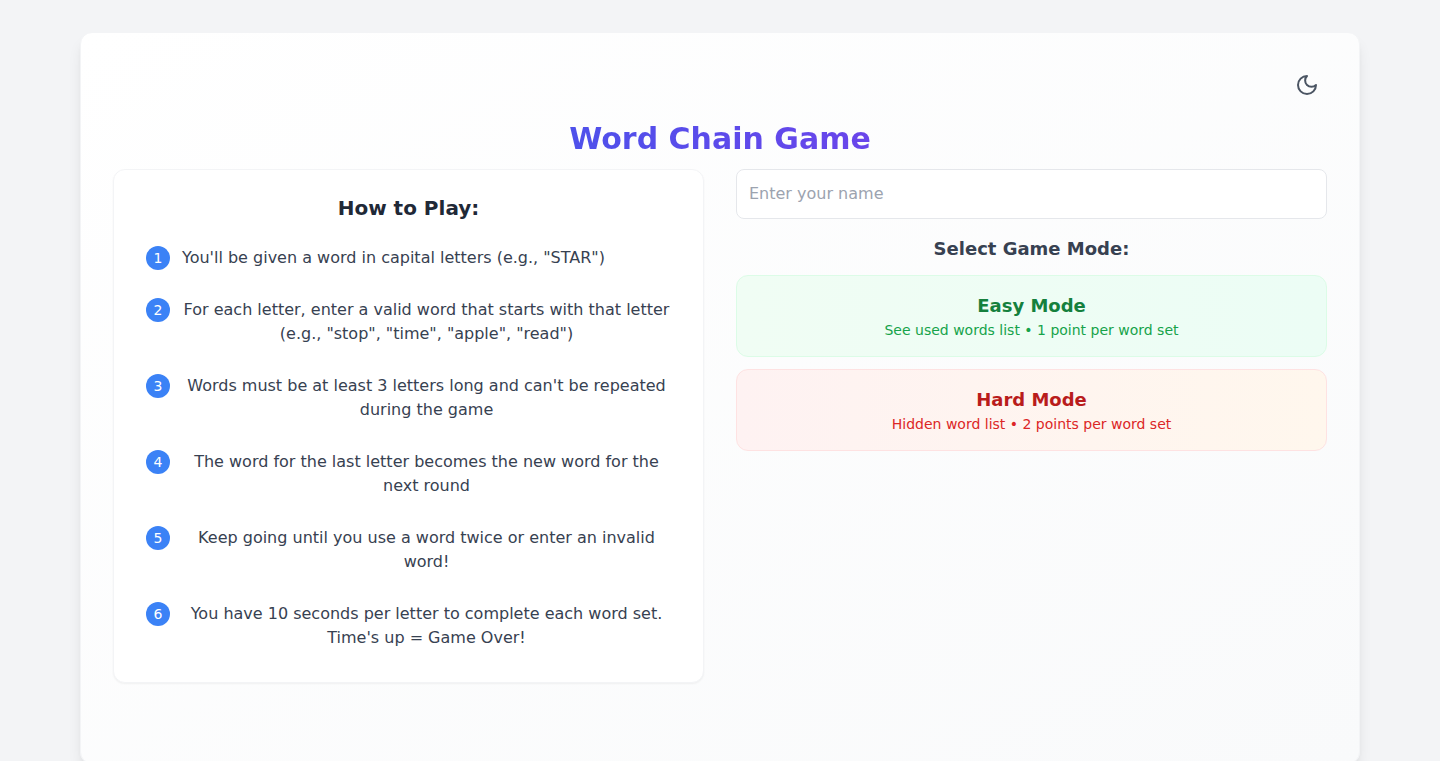
Author
martianmanhunt
Description
LetterSprint is a vocabulary game that challenges you to quickly recall words. The core idea is simple: for each letter in a given word, you must provide a word. The last word you enter becomes the new word for the next round. This Show HN project focuses on the rapid iteration of a game concept, highlighting agile development and user feedback incorporation. It addresses the technical challenges of real-time word validation and efficient user interface updates. So, what's the point? It's a fun and engaging way to improve your vocabulary and reaction speed.
Popularity
Points 3
Comments 0
What is this product?
LetterSprint is a vocabulary game built around a straightforward but challenging concept. The core technology involves a real-time word validation system, likely implemented using a dictionary or a word database. When a user inputs a word, the system quickly checks if it's a valid word in the English language and also verifies if the word starts with the required letter. The front-end of the game likely utilizes responsive design to ensure the game is playable across different devices. The innovation lies in its simplicity, focusing on speed and recall, offering a fresh take on word games. So, what does this mean? It means it's a quick and easy way to improve your vocabulary with a fresh way to learn.
How to use it?
Developers can use this project as inspiration for building similar interactive and user-feedback-driven applications. The front-end structure can be studied to learn about efficient user interface design and how to build a responsive game. The word validation logic could be used as a template to create other language-based apps. For example, you might learn how to integrate a dictionary API, or build a quick game that could be embedded on other web pages. So, how can you integrate it? By analyzing its design to help you in developing your own responsive web applications.
Product Core Function
· Real-time Word Validation: The game's core function is the ability to validate words entered by the user. This involves checking if a word exists in a predefined dictionary and if it starts with the required letter. This functionality is crucial for ensuring the game’s integrity and providing immediate feedback to the user. This is a must-have for word games. It enables a dynamic user experience and provides immediate feedback. So, what’s the use of it? It's used to make a smooth and error-free word game.
· User Interface (UI) Design for Speed: The UI design is optimized for speed, allowing for rapid word entry and minimal distractions. This involves a clean layout, clear visual cues, and easy-to-use input fields. By looking at the project, developers could gain insights on creating quick and easy user interfaces. This is extremely helpful for developers looking to develop fast-paced applications. So, what can I get from it? It can help developers make great, interactive applications.
· Word Sequencing and Game Logic: The game has logic to move from one word to another which makes the game fun. The choice of the 'new' word after a round is crucial for determining game difficulty. This could be used in a variety of educational applications. So, how can it help? It allows you to come up with word games with different difficulties.
· Feedback and Beta Iteration: The developer mentions they're looking for feedback. They use the beta phase to gather user input for improvements. This shows the Agile development approach. This kind of quick iteration is valuable for all developers. So, what does this provide? It makes the app better and more fun to use.
Product Usage Case
· Educational Game Development: This project provides a template for developing educational games that focus on language skills. By analyzing the code, developers can learn how to integrate vocabulary lists, word validation algorithms, and interactive user interfaces to build engaging learning experiences. It teaches students new words in a fun way. So, how can this help? This can help you make your own educational application.
· Vocabulary Building Apps: Developers could use the word validation and interface design aspects to create vocabulary-building apps that focus on speed and recall. This could involve integrating the game mechanics with personalized word lists and learning paths. This is great for studying vocabulary and new words. So, what can I do with this? This can help you to create your own vocabulary app.
· Rapid Prototyping of Game Ideas: The project's focus on rapid iteration can be used as an example of how to quickly prototype a game concept, gather user feedback, and refine it based on real-world user input. For developers, this helps in creating a Minimum Viable Product (MVP). So, what’s the gain? This can help you to quickly prototype your own games.
40
Newsplash: AI-Powered Personalized News Digest

Author
snowcon
Description
Newsplash is a lightweight AI-powered news platform designed to deliver personalized, fact-based daily news digests. It tackles the problem of information overload and clickbait by using AI to summarize news articles and tailor them to each user's preferences. This project leverages GPT-4o for summarization, Deno edge functions for processing, and Supabase for database and backend infrastructure. It's an attempt to provide users with a fast, trustworthy summary of the news they care about, avoiding the noise of sensationalist headlines.
Popularity
Points 1
Comments 2
What is this product?
Newsplash works by pulling in around 500 articles daily using NewsAPI. These articles are then cleaned and deduplicated, and summarized using GPT-4o, which generates concise summaries (around 90-120 tokens per article). Each user receives a personalized daily digest based on their topic preferences and feedback (likes/dislikes). There's also a built-in GPT chat tool that allows users to ask contextual questions about the news. So this is like having your own personal news editor and research assistant. The key innovation is using AI to distill a massive amount of information into digestible summaries, saving you time and providing relevant news. So this allows you to stay informed without wasting hours reading irrelevant articles.
How to use it?
Developers can use Newsplash as a template or inspiration for building similar AI-powered content aggregation tools. They can study the implementation of using Edge Functions for processing, the integration with GPT-4o for summarization, and the use of a database to store and personalize content. You can potentially integrate similar AI summarization techniques into your own applications, for example, to create a summary of lengthy documents or customer feedback. The provided tech stack (Deno, Supabase, React, GPT-4o) offers developers a practical reference for building their own AI-powered applications. So, if you're looking to create a news aggregator, content summarization tool, or personalized information platform, Newsplash offers a useful blueprint.
Product Core Function
· Article Extraction and Cleaning: Newsplash uses NewsAPI to fetch news articles and cleans them using a readability parser. Value: This ensures a clean and consistent data input for the AI summarization process. Application: Useful in any application that deals with unstructured text data like scraped web content or user-generated content.
· AI-Powered Summarization: Newsplash employs GPT-4o to summarize articles, creating concise summaries for users. Value: This allows users to quickly grasp the main points of an article without reading the entire text, saving time. Application: Content creators, journalists, or anyone who needs to quickly summarize articles, reports, or documents for their work.
· Personalized Digest Generation: The platform creates personalized daily digests based on user preferences and feedback (likes/dislikes). Value: This feature tailors the news to each user's interests, making the news more relevant and enjoyable. Application: Useful for news aggregators, content recommendation systems, and personalized learning platforms.
· Contextual Questioning with AI: A built-in GPT chat tool allows users to ask questions about the articles they're reading. Value: This allows users to delve deeper into the news and get more information. Application: This technology can be useful for anyone who needs to get more understanding about a specific topic, such as students, researchers, or anyone who needs to do research.
· Edge Functions for Processing: Newsplash leverages Edge Functions in Deno for tasks like data fetching, deduplication, and summarization. Value: This architecture offers a fast and scalable way to perform these operations. Application: Useful for building fast and responsive web applications or APIs, and efficient data processing pipelines.
Product Usage Case
· Building a Personalized News Aggregator: Developers can use Newsplash's architecture to create their own personalized news aggregator. This involves fetching articles from various sources, summarizing them using AI, and creating customized digests for users based on their preferences. Benefits: Users get the news that matters to them and save time. So, you can create a news reader that curates stories to your specific interests.
· Content Summarization Tools for Businesses: Companies can leverage the AI summarization capabilities of Newsplash to build tools that automatically summarize documents, reports, or customer feedback. Benefits: Saves time and reduces the need for manual review. So, businesses can quickly understand reports or analyze feedback more efficiently.
· AI-Powered Research Assistant: Researchers or students can adapt the contextual question answering feature to build an AI assistant that can answer questions about specific topics. Benefits: This helps users quickly gather relevant information and facilitates deeper understanding. So, for quick topic research, this model is your intelligent assistant.
41
Zu: The Tiny and Fast Key-Value Database
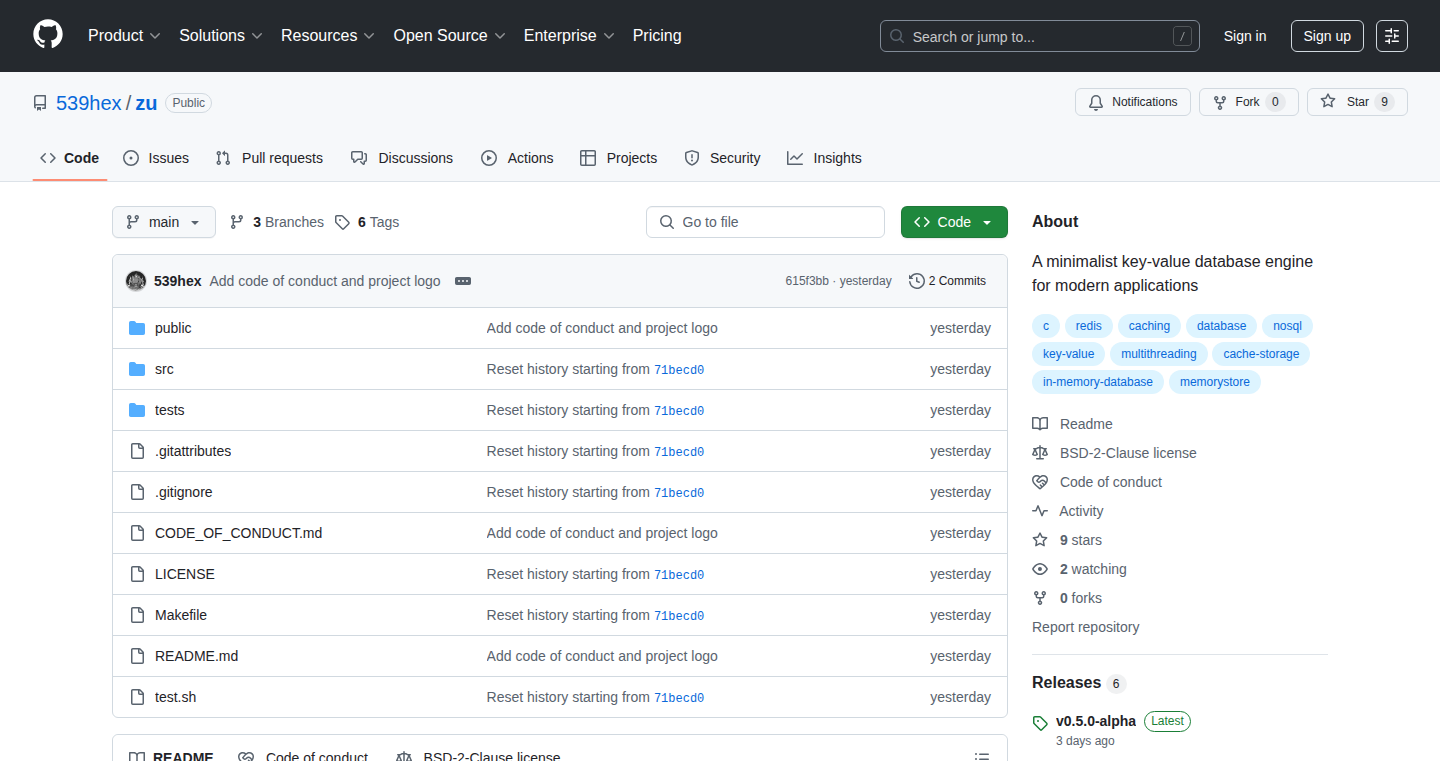
Author
539hex
Description
Zu is a minimalist key-value database engine designed for modern applications. It prioritizes speed and simplicity, offering a lightweight solution for storing and retrieving data. The core innovation lies in its efficient data storage and retrieval mechanisms, potentially using in-memory or disk-based storage options, providing flexibility for various use cases. This addresses the need for a performant and resource-friendly database solution, suitable for applications where speed and minimal overhead are critical.
Popularity
Points 3
Comments 0
What is this product?
Zu is a key-value database, like a very simple dictionary for your data. Think of it as a super-fast and lightweight storage system. The cool part is its design: it's built to be as small and quick as possible, possibly using tricks like storing data directly in memory (like RAM) or cleverly organizing data on your hard drive. The innovation is its focus on speed and efficiency, providing a straightforward way to store and retrieve information without the complexities of larger database systems. So this is useful if you need to quickly store and retrieve data. For example, user profile, sessions, etc.
How to use it?
Developers can use Zu as a backend storage solution for their applications. They can integrate it into their code to store data using simple key-value pairs. The developer can specify the key (like a name) and value (the data associated with that name). Then, they can quickly retrieve the value when needed. Integration involves including Zu's library in your project and using its API to read, write, and manage data. This can be done through several programming languages. So you can easily add Zu to your code.
Product Core Function
· Fast Data Storage: Zu likely provides extremely fast data storage because it's designed to be minimal. It prioritizes the efficiency of writing data to and reading data from storage, reducing overhead. Useful for applications where speed is paramount, such as caching systems or high-frequency data logging. So this means your data will be available nearly instantly.
· Efficient Data Retrieval: Zu should offer quick data retrieval capabilities. This means you can look up specific data using the keys you have defined. Applications like game state management or session management, where quick access to specific data is crucial, can benefit from this. So, get data from database like magic.
· Minimal Resource Consumption: The database is designed to consume very few system resources like CPU and memory. This makes it suitable for resource-constrained environments or applications where keeping resource usage low is essential. So this will free up memory and speed up other operations.
· Simplified Data Model: Zu typically uses a simple key-value structure. This minimizes the complexity of the data, which makes the data easier to store and manage without the need for complex schemas. This is helpful in scenarios where a rigid database structure isn't required, such as configuration storage or temporary data storage. So, it is simple to use for basic scenarios.
Product Usage Case
· Caching Systems: Zu could be used to store frequently accessed data for quicker retrieval. For example, you could cache the results of an expensive database query or the data of a user profile. This improves application responsiveness. So, faster websites and apps!
· Session Management: Zu might store user session data, allowing for fast access to the user's session information, improving user experience. This way the website remembers who you are. So, smoother browsing.
· Configuration Storage: Zu can store application configuration settings such as database connection parameters and user preferences. This ensures the application can easily read and access configuration parameters. So you can easily configure your app.
42
GetPost: Serverless Pastebin on Cloudflare Workers

Author
itdaniher
Description
GetPost is a simple pastebin and image hosting service that leverages Cloudflare Workers, enabling zero-cost operation and minimal maintenance. The key innovation lies in its deployment simplicity: it uses a Python script to embed static assets directly into the worker code, resulting in a single JavaScript file deployment. This eliminates complex build tools and allows for quick deployment, offering a user-friendly experience for sharing text, markdown, images, and other files up to 10MB. So this makes it super easy to host your own pastebin and share stuff online.
Popularity
Points 3
Comments 0
What is this product?
GetPost is a self-hosted service for sharing text, code snippets, images, and files. It works by running on Cloudflare Workers, a platform that allows you to run code on the edge of the internet (close to your users). The innovative part is how it's built: it uses a simple Python script to merge all the necessary files (like the HTML for the website, the JavaScript code) into one single file. This is like packing everything into a single box for easy shipping. This means no complicated setup, just a few commands to deploy. So, it's a cost-effective, easy-to-manage solution for sharing information online.
How to use it?
Developers can use GetPost by deploying the code to their Cloudflare account. After deployment, users can upload files using a simple command-line tool like 'curl'. For example: `curl --data-binary @your_file.txt https://your-getpost-url.workers.dev`. This is great for sharing code snippets, quick notes, or images with colleagues or for personal use. You can also use it within scripts or automated processes to store and retrieve information. So, it is a super simple way to share files and documents online.
Product Core Function
· Simple file upload: Allows users to easily upload text, images, and various file types.
· Markdown support: Provides server-side rendering for Markdown files, meaning you can share formatted text easily.
· ULID-based access control: Uses unique, time-based identifiers (ULIDs) for access and separate delete keys, ensuring secure file management.
· Zero-cost operation: Runs on Cloudflare's free tier, which means no monthly fees for basic usage.
· Minimal maintenance: Due to its serverless architecture and simple build process, it requires very little upkeep.
Product Usage Case
· Sharing code snippets: Developers can quickly share code snippets with teammates, using a simple curl command to upload and provide a link for easy access. So, it's a convenient way to collaborate on code.
· Documenting projects: Create quick notes and upload them to GetPost. You can easily share important project details, documentation, or any other text-based information. So, it's an effective way to keep your important notes safe and share them with others.
· Image hosting: Quickly share images or screenshots with others, by uploading through curl or even creating a simple script. So, it's a good way for you and your team to share images and visual elements quickly.
· Quick prototyping: When prototyping web applications, use GetPost to quickly store and share temporary resources like CSS or JavaScript files, enabling rapid development and testing.
43
VectorSearch-Kit: Simplified AI Similarity Search with Supabase and pgvector
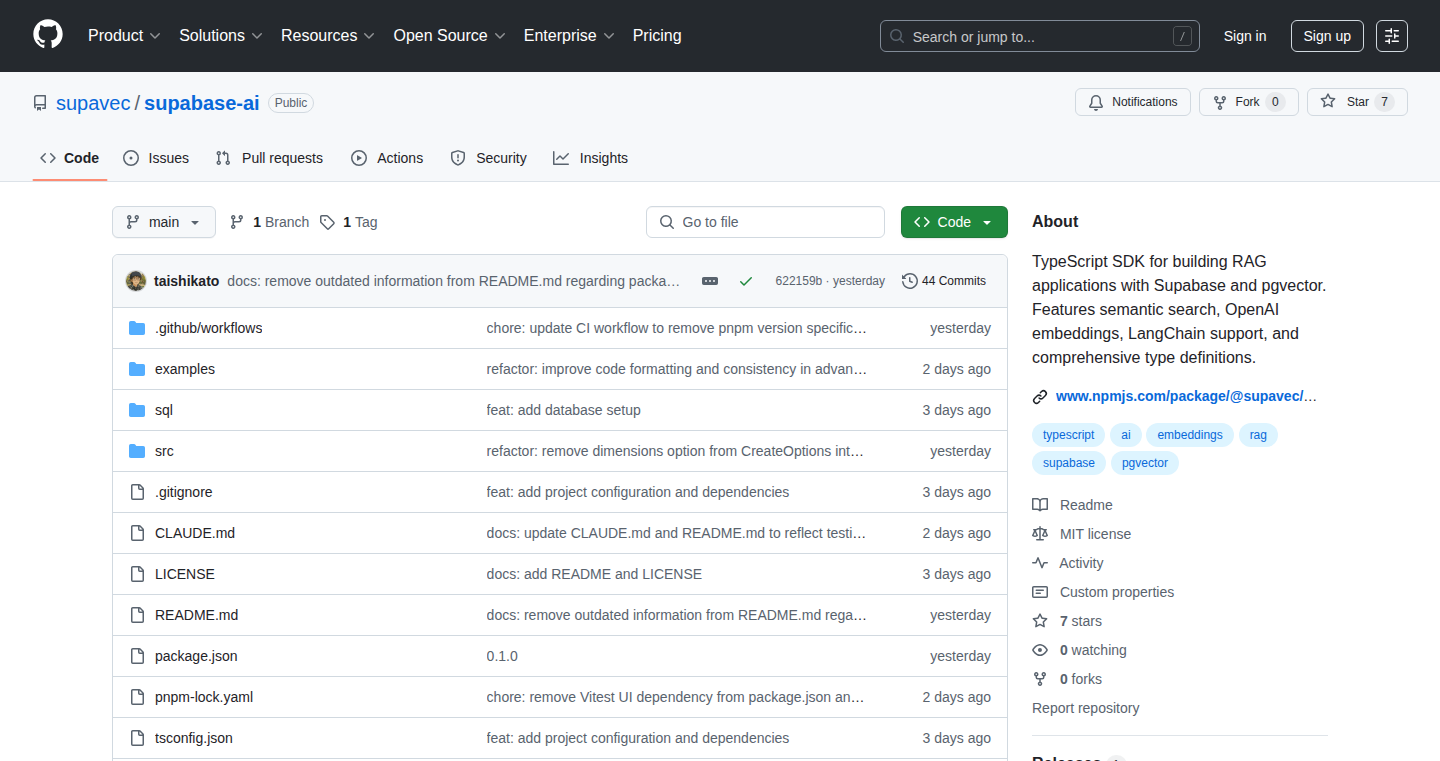
Author
taishikato
Description
This project is a lightweight library designed to make it easy to build AI applications that use Retrieval-Augmented Generation (RAG) with Supabase and its pgvector extension. It simplifies the process of generating embeddings (numerical representations of text that capture its meaning) and performing similarity searches. The key innovation is to provide a streamlined interface for interacting with pgvector, allowing developers to quickly integrate vector search capabilities into their applications without dealing with the complexities of raw SQL queries or complex vector database setups. This simplifies development and allows for quicker experimentation with RAG applications.
Popularity
Points 3
Comments 0
What is this product?
VectorSearch-Kit is essentially a toolkit that makes it easy to compare text. It works by taking pieces of text and turning them into vectors – think of these as fingerprints for the text's meaning. These fingerprints are then stored in a database (Supabase with pgvector). When you search for something, the toolkit generates a new fingerprint for your search query and finds the fingerprints in the database that are most similar. The innovation is that it provides ready-to-use functions to handle this process, allowing developers to focus on building their AI applications rather than the underlying technology. So this is useful because it makes it much easier to implement similarity search, which can be used for things like finding relevant documents, chatbots, or personalized recommendations.
How to use it?
Developers can use this library by integrating it into their existing Supabase projects. They provide the library with their data (text) to generate embeddings, store these embeddings in pgvector, and then use the library's functions to search for similar content based on a given query. This is useful for building applications such as document search, chatbots that answer questions based on a knowledge base, or content recommendation engines. So this lets you build smarter applications that understand the meaning of text.
Product Core Function
· Embedding Generation: This function takes text as input and generates a numerical vector representation (an embedding) of that text. The value is that it allows you to convert text into a format that can be easily compared for similarity by a computer. This can be used to understand the meaning of your text data, so you can build AI applications.
· Vector Storage: This function allows you to store the generated embeddings in a database (specifically, Supabase with pgvector). This is important because it enables you to save and organize the vector representations so you can query them efficiently. It enables efficient similarity searches over your data.
· Similarity Search: This function takes a query (also converted into an embedding) and searches the database for the most similar vectors. It is the core feature, as it retrieves the most relevant results based on the meaning of your query. You can build semantic search engines.
· Simplified API for pgvector: This makes it easy to interact with the pgvector database without writing complex SQL. You can avoid detailed database configurations.
Product Usage Case
· Building a Semantic Search Engine for a Company's Internal Documentation: Developers can index their company's documents using this library, allowing employees to search for information based on the meaning of their queries, rather than just keywords. This is useful when the user doesn't know the exact wording, so they still can get relevant information.
· Creating a Chatbot that Answers Questions Based on a Knowledge Base: By embedding a knowledge base, the library allows the chatbot to retrieve the most relevant information to answer user questions. This gives the chatbot the ability to understand your documentation and improve the user experience of your support platform.
· Developing a Content Recommendation System: This library can be used to recommend content (e.g., articles, products) that are similar to what a user is currently viewing or interested in. This enables better user engagement and conversions, therefore increasing revenue.
44
Debunkit.ai: Truth-Seeking Engine
Author
debunkit_ai
Description
Debunkit.ai is a tool that uses artificial intelligence to quickly assess the veracity of news articles or claims. It tackles the growing problem of misinformation by automatically comparing information against a vast dataset of reliable sources. It highlights the technical innovation of using AI to analyze text and provide a "trust rating," offering a rapid way to gauge the reliability of online content. This addresses the challenge of quickly identifying fake news and verifying claims, thus empowering users to make informed decisions.
Popularity
Points 1
Comments 2
What is this product?
Debunkit.ai is a web-based tool. You give it a link to a news article or type in a statement, and the AI goes to work. It uses Natural Language Processing (NLP), a type of AI that understands and processes human language, to analyze the text. It then compares the information against its internal knowledge base, which contains verified facts from a wide range of sources. The AI provides a 'trust rating' along with an explanation. The innovative aspect is the automated analysis that reduces the time needed to verify information.
How to use it?
Developers can use Debunkit.ai in a few ways. They could integrate the API (if available) into their own applications, such as news aggregators or social media platforms, to automatically verify content before displaying it to users. The primary use case is for individual users, who can paste a link and get an instant evaluation. So, if you are building a news app or a fact-checking tool, you could embed this functionality to enhance credibility.
Product Core Function
· URL Analysis: Allows users to input a URL to a news article, which is then analyzed for credibility. Value: Saves time by automatically checking content against known data.
· Text-Based Fact Verification: Users can directly input statements or facts for verification. Value: Provides a quick way to check the truthfulness of any written information.
· AI-Powered Comparison: The core technology uses AI to compare the input text to its database. Value: Enables automated fact-checking and provides a trust score.
· Trust Rating and Explanation: The tool provides a trust rating and explains the basis for the rating. Value: Offers a clear indication of the validity of the content, along with the reasons for the assessment.
Product Usage Case
· News Aggregator Integration: A developer integrating Debunkit.ai’s API into a news aggregator could automatically flag potentially misleading articles, improving user experience by highlighting credible sources. So this helps users to filter out dubious news.
· Social Media Fact-Checking Bot: A developer could build a bot that, when mentioned in a social media post, verifies the claims made within the post. This is a great option to enhance platform credibility and users could detect misinformation on social media platforms.
· Educational Tool for Media Literacy: Use the tool to teach students how to critically evaluate information online. Value: This is for educational purpose, it would foster critical thinking and media literacy skills.
45
XCP: eXtensible Coordination Protocol for Efficient AI Micro-Agent Communication
Author
maida-ai
Description
XCP is a new protocol designed to speed up communication between AI agents, especially when handling large data like images or text used in AI models. Existing methods often use JSON and HTTP, which can be slow for this type of data. XCP aims to be faster and more efficient by using a binary format, allowing AI agents to work together more smoothly and quickly. This means AI tasks can be completed faster and use fewer resources.
Popularity
Points 2
Comments 1
What is this product?
XCP is a communication protocol created for AI micro-agents (small, specialized AI programs). It tackles the problem of slow communication when these agents need to share large data like AI model outputs (tensors and embeddings). Instead of JSON, which is text-based and inefficient for large data, XCP uses a binary format. This allows for faster data transfer and better performance when building complex AI systems. It includes features to handle security and negotiate how data is compressed and transmitted. So this is useful for building faster and more efficient AI applications.
How to use it?
Developers can integrate XCP into their AI agent projects to improve the speed and efficiency of data exchange between agents. Imagine you have multiple AI models working together, one generating text, another creating images. XCP would allow them to share the data between them faster. You would likely use it by implementing the XCP protocol in your agent code, specifying how data should be formatted and transmitted. This involves using XCP's frame layout and codec negotiation for data encoding and decoding. So, by using XCP, developers can optimize their AI applications, especially those that involve complex data transfer.
Product Core Function
· Binary-first communication: XCP uses a binary format for data transfer instead of text-based formats like JSON. This makes transferring large AI model outputs (tensors, embeddings, etc.) much faster. For example, if you're building a system where AI models need to share images, this will speed up data transfer. So this means faster AI processing.
· Extensible framework: XCP is designed to be flexible, accommodating different data types and future needs. Developers can extend XCP to support new features or data formats. For example, if a new type of AI data becomes popular, XCP can be modified to handle it. So, it future-proofs the AI application.
· Codec negotiation: XCP includes a mechanism to negotiate how data will be compressed and encoded, allowing for efficient data transfer. It enables agents to agree on the best way to send data. For instance, if some agents have limited resources, they can agree to use compression to reduce data size before transmission. So it provides flexibility in handling various data types.
· Security Features: XCP includes security considerations within the protocol. So it helps ensure the secure exchange of sensitive data.
· Cross-agent Communication: XCP is designed for efficient communication between independent AI agents. So it enables better coordination in complex AI tasks.
Product Usage Case
· Building a multi-agent AI system for image processing. Imagine an application where one AI model enhances image quality, and another one adds specific visual effects. XCP can enable these two models to efficiently exchange image data, allowing the whole system to work faster and more smoothly. So, you can process images faster.
· Creating a real-time AI-driven chatbot that uses several AI components to generate responses. One component might analyze user input, another may generate relevant text, and a third might select the right voice. XCP helps these components to rapidly share information, ensuring the chatbot can respond in real-time. So the user gets faster response times.
· Developing AI systems in robotics. When robots have multiple sensors and AI components, XCP can enable them to exchange sensor data (e.g., from cameras or lidar) and control commands efficiently. So it can improve a robot's responsiveness.
· Enhancing distributed AI training: When training AI models on multiple machines, XCP can optimize the transfer of model parameters and data between these machines, which accelerates the whole training process. So the models can train faster.
46
Terminal Bash.org Quote Generator
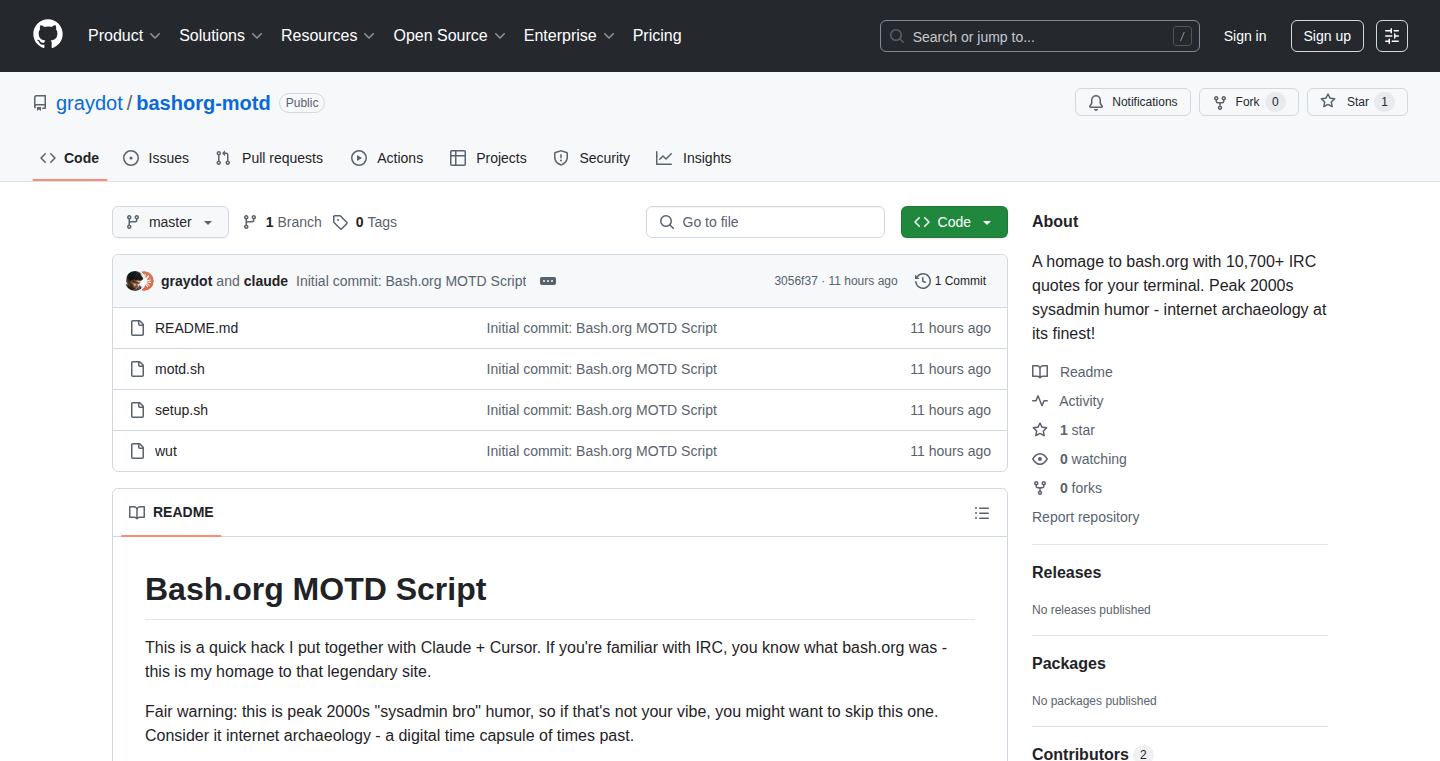
Author
graydot
Description
This project brings the nostalgia of the bash.org IRC quote archive directly to your terminal as a daily greeting (MOTD - Message of the Day). It fetches a random quote from bash.org and displays it every time you open a new terminal session. The technical innovation lies in its simplicity: a small script that uses web scraping (extracting data from a website) and terminal output manipulation to deliver a dose of internet humor. It solves the problem of providing a personalized and entertaining experience when users open their terminals.
Popularity
Points 3
Comments 0
What is this product?
This is a simple shell script that retrieves a random quote from the bash.org website. It uses web scraping to get the quote and then configures the terminal's MOTD to display it. Think of it as a digital fortune cookie for your terminal. So this is useful because it adds a bit of fun to a usually functional experience.
How to use it?
Developers use this by simply running the script or integrating it into their terminal configuration (e.g., by placing it in their .bashrc or .zshrc file). When you open a new terminal window or tab, the script runs, fetches a quote, and displays it. This allows for easy and automatic delivery of entertainment. For example, if you're a developer, you can easily modify your terminal's settings to run this small script every time you open a new terminal window. This means that every time you start coding or interacting with your machine through the terminal, you'll receive a witty quote. So this is useful because it's easy to setup and adds some fun and entertainment to your daily routine.
Product Core Function
· Web Scraping: The script uses a technique called web scraping to automatically extract data (quotes) from the bash.org website. This allows it to get the latest content from the website without manual intervention. The value is that it automates content retrieval. So this is useful because it can gather data from web pages.
· Terminal Integration: The script integrates with the terminal's Message of the Day (MOTD) feature. This means that the quote is displayed every time the user opens a new terminal session. The value is providing a personalized and engaging experience. So this is useful because it allows developers to customize their terminal with fun or important information.
· Randomization: The script fetches a random quote each time it runs. This ensures that the user sees different content every time they open their terminal. The value is enhancing user engagement and avoiding repetitive experiences. So this is useful because it keeps the experience fresh and enjoyable.
· Shell Scripting: The whole project is built using shell scripting, demonstrating the power and flexibility of command-line tools. This makes it easy to customize and adapt the script. The value is the ease of creation and deployment. So this is useful because it makes it simple to create or modify terminal tools.
Product Usage Case
· Personalized Terminal Greeting: A developer can integrate the script into their terminal configuration to receive a random quote as a daily greeting. This can make the terminal experience more enjoyable and less monotonous. So this is useful because it makes the terminal more engaging.
· Lightweight Entertainment: The script provides a quick dose of humor or entertainment without requiring complex software installations. This can be especially useful for developers who spend a lot of time in the terminal. So this is useful because it adds a touch of fun to a developer's daily routine.
· Customizable Information Display: The script's structure is easily adaptable. Developers could adapt the script to display other types of information or content from other websites, not just quotes from bash.org. So this is useful because it's easily adaptable.
47
WikiLoop Galaxy: Interactive Wikipedia Graph Explorer
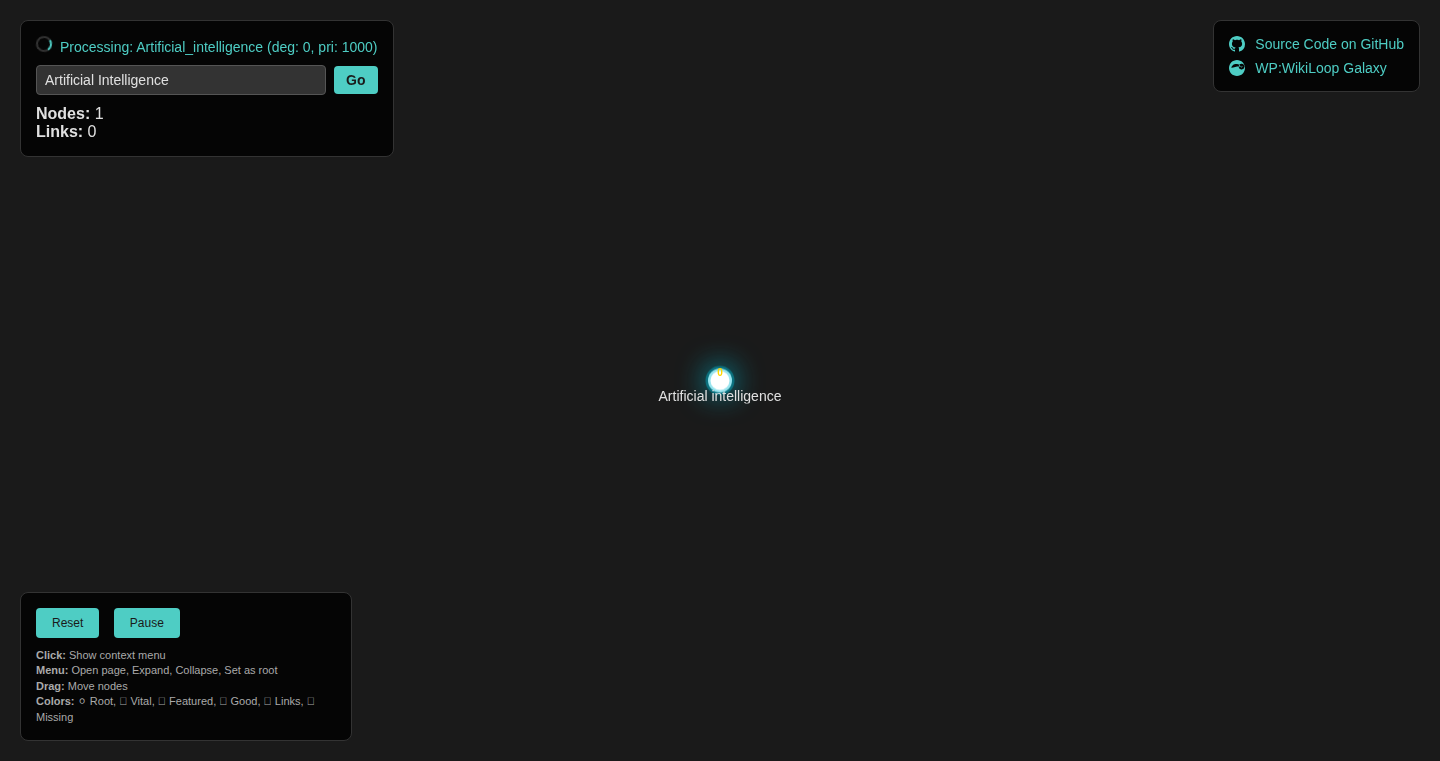
Author
xinbenlv
Description
WikiLoop Galaxy is a web application that visualizes the relationships between Wikipedia articles as an interactive graph. It uses the Wikipedia API to fetch article data and D3.js to render the graph dynamically, allowing users to explore the interconnectedness of knowledge in real-time. It addresses the challenge of navigating complex information by providing an intuitive, visual interface for exploring Wikipedia’s vast network of articles. So this lets you see how different topics relate to each other visually.
Popularity
Points 3
Comments 0
What is this product?
WikiLoop Galaxy is a tool that turns Wikipedia into an interactive map. It uses the Wikipedia API to get information about articles and their links. Then, it uses a technology called D3.js to draw this information as a dynamic graph, where each article is a node and links are connections. When you click on an article, it shows more related articles. The graph updates in real-time as you explore. So you can visually understand how topics relate to each other.
How to use it?
You can use WikiLoop Galaxy through its web interface. Just enter a Wikipedia article title to start, and the tool will build a graph showing that article and its connections. Clicking on the nodes expands the graph to show linked articles. This is useful for anyone who wants to explore a topic in depth, discover new information, or see how different topics connect. You don't need to install anything; just open it in your web browser. So, if you're researching or just curious, this tool lets you visually explore the web of knowledge.
Product Core Function
· Bidirectional Link Traversal: This feature allows you to explore both the links going out from an article and the links coming into an article. It's like exploring a topic from all angles, seeing what it references and what references it. So you can get a complete picture of the article's connections.
· Real-time Graph Building: The graph is built as you explore, starting from a central article and expanding as you click. This makes it easy to follow your curiosity and discover related topics step by step. So you can explore Wikipedia in a way that feels more like a journey than just reading pages.
· Interactive Expansion: Clicking on a node (an article) expands it, revealing more connected articles. This lets you delve deeper into a topic with ease, discovering the broader context and related concepts. So you can quickly uncover the relationships between articles without having to jump around Wikipedia.
· Link Validation: The tool checks if the links to other articles are still valid. If a link is broken or missing, it's indicated, which keeps the graph accurate and reliable. So you're always looking at the most up-to-date information.
Product Usage Case
· Research: A student is researching the history of Artificial Intelligence. They start with the main article on AI, and then use WikiLoop Galaxy to visually explore related articles, such as Machine Learning, Neural Networks, and Turing Test. This helps them quickly see the key concepts and how they relate to each other. So you can discover how different topics link together, making research easier.
· Learning: A curious learner wants to understand the different types of economic theories. They start with an article on Economics, and then explore the connections to articles on Capitalism, Socialism, and other related concepts. The visual representation helps them understand the relationships between these theories. So you can easily visualize complex topics for better understanding.
· Content Creation: A writer is creating a blog post about climate change. They use WikiLoop Galaxy to identify related articles, such as Global Warming, Greenhouse Gases, and Renewable Energy. The tool helps them brainstorm topics and see the connections between different aspects of climate change, making it easier to create a comprehensive piece. So you can create more informative content by seeing the bigger picture.
48
LinkMonster: Multiplex Link Sharing Solution
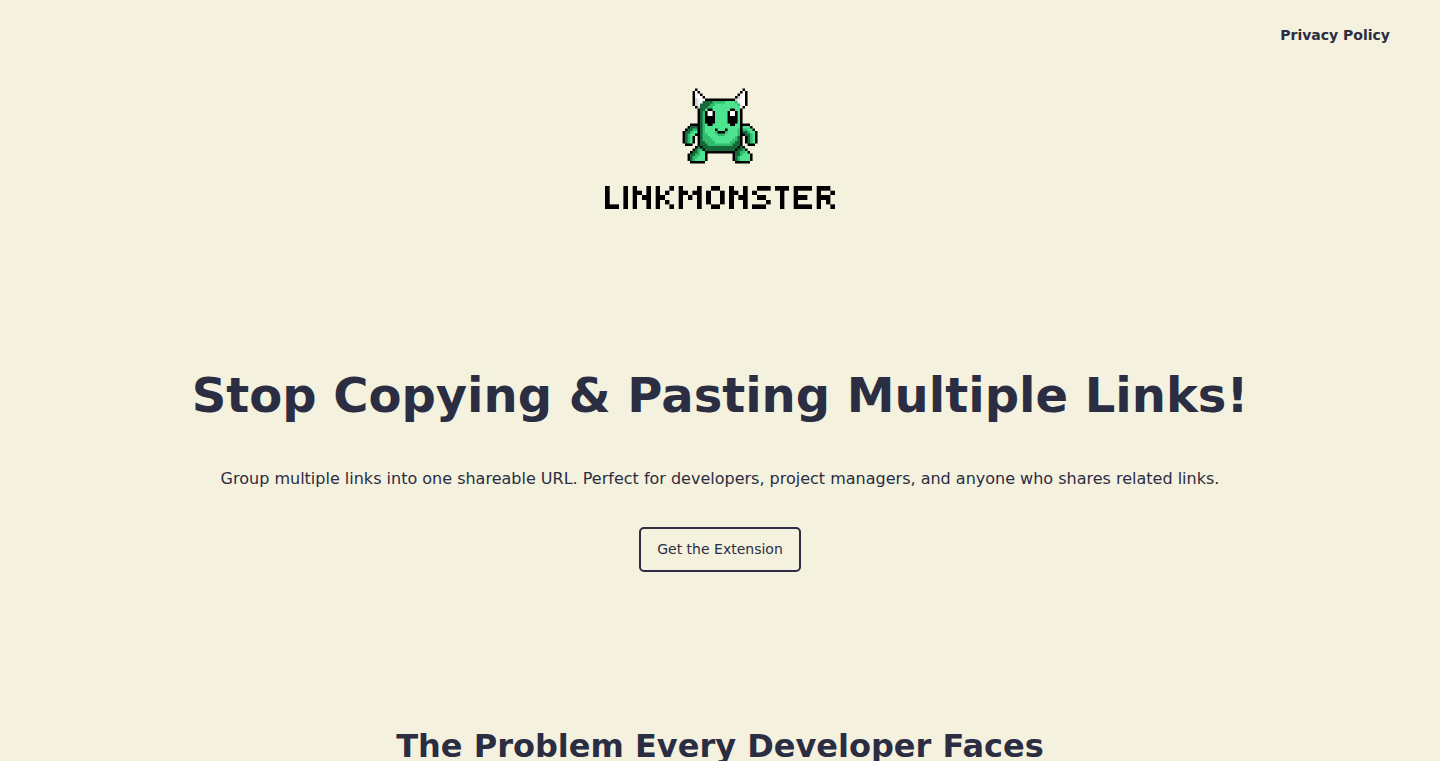
Author
atharv_sardesai
Description
LinkMonster simplifies sharing multiple links with a single, customizable URL. Instead of sending a list of individual links, you get a single shareable link that points to a page containing all your desired resources. It addresses the common problem of cluttered link sharing, allowing for cleaner communication and improved user experience by providing a centralized hub for related links.
Popularity
Points 2
Comments 1
What is this product?
LinkMonster is a simple web application that creates a single link to aggregate and share multiple links. Technically, it likely uses a database or some form of data storage to associate a short, unique identifier (the shared link) with a list of longer URLs. When someone clicks the shared link, the application retrieves and displays the associated URLs. The innovation lies in the streamlined experience for sharing multiple web resources without overwhelming the recipient. So this is useful for anyone who wants a clean way to share many links at once.
How to use it?
Developers can integrate LinkMonster into their projects by using its API (if available) or by simply embedding the generated links in their applications. It could be used for: creating curated resource lists for documentation, sharing relevant links in project announcements or email newsletters, or building micro-sites dedicated to a specific topic. So you can save time and provide a better user experience for sharing a bunch of URLs.
Product Core Function
· URL Aggregation: The primary function is to collect multiple URLs into a single container. This allows users to share a single, manageable link instead of a long list of individual URLs. The value is in simplifying the sharing process and providing a cleaner user experience. Application: Group related research links together and share them for collaboration.
· Customization: The tool provides some level of customization, allowing users to potentially edit the display, add titles, or categorize the links. This improves the usability. Application: Create a branded link page for your company's resources.
· Link Management: LinkMonster likely provides features to manage and update the shared links. Users can add, remove, or modify the links within the aggregate container. The value here is in the ability to keep the shared information up-to-date without needing to resend the link. Application: Quickly update project links without re-distributing them.
· Unique URL Generation: Upon aggregation, the tool assigns a unique and shareable URL to the combined set of links. This URL serves as the entry point for accessing all the included resources. The value is to ensure that all the links can be accessed with just one click. Application: Make it simpler to reference a complex set of resources from your presentations.
Product Usage Case
· Sharing research papers for a team: A researcher compiling multiple research papers related to a specific topic could use LinkMonster to create a single, easily shareable link containing all the resources, instead of sending them individually, so others can easily find the relevant materials.
· Creating a resource list for a developer project: A developer working on a project could share multiple links to documentation, tutorials, and API references in one place. The team can access all the resources, which is more convenient.
· Sharing multiple portfolio examples with a potential client: A freelancer can consolidate multiple project links into one shareable link, streamlining the presentation of their work and making it easier for potential clients to review their portfolio.
49
CRISPRMind - Idea Mutation and Thought Tracking Tool
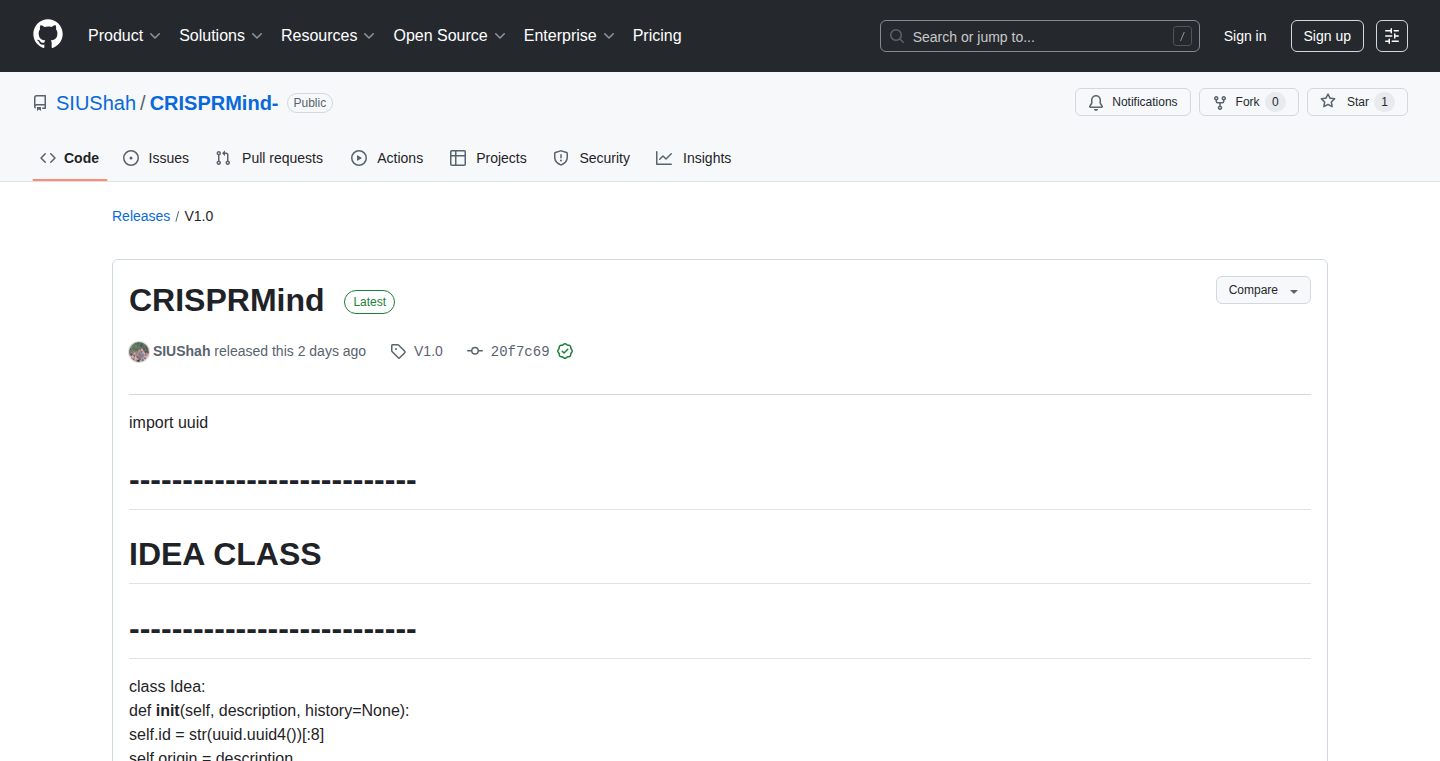
Author
SIUSha123
Description
CRISPRMind is a Python-based tool that allows you to manipulate and transform your ideas, similar to how DNA is edited. It enables you to combine, reverse, personalize, and reframe your thoughts, while meticulously tracking each edit as a 'memory'. This project provides a local, barrier-free environment for exploring and documenting the evolution of your ideas. It's a technical exploration of thought manipulation and memory tracking, emphasizing the iterative nature of idea generation.
Popularity
Points 1
Comments 1
What is this product?
CRISPRMind is essentially a digital notebook that utilizes the concept of CRISPR (a gene-editing technology) to manipulate your ideas. You start with an initial idea and then apply a series of 'edits' – you can combine it with another idea, reverse it, personalize it, or completely reframe it. The tool meticulously records each of these steps, creating a detailed trail of your thought process. So, this lets you see how your ideas evolve, helping you understand the journey of your thinking. It's built using Python and runs locally, meaning no need to create an account or share your thoughts with anyone. So this is useful if you want to explore ideas freely and keep a record of your thought process.
How to use it?
Developers can utilize CRISPRMind in various ways. They can input their initial ideas into the tool and then use its editing functions (combine, reverse, personalize, reframe) to explore different facets of the idea. Each edit creates a new 'memory' of the idea in a particular state. This tool is easily integrated into any project that involves creative thinking, problem-solving, or brainstorming. For instance, a developer working on a new software feature could use CRISPRMind to explore different angles, experiment with different approaches, and document the evolution of the feature's design. So this helps in brainstorming and tracking how you get your insights.
Product Core Function
· Idea Input: Allows developers to input initial ideas or concepts into the system. This forms the base for subsequent transformations.
· Idea Transformation: Provides a set of functions (combine, reverse, personalize, reframe) to manipulate and modify the initial idea. It enables experimenting with different perspectives and approaches.
· Memory Tracking: Records each transformation as a 'memory' or a step in the process. This function provides a detailed, chronological record of how the idea evolved, facilitating understanding of the thought process.
· Local Execution: Designed to run locally, without any sign-ups or external dependencies. This ensures privacy and allows the user to retain complete control over their data and thought process.
Product Usage Case
· Software Design: A developer can use CRISPRMind to brainstorm and evolve a new software feature. By starting with an initial concept, they can use CRISPRMind's features to explore different implementation angles, analyze potential challenges, and document the evolution of the design. This could help in deciding the best approach and remembering what you already tried.
· Problem Solving: When faced with a complex problem, a developer can input the problem description into CRISPRMind and use the tool to break it down, reframe it, and explore various potential solutions. The ability to track each step is useful to see how you arrive to the solution.
· Creative Writing: Writers can use CRISPRMind to brainstorm plotlines, character developments, and story elements. They can start with a basic concept and use the editing tools to explore different narratives, create variations, and refine their ideas over time. This helps build better stories.
· Technical Documentation: Developers can use CRISPRMind to organize and refine technical documentation. By inputting initial drafts, they can combine different concepts, reverse certain explanations for clarity, and reframe complex technical details to aid understanding. The tracking feature enables them to remember the thought process behind the documentation.
50
FileJet: Decentralized File Transfer with WebRTC and Zero-Knowledge Encryption
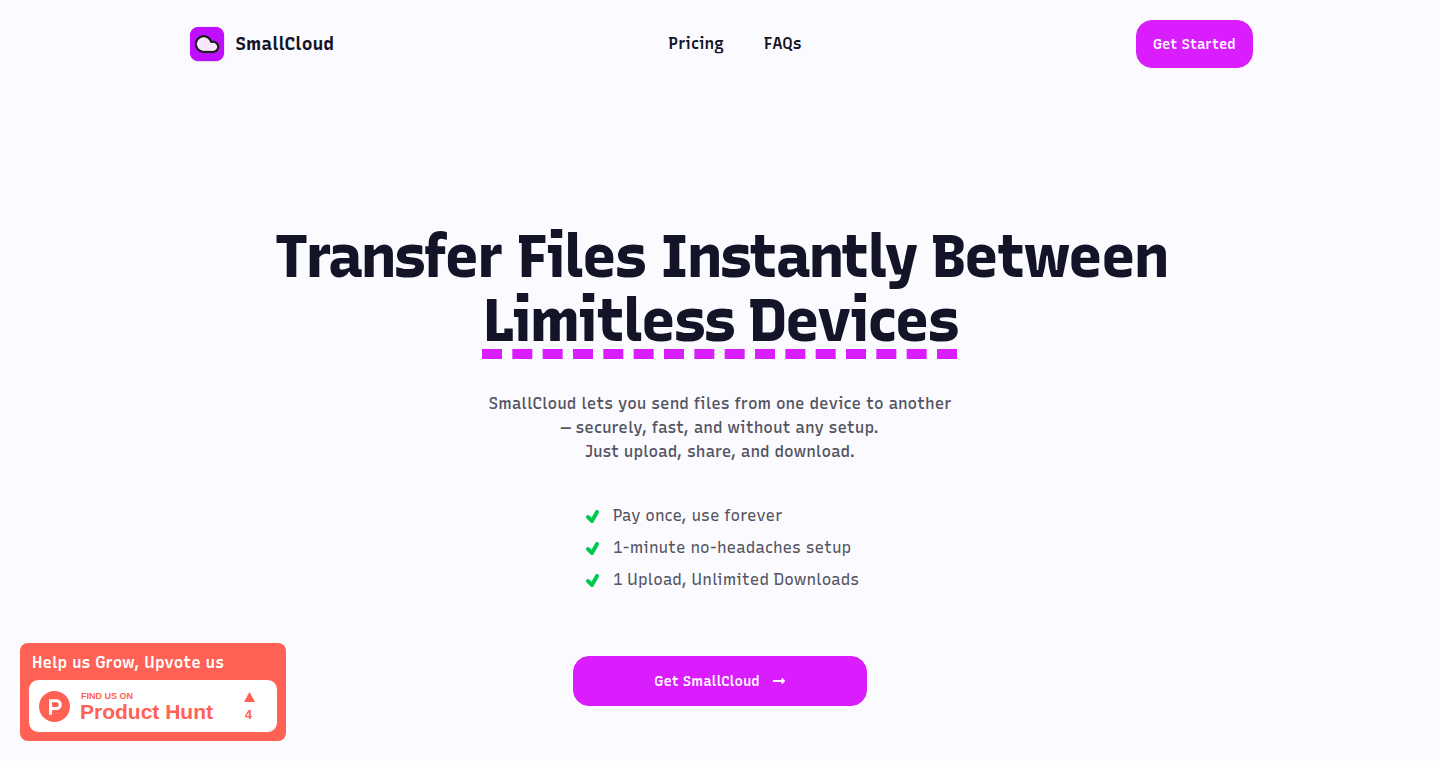
Author
shivanhupr
Description
FileJet offers a privacy-focused alternative to AirDrop for file sharing, using the power of WebRTC (Web Real-Time Communication) for direct peer-to-peer transfers and zero-knowledge encryption to protect your files. This project tackles the limitations of centralized file transfer services, like slow speeds and potential privacy breaches, by allowing users to securely share files directly with each other, without relying on a central server. It leverages the power of web technologies for a cross-platform file sharing solution.
Popularity
Points 2
Comments 0
What is this product?
FileJet allows you to transfer files directly between devices, like your phone and computer, without needing any cloud storage or a central server. It uses WebRTC, a technology that lets your devices talk to each other directly, similar to how video calls work. The files are encrypted before being sent, so only the recipient can open them. This provides a faster, more secure, and private way to share files. Think of it as AirDrop, but works on different operating systems and protects your data even more.
How to use it?
Developers can use FileJet by integrating its underlying WebRTC file transfer components into their own applications or browser extensions. The project's modular design allows developers to customize the file transfer process, add features like file previews, and integrate it with other services. Think of it like this: if you're building an app that needs to share files directly between users, FileJet gives you the core technology, saving you the trouble of building the complex networking and encryption parts. For example, If you are building a cross platform file sharing application, then you can use FileJet to enable device to device file sharing, which can speed up the file transfer process.
Product Core Function
· Direct Peer-to-Peer Transfer: Files are sent directly between devices using WebRTC, bypassing central servers for faster speeds. So this means files transfer directly between your devices without any middleman, which is much faster and secure.
· Zero-Knowledge Encryption: The files are encrypted before being sent and decrypted by the recipient, ensuring that only the intended recipient can access the files. This adds an extra layer of security compared to traditional file transfer methods, because your files are safe even if someone intercepts the transfer.
· Cross-Platform Compatibility: The project leverages web technologies, making it potentially compatible with various operating systems and devices through web browsers. This means you can share files between Windows, macOS, Linux, Android, and iOS devices without needing separate apps.
· User-Friendly Interface: The project focuses on a simplified user experience. It likely includes features like drag-and-drop file selection, progress indicators, and secure connection setup. Which helps users easily use the file transfer tool without having to understand the complex technical details.
Product Usage Case
· Building a secure file-sharing tool for a team working on confidential projects: Using FileJet, developers can build a system where team members can share files directly and securely, without the risk of data breaches from cloud storage.
· Creating a cross-platform file transfer app: Developers could integrate FileJet's WebRTC file transfer capabilities into a mobile or desktop app, allowing users to share files across different devices quickly and securely.
· Developing a browser extension for easy file sharing: A browser extension could be built, allowing users to share files directly from their browser without having to use external apps or cloud services.
· Integration with a communication platform: Developers can integrate FileJet into their chat applications, making it easier for users to securely share files with each other during a conversation.
51
LogManager: Real-time SSH Log Viewer
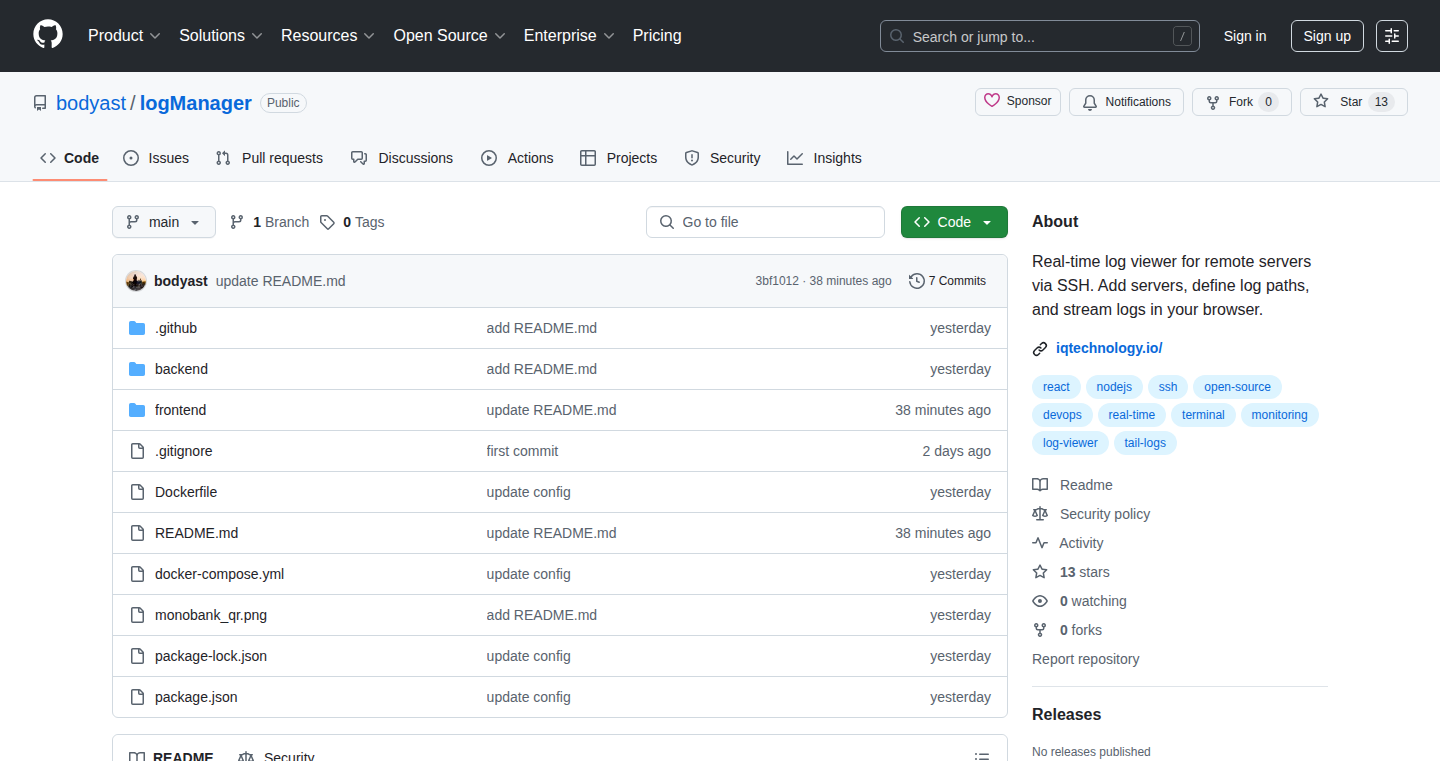
Author
bodyast1010
Description
LogManager is a web-based tool that lets you view server logs in real-time, directly in your browser. It connects to remote servers using SSH, similar to how you might use a terminal, but provides a user-friendly interface. The core innovation lies in its ability to stream log data using WebSockets, providing instant updates. So, instead of constantly checking your server logs manually, you get live updates in your browser, saving you time and effort.
Popularity
Points 2
Comments 0
What is this product?
LogManager is a web application that acts as a central hub for viewing logs from your remote servers. It leverages SSH to securely connect to the servers and retrieve log files. The magic happens with WebSockets, a technology that enables real-time, two-way communication between your browser and the server. When a new log entry appears on the server, it's instantly pushed to your browser. This is a significant improvement over traditional methods where you would need to repeatedly refresh or poll for changes. Think of it as a live feed for your server logs, offering insights in real time. This approach is innovative because it avoids the need to manually check logs repeatedly.
How to use it?
Developers can use LogManager by first setting up SSH access to their servers. Then, they configure LogManager with the server addresses, login credentials, and the paths to the log files they want to monitor. Once configured, you can open LogManager in your browser and start viewing the logs immediately. This is particularly useful for DevOps engineers and developers who need to monitor the health of their applications or troubleshoot issues in real-time. Its integration is seamless and relies only on secure SSH connections.
Product Core Function
· Real-time Log Streaming (tail -f): This feature streams log data to your browser as it appears on the server, using WebSockets. This provides immediate updates, allowing you to diagnose issues and monitor your applications without delay. This means you always have the most up-to-date information, saving you valuable time. For example, when your application is experiencing a crash, you'll immediately see the corresponding error messages.
· Multiple Server Support: Add and manage logs from several remote servers, all within a single interface. This is incredibly helpful for teams managing diverse infrastructure. You can monitor multiple servers in a consolidated view. You are able to monitor your production, staging, and testing environments at the same time, easily switching between them.
· Customizable Log File Paths: Specify the exact location of your log files on each server. This provides flexibility and allows you to monitor any log file on your server, no matter where it's located. If your application writes logs to a non-standard directory, this feature ensures you can still monitor them. It gives you total control over what you see.
· User Authentication and Secure Access: Includes user authentication to protect sensitive log data and ensure secure access. This protects your data. LogManager ensures only authorized personnel can view your server's logs. This feature is critical for maintaining security and privacy.
· React-based UI: Utilizes a simple and intuitive user interface built with React, a popular JavaScript framework. This makes it easy to navigate and use the tool. The UI is responsive and designed for a seamless user experience. It's designed for easy navigation and readability.
· Remote Access Over SSH: Uses SSH to securely connect to remote servers. This allows developers to view logs remotely, ensuring that developers can access them from anywhere they have internet access without requiring any complicated setup.
Product Usage Case
· Debugging Production Issues: When a critical error occurs on your production server, use LogManager to immediately view the latest log entries. This helps you identify the root cause of the problem quickly. This real-time view helps pinpoint errors and fix them faster.
· Monitoring Application Health: DevOps teams can use LogManager to continuously monitor the health of their applications. If an error is detected, they can be alerted immediately. If there's an unusual spike in your application's activity, this helps you detect and respond to potential problems quickly.
· Troubleshooting Network Issues: Network administrators can use LogManager to observe logs from network devices and pinpoint problems. It's easy to spot network performance issues. When troubleshooting network outages, this provides instant information.
· Log Aggregation for Distributed Systems: Use LogManager to aggregate logs from several servers, making it easy to monitor complex applications distributed across multiple machines. If your system is made up of many servers, this allows you to view all the logs in one place.
52
Best AI Tool Finder: Curated AI Tools Database
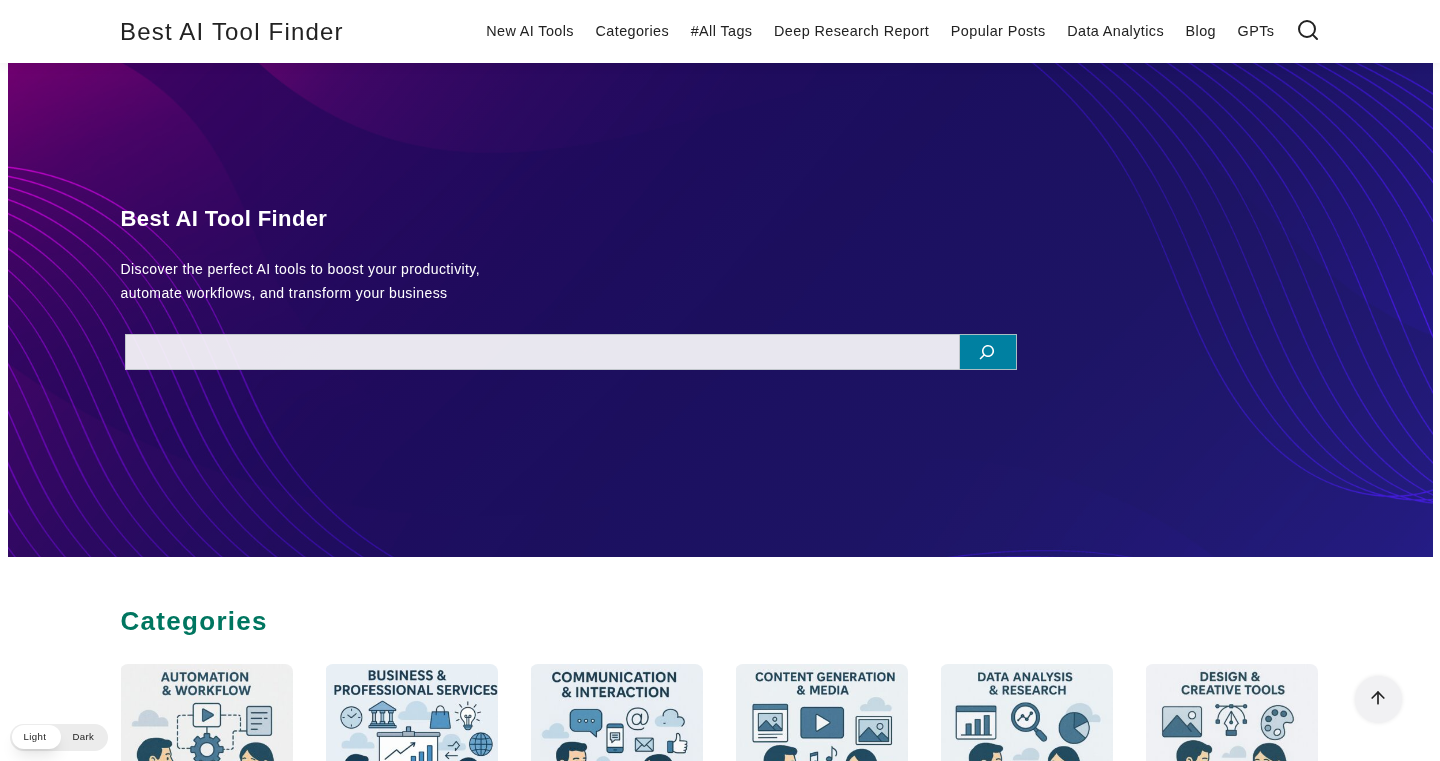
Author
ShinMatsura
Description
This project provides a curated database of over 10,000 AI tools, continuously updated and reviewed to help users navigate the vast landscape of AI platforms. The key innovation is the combination of AI-driven filtering and human review to ensure the accuracy and relevance of the listed tools. This addresses the problem of information overload in the rapidly evolving AI space, making it easier for users to discover and evaluate AI tools.
Popularity
Points 1
Comments 1
What is this product?
This is a comprehensive directory of AI tools. It utilizes a combination of AI and human reviews to filter and categorize over 10,000 AI tools from various sources. The project employs an automated AI pipeline to fact-check and screen content for copyright and hallucination issues before human review. The goal is to offer a reliable and independent resource for makers, researchers, and anyone interested in AI technology.
How to use it?
Developers and users can use this project by browsing the database to discover and compare AI tools. They can search by category, functionality, or keyword. The project offers in-depth industry reports and trend analysis, which can inform decision-making for integrating AI tools into their projects. You might use it to find the right AI model for a specific task, discover new AI-powered development tools, or learn about the latest trends in the AI industry.
Product Core Function
· Curated Database: This is the core function. The database offers a selection of AI tools, which saves users from the headache of searching everywhere on the internet to find what they need. The filtering makes sure the quality is good and avoids the time-consuming process of evaluating low-quality tools.
· AI-Powered Filtering: The project utilizes AI to filter and classify tools. This includes initial screening for relevance and identification of key features. This helps ensure the database remains current and accurate. So this can quickly narrow down search results to show the most relevant tools based on the user's requirements.
· Human Review: The project combines automated filtering with human review, ensuring that the information is accurate and reliable. This helps mitigate the problems of AI-generated errors or hallucinations. Therefore, this ensures that the tool's features are thoroughly reviewed and that the descriptions are accurate.
· Trend and Review Articles: The site provides over 1,600 trend and review articles. These articles provide detailed insights into various AI tools, their applications, and market trends. The main goal is to help users stay updated on the latest trends in AI tools.
· Industry Reports: The project provides more than 100 deeply researched industry reports. These reports offer in-depth analysis for professionals and beginners. These reports will give users the information they need to make better decisions.
Product Usage Case
· Software Developers: A developer looking for an AI-powered code completion tool can search the database to find and compare various options. They can then test them out and then find out the one that best suits their programming style. This is a big time-saver for developers, allowing them to streamline their coding workflows.
· Marketing Teams: A marketing team can search for AI tools for content creation. They can then filter the tools by marketing focus and see how well they've performed. This helps the marketing team create marketing content to fit their specific needs, leading to increased efficiency and better marketing results.
· AI Researchers: An AI researcher can use the database to find new and emerging AI tools for their research. They can find up to date information on AI trends and tools. This can give researchers the newest information they need.
53
Android Easter Egg Explorer
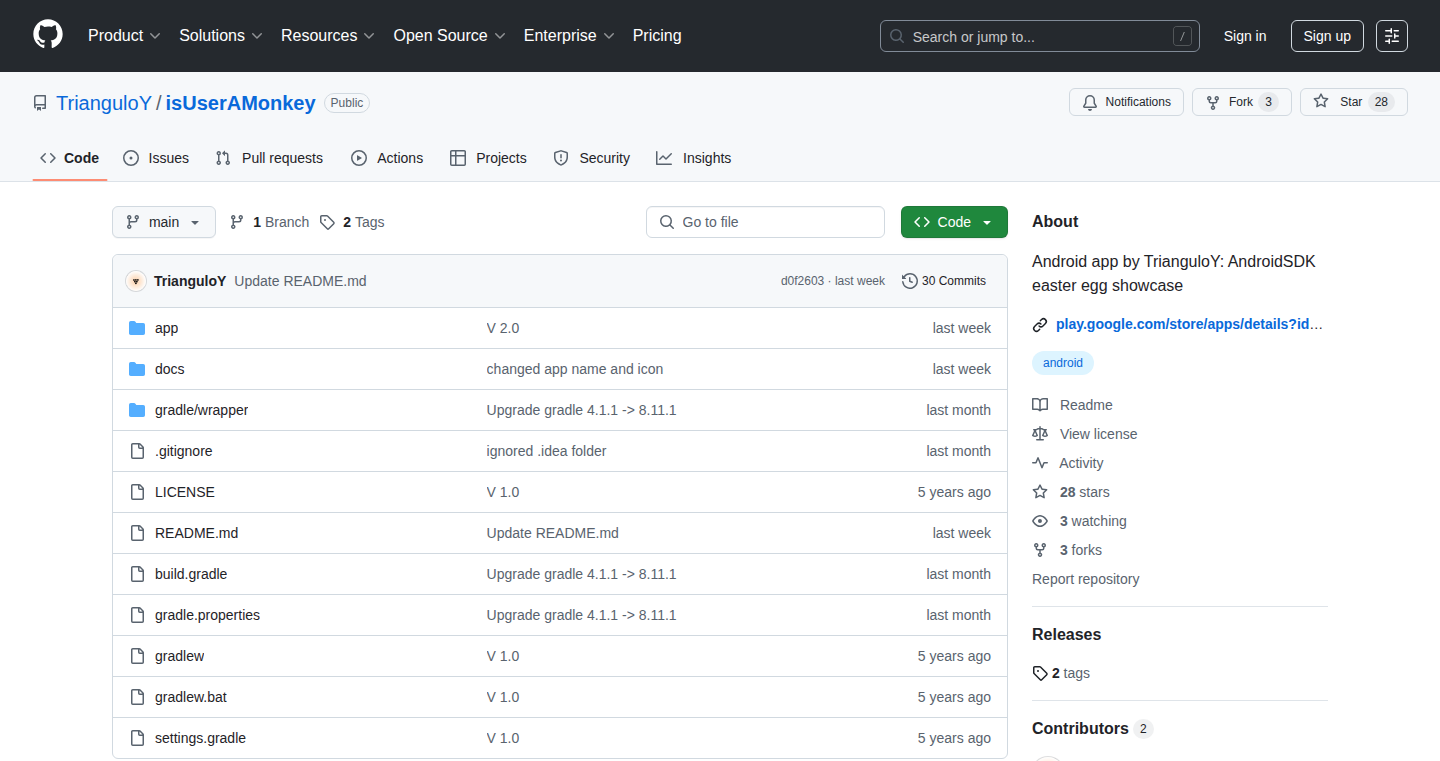
Author
TrianguloY
Description
This project is a showcase of hidden 'Easter Eggs' within the Android SDK. It provides a centralized, browsable interface to discover these quirky, often undocumented features. The innovation lies in the systematic exploration and presentation of these hidden gems, making them accessible to developers and enthusiasts. This solves the problem of fragmented information and the difficulty in finding these features buried within the Android ecosystem.
Popularity
Points 2
Comments 0
What is this product?
It's essentially a directory, or a searchable library, of the secret features baked into different versions of the Android operating system. Think of them as little puzzles or surprises that Google's engineers have included. This project makes it easy to browse and understand these features, providing information that's often hard to find otherwise. For example, it might show you a hidden animation, a secret game, or a unique way to interact with your phone. The innovation is in collecting all these scattered secrets and presenting them in a user-friendly way. So this is helpful because it allows you to easily discover interesting and fun features you might not have known existed.
How to use it?
Developers can use this project as a learning tool and as a source of inspiration. They can explore the code behind the Easter Eggs to understand how Google developers approach different technical challenges. You could examine the source code and try to implement some of them yourself, or even use them as a starting point for your own creative projects. The project is essentially a collection of Android trivia. This is helpful because it lets developers quickly understand the different hidden features.
Product Core Function
· Discovery of Hidden Features: The core function is to identify and list the Easter Eggs. The value is that it saves developers time and effort by avoiding the need to manually search through Android documentation. It provides an easy-to-browse list of interesting and quirky features.
· Code Exploration: It likely provides links to code snippets or information about the implementation of each Easter Egg. This functionality provides valuable learning opportunities for understanding Android development techniques.
· Version Specificity: The project probably categorizes Easter Eggs by Android version. This is useful because the features are often specific to a particular Android release and ensures developers have relevant details.
Product Usage Case
· Android Development Training: A developer learning Android development can use this to learn about Android system design and hidden functionalities by studying the implementation of these Easter Eggs and exploring specific code samples.
· Reverse Engineering: A security researcher could use this to reverse engineer how these features work and find potential vulnerabilities.
· UI/UX Inspiration: A UI/UX designer could use it to discover new ways to create engaging user experiences within Android apps. This helps to improve app engagement and create something new and unique.
54
Infersync: Asynchronous Team Synchronization Engine
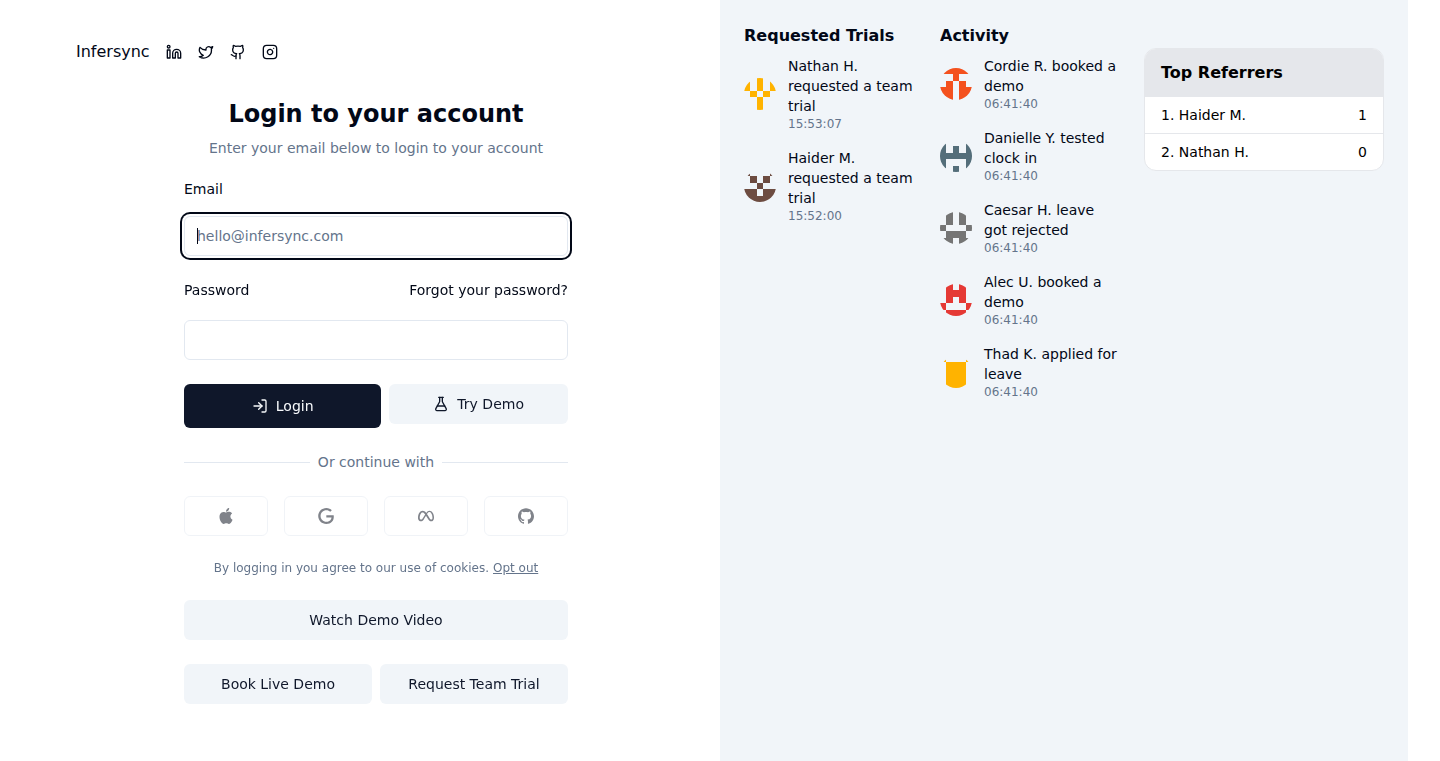
Author
No3Mc
Description
Infersync is an HR and team management tool designed for async teams, meaning teams that don't rely heavily on real-time meetings. It cleverly integrates with project management tools like Plane.so to track task progress. The core innovation lies in its ability to allow team members to 'clock in' on tasks, providing clear visibility on what everyone is working on without the need for constant check-ins or micromanagement. It solves the problem of maintaining team alignment and productivity in remote or distributed teams by streamlining the process of status updates.
Popularity
Points 1
Comments 1
What is this product?
Infersync functions as a task-focused attendance and activity tracker. It pulls tasks from project management platforms and allows team members to declare what they are working on. This provides a clear overview of individual and team-wide progress without requiring synchronous communication. It uses APIs to connect to existing project tools, and likely uses a database to store and analyze activity data. This approach helps avoid the need for numerous meetings, improving efficiency. So this is useful because it replaces constant meetings with a clear, automated system for understanding progress and tasks.
How to use it?
Developers integrate Infersync into their existing workflow by connecting it to their project management tools (e.g., Plane.so). Team members would use Infersync to 'clock in' on tasks pulled from the integrated platform, effectively indicating their focus. It has an admin dashboard for management and basic reporting. Developers use this to track attendance, manage leave, and generate reports on team productivity. So this is useful because it is easy to integrate into your existing workflow if you are using any popular project management tools.
Product Core Function
· Attendance Management: Allows tracking of employee attendance. It uses the 'clock in' functionality to automatically create attendance records, eliminating the need for manual tracking. So this is useful because it helps you track employee time spent on each project automatically.
· Leave and Break Tracking: Enables easy tracking of leaves and breaks, streamlining HR processes. By integrating with the task-focused attendance management it reduces the chances of human error. So this is useful because it automates tracking and reduces manual effort.
· Admin Dashboard: Provides a central view for managers to monitor team activity and performance. This is a dashboard built with all the reporting needed to keep the project in track. So this is useful because it provides a comprehensive overview for managers.
· Basic Reports: Generates reports to provide insights into team performance and productivity. It analyzes the data collected from task 'clock ins' and attendance to generate reports. So this is useful because it generates insights for the team.
· Org Chart: Visualizes the team structure and hierarchy. It allows teams to quickly understand team structure. So this is useful because it helps understand team structure at a glance.
· Custom Roles: Provides the ability to define and assign custom roles to users, improving flexibility in team management. By using custom roles, it will be easier to manage different level of responsibilities. So this is useful because it provides flexibility in team management.
· Recognition System: Allows for recognizing and rewarding contributions, fostering a positive team environment. By rewarding positive behaviors, this tool increase team members' loyalty. So this is useful because it fosters a positive team environment.
Product Usage Case
· Remote Development Teams: A distributed development team uses Infersync to manage its workflow with members across multiple time zones. Developers 'clock in' on their tasks, which instantly updates the management team about the progress. So this is useful because it creates a clear view of task status even across time zones.
· Project Management Integration: A development team integrating Infersync with their existing project management tool (like Plane.so) for streamlined task tracking. It integrates with existing project management tools using its API. So this is useful because it is easy to connect with existing tools.
· Async Communication: A team needing to avoid many meetings to achieve its goals. The tool would track the working status of team members in the background, by tracking their work progress and providing a view on what is happening. So this is useful because it offers a simple solution for managing and coordinating tasks asynchronously.
· HR Management: A team using Infersync as a simple attendance and leave tracker. Using the dashboard, HR managers would be able to manage their HR needs. So this is useful because it provides a simple solution for HR teams.
55
FormCraft: A Modular, Open-Source Form Builder
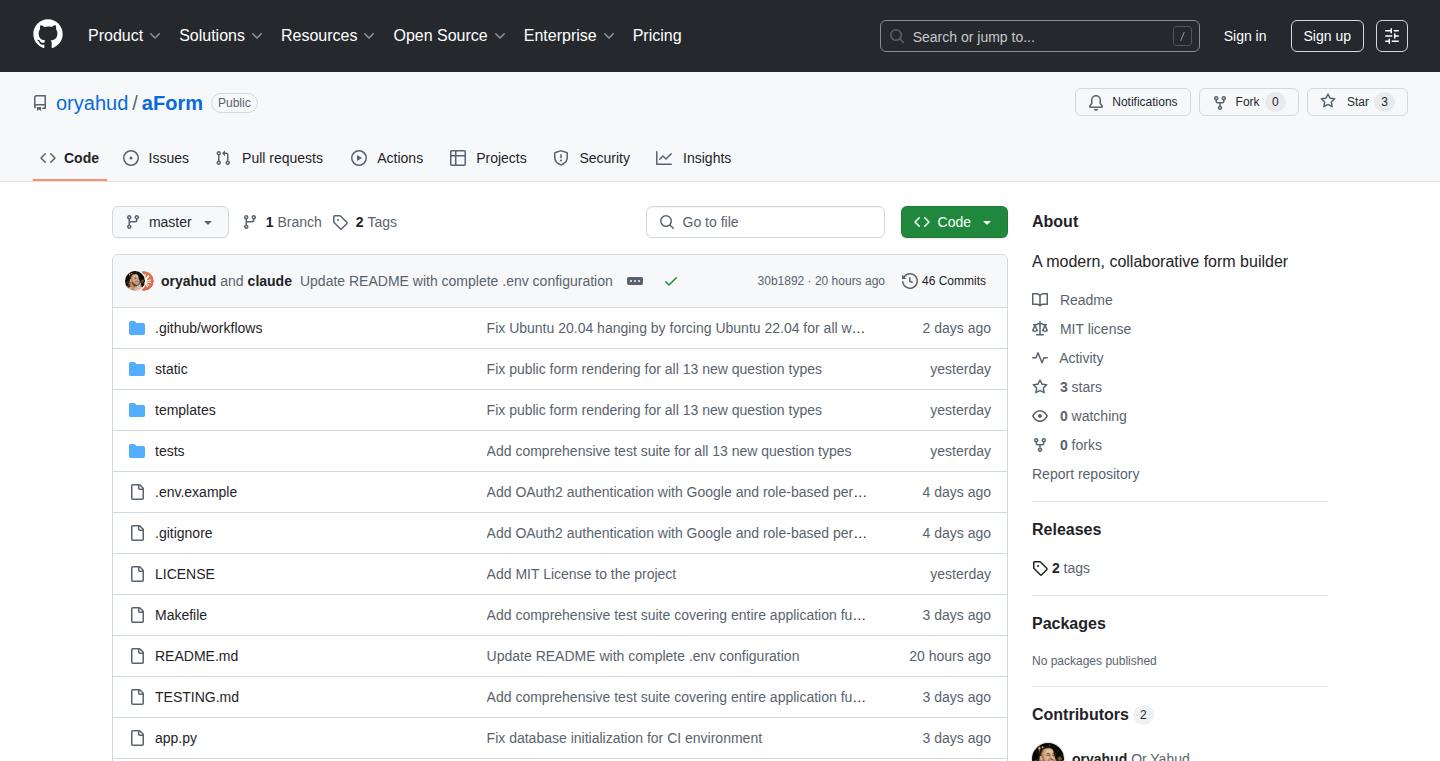
Author
oyahud
Description
FormCraft is a web-based form builder that allows developers to create custom forms easily. It stands out because it's open-source, meaning anyone can inspect, modify, and improve the code. It focuses on providing a flexible and customizable form-building experience without vendor lock-in, addressing the common issue of limited features and data control in proprietary form builders.
Popularity
Points 2
Comments 0
What is this product?
FormCraft is like a digital toolbox for building online forms. It uses a modular approach, breaking down form elements into reusable components. This means you can drag and drop different fields like text boxes, dropdowns, and file uploads to create the exact form you need. The core innovation lies in its open-source nature. This allows developers to fully control their form data and customize the builder to their specific needs, unlike closed-source form builders. So what does this mean for you? You have full control over your form data, and if you are a developer, you can modify or extend the features. It also avoids vendor lock-in, where you're stuck with a specific provider's limitations and pricing.
How to use it?
Developers can integrate FormCraft into their existing web applications by either using its built-in features or extending it with custom components. The core usage involves defining form structure using a visual interface or code (depending on the developer's preference) and then integrating the form into their web page via a simple embed code. Furthermore, since it's open-source, developers can adapt the code to integrate with different databases, authentication systems, or other services. So what does this mean for you? You can create forms tailored to your exact requirements and integrate them smoothly into your website or app, offering better control and flexibility than using ready-made solutions.
Product Core Function
· Drag-and-drop form creation: Allows users to visually design forms by arranging various form fields. This is extremely useful for quickly prototyping forms and creating user-friendly interfaces. So what does this mean for you? It drastically reduces the time and effort needed to create forms.
· Customizable field types: Supports a variety of field types like text fields, dropdown menus, date pickers, file uploads, and more. This allows developers to create forms tailored for various data collection requirements. So what does this mean for you? It enables you to collect exactly the information you need.
· Data validation and processing: Provides options for validating user input and processing the submitted data. Useful for ensuring data quality and can handle complex requirements with less code. So what does this mean for you? It helps to avoid data errors and streamline data processing.
· Open-source and extendable: The project's open-source nature allows developers to customize the functionality, integrate with other tools, and adapt it to their needs. This allows flexibility for any special feature. So what does this mean for you? You are not limited to the features provided by the original creator.
Product Usage Case
· An e-commerce website can use FormCraft to build a custom checkout form, collecting customer details and payment information. This is useful because the developer can control the data collected and maintain the security. So what does this mean for you? It empowers you to collect customer information efficiently and securely.
· A survey platform can leverage FormCraft to quickly create various survey forms with different question types and layout options. This is useful because developers can customize the survey based on each customer's need. So what does this mean for you? It speeds up the creation and deployment of surveys.
· A startup can use FormCraft to create lead generation forms on their landing pages, enabling them to collect leads and contact information from potential customers. So what does this mean for you? Enables easy lead generation and data capture.
56
SVG-to-Favicon: In-Browser Favicon Generator
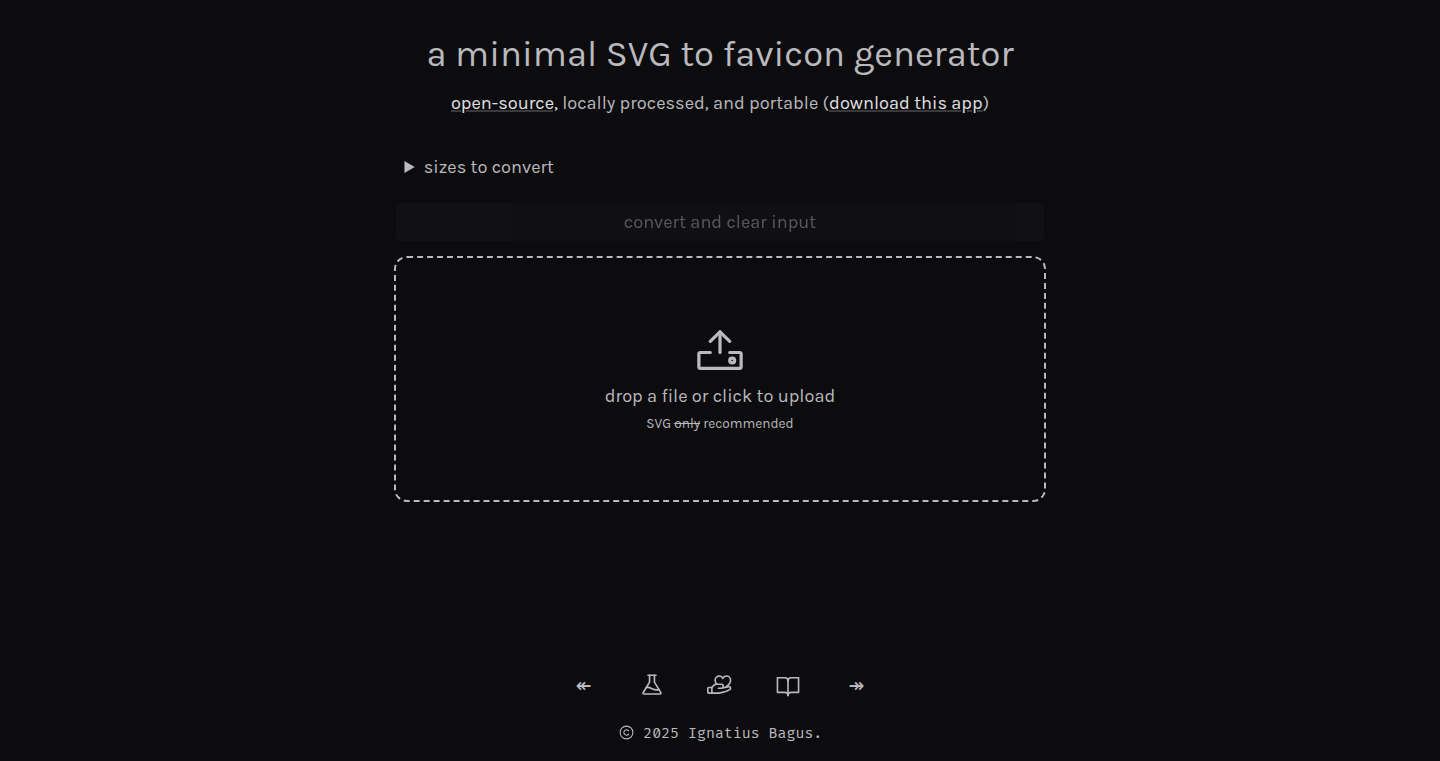
Author
ignatiusmb
Description
This project is a minimal web application that generates a complete set of favicons (the little icons that appear in your browser tab) from a single SVG (Scalable Vector Graphic) file. What's special is that it runs entirely within your web browser, meaning no data leaves your computer, and it has no external dependencies. Everything is self-contained in a single HTML file that you can download and use. This directly addresses the common need for favicon generation in web development while prioritizing user privacy and ease of use.
Popularity
Points 2
Comments 0
What is this product?
This project is a client-side, in-browser application. It takes an SVG file (a vector image format, meaning it can scale without losing quality) as input. Inside your browser, it processes this SVG and generates all the different sizes and formats needed for a complete favicon set, including those for different devices and platforms. The core innovation lies in its self-contained nature: no external server calls, no frameworks, just pure HTML, JavaScript, and SVG processing happening directly in your browser. So this is great for anyone concerned about privacy or speed.
How to use it?
Developers can use this by simply uploading their SVG file to the web app, and it generates all the necessary favicon files and the HTML code snippets to include in their website's header. You can then download all generated files, place them in your website's folder, and update the HTML header. This simplifies the often tedious process of creating and managing favicons. So this is super convenient for adding your logo to your website.
Product Core Function
· SVG Processing: Takes an SVG file as input and transforms it into various sizes for different favicon formats. This removes the need for manual resizing and format conversion.
· Favicon Generation: Generates different favicon sizes, including .ico, .png, and other formats. So this ensures your website's icon looks good on all devices and browsers.
· HTML Snippet Generation: Provides HTML code snippets to easily embed the generated favicons into a website's header. This simplifies the integration process.
· In-Browser Execution: All the processing happens in the browser, so this keeps user data private and enhances security. So this means your icon generation doesn't send any data anywhere, keeping your info secure.
Product Usage Case
· Web Developers: Quickly generate favicons for their websites, saving time and ensuring cross-browser compatibility. So this helps developers build a better user experience, without wasting time on details.
· Designers: Create favicon sets directly from their SVG designs, streamlining the workflow. So this means you can get the icons ready without the need for complicated image editing software.
· Personal Projects: Easily add favicons to personal websites and projects with minimal effort. So this is perfect for hobbyists and anyone who wants to customize their online presence.
57
ggc: Interactive Git CLI in Go
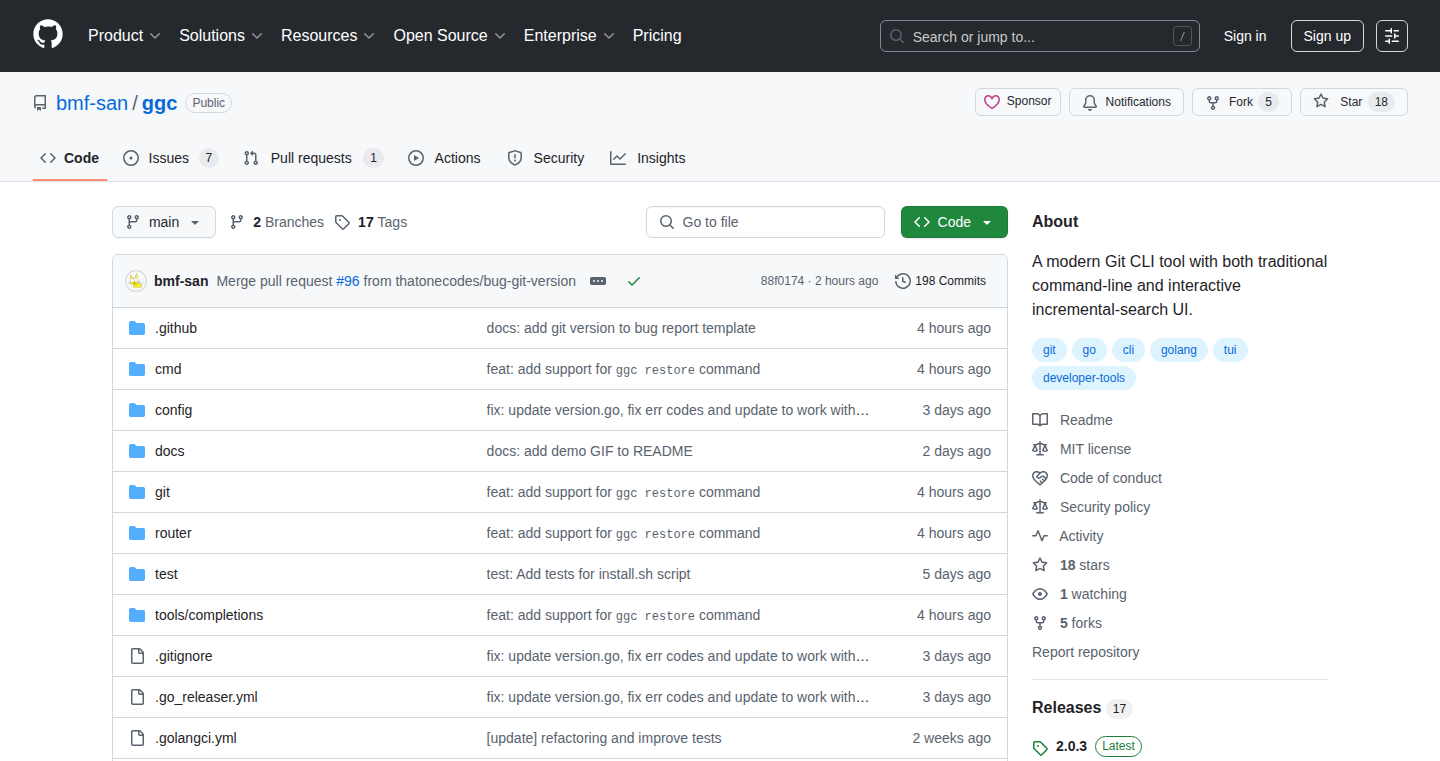
Author
bmf-san
Description
ggc is a terminal-based Git command-line interface (CLI) tool built with Go, designed to make Git operations faster and more intuitive. It combines an interactive user interface (similar to `fzf`) with traditional Git subcommands, configuration support, and built-in aliases. The core innovation lies in streamlining common Git workflows by providing a fast, interactive experience within the terminal, while also allowing for scriptable operations. So this means you can work with Git more efficiently and with less typing.
Popularity
Points 2
Comments 0
What is this product?
ggc is like a smart assistant for Git. Instead of typing out long and complex Git commands, you can use ggc's interactive UI to quickly select options (like choosing which files to add or which commits to view). It's built using the Go programming language, making it fast and efficient. It also understands your existing Git configuration, so you don't have to set everything up from scratch. So it helps you work faster by letting you interact with Git in a more visual and guided way.
How to use it?
Developers can use ggc by simply installing it and then using it in place of the regular `git` command in their terminal. For example, instead of typing `git add .` and then `git commit -m "message"`, you could use ggc’s interactive interface to select the files you want to add and then type your commit message. You can also leverage ggc's aliases, such as `ggc addcommitpush`, to automate common workflows. This can be integrated into your existing Git workflow or in scripting tasks. So you can use it as a direct replacement for git and get work done faster.
Product Core Function
· Fast Interactive UI for Git Operations: This offers a visual and streamlined way to perform actions like staging files, viewing branches, and more, often making it faster than typing out commands. So this means you can quickly find and select files and commits.
· Traditional Subcommands: ggc supports familiar Git subcommands, allowing users to use Git in the way they're used to. So you don't have to learn new commands to get your job done.
· Git-compatible Config Support: ggc reads from your existing `git config`, so it integrates seamlessly with your Git setup. So it works with how you've already set things up.
· Built-in Aliases and Workflow Automation: Provides pre-built shortcuts (aliases) to automate common Git workflows, such as adding, committing, and pushing changes. So it can help you to reduce repetitive actions.
Product Usage Case
· Development Workflow: A developer needs to commit changes. Using ggc, they can quickly add files interactively, review the changes, and then write a commit message, all from the terminal, instead of manually typing the git commands. So it takes less time to commit changes and move on to the next task.
· Automation and Scripting: A developer creates a script to automate daily tasks. ggc's ability to work with scripts allows for automating complex git processes such as creating branches, merging code and deploying them. So it allows you to automate parts of your work.
· Team Collaboration: A team uses ggc to improve their development workflow. They can agree on specific aliases and use the same git interface. So it means teams have better consistency.
58
DeepDocs: Continuous Documentation with LLM-Powered GitHub App

Author
NeelDas
Description
DeepDocs is a GitHub application that automatically keeps your code documentation up-to-date using the power of Large Language Models (LLMs). It tackles the common problem of outdated documentation by listening for code changes, identifying discrepancies between code and documentation, and proactively suggesting updates in a clean branch. This minimizes manual effort, ensures documentation accuracy, and maintains consistency across a team's documentation efforts. So, it makes sure your documentation always reflects your current code, saving you time and headaches.
Popularity
Points 1
Comments 1
What is this product?
DeepDocs leverages LLMs to understand your code and generate or update documentation based on changes. It works by integrating directly with your GitHub repository. When you commit changes, DeepDocs analyzes the code and compares it to the existing documentation. If it detects any discrepancies, it creates a new branch with suggested documentation updates. The innovation lies in its automated approach, eliminating the need for developers to manually update documentation after every code change. Instead of relying on manual prompting or complex configurations, DeepDocs proactively keeps your documentation in sync. So, you get documentation that reflects your code, automatically.
How to use it?
Developers install DeepDocs as a GitHub app, configure it for their repository, and let it run. DeepDocs automatically listens for code commits and processes the changes. It then identifies the relevant files to be updated and proactively suggests updates. Developers can then review, approve, and merge the suggested changes. The app respects the existing structure and style of the documentation, minimizing disruption. So, you simply install the app and let it do the documentation work for you.
Product Core Function
· Automated Documentation Synchronization: The core functionality is the automatic detection of code changes and the corresponding updates to the documentation, ensuring accuracy without manual intervention. So, it saves you the hassle of remembering to update your docs.
· LLM-Powered Update Generation: The use of LLMs to understand code and generate documentation updates intelligently. The app intelligently understands the code and how it should be documented. So, the documentation updates are relevant and accurate.
· GitHub Integration: DeepDocs is fully integrated with GitHub, which streamlines the process of identifying changes, proposing updates, and merging them into the main branch. So, you can easily integrate documentation updates into your existing workflow.
· Respect for Original Formatting and Structure: The app prioritizes keeping the style and structure of the existing documentation during updates, which maintains consistency and avoids disruption. So, your documentation maintains a consistent look and feel.
· Proactive Branch Creation: The app creates a clean branch with suggested updates, which ensures that changes are reviewed before merging into the documentation. So, you can safely review and merge changes.
· Minimal Human Effort: It aims at minimizing manual work by proactively suggesting updates, which reduces the need for developers to manually generate or edit documentation. So, you can focus on writing code.
Product Usage Case
· Maintaining API Documentation: If your API changes frequently, DeepDocs can automatically update the API documentation to reflect new endpoints, parameter changes, and return types. This ensures that developers using your API always have accurate information. So, your API documentation is always up-to-date.
· Updating User Guides and Tutorials: When you make changes to your software's user interface or features, DeepDocs can update the associated user guides and tutorials to reflect the new functionality. This ensures users have the correct instructions. So, your users always have the right information.
· Keeping Example Code in Sync: If your software includes example code snippets, DeepDocs can update the snippets when you make changes to the underlying code. This ensures the examples remain valid and helpful. So, your code examples always reflect your latest updates.
· Improving Team Collaboration: If a team works on a project, and different members of the team often update code in different areas, DeepDocs can automatically update the affected parts of the documentation, keeping the documentation synced across the entire team. So, it reduces the risk of documentation getting out of sync when multiple people work on the same project.
59
SynthGenie: AI-Powered Sound Design for Hardware Synthesizers
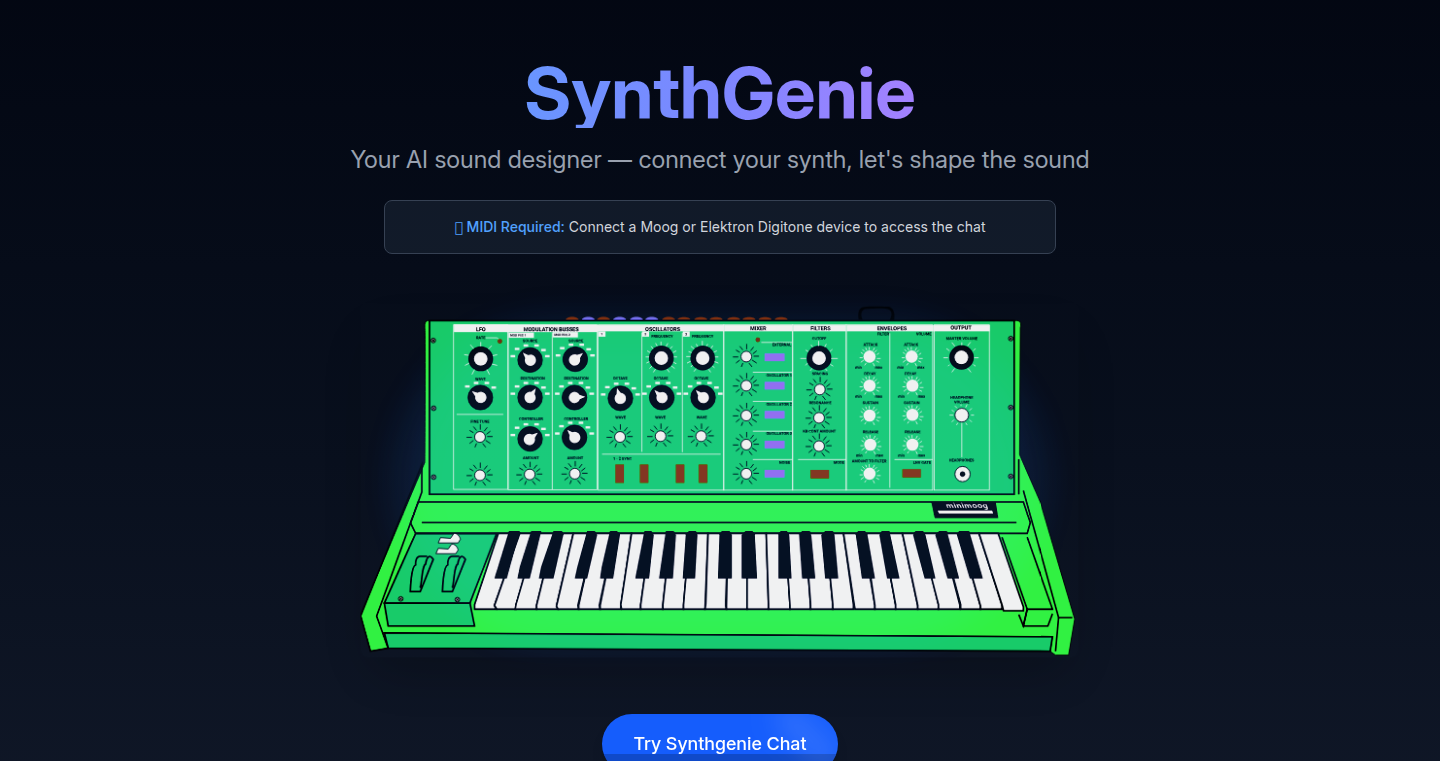
Author
serverlessmania
Description
SynthGenie is an AI-powered tool that lets you control your hardware synthesizer using natural language. Instead of fiddling with knobs and buttons, you can simply type a text prompt like "warm analog bass" or "shimmering pad" and SynthGenie will automatically adjust your synthesizer's settings in real-time. This project tackles the complex problem of sound design by making it accessible through simple, intuitive commands. It's a fascinating blend of artificial intelligence, music technology, and the open-source spirit, allowing musicians and sound designers to experiment with their instruments in a whole new way.
Popularity
Points 2
Comments 0
What is this product?
SynthGenie works by understanding your natural language requests and translating them into MIDI (Musical Instrument Digital Interface) or SysEx (System Exclusive) messages that your synthesizer understands. It uses AI to interpret your prompts (e.g., "fat bass," "bright piano") and then intelligently adjusts the parameters of your synthesizer to create the desired sound. Think of it like a smart assistant for your synthesizer. The innovative part is the integration of AI to bridge the gap between human creativity and the technical complexity of sound design. So this lets you focus on the sound you want, not the technical details.
How to use it?
Developers can use SynthGenie by connecting it to their hardware synthesizer via USB MIDI. They would then install and configure SynthGenie, and then be able to send natural language commands to the synthesizer via the application or an API. This is particularly useful for musicians, sound designers, and anyone interested in exploring sound design without needing extensive technical knowledge. The project is open source, so developers can contribute to its development, add support for different synthesizers, and integrate it into their own music production workflows.
Product Core Function
· Natural Language Processing for Sound Design: SynthGenie uses AI to understand human language prompts, allowing users to describe the sound they want in plain English. This removes the need to understand complex technical parameters, enabling more intuitive sound creation. So this makes sound design easier for everyone.
· MIDI and SysEx Control: The core functionality is its ability to translate these natural language instructions into MIDI control change (CC) messages or System Exclusive messages, which are the languages synthesizers understand. This bridges the gap between human intent and synthesizer control. So this allows you to control your synthesizer in real time without using the knobs.
· Real-Time Parameter Adjustment: SynthGenie doesn't just translate; it actively adjusts the synthesizer's parameters in real-time based on the user's prompts. This allows for immediate sound creation and experimentation. So this enables instant sound changes as you type.
· Open Source and Community Driven: The project is open-source, which fosters collaboration and allows developers to extend its functionality, add support for different synthesizers, and contribute to its improvement. So this lets you tailor the tool to your needs and contribute to its growth.
Product Usage Case
· Music Production: A musician can use SynthGenie to quickly prototype sounds for a new track. Instead of manually tweaking knobs for hours, they can simply describe the desired sound, and SynthGenie will handle the technical complexities. So you can quickly create sounds for your music.
· Live Performance: In a live performance setting, a musician can use SynthGenie to make on-the-fly sound adjustments based on their current musical needs. This adds an element of spontaneity and improvisation to their performance. So you can change sounds live, instantly.
· Educational Tool: SynthGenie can be used to teach the principles of sound design. By observing how different parameters are adjusted in response to natural language prompts, learners can gain a deeper understanding of how synthesizers work. So this helps you learn about sound design by experimenting with the software.
· Integration with Existing DAWs: Developers can potentially integrate SynthGenie with Digital Audio Workstations (DAWs) to create a more streamlined and intuitive sound design workflow. This could involve using SynthGenie as a plugin to control hardware synthesizers directly from within the DAW environment. So this lets you integrate it into your existing workflow.
60
Seal.codes: Browser-Based Content Authenticity Verification
Author
utsavanand2
Description
Seal.codes is a nifty tool that helps you verify if an image or any web content is genuinely created by the person who posted it. It avoids complex setups like blockchain and instead uses simple QR codes. The magic happens entirely within your web browser, ensuring your data remains private. It's a practical solution to the growing problem of fake content, offering a straightforward way to build trust online.
Popularity
Points 1
Comments 1
What is this product?
Seal.codes uses QR codes, much like digital wax seals, to verify the authenticity of content. When you create a piece of content, the tool generates a QR code linked to your social media accounts. Anyone can scan this QR code to confirm that the content hasn't been altered since you created it. The entire process runs within your browser, meaning your data stays private and secure. So, if someone tries to change the image or content, the seal 'breaks,' indicating it's not the original.
How to use it?
Developers can easily integrate Seal.codes into their projects. Imagine a scenario where you want to ensure the integrity of images on your website or app. You'd simply use the tool to generate QR codes for each image, linking them to the creator's profile. Users can then scan the code to verify the content's authenticity. This could also be used for verifying data integrity in other scenarios. For example, to ensure that data from different sources has not been modified.
Product Core Function
· Content Integrity Verification: The primary function is to ensure that the content has not been tampered with after it was originally created. It achieves this using QR codes that act as a digital seal.
· Browser-Based Operation: All processing happens within the user's browser. This design choice emphasizes data privacy, as the user's content is not sent to any server for processing.
· Social Account Linking: The QR codes are linked to social media accounts, allowing the user to verify that the content is associated with the original creator's profile. This provides a visual and direct connection to the source.
· Simple QR Code Generation: Easy generation of QR codes to ensure content integrity. Making verification accessible to anyone, regardless of technical expertise.
· Free to Use: The project is free, which is a big win for individual users and small businesses who can't spend on more expensive options.
Product Usage Case
· Verifying Social Media Posts: Content creators can generate QR codes for their posts, allowing followers to instantly verify that the content is from the original source. This is great for combating fake accounts and spreading misinformation.
· Authenticating Images on Websites: Website owners can add QR codes to images to prove their authenticity. Visitors can confirm that the image hasn't been edited or altered.
· Creating Trust in Digital Art: Artists can use the tool to verify the authenticity of their digital art and protect their work from copyright infringement and unauthorized use.
· Securely Sharing Documents: Businesses and individuals can use Seal.codes to ensure that documents shared online are not altered. This adds a layer of trust when sharing important information online.
· Validating Data in E-commerce: Sellers can utilize Seal.codes to prove the authenticity of the products shown online, by attaching a QR code that's tied to the information that the seller uploaded.
61
Build-A-Bookie: Decentralized Social Betting Platform

Author
vdurham22
Description
Build-A-Bookie is a social betting platform where users can create and participate in betting pools without using actual money. It focuses on creating a fun, competitive environment using leaderboards and social interaction. The innovation lies in its approach to gamified betting, addressing the ethical concerns around real-money gambling while fostering user engagement through community-driven competition. It solves the problem of providing a betting experience that avoids the risks associated with financial stakes.
Popularity
Points 2
Comments 0
What is this product?
Build-A-Bookie is a social betting platform built on the idea of leaderboards and community. Instead of real money, users compete for bragging rights and climb the leaderboards based on their predictions. The platform allows users to create their own betting pools and invite friends, providing a shared experience. Technically, the core is a scoring and ranking system based on user predictions, with tools for creating and managing betting events and visualizing the results. The innovative part is the emphasis on social interaction and gamification, creating a risk-free environment to engage in betting activities. So this allows users to have fun, compete with friends, and experience the excitement of betting without any financial risk.
How to use it?
Developers can use Build-A-Bookie to create similar social betting platforms or to integrate gamified prediction features into existing applications. This involves leveraging the core prediction and scoring mechanisms, leaderboard display, and social interaction components. The platform provides a framework that can be adapted for various contexts, from sports betting to prediction games based on real-world events. For example, developers could integrate the scoring and ranking system into a fantasy sports app, allowing users to bet against each other for fun. So this allows you to add an element of fun and competition to your apps to keep users engaged.
Product Core Function
· Betting Pool Creation: Allows users to create custom betting pools. Technical value: Provides a flexible architecture for different types of betting events, leveraging a scoring system and enabling diverse competition formats. Use case: Create betting pools for the Super Bowl or any sports events with your friends or community.
· Prediction Input: Allows users to make their predictions on events. Technical value: Implements the input mechanisms and data validation, ensuring the predictions comply with event rules. Use case: Allows users to predict game scores or other outcomes.
· Scoring and Ranking System: Calculates scores and ranks users based on their predictions. Technical value: Implements the core logic for comparing predictions with the actual results, generating user standings and facilitating competitive dynamics. Use case: Tracks users' performances and displays their rankings for public viewing.
· Leaderboard Display: Presents user rankings in a dynamic leaderboard. Technical value: Enables the visual display of rankings and integrates social components (e.g., user profiles, social sharing). Use case: Creates a competitive and engaging social element, motivating users to participate and improve their rankings.
· Social Interaction: Enables users to engage in discussions, share predictions, and interact. Technical value: Provides the mechanisms for social features, enhancing community involvement and overall engagement. Use case: Allows users to share their predictions and comments with each other, creating a social network for each betting pool.
Product Usage Case
· Fantasy Sports Apps: Integrate the Build-A-Bookie's scoring system into fantasy sports applications to enable prediction-based competitions. This allows players to bet on game results and win points or virtual rewards, adding excitement. So this will increase user engagement and provide a new revenue source for your app.
· Event Prediction Games: Use the platform's core functionalities for creating prediction games around real-world events. Implement the prediction, scoring, and leaderboard components to allow users to compete and predict outcomes. So this provides an opportunity to engage audiences with competitions and build community around your content.
· Educational Platforms: Adapt the concept for educational purposes by creating prediction-based quizzes. Users predict the answers to questions and compete against each other to gain points. So this provides an engaging environment for learning and improves the engagement with educational content.
· Community Building Tools: Use this in your existing communities by integrating the betting and leaderboards functionalities for group events. Allows your community members to have some fun competitions. So this builds community engagement.
62
Storiara: AI-Powered Video Creation from Script to Shoot
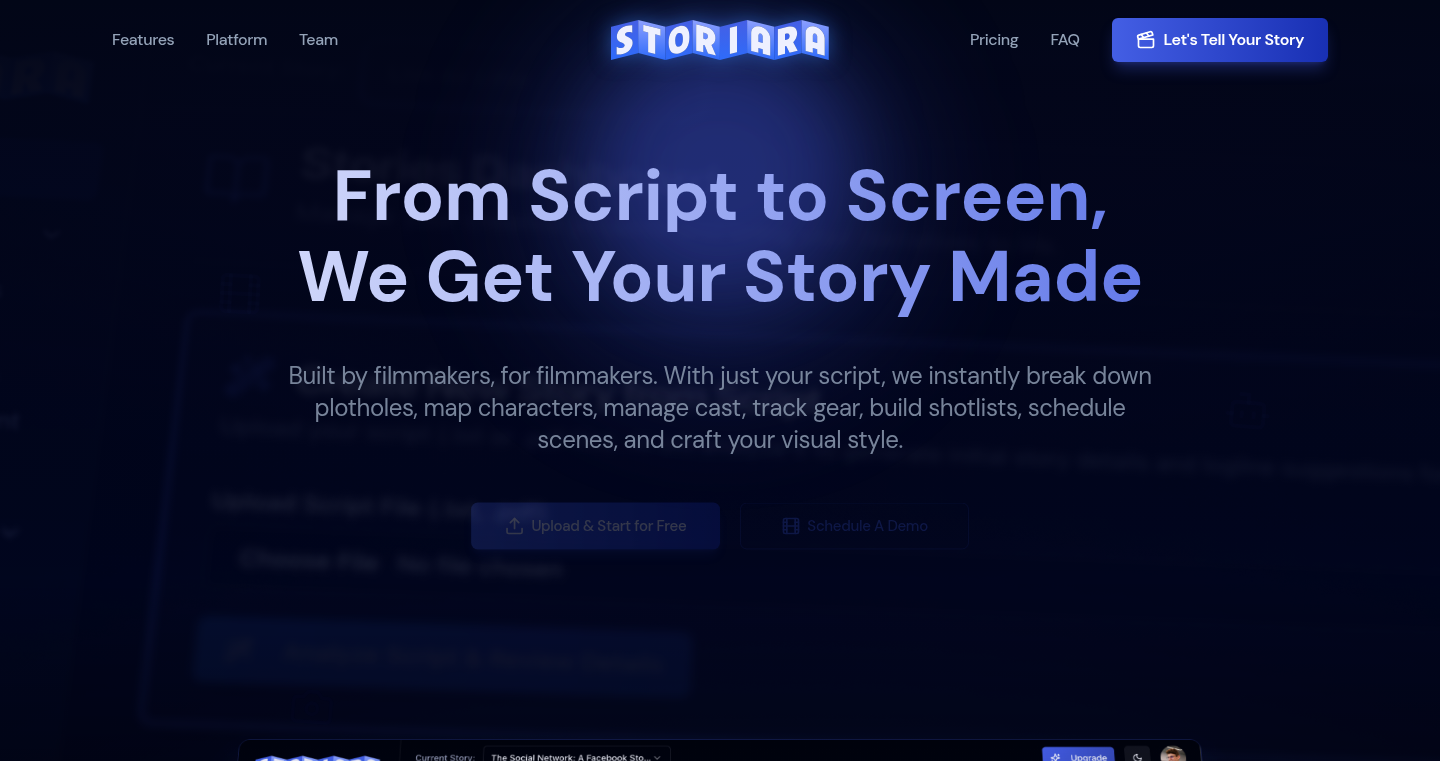
Author
nickharty
Description
Storiara is a project that uses the power of Artificial Intelligence to dramatically speed up video production. It allows users to create videos quickly by automatically generating visuals from a provided script. The core innovation is in the automated conversion of written text into a complete video, addressing the time-consuming process of manually sourcing footage, editing, and adding voiceovers. So, what's the use? It significantly reduces the time and effort required to produce video content, making video creation accessible to everyone.
Popularity
Points 1
Comments 1
What is this product?
Storiara leverages AI to transform a script into a video. It likely uses a combination of techniques: Natural Language Processing (NLP) to understand the script; AI-powered image/video generation or stock footage retrieval to create visuals that match the script's content; and text-to-speech synthesis to add a voiceover. This project showcases innovation in automating the entire video production workflow, offering a seamless experience for content creators. So, what's the use? It automates tedious tasks, enabling users to focus on their message rather than the technicalities of video creation.
How to use it?
Developers can use Storiara by providing a script as input. The system then processes the script and generates a video. Integration could involve an API or a web-based interface where users can upload scripts or write them directly. The output is a video file, ready to be shared. So, what's the use? Developers can easily generate video content for their applications, websites, or marketing materials.
Product Core Function
· Script analysis: Analyzing the provided script to identify key concepts, characters, and scenes. This is valuable because it allows the AI to understand the script's narrative structure, which is the foundation of the video.
· Visual generation/selection: Automating the process of generating or selecting the appropriate visuals (images or video clips) that match the script's content. This is valuable because it eliminates the need for manual footage sourcing or graphic design, saving time and resources.
· Text-to-speech synthesis: Generating a voiceover from the script. This is valuable because it adds the narration or voice to the video, making it more engaging and professional.
· Automated editing: Automatically assembling the generated visuals and voiceover into a complete video. This is valuable because it handles the complex editing process, saving significant time and effort.
· Output video in various formats: Allowing users to export the generated video in different resolutions and formats for various platforms. This is valuable because it ensures compatibility across different devices and platforms.
Product Usage Case
· Content creators using Storiara to quickly produce marketing videos for social media campaigns, demonstrating product features or company updates. This addresses the challenge of creating engaging video content without requiring extensive video editing skills.
· Educators using Storiara to transform written lesson plans into interactive video lectures. This solves the problem of creating engaging educational material quickly and efficiently.
· Businesses utilizing Storiara to create explainer videos for their products or services, simplifying complex information. This addresses the need for clear and concise communication through visual storytelling.
· Developers integrating Storiara's API into their applications to allow users to create videos directly from their platforms. This can be used for applications that need to generate dynamic video content, like news aggregators or personalized learning platforms.
63
Mocksmith.dev - Relational Data Weaver
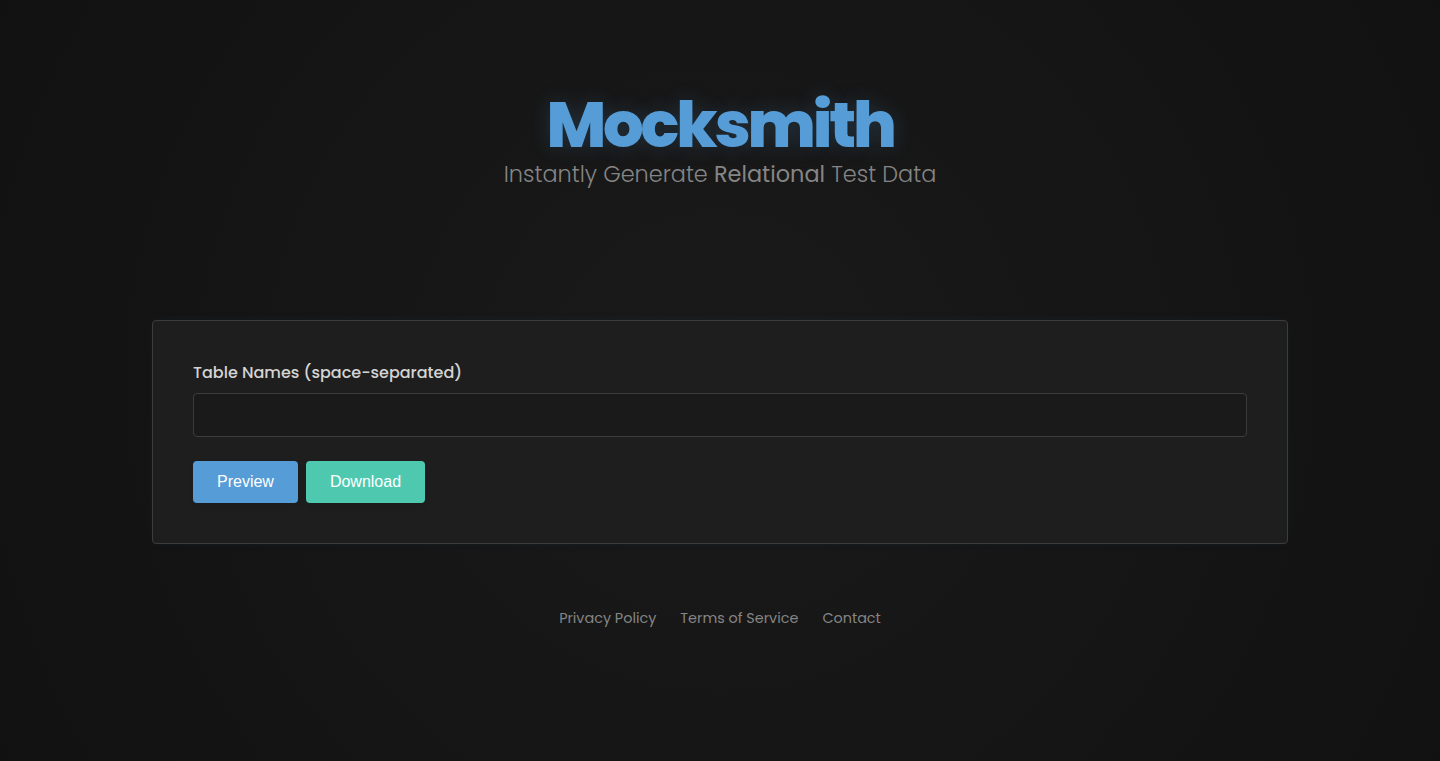
Author
mllev
Description
Mocksmith.dev is a tool that instantly generates relational test data. The core innovation lies in its ability to understand relationships between different data entities (like users, orders, and products) and automatically create consistent, realistic, and varied mock data based on those relationships. This solves the common problem of developers spending excessive time manually creating or maintaining test datasets, leading to faster testing cycles and more reliable software.
Popularity
Points 1
Comments 1
What is this product?
Mocksmith.dev is like a data factory for your testing needs. Instead of manually crafting fake data for your applications, you define the structure of your data (e.g., tables, columns, data types) and how different pieces of data relate to each other. Mocksmith.dev then intelligently generates a whole bunch of fake, but realistic, data that fits your specifications. The innovation is in the automated understanding and generation of relational data, making it much easier to simulate complex data scenarios for testing. So, what's in it for you? Save time and effort by not having to manually create test data, leading to quicker testing and more confidence in your software.
How to use it?
Developers can use Mocksmith.dev by first defining their data models – the structure of their tables and the relationships between them. They can specify data types, constraints, and the desired volume of data. Then, they can use a simple API or command-line interface to request the generation of test data. This data can then be directly imported into their testing environments or used in any other scenario that requires realistic data. Imagine you're testing an e-commerce platform; you can easily create a large dataset of users, products, orders, and reviews, all interconnected in a realistic way, without the tedious manual work. This facilitates comprehensive testing of different user scenarios, making sure everything works well.
Product Core Function
· Relational Data Generation: Generate data that respects relationships between different entities (e.g., a user having multiple orders). This allows for more realistic data scenarios. So what? It's great because you can test your app's relationships between different data elements.
· Data Type and Constraint Support: Understand and generate data according to specified data types (e.g., numbers, strings, dates) and constraints (e.g., unique values, ranges). This ensures the data is valid and fits the application's needs. So what? You can make sure your data is in line with your existing databases or systems.
· Customizable Data Volume: Generate any volume of data needed, from small test datasets to large datasets for performance testing. This allows scaling your testing. So what? You can ensure your system performs correctly, whether there are a few users or thousands.
· Data Variety: Generate diverse data, not just repetitive values. This helps cover more testing scenarios. So what? You can ensure your app can handle different cases.
Product Usage Case
· Testing an E-commerce Platform: Generate a large dataset of users, products, orders, and reviews, linked realistically. Testing the platform's functionalities, like order processing and product recommendations, can be done efficiently. This solves the problem of needing lots of data. So what? This enables quicker testing and better results.
· Testing a Social Media Application: Simulate a large number of users, posts, and comments with varying interactions. Test performance and scalability. This allows for comprehensive testing of features like feeds. So what? You'll have more confidence knowing that the platform can handle lots of users and data.
· Developing a CRM System: Create fake data to showcase customer interactions, deals, and support cases to demonstrate the system’s functionality. So what? You will be able to demonstrate a new system without exposing real data.
· Performance Testing of a Database: Populate a database with a substantial amount of data and then test the query performance. It facilitates testing different aspects of a database. So what? This way you can test how fast your database performs.
64
Tech Debt Game - Deadline Driven Language Launch
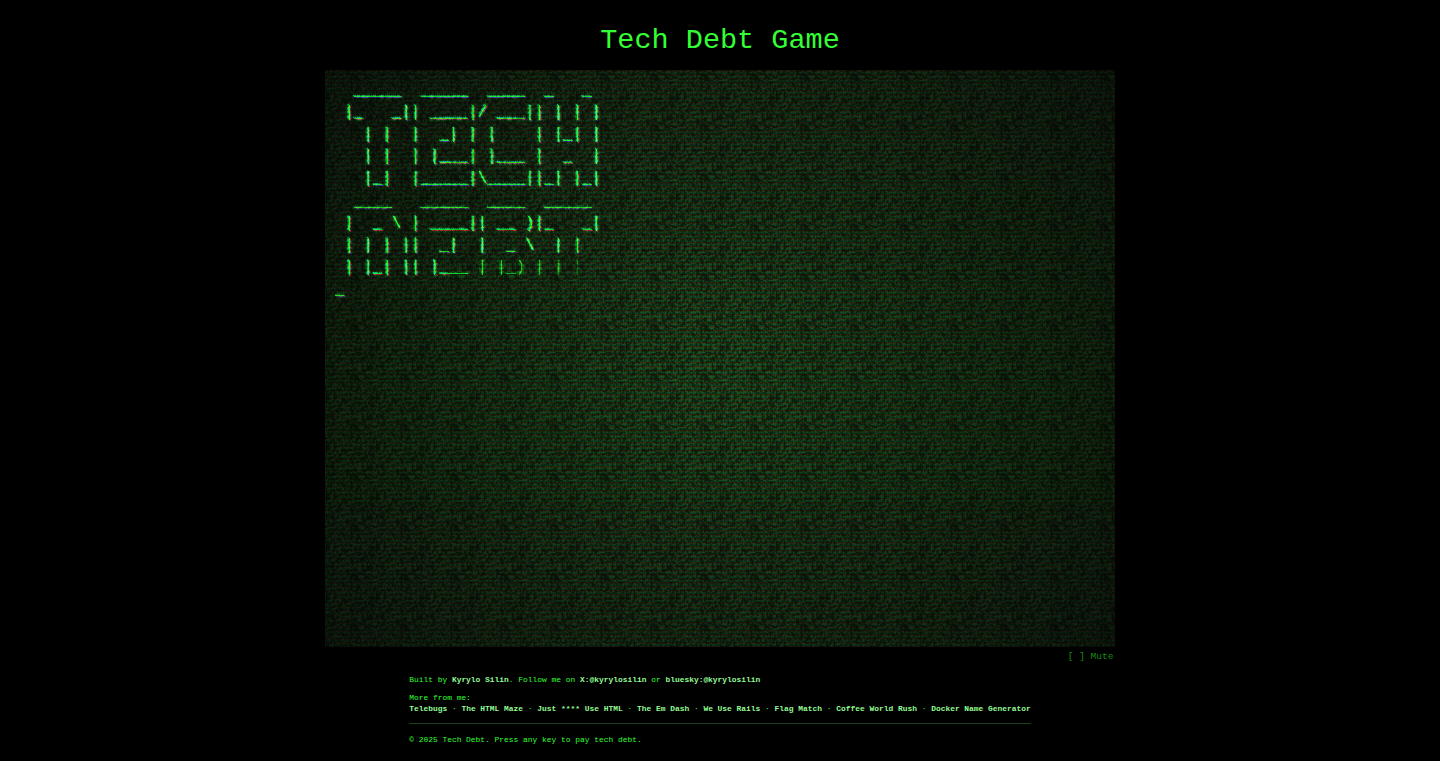
Author
kyrylo
Description
This project introduces a game where players, acting as developers, race against a deadline to launch a programming language. The innovative aspect lies in simulating the accumulation of "tech debt" – the inevitable compromises made during rapid development. Players make choices affecting code quality, feature completeness, and future maintenance costs, all while battling the clock. It addresses the challenge of balancing speed and quality in software development, a common struggle in real-world projects.
Popularity
Points 2
Comments 0
What is this product?
It's a game that simulates the pressures of launching a programming language under a tight deadline. Players face choices that impact code quality, feature richness, and future work needed (tech debt). The innovation lies in making the concept of tech debt tangible and influencing the players decision making, simulating the difficult choices developers have to make.
How to use it?
You play the game as a web app. It's a simulation, so you interact with choices and consequences. You don't necessarily 'use' it in your day-to-day coding. The game is designed to teach the impact of technical debt on a project in the long run, helping developers to make better choices in their real projects. The game itself is not a tool to be integrated, but a learning experience to inform development practices.
Product Core Function
· Deadline Management: Simulates the pressure of time constraints and forces players to make rapid decisions, understanding the impact of rushed development. This teaches the importance of prioritizing tasks.
· Tech Debt Simulation: Represents the accumulation of technical debt through player choices. Each choice adds to the project's complexity and future maintenance costs, highlighting the risks of poor code quality.
· Feature Prioritization: Players have to decide which features to implement, simulating the trade-off between features and time constraints. This teaches the importance of prioritizing critical features and postponing optional ones.
· Resource Allocation: Allows players to assign resources (developers, time) to different tasks, like refactoring or new feature implementation. Shows the importance of resource planning and project management.
· Risk Assessment: The game makes it clear how certain choices lead to higher risks of bugs, late release dates, and technical issues. This teaches developers to understand the risks of shortcuts.
Product Usage Case
· Understanding Project Trade-offs: The game helps developers understand the trade-offs between quick wins and the long-term health of a software project. This knowledge can be applied when planning and executing real-world projects.
· Improving Code Quality Discussions: The game can be used to highlight how poor code quality and technical debt affect project timelines and budgets, allowing better planning and communication within the team.
· Better Project Management: Players learn to make better decisions on resource allocation, feature selection, and risk management during the development process.
65
Endor: Linux Sandboxes in Node.js
Author
ridruejo
Description
Endor lets you run a tiny, isolated version of the Linux operating system directly inside your Node.js environment. This is achieved using WebAssembly (Wasm), a technology that allows code written in languages like C or Rust to run in web browsers and other environments, including Node.js. The project focuses on creating ephemeral (temporary) and sandboxed Linux instances, which means they are quickly created, used, and then discarded without affecting your main system. This is useful for quickly testing code or running commands without the risk of messing up your development setup.
Popularity
Points 1
Comments 1
What is this product?
Endor creates a miniature Linux environment inside Node.js. It leverages WebAssembly to run a lightweight Linux distribution, such as Alpine Linux. The key innovation is the ability to launch these sandboxed Linux instances quickly, typically within seconds. The project addresses the problem of needing a safe and isolated environment to test software or run commands without affecting the host system. So, if you need a safe place to experiment with commands or test new software, this is for you.
How to use it?
Developers can use Endor through the command line. They can create and interact with a sandboxed Linux instance using a simple command, such as `npx -y u/endorhq/cli@latest run alpine --shell --allow-net`. This command downloads the necessary components and launches an Alpine Linux instance with network access and a shell for interaction. The integration is straightforward – developers invoke the Endor command from their terminal. So, you can use this tool to easily test and play with different software without any risk of affecting your main system.
Product Core Function
· Ephemeral Linux instances: The ability to create temporary Linux environments. These instances are designed to disappear once you're done with them. This prevents any unwanted changes to your main development setup. So, if you need to test a script quickly, this is what you need.
· Sandboxed environment: The Linux instances run in isolation, meaning any changes made within the instance don't affect your main system. This provides a safe place to test code. So, if you are worried about messing up your system with testing, use this.
· WebAssembly (Wasm) based: The core technology relies on Wasm to run Linux inside Node.js. While slower than native execution, Wasm offers cross-platform compatibility. So, this lets you create a sandbox that works across different operating systems.
· Networking support: Allows the Linux instances to access the network. This is useful for testing applications that rely on internet connections. So, if you need to test network connectivity in your isolated environment, this is perfect for you.
· Quick startup: These Linux instances can be started in a few seconds, which is important for rapid testing and iteration. So, if you want to quickly test something, this gives you the ability to do it.
Product Usage Case
· Testing scripts: Developers can quickly test shell scripts in an isolated environment before running them on a production server. For instance, a developer can use Endor to test a script that downloads files or configures settings without fear of affecting their primary system. So, if you want a safe testing ground for your scripts, this is a great choice.
· Exploring Linux commands: Endor provides a safe space to try out Linux commands that developers might be unfamiliar with. This is particularly useful for developers learning Linux or exploring new tools. So, if you're learning Linux commands, it helps you to avoid the risk of accidentally messing up your main computer.
· Software compatibility testing: Developers can use Endor to test the compatibility of their software on different Linux distributions or versions. This helps ensure that the software works correctly in various environments. So, if you want to be sure your software is compatible across different systems, this is the right choice.
· Security research: Security researchers can use Endor to safely analyze and test software. This means they can test malicious software inside a safe environment. So, if you need a safe way to analyze software, this tool gives you the ability to do it.
66
MockupGenius: Automated Mockup Generation with Next.js and Fabric.js
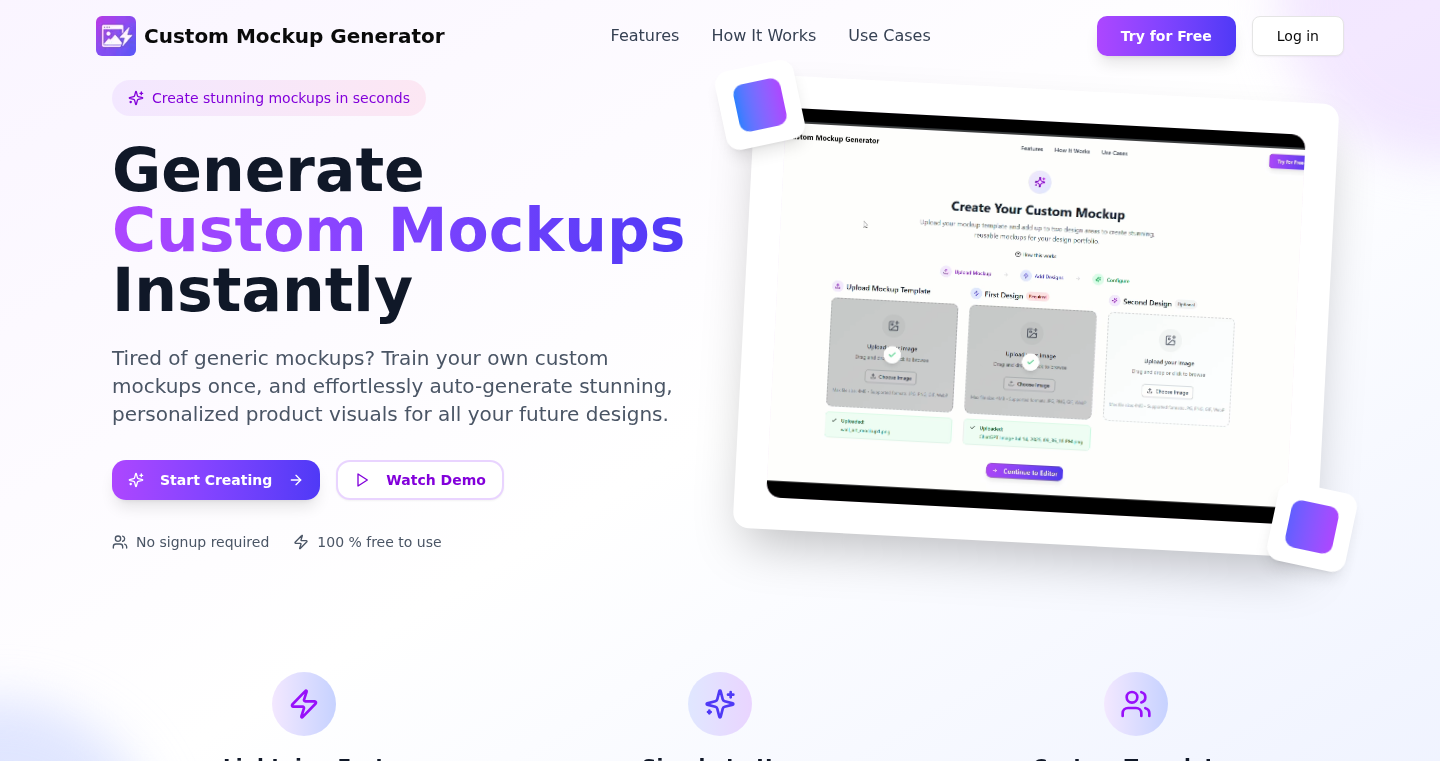
Author
curiouspradhyum
Description
MockupGenius is a free tool designed to automatically generate product mockups, eliminating the need for complex software like Photoshop. It simplifies the process by allowing users to 'train' the tool with a single design placement on a mockup template. Subsequently, it auto-generates mockups for new designs, maintaining the same layout. The project is built using Next.js for the front-end and Fabric.js for drag-and-drop design placement. So this is perfect for quickly creating professional-looking mockups for various products.
Popularity
Points 1
Comments 0
What is this product?
MockupGenius leverages the power of Next.js and Fabric.js to automate the creation of product mockups. The core innovation lies in its 'training' mechanism: users place their design once on a mockup template, and the tool learns the layout. This eliminates the need to manually place designs on various mockups for each new product. This is similar to teaching a computer to recognize patterns – once it learns the pattern, it can replicate it automatically. Fabric.js provides the necessary tools for handling the drag-and-drop functionality, making the design placement user-friendly. So this project allows for rapid iteration of product presentations, saving time and effort.
How to use it?
Developers can use MockupGenius by uploading their designs and selecting a mockup template. They then place their design on the template, essentially 'training' the tool on the layout. Afterward, when new designs are uploaded, the tool automatically generates mockups using the learned layout. This is particularly useful for product designers, e-commerce businesses, and anyone needing to quickly visualize products in various mockups. The integration is straightforward: users simply upload their designs and utilize the drag-and-drop interface provided by Fabric.js. So you can quickly showcase your products without extensive design skills or software knowledge.
Product Core Function
· Automated Mockup Generation: The core functionality is the automated creation of product mockups. After the initial design placement (the 'training' phase), the tool generates mockups for new designs using the same layout. This is invaluable for quickly visualizing products.
· Drag-and-Drop Design Placement: Fabric.js facilitates an intuitive drag-and-drop interface, allowing users to easily position their designs within the mockup template. This feature simplifies the design placement process and makes the tool user-friendly, which is good for anyone without expert design experience.
· Template Management: The tool supports the use of various mockup templates, allowing users to choose the best presentation style for their product. This flexibility enables users to tailor the presentation to their specific needs, greatly increasing its value.
· Layout Learning: The 'training' mechanism, where the tool learns the design layout from the initial placement, is an innovative approach that saves time and effort compared to manual mockup creation. It efficiently processes information and replicates it quickly.
Product Usage Case
· E-commerce Product Visualization: An online store selling t-shirts can use MockupGenius to generate a variety of mockups showcasing their designs on different shirt styles and colors. This allows customers to see what a design looks like on an actual product. So, this tool can increase customer engagement and sales.
· Graphic Design Portfolio: A graphic designer can use MockupGenius to display their designs on various products, such as posters, phone cases, or mugs, to enhance their portfolio and impress potential clients. This is perfect for self-promotion.
· Print-on-Demand Services: Businesses offering print-on-demand services can leverage MockupGenius to create product mockups quickly and easily, allowing them to offer a wide range of products without the need for physical samples. This boosts efficiency and product variety.
· Marketing Campaigns: Marketing teams can use MockupGenius to visualize product designs in various marketing materials, such as social media posts or website banners, creating appealing visuals that can enhance the effectiveness of their campaigns. This tool helps draw more attention to products.
67
AutoSlides: Instant Visual Marketing Slideshow Generator

Author
Haris1245
Description
AutoSlides is a tool designed to automatically generate engaging slideshows optimized for TikTok marketing, specifically for B2C app developers. It solves the problem of repetitive and time-consuming content creation by allowing users to quickly create slideshows from text and images, or even repurpose existing slideshows. The core innovation lies in automating the creation of this visual content, making it easy to drive app downloads and revenue. So this is useful because it saves you time and effort in creating marketing materials.
Popularity
Points 1
Comments 0
What is this product?
AutoSlides works by taking either text and images, or the link to an existing slideshow as input. It then intelligently generates a new slideshow, automating the process of formatting and layout. This streamlines content creation for platforms like TikTok, where visual slideshows are highly effective for marketing. So it's an automated slideshow creator that reduces the time it takes to create engaging marketing content.
How to use it?
Developers can use AutoSlides by providing the tool with text and images related to their app, or by giving it a link to another slideshow. The tool then generates the slides automatically, which can be downloaded and uploaded to TikTok or similar platforms. It integrates directly into the marketing workflow, saving time and effort. So you can use this to automatically create promotional content for your apps.
Product Core Function
· Automated Slideshow Generation: The core function is to automatically create slideshows from text and images, saving considerable time compared to manual creation. This is useful because you don't have to manually create each slide.
· Existing Slideshow Repurposing: Users can provide a link to an existing slideshow, and AutoSlides will adapt its style and layout. This allows for efficient repurposing of successful content. So if a previous slideshow works, you can use it as a base and make it even better.
· Optimized Format for TikTok: The tool is designed to generate slideshows specifically for the TikTok platform, optimizing for visual appeal and engagement, increasing the effectiveness of the content. This is helpful because it is already optimized for the most popular platform.
· Ease of Use: AutoSlides provides a simple and intuitive interface, allowing users to quickly create slideshows without requiring advanced design skills. You don't need to be a designer to create engaging slideshows.
Product Usage Case
· App Developers driving downloads: App developers can use AutoSlides to create visually appealing slideshows showcasing the features and benefits of their apps, driving downloads and revenue through TikTok marketing campaigns. It helps boost visibility on TikTok.
· Marketing Agencies: Marketing agencies can use AutoSlides to quickly create a variety of slideshows for multiple clients, accelerating content production and enhancing their marketing service offerings. It makes it easier for marketing agencies to manage content.
· Content Creators: Individuals and content creators can utilize AutoSlides to produce visually engaging content, expanding their reach and audience engagement on TikTok. It assists with content creation for personal use.
68
Notetube: AI-Powered Structured Learning for YouTube

Author
AzharKhann
Description
Notetube is a platform that transforms how you learn from YouTube videos. It leverages AI to organize your learning, generate detailed notes and summaries, create quizzes, and offer instant support. It solves the problem of scattered knowledge and passive learning that often comes with unstructured online video consumption. So, it provides a structured, active, and engaging learning experience, helping you retain information better.
Popularity
Points 1
Comments 0
What is this product?
Notetube uses a combination of organizational tools and AI to create a structured learning system. The organizational layer allows you to build structured collections based on topics or courses. The AI layer automatically generates detailed notes (more than 3000 words for an hour of content), summaries, identifies key moments with timestamps, generates quizzes for retention testing, and provides a chat interface for instant help when concepts aren't clear. The core technology is Natural Language Processing (NLP) and Machine Learning (ML) to understand the video content and extract relevant information. So, this provides a comprehensive learning experience, similar to having a tutor and note-taker all in one.
How to use it?
Developers can use Notetube to learn new technologies, frameworks, or coding languages from YouTube tutorials. They can create a structured learning path, generate detailed notes for each video, and use quizzes to reinforce their understanding. The platform integrates with YouTube, and after logging in, the developer can simply paste the video link into Notetube to start the AI-powered learning process. So, developers can quickly digest complex topics and accelerate their learning curve.
Product Core Function
· Structured Learning Collections: Users can organize YouTube videos into collections by topic, course, or skill, providing a clear learning path. This helps users to create a personalized learning environment, easily follow and track the progress of the courses they are interested in, and enhance long-term knowledge retention. This is useful for any user that wants to follow a particular skill path, without the need to browse through different playlists.
· AI-Generated Notes & Summaries: The AI automatically generates detailed notes and summaries for each YouTube video, saving users the effort of manual note-taking. This function makes the entire learning experience much more efficient, as users can get an overview of any video in a matter of seconds, and focus on key concepts quickly. This also reduces the time spent on rewinding and pausing the video.
· Timestamped Key Moments: Notetube identifies key moments within the video with timestamps, allowing users to quickly jump to important sections. The ability to quickly understand the core concepts, and quickly rewind to the most relevant parts of the video saves users time and allows them to focus on their specific learning needs. This is especially useful for complex topics, where users may want to revisit certain parts of the video multiple times to reinforce understanding.
· Personalized Quizzes: The platform generates quizzes to test users' retention of the content, providing a way to assess understanding and identify areas for improvement. This reinforces learning and helps users to actively engage with the material. This is critical for long-term information retention, since users are incentivized to review their understanding.
· AI Chat Interface: A chat interface provides instant help when concepts aren't clear, allowing users to ask questions and get immediate answers. This helps the users quickly clarify their understanding, and allows for a smoother learning process. This enables the user to resolve problems and receive the answers they are looking for in a more direct and quick manner.
Product Usage Case
· Learning a New Programming Language: A developer can use Notetube to learn Python from YouTube tutorials. They can create a collection for Python, import the videos, and use the AI-generated notes and quizzes to reinforce their understanding of the language concepts. So, this helps developers to reduce the time they need to learn a new language, and better understand it.
· Understanding a Technical Concept: A software engineer struggling with a complex topic like 'Asynchronous Programming' can use Notetube. They can input YouTube videos explaining the concept and utilize the AI-generated notes, summaries, and quizzes to gain a better grasp of the subject matter. This allows them to easily absorb difficult information and understand challenging technical subjects.
· Preparing for a Certification Exam: A developer can use Notetube to prepare for a certification exam by creating a collection of videos related to the exam topics and using the quizzes and notes to study. So, this helps users to efficiently revise the content and enhance exam preparation.
69
r/codeforcrypto: A Community for Developers Seeking Crypto Payments
Author
cranberryturkey
Description
This project is a new subreddit (r/codeforcrypto) designed for software engineers and developers who are interested in getting paid in cryptocurrency. It addresses the growing need for developers to directly benefit from the value they create, especially in the decentralized space. The key innovation is providing a dedicated platform where developers can showcase their projects, find freelance gigs, collaborate, and discuss ideas, all within an ecosystem that embraces crypto payments. This tackles the problem of traditional payment systems and intermediaries, enabling developers to own the value of their work.
Popularity
Points 1
Comments 0
What is this product?
This is a dedicated online forum on Reddit. It's a digital meeting place specifically tailored for developers who are passionate about cryptocurrency and prefer to be compensated in crypto. Instead of traditional payment methods (like bank transfers), developers can use crypto like Bitcoin or Ethereum for their work. The platform facilitates discussions, project sharing, and job opportunities centered around this crypto-centric workflow. So, it's a place to learn, connect, and find work opportunities within the cryptocurrency ecosystem. This offers an alternative to the standard payment systems.
How to use it?
Developers can use this subreddit to showcase their projects by posting links and descriptions. They can also actively seek out freelance opportunities by posting their skills and availability, or browse job listings posted by other community members. Furthermore, developers can engage in technical discussions, share code snippets, and seek help from others within the community. To participate, a developer just needs a Reddit account and an interest in cryptocurrency. This allows developers to take charge of their earnings, avoiding intermediaries, and embracing the future of finance.
Product Core Function
· Project Showcasing: Developers can post details of their projects, including code repositories and demos. This allows them to get feedback, attract potential collaborators, and build their professional brand. So this is useful for developers who want to promote their work and find partners.
· Freelance and Job Board: The subreddit facilitates the matching of developers with crypto-paying clients. This provides a dedicated space to find projects or hire developers, bypassing traditional job boards and payment processes. So this is useful for developers who want to find work and get paid in crypto.
· Technical Discussions: Developers can discuss technical challenges, share solutions, and learn from others in the community. This promotes knowledge sharing and accelerates learning in the crypto development space. So this is useful for developers who want to collaborate and improve their skills.
· Networking and Collaboration: Developers can connect with like-minded individuals to form teams, find mentors, and explore new ventures. This encourages collaboration and expands the network of developers. So this is useful for developers who want to connect with each other.
· Crypto-Specific Projects: The platform fosters the creation of crypto-related projects, including blockchain applications, decentralized finance (DeFi) tools, and other innovative crypto-based solutions. So this is useful for developers who are building crypto applications and projects.
Product Usage Case
· A developer builds a decentralized finance (DeFi) application and showcases it on r/codeforcrypto. Other developers provide feedback, contributing to bug fixes and improvements. The developer then finds a freelance contract to implement a new feature for another DeFi project, getting paid in Ethereum. So this is useful for developers who want to build DeFi applications and get paid in crypto.
· A front-end developer looking for crypto-based projects posts their skills and availability. A blockchain startup hires the developer to build the front-end interface for a new token launch platform, paying them in Bitcoin. So this is useful for developers who are looking for frontend projects or want to be hired in crypto.
· A developer encounters a technical challenge while building a smart contract. They post a question to the subreddit, and other community members provide solutions and guidance, leading to a more secure and efficient smart contract. So this is useful for developers who want to learn more about smart contracts.
· A group of developers collaborate on a new open-source tool for crypto trading, using r/codeforcrypto to coordinate and share code. They successfully launch the tool and attract users, helping them build their reputations in the crypto community. So this is useful for developers who want to collaborate to build new open-source tools.
· A developer is looking to hire a Solidity expert to assist in auditing their new smart contract. They create a job posting on r/codeforcrypto, specifying the salary will be paid in DAI. This enables them to find a suitable candidate within the developer community. So this is useful for developers who want to hire Solidity experts for crypto projects.
70
Memno: Your AI Chief of Staff with Isolated Memory
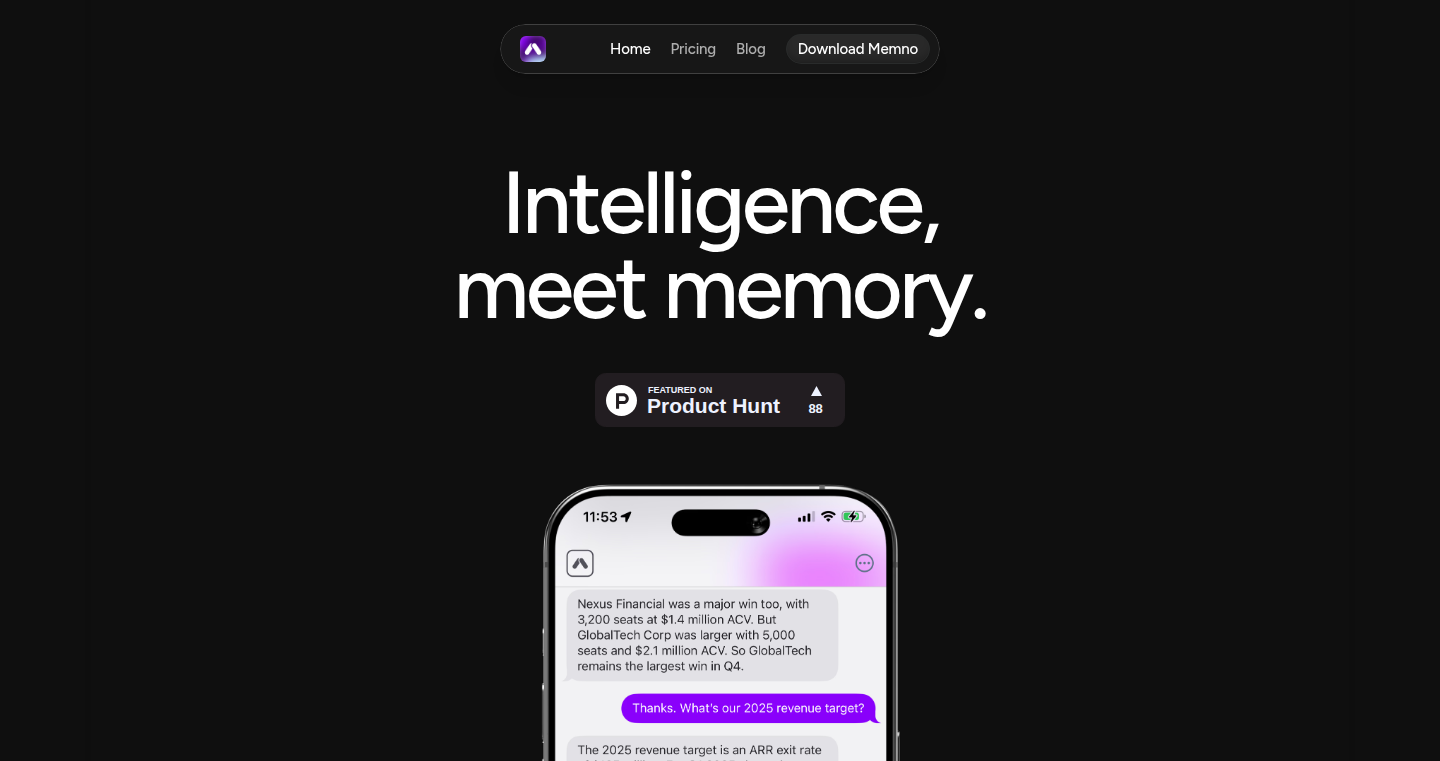
Author
blaget
Description
Memno is an AI assistant designed to remember everything you share – photos, documents, voice notes – and make it searchable. The key innovation lies in its secure, isolated environment for each user, ensuring data privacy. It uses advanced techniques like vector search (very fast way to find similar things) and a document processing pipeline for OCR, transcription, and summarization. This lets you ask questions like "What did we decide about Q4?" and get instant answers from all your shared data. So this means you get a powerful AI assistant that remembers everything, without compromising your privacy.
Popularity
Points 1
Comments 0
What is this product?
Memno is essentially a personal AI assistant with a super-powered memory. It works by taking all the information you feed it – photos, documents, audio – and turning it into searchable knowledge. It does this by using a combination of technologies. First, it uses a document processing pipeline to extract information from the content. Then, it uses a vector database, which is a very fast way to search for similar information, allowing you to quickly find what you need. Finally, it provides complete data isolation. Each user gets their own dedicated and isolated environment with encrypted storage, making sure your data stays private. So this means you get all the benefits of AI without the risks to your privacy and security.
How to use it?
Developers can leverage Memno's core technology for various applications. For instance, they can integrate the vector search capabilities into their own search systems for faster and more relevant results. They can also utilize the document processing pipeline to build applications that need to extract information from different types of content, such as a content management system that can automatically summarize documents, or a note-taking app that can find relevant information in your notes. Or, they can use it as a foundation for more complex AI-powered tools. So this means developers can build smarter and more efficient applications with Memno's technologies.
Product Core Function
· Complete data isolation per user: Each user's data is stored in its own separate environment, encrypted and isolated. This guarantees privacy and security. So this means your data is protected from unauthorized access.
· Sub-50ms vector search: Using vector databases to enable lightning-fast similarity search. So this means you can find information quickly, even across large datasets.
· Document processing pipeline: Automatically processes documents, including OCR (Optical Character Recognition, reading text from images), transcription, object recognition, and summarization, before vectorization. So this means you can search and retrieve information from any type of document or media file.
· Distributed AI calls: The AI calls are distributed, meaning no single provider sees all of your data, which enhances privacy. So this means you are shielded from potential data breaches and privacy risks.
Product Usage Case
· A legal professional could use Memno to quickly search through all their case files, documents, and voice notes to find relevant information for a specific case. Memno's fast search capabilities, powered by vector search, can significantly reduce the time spent on legal research. So this means they can save time and be more productive.
· A researcher can use Memno to organize and search through a vast collection of research papers, notes, and data. The document processing pipeline can automatically extract important information and create summaries, and the vector search can help find related concepts across different papers. So this means they can accelerate their research process.
· A business executive can use Memno to keep track of all their important meetings, emails, and documents. They can quickly find key decisions, action items, and follow-up tasks by asking simple questions. So this means they can be more organized and stay on top of their workload.
71
MCP Project Manager: Structured Project Management for AI-Assisted Coding
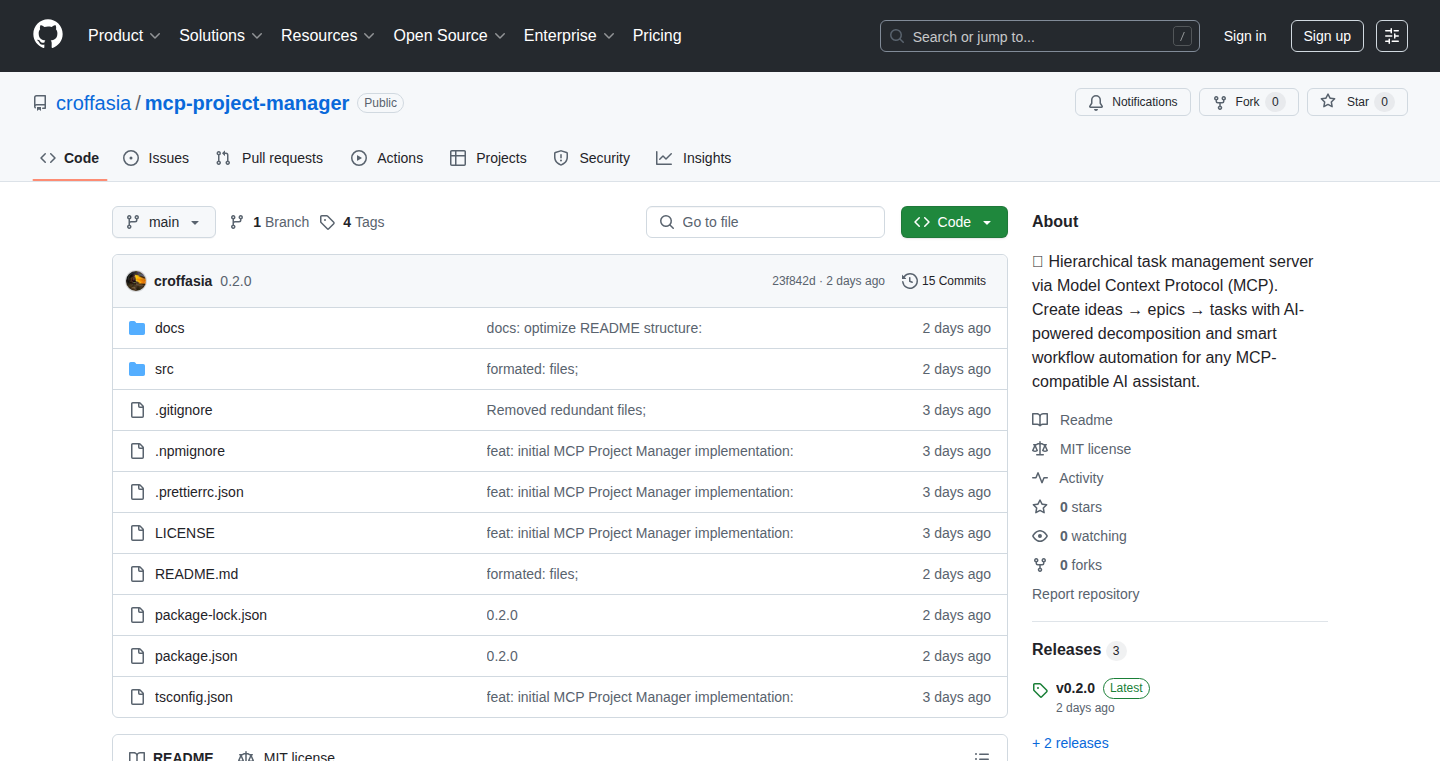
Author
Croffasia
Description
This project integrates AI assistants with your code editor to give them a deep understanding of your project's structure. It uses a 'Model Context Protocol' to let the AI understand how your ideas, epics, and tasks are organized, leading to more focused and relevant code suggestions. It tackles the problem of AI code generators producing code that lacks context and potentially creates chaos. It provides a natural language interface and a CLI dashboard for project visualization, storing everything locally in SQLite for easy use. So, it helps you keep your AI coding assistant on track, breaking down complex projects into manageable pieces.
Popularity
Points 1
Comments 0
What is this product?
MCP Project Manager is a tool that helps AI assistants understand your coding projects in a structured way. It does this by using the Model Context Protocol (MCP) to integrate with your code editor (like VS Code) and an AI assistant (like Claude). Think of it as teaching the AI how your project is organized, from high-level ideas down to the individual tasks. This ensures the AI understands the 'why' behind the code it's generating, making its suggestions more relevant. This is achieved by allowing the AI to decompose tasks, providing an approval workflow, and using natural language for communication. It uses SQLite for local storage, meaning no complex setups or external dependencies. It helps you manage your projects hierarchically (Ideas -> Epics -> Tasks).
How to use it?
Developers use MCP Project Manager by first installing it via `npx mcp-project-manager`. Then, within their code editor (VS Code, for example), they can use the AI assistant in a natural language format. For instance, you can describe a feature you want to build, and the AI will automatically break it down into smaller tasks, all while understanding your project's structure. The project provides an interactive CLI dashboard to visualize the project. So, it integrates directly into your coding workflow, improving the quality and relevance of AI-generated code suggestions.
Product Core Function
· AI-Powered Task Decomposition: This lets the AI assistant automatically break down complex tasks into smaller, more manageable sub-tasks. This helps organize your project and keep the AI focused on the specifics. This is useful because it structures the AI output, making it easier to review and integrate into your project.
· Natural Language Interface: You interact with the AI using plain English, without learning special commands. This means a more intuitive and accessible experience. It allows any developer to easily use the tool without having to learn a new way of interacting with their AI assistant.
· Model Context Protocol (MCP) Integration: This is the key to everything. It enables communication between the AI assistant, the project manager, and the code editor. This allows the AI to know the project's structure and content. So, you get more relevant and accurate code suggestions.
· SQLite Storage: The project uses SQLite to store all your project data locally. This means no external databases or complicated setups are required. This means you can use it anywhere, with no dependence on external services.
· Interactive CLI Dashboard: Provides a visual representation of your project, making it easy to understand the relationships between different tasks and components. This offers a quick view of how your project is organized and progressing.
Product Usage Case
· Feature Implementation: You are building a new feature for your application. Instead of giving the AI a vague description, you use MCP Project Manager to outline the feature at a high level (Idea). Then, you use the AI, through natural language, to decompose the feature into epics and tasks. The AI, with context, then generates code for each task, based on its understanding of the project. So, the AI is working in a structured way and producing better code.
· Project Refactoring: You want to refactor an existing part of your codebase. Use MCP Project Manager to break down the refactoring into well-defined tasks. The AI can then help generate code changes, always understanding the context of the bigger project. This reduces the chance of breaking existing code while improving project structure.
· Team Collaboration: Even if not actively coding, you can collaborate with the AI, using MCP Project Manager to define tasks, and review the tasks’ decomposition, providing your feedback. The team can create a project management workflow around the output of the AI tool. So, MCP Project Manager can be used as a shared workspace, making it easier for multiple developers to work on the same project.
72
Context Engineering Job Board
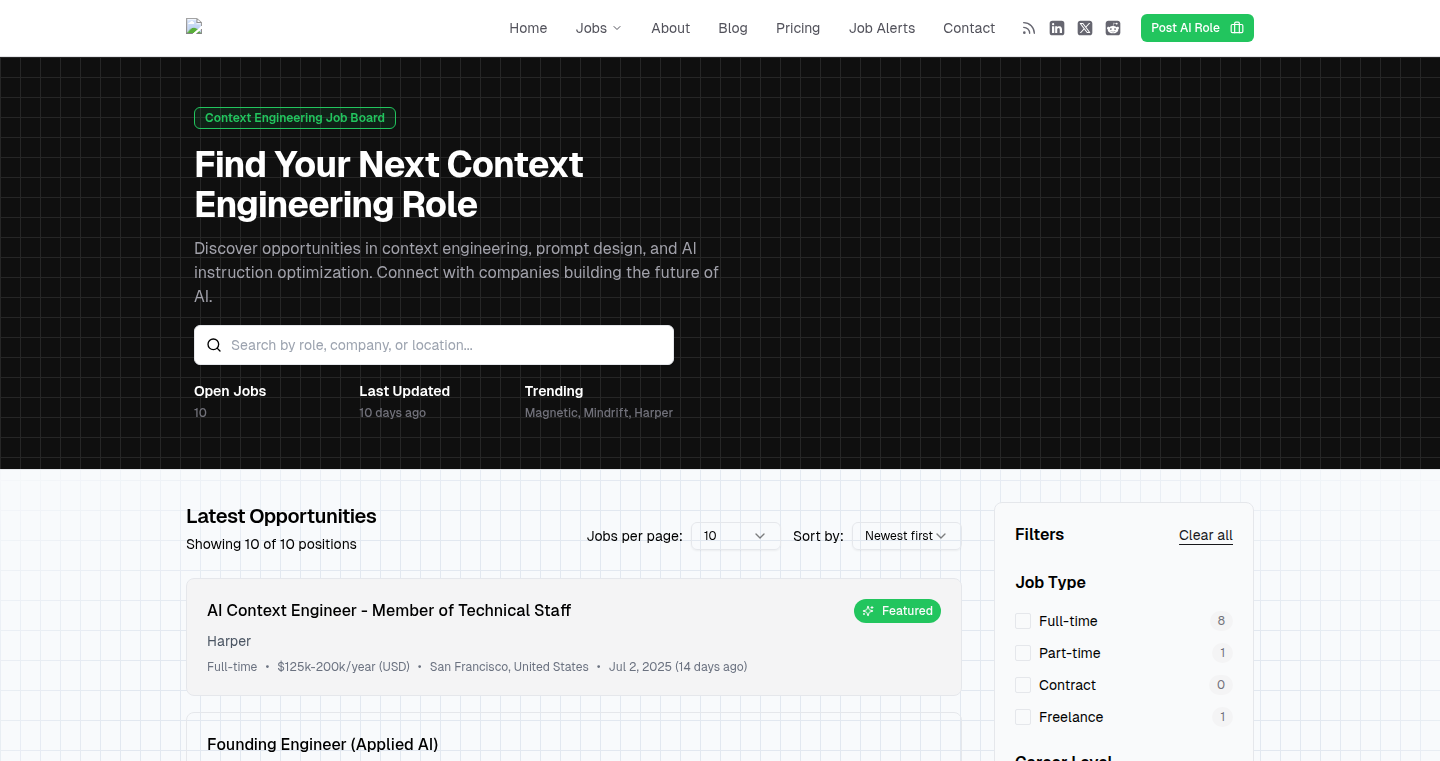
Author
maxcomperatore
Description
This project is a job board specifically tailored for 'Context Engineering,' aiming to connect engineers with opportunities focusing on understanding and managing the broader context of software development. It tackles the issue of finding relevant jobs by filtering based on the engineer's understanding of the project's requirements, architecture, and operational environment. It uses a novel approach to categorize jobs based on the context required, rather than just technical skills, potentially using natural language processing (NLP) to analyze job descriptions. So this is useful because it helps engineers find jobs that align with their understanding of the whole system, and employers to find engineers who grasp the bigger picture.
Popularity
Points 1
Comments 0
What is this product?
This project is a specialized job board. Its innovation lies in its focus on 'Context Engineering.' Unlike traditional job boards that primarily rely on keywords (e.g., 'Python,' 'React'), this board aims to categorize jobs and match candidates based on their ability to understand the 'context' of a project – the requirements, design, and how everything works together. Potentially uses NLP to analyze job descriptions, determine the required context, and match candidates accordingly. So it helps match engineers to jobs where they are more likely to thrive, and where their ability to understand the big picture is valued.
How to use it?
Developers can use this by simply visiting the job board and searching for jobs. Employers can list jobs on the board. Engineers can then search the job board, read the listed jobs, and see whether the job fits their understanding of the project's context. They might provide a resume that reflects their grasp of context. For Employers, by providing detailed context about the job, it helps them to attract the right kind of engineers. So, engineers can use the board to find jobs that leverage their systems thinking abilities. Employers can use it to find engineers who can understand and contribute to the bigger picture.
Product Core Function
· Context-Based Job Categorization: This function is the heart of the project. It involves analyzing job descriptions, potentially using NLP to identify the key contexts required for each role. This enables filtering jobs based on a more nuanced understanding of what the job actually entails, beyond just technical skills. This is valuable because it allows engineers to find jobs that are a good fit for their skills and interests and helps them to better utilize their whole-picture expertise.
· Contextual Matching: The project probably implements a matching algorithm to link engineers with jobs that require compatible understanding of the system, and can rank the jobs based on how well they match the engineer's context understanding. For engineers, this means finding jobs that are a perfect fit for their current knowledge. For employers, it simplifies the process of identifying qualified candidates that know the job.
· Simplified Search and Filtering: Provides user-friendly search and filtering options, enabling engineers to quickly narrow down the job postings based on their required understanding of the context. This functionality is of great value as it streamlines the process of looking for jobs based on what matters most in your daily work.
· Employer Posting Interface: Provides employers with an interface to post jobs where they can detail the context of each role, providing the insights needed to better find candidates. This ensures that there are enough descriptions on the job, helping employers to find people that match the requirements.
Product Usage Case
· A software engineer specializing in distributed systems can use the board to search for jobs that emphasize system architecture and operational challenges. This is useful as it reduces the time and effort required to find a job based on their specific understanding of how the entire system functions.
· A company can use the platform to find engineers who are skilled in specific project contexts (e.g., cloud infrastructure, microservices, or data pipelines) by describing the context that each job requires. This is valuable because it simplifies the search for engineers who are a great fit for the job.
73
The Mindloom: AI-Powered Mental Wellness Platform

Author
buildnothing
Description
The Mindloom is a mental wellness platform using artificial intelligence to provide support and resources for users. It focuses on guided journaling, mood tracking, and emotional check-ins, offering users insights into their emotional patterns. The core innovation lies in its AI-powered companion that offers personalized support, making mental wellness resources readily accessible and eliminating barriers like appointment waiting times and fear of judgment. It's built with a modern tech stack, and the focus is on user experience and accessibility. The platform also uses AI for real-time guided meditation using Elevenlabs, offering a new way to engage with mental wellness techniques.
Popularity
Points 1
Comments 0
What is this product?
The Mindloom is a platform that uses artificial intelligence to help people with their mental well-being. Think of it as a virtual companion that guides you through journaling, helps you track your mood, and provides insights into your emotional state. It leverages AI to personalize the experience. This means the platform can tailor its suggestions and resources to your specific needs. For example, the system analyzes your journal entries and mood data to identify patterns. So you can understand your emotional triggers better. The AI also assists in providing guided meditation sessions, offering a new way to engage with mental wellness techniques.
How to use it?
Developers and users can interact with The Mindloom directly via its web or mobile application. The platform offers an API for developers. So they can potentially integrate some of its features. For instance, a developer building a health-focused app could integrate the mood tracking functionalities to their application. Users can use The Mindloom to track their mood, journal about their experiences, and access resources like guided meditations. This allows for self-reflection and development of better self-awareness. It can also be helpful to health practitioners who want to provide a better experience for their patients.
Product Core Function
· AI-powered companion: The AI provides personalized support, offering insights and suggestions tailored to individual needs. This enhances user engagement and the relevance of the platform's resources. So this helps users get more out of their mental health support journey.
· Guided journaling with mood tracking: Users can write in a journal, and the platform tracks their mood over time. This helps identify patterns and understand the connection between thoughts, feelings, and behaviors. This offers users insights to take action, giving them more control of their emotional state.
· Daily emotional check-ins: Users are prompted to check in with their emotions daily. This promotes self-awareness and helps identify potential issues early on. This allows users to identify any issues and get support proactively.
· Insightful patterns for self-awareness: The platform analyzes user data to identify patterns in their emotional state, providing actionable insights. So users can better understand their triggers and behaviors and create a plan.
· Access to evidence-based resources: The Mindloom offers a library of resources, such as articles and exercises, to support users in their mental wellness journey. This ensures users have access to trustworthy information and tools to assist with their mental well-being.
Product Usage Case
· A health app could integrate the mood tracking feature from The Mindloom to provide users with a holistic view of their well-being. This offers a valuable, personalized service.
· A developer could create a chatbot that utilizes The Mindloom's AI to offer users on-demand mental health support. This creates a more accessible and supportive experience for users.
· Therapists can utilize the platform as a tool to help their patients self-track their mood and emotional state, offering an easier experience for patients to provide more effective support.
· A wellness retreat can integrate the platform to enhance participant support and offer continued support after the retreat ends. This will help participants stay on track with their goals after the retreat.
74
YOLO: AI-Powered Code Generation Decorator
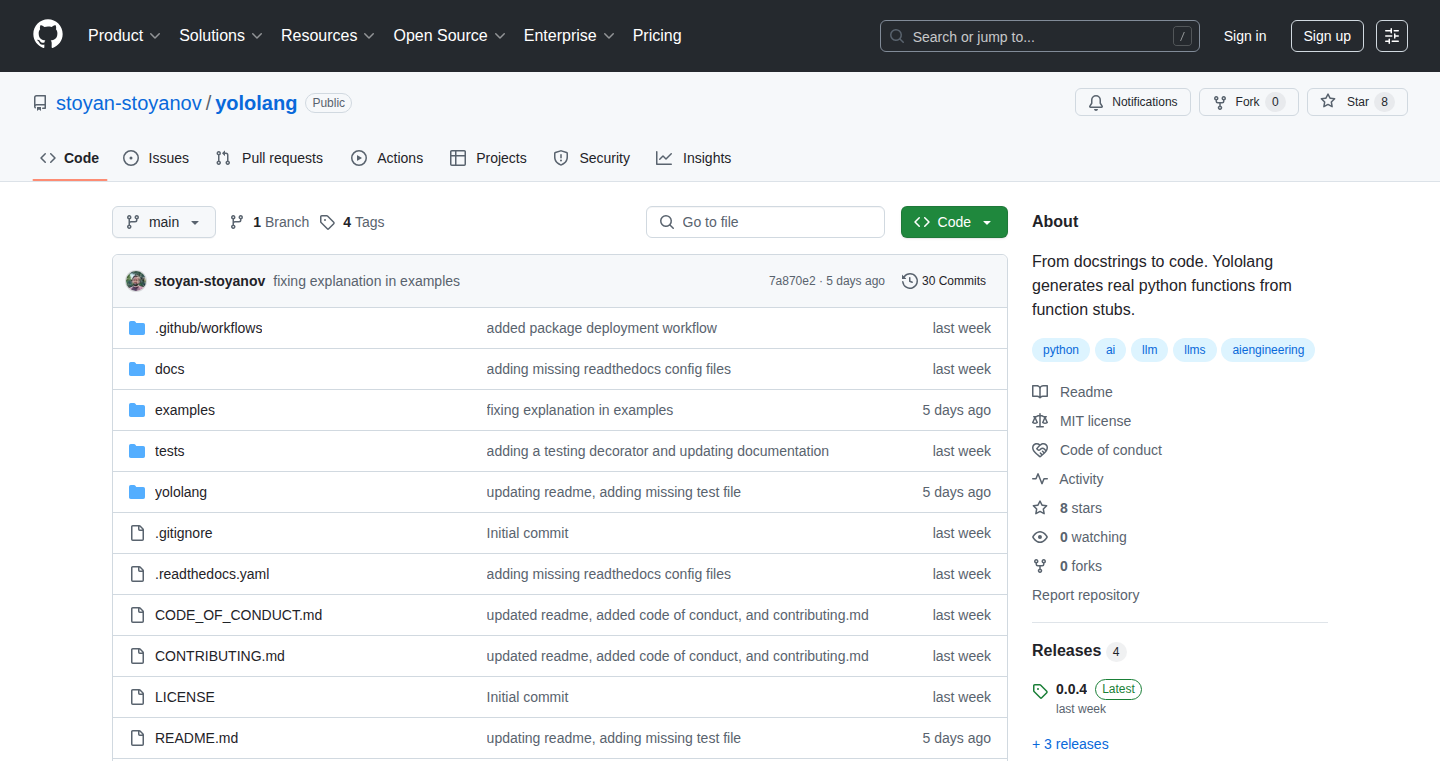
Author
spstoyanov
Description
YOLO is a Python decorator that uses AI to generate function code based on your function definitions. It tackles the problem of repetitive coding by letting AI write the code for you. This is a step towards 'AI-native programming,' where you describe what you want the code to do, and the AI builds it. It also encourages test-driven development, potentially leading to better and more reliable code. So, for you, it means less time coding, more time thinking about the problem you're solving.
Popularity
Points 1
Comments 0
What is this product?
YOLO uses a Python decorator (a way to modify functions) to interact with an AI model. You define the function's name, input parameters, and what the function should do. Then, the AI generates the actual Python code that implements the function's logic. The generated code is cached locally for faster execution, and the process is compatible with both regular and asynchronous functions. So, you can focus on the 'what' instead of the 'how'.
How to use it?
Developers integrate YOLO by applying the decorator to their function definitions in Python code. You specify the function's purpose, and YOLO's AI component then generates the code. You can use it for creating API endpoints using frameworks like FastAPI, or for building agent tools that perform specific tasks. This allows you to rapidly prototype and build functionalities, speeding up the development process. For example, in a data analysis project, you could define a function to clean a dataset, and YOLO would generate the code based on your description. You can integrate this into any Python project as it's simply a decorator.
Product Core Function
· AI-powered code generation: The core function is to take a function definition (including docstrings and type hints) and use AI to generate the corresponding Python code. This eliminates the need for writing boilerplate code.
· Local code caching: YOLO caches the generated code locally. This means the AI model is not called every time the function is used, resulting in faster execution speeds for repeated use of the same function, making your programs more efficient.
· Async function support: The decorator works with both regular and asynchronous functions, providing flexibility for different types of Python applications. This is important for modern applications that require non-blocking operations.
· Test-driven development (TDD) encouragement: YOLO encourages writing tests *before* the code is generated. If you write the tests first, you know the generated code passes those tests, adding a layer of confidence that the code will function correctly.
Product Usage Case
· FastAPI Endpoint Generation: Imagine you need an API endpoint to process user data. With YOLO, you could define the endpoint's input parameters, the data processing logic, and the desired output, and YOLO would generate the FastAPI code to handle the request. This is a time-saver for building web applications.
· Agent Tool Creation: You might want to build an agent that interacts with a database. By defining the agent's interaction goals (e.g., retrieve user information based on an ID), YOLO could generate the Python code that interacts with your database API. This provides more code flexibility to create automated tasks.
· Rapid Prototyping: When exploring a new idea, you can use YOLO to quickly prototype features. If you need a function to perform a specific mathematical calculation, YOLO could generate the code based on your description. So, instead of spending time writing that code, you can quickly move on to test your idea.
75
Scroll: Minimal Offline Reading App
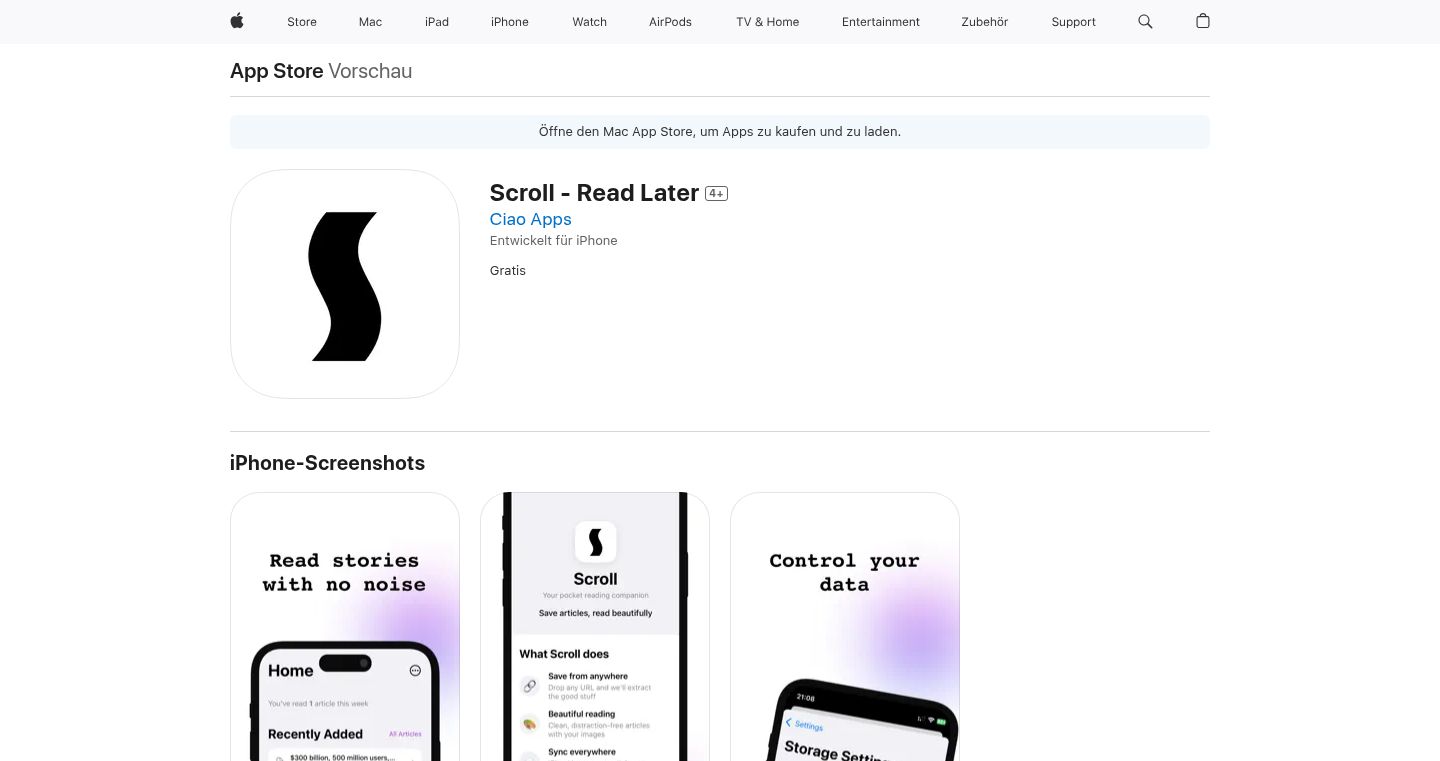
Author
Nikitaita
Description
Scroll is a 'read-later' application designed for distraction-free reading. It allows users to save articles offline, organize them efficiently, and even listen to them with a text-to-speech (TTS) engine. The core innovation lies in its focus on simplicity and performance, avoiding the bloat found in other read-later apps. It addresses the common problem of information overload and the need for a clean, offline reading experience. So this means it's designed to help you focus and read things you saved for later, even when you're not connected to the internet. It prioritizes a smooth and fast user experience.
Popularity
Points 1
Comments 0
What is this product?
Scroll is a mobile application (specifically for iOS as indicated by the App Store link) that lets you save articles you find online to read later. The key is its focus on being minimal and getting out of the way. It provides offline access using caching and storage on the device, ensuring you can read your saved articles without an internet connection. A Text-To-Speech (TTS) engine is integrated, enabling users to listen to articles instead of reading them. The app likely uses web scraping or content extraction techniques to strip away the unnecessary parts of webpages (like ads and website navigation), leaving only the text and images of the article. This streamlines the reading experience. So this means, instead of battling with complex interfaces and internet dependencies, you get a focused, efficient way to consume your reading list.
How to use it?
Developers and users can utilize Scroll to manage their reading list of articles. For developers, understanding how Scroll handles offline access and content parsing provides valuable insight into building similar solutions. Users can save articles from any website by sharing them to Scroll. The app then downloads and stores the content locally. Integration is straightforward as users save from existing browsers to their scroll app. So this means if you're a developer creating a news app, you might consider implementing similar offline features and content parsing to enhance the user experience. If you're a user, just share a link to your Scroll app and it'll save it for later.
Product Core Function
· Offline Article Saving: This feature downloads and caches articles for reading without an internet connection. It uses caching and data storage to maintain local copies of the articles. Application: Perfect for reading articles during commutes, on flights, or in areas with poor internet connectivity. So this lets you catch up on reading anytime, anywhere.
· Content Extraction/Parsing: Scroll likely employs techniques to strip away the unnecessary parts of a webpage. The code uses HTML parsing, and perhaps natural language processing, to extract and format just the main content. Application: Improves the reading experience by removing ads, navigation menus, and other distractions. So this means you focus on the article and not all the extra stuff.
· Text-to-Speech (TTS) Integration: This allows users to listen to articles. It leverages TTS engines built into the iOS operating system. Application: Useful for multitasking or for people who prefer listening. So this lets you listen to articles while you're doing other things like driving or working out.
· Clean and Minimal UI/UX: The focus on simplicity means the user interface is uncluttered, designed to minimize distractions. Application: Improves the overall reading experience by providing a clean environment. So this means everything is designed to help you focus on the content.
Product Usage Case
· Mobile Development: Developers can examine the app's implementation for offline caching and content parsing as examples for integrating similar features into other mobile apps. It may have used Swift/Objective-C on iOS. Scenario: A news app can use these techniques to provide an offline reading feature, improving user engagement. So this means developers can learn from the app's code architecture.
· Accessibility: The TTS feature provides an alternative way of consuming content that benefits users with visual impairments or those who prefer audio consumption. Scenario: Educational apps or productivity apps can use text-to-speech to make the content more accessible. So this means content can be consumed in different ways based on a user's needs.
76
Tanu: Rust-Powered Web API Testing Framework
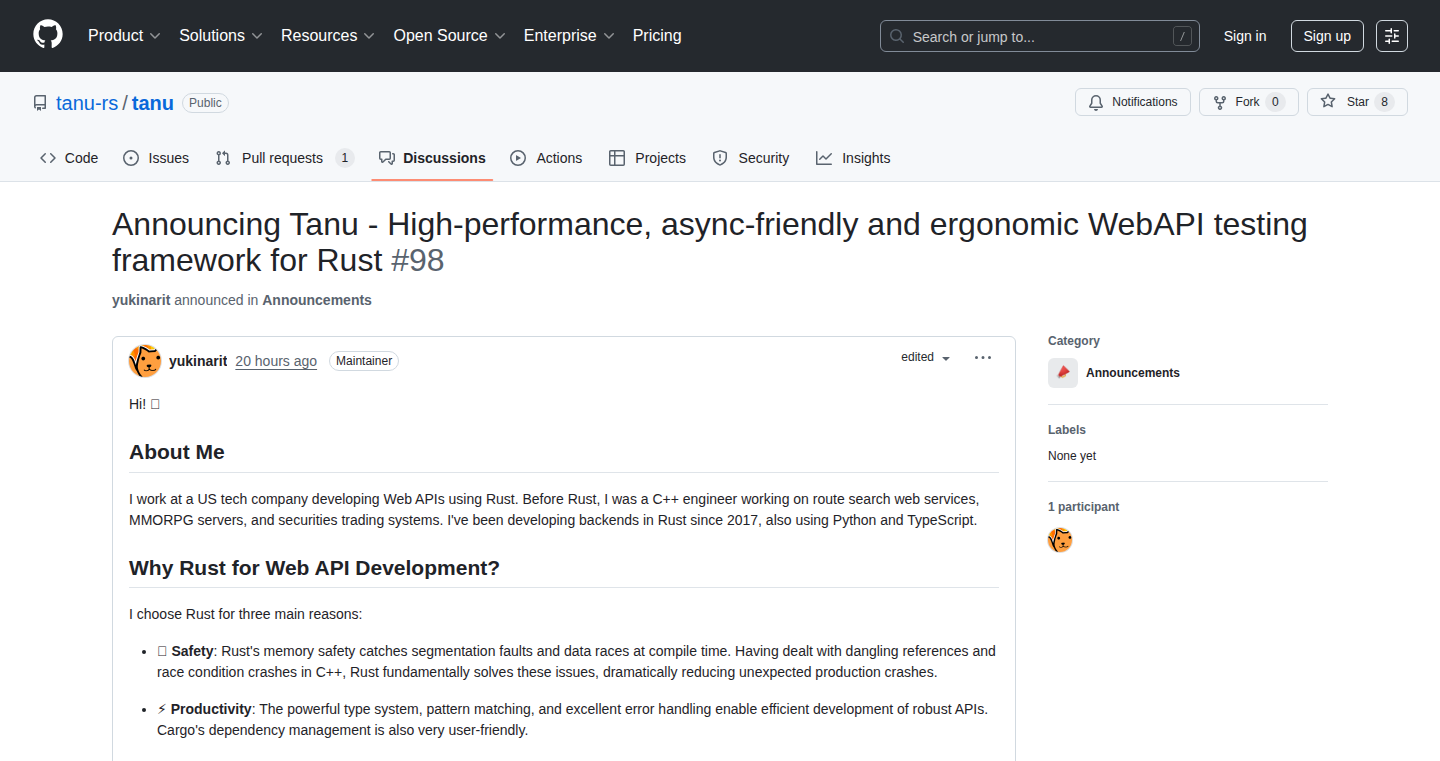
Author
yukinarit
Description
Tanu is a high-performance framework built in Rust designed for efficiently testing Web APIs. It focuses on speed and concurrency, allowing developers to quickly and reliably test API endpoints. The key innovation lies in leveraging Rust's memory safety and performance capabilities to handle a large number of test requests concurrently, identifying potential performance bottlenecks and ensuring API stability. This addresses the common challenge of slow and unreliable API testing, saving developers valuable time and improving overall software quality.
Popularity
Points 1
Comments 0
What is this product?
Tanu is essentially a specialized tool for testing the behavior of your web services (APIs). Think of it as a super-powered tester built using Rust, a programming language known for its speed and safety. The cool part? It’s designed to run tests really, really fast, and handle lots of tests at the same time (concurrency). This is important because slow tests waste time, and testing APIs can be tricky. Tanu helps you find problems with your API early on, making sure everything works smoothly and efficiently. So, it's like a performance checkup for your website’s or app's backend.
How to use it?
Developers can use Tanu by writing test cases that define how their API endpoints should behave. These tests specify things like the expected responses (status codes, data formats), the data to send, and how the API should react under different conditions. You integrate Tanu into your existing development workflow, usually during the development cycle. By running Tanu frequently, you can quickly discover problems, especially performance bottlenecks and data integrity issues, before deploying your application. So, you write small scripts to test how your website is working, and Tanu runs those scripts really fast to give you the results.
Product Core Function
· High-Performance Testing: Tanu utilizes Rust's capabilities to run API tests incredibly fast, significantly reducing test execution time. This means you get results faster. It's like having a super-speedy tester for your website backend.
· Concurrent Test Execution: The framework supports running many tests simultaneously, allowing developers to simulate real-world usage patterns and uncover concurrency issues. This helps to test how your application handles several users at once, uncovering any issues that might arise.
· Comprehensive API Testing: Tanu enables developers to thoroughly test various aspects of their APIs, including HTTP methods (GET, POST, PUT, DELETE, etc.), request and response data validation, and status code verification. It ensures all the parts of your website or app's backend are working as expected.
· Ease of Integration: It provides an easy-to-use interface for writing and running tests, making it simple for developers to integrate it into their existing workflows. Makes it simple for your website backend to test itself.
· Detailed Reporting: Tanu provides detailed reports of test results, including success/failure rates, performance metrics, and error details. This means you can easily see what works and what doesn't.
Product Usage Case
· Performance Optimization: A developer uses Tanu to identify a slow endpoint in their API. By running load tests, they discovered a database query causing performance bottlenecks. They then optimized the database query and saw a significant improvement in response times. So, you use it to make your website run faster and more efficiently.
· API Stability Testing: Before deploying a new version of their API, a development team uses Tanu to run a suite of tests that cover different API endpoints and scenarios. Tanu reveals an error in the new API version, so they fixed the error before deploying it to production. Using Tanu prevents mistakes from causing your website to break for your users.
· Load Testing: A team uses Tanu to simulate a surge in traffic to their e-commerce API during a major sales event. Tanu reveals the API can handle the load before the actual event. Therefore, it helps guarantee your site doesn't crash when lots of people use it at once.
· Integration Testing: Developers use Tanu to ensure that different components of their backend systems (e.g., payment processing, user authentication) work together seamlessly. Tanu helps in testing if different parts of your application works together.
77
Dashport.ai: AI-Powered Instant Data Insights

Author
ErkanCevher
Description
Dashport.ai is an AI-driven business intelligence (BI) tool that allows users to instantly generate interactive dashboards from their data, without any coding. It addresses the common problem of long delays and complex coding requirements associated with traditional data reporting. Users can upload data from various sources (Excel, CSV, MySQL, etc.) and ask questions in natural language to receive customizable dashboards within seconds. The core innovation lies in leveraging AI to automate data analysis and visualization, making complex data accessible to everyone, regardless of their technical skills.
Popularity
Points 1
Comments 0
What is this product?
Dashport.ai uses artificial intelligence to understand your data and answer your questions. You upload your data (like a spreadsheet or a database file), then type in what you want to know in plain English. The AI does the heavy lifting: it analyzes the data, figures out the best way to visualize it (charts, graphs, etc.), and creates an interactive dashboard for you. So, it's like having a data analyst in your pocket, who can answer your questions in seconds. So what? This allows anyone, even if they don't know how to code, to get quick insights from their data and make better decisions.
How to use it?
Developers can use Dashport.ai to quickly visualize and explore data from different sources during their development and testing phases. Imagine you are building a web application, and you want to track user activity data. Instead of spending hours writing code to build dashboards, you can simply upload the data to Dashport.ai and ask questions like 'Show me the number of daily active users over time' or 'What are the top 10 most used features?' This accelerates the data analysis process and helps developers quickly identify trends and issues. Alternatively, use it to build internal tools for the team to explore data. The integration is simple: upload the data, define the questions, and instantly see results.
Product Core Function
· Data Upload and Integration: Allows users to upload data from various sources like Excel, CSV, and MySQL. This eliminates the need for manual data cleaning and preparation. So what? This saves significant time and effort, as users don't have to wrangle the data themselves. You can quickly analyze data from multiple sources, streamlining the reporting process.
· Natural Language Querying: Users can ask questions about their data in plain English. The AI interprets the questions and generates relevant insights. So what? This democratizes data analysis, as it removes the need for coding or specific technical skills, enabling anyone to analyze data. You get the answers to your questions quickly and easily.
· Interactive Dashboard Generation: The AI automatically creates interactive dashboards with different chart types (bar charts, line graphs, etc.). These dashboards are customizable, allowing users to change colors, sizes, and chart types. So what? This makes data exploration intuitive and accessible. You can easily customize visualizations to focus on the most important information, making it easier to identify trends and patterns in your data.
· Automated Data Analysis: The AI analyzes the data to provide relevant insights and suggest potential trends. This can help identify patterns, correlations, and anomalies within the data. So what? This helps users to discover hidden insights and potential problems, which they might have missed using other methods. You get a deeper understanding of your data, leading to better decisions.
Product Usage Case
· E-commerce: An e-commerce developer could upload sales data and ask questions like, 'What products are selling the most?' or 'Which marketing campaigns are driving the most revenue?' The AI then generates an interactive dashboard showing sales trends, top-selling products, and marketing campaign performance. So what? This helps them to quickly understand what's working and what's not, enabling them to optimize their marketing strategies and product offerings.
· Software Development: A development team could upload bug tracking data and ask questions like, 'What are the most common bugs?' or 'Who is the most active developer?' The AI generates dashboards showing the most frequent bugs and developer contribution. So what? This helps them to identify the most crucial bugs, improve development efficiency, and recognize outstanding team members.
· Finance: A financial analyst can upload data from financial records to get insights on profits, losses and other trends. For example: 'What are the top expenses?' The AI will build a customizable dashboard with all the key data. So what? This helps financial professionals make informed decisions about investment and resource allocation.
78
next-pwa-pack: Effortless PWA for Next.js
Author
devfamdk
Description
next-pwa-pack simplifies building Progressive Web Apps (PWAs) in Next.js. It tackles the complexities of adding offline support, cache control, and version updates by providing a pre-configured service worker. This package handles the annoying parts, allowing developers to focus on their application's core functionality instead of wrestling with service worker configurations. It includes features like caching HTML and static assets, offline fallback, cache invalidation across browser tabs, and a messaging system to control the cache from the app. So, it makes it easier to create web apps that work even without an internet connection.
Popularity
Points 1
Comments 0
What is this product?
next-pwa-pack is a package designed to make adding PWA features to Next.js projects easy. It uses a service worker to manage caching, allowing your website to work offline, load faster, and update seamlessly. It provides a default service worker configuration that caches HTML pages and static assets. It also offers a messaging system to update or clear specific caches, and a hook to check the status of the service worker. The key innovation lies in simplifying the complex process of integrating service workers into Next.js, which often involves a lot of manual configuration. It streamlines the whole process, providing a better developer experience.
How to use it?
Developers can use next-pwa-pack by simply wrapping their app in the PWAProvider. This takes care of service worker registration and messaging setup. Then, the package automatically caches your pages and static assets. You can also use the built-in messaging protocol to update or clear caches as needed. For instance, after a user submits a form or after a data change. This allows developers to quickly add offline capabilities to their Next.js projects. So, you'll be able to build web apps that are more reliable and have a better user experience.
Product Core Function
· Automatic Caching of HTML and Static Assets: This feature caches your website's HTML pages and static files (like images, CSS, and JavaScript), allowing users to access the content even without an internet connection. This improves website performance and provides a better user experience, especially in areas with poor network connectivity. So, your users can still see and use your website content even when the internet is down.
· Offline Fallback Support: It provides an offline fallback page. When a user is offline and tries to access a page, the service worker shows a pre-defined offline page. This prevents users from seeing the dreaded 'no internet' message and keeps them engaged with your app. So, your app remains useful and provides a better user experience even when the user is offline.
· Cache Invalidation Across Browser Tabs: The package handles cache invalidation across different browser tabs. It uses localStorage and storage events to broadcast update signals. So, when you update your website, all open tabs refresh automatically, ensuring users always see the latest version. This prevents users from getting stuck with outdated content.
· Messaging System for Cache Control: It provides a built-in messaging protocol so your app can interact with the service worker. For example, you can update or clear specific caches. This allows you to control the caching behavior dynamically. So, you can clear the cache after a user logs out to ensure their private data is removed, or update the cache after data changes.
· Development Mode Features: During local development, enabling 'devMode' in the provider shows a status widget. This widget tells you if the app is online, if the cache is being used, and allows you to manually clear or disable the cache. This greatly helps in debugging and understanding how the service worker is behaving. So, it helps you to efficiently develop and test your PWA features.
Product Usage Case
· E-commerce Application: Imagine you're building an online store. With next-pwa-pack, you can cache product pages, images, and the shopping cart. Even if a customer loses their internet connection while browsing, they can still see the product information and continue browsing. This increases the chances of them making a purchase. So, users can still browse products even if they lose their internet connection, keeping them engaged.
· Blog or News Website: A news website can use next-pwa-pack to cache articles. If a user is on a train with spotty internet, they can still read the news they previously loaded. This improves the user experience and reduces frustration. So, users can read articles even without a stable internet connection.
· Offline Documentation: Imagine a company developing an offline documentation. Next-pwa-pack allows the documentation pages and resources to be cached. This allows support personnel and customers to access the documentation even if they are in an environment without an internet connection. So, important company information can still be accessed offline.
· Web-based Productivity Tools: Imagine a web-based to-do list application. Users can still create and manage their tasks even when they are offline. When the internet connection is restored, the data can be synced. So, users can continue to use their apps even if the internet is not working.
79
AnalogLogic: A Pen-and-Paper Logic Simulator
Author
symbol_reasoner
Description
AnalogLogic is an experimental Artificial General Intelligence (AGI)-like logic simulator built entirely with pen, paper, and a structured table system. It simulates logical relationships between concepts using a grid-based structure, mimicking a hand-written neural network or rule-based system. The system learns from user feedback by adjusting weights, similar to reinforcement learning, and automatically generates reasoning paths and simulates calculation flows. This project showcases a novel approach to AI, prioritizing transparency and explainability, and offers a glimpse into how logic and reasoning can be visualized and understood in a direct, tangible manner.
Popularity
Points 1
Comments 0
What is this product?
AnalogLogic is a fascinating project that creates an AI-like system using physical tools like pen and paper, without relying on computers or software. The core idea is to represent logical concepts and their relationships visually, using a grid-based structure (like a table). This system functions like a simplified neural network, where connections between concepts are represented by weights that can be adjusted based on feedback. The project's innovation lies in its analog nature, allowing users to literally see the reasoning process unfold, making it highly explainable and understandable. It tackles the problem of complex, opaque AI models by providing a clear, human-readable representation of logical thinking. So this is useful because it makes AI concepts easier to understand, and lets you experiment with AI ideas in a simple, direct way.
How to use it?
Users can interact with AnalogLogic by creating the grid-based structure on paper and defining the concepts and their relationships. The system then processes inputs and simulates the logical flow, updating weights and generating outputs based on the defined rules and feedback. This could be useful for researchers and educators to visually understand how complex logical systems operate and experiment with AI without needing extensive programming skills or hardware. You can also use this as a learning tool, to help understand the basics of how neural networks or logic based AI systems work. So this is useful if you want to easily experiment and visualize complex AI ideas.
Product Core Function
· Grid-based Logic Representation: The core functionality is the use of a grid to represent logical relationships. Each cell in the grid represents a concept or element, and the connections between cells (weighted relationships) represent the logic that governs how the system operates. Application: Enables a visual and understandable method of representing logical relations, enabling easier experimentation and understanding of AI. So this is useful if you want to understand and visually represent how different concepts are related to each other.
· Weight Adjustment Mechanism: The project incorporates a system for adjusting the 'weights' of the connections between concepts based on user feedback. This is a simplified version of reinforcement learning, enabling the system to 'learn' from input. Application: It offers a basic framework for simulating how systems can learn and adapt over time, similar to how neural networks refine their understanding of data. So this is useful for exploring basic AI learning principles without requiring complex coding or specialized hardware.
· Reasoning Path Generation: AnalogLogic generates reasoning paths and calculation flows automatically based on input and defined relationships. Application: Allows users to trace the step-by-step logical process, enabling understanding of how conclusions are reached. So this is useful because you can actually see why the system comes to a specific conclusion.
· Analog Simulation of Neural Networks: This project essentially creates a physical analog of a neural network. Application: This allows a hands-on, intuitive understanding of how these typically complex systems work, making the concept of AI and Machine Learning more accessible. So this is useful because you can get a tangible understanding of how complex AI systems work.
Product Usage Case
· Educational Tool for AI Concepts: Using AnalogLogic to teach students the fundamentals of AI logic, neural networks, or rule-based systems. The pen-and-paper approach makes the concepts more accessible than complex code. For example, you could demonstrate how changing the weights affects the output of a simple system. So this is useful for educators who want a simple way to demonstrate complex AI concepts.
· Engineering Problem Solving: Simulate simple mechanics or material science problems to visualize the step-by-step logic involved. The transparency of the system allows for easy analysis of how different variables affect the outcome. For instance, model a simple circuit and see how adjusting the resistance changes the current. So this is useful if you are a student or engineer looking for a tangible way to visualize logic and relations in an engineering problem.
· Domain-Specific Expert System Prototype: Evolve AnalogLogic into a basic expert system for a specific domain, such as medical diagnosis or financial analysis, to demonstrate the potential of analog, rule-based systems. For instance, create a simple diagnostic system to illustrate the relationship between symptoms and diseases. So this is useful for exploring the potential of non-digital logic based expert systems.
80
OS Yamato: A Wabi-Sabi Inspired Digital Garden

Author
tsuyoshi_k
Description
OS Yamato is a unique operating system designed as a minimalist 'digital garden.' It focuses on providing a clutter-free environment where data is ephemeral, inspired by the Japanese philosophy of 'wabi-sabi' (embracing impermanence). This means your digital notes and interactions gently fade away if not actively maintained (auto-deletion after 365 days). The latest updates include an AI-powered ad-free search and in-app assistant, along with Chinese localization. It uses a modern tech stack (Vue 3 for the front-end and AWS Amplify for the back-end), showcasing how to build a user-friendly, cloud-based application. So, this provides a novel approach to digital information management, emphasizing focus and reducing digital clutter.
Popularity
Points 1
Comments 0
What is this product?
OS Yamato is a web-based operating system that rethinks how we interact with digital information. It's built on the idea that not all data needs to be permanently stored. The core innovation lies in its data lifecycle management: files and notes naturally 'bloom' and 'fade'. It leverages a modern stack: the front-end is built with Vue 3, a popular JavaScript framework known for creating interactive user interfaces. The back-end is powered by AWS Amplify, which simplifies the deployment and management of serverless applications using services like Cognito (user authentication), AppSync (real-time data), DynamoDB (database), and S3 (storage). Additionally, the inclusion of an AI-powered search and assistant demonstrates the integration of artificial intelligence to enhance the user experience. So, it's a platform for building a digital space that values intentionality and decluttering.
How to use it?
Developers can experience OS Yamato by visiting the provided link (hanaco875.com) or by exploring its GitHub repository. The code on GitHub offers insights into how the application is structured. Developers can leverage the project's code for inspiration on building similar applications, specifically on the front-end (Vue 3) and back-end (AWS Amplify) technologies. The architectural design principles of 'wabi-sabi', such as data ephemerality, can be implemented in any application to create a less cluttered and more focused user experience. So, developers can learn about building modern web apps with modern tools and explore innovative interaction models.
Product Core Function
· Ephemeral Data Management: The system automatically deletes data after a year of inactivity. This is a core feature that reflects the 'wabi-sabi' philosophy, encouraging users to be mindful of what they save. So, you can explore design patterns that are less about archiving and more about focused experiences.
· AI-Powered Search: An integrated AI search function allows users to find information without intrusive ads. This feature provides a fast and clean search experience within the application. So, it shows how you can integrate AI to improve the overall user experience and user interactions.
· In-App Assistant: An AI-powered assistant provides help and guidance within the OS, enhancing user interaction and navigation. So, this shows how to build intelligent and helpful user interfaces.
· Chinese Localization: The OS offers support for the Chinese language, enabling a more global reach. This functionality is a demonstration of internationalization, and is easily adapted to other languages. So, it’s a lesson in making applications accessible to a wider audience.
Product Usage Case
· Personal Note-Taking Application: Imagine building a note-taking app where older notes automatically archive, allowing users to focus on the present without the digital clutter of decades of notes. So, this can inspire other developers to integrate data lifecycles within their own note-taking apps.
· Project Management Tool: A project management application that archives old project data automatically. So, the system helps to keep the focus on active projects, and removes the need for endless archiving and clutter.
· Content Management System (CMS): Building a CMS where the content automatically deletes after a set time. So, developers can build more focused content for users and encourage users to actively use the platform and review content.
81
SimMS: GPU-Accelerated Mass Spectra Search
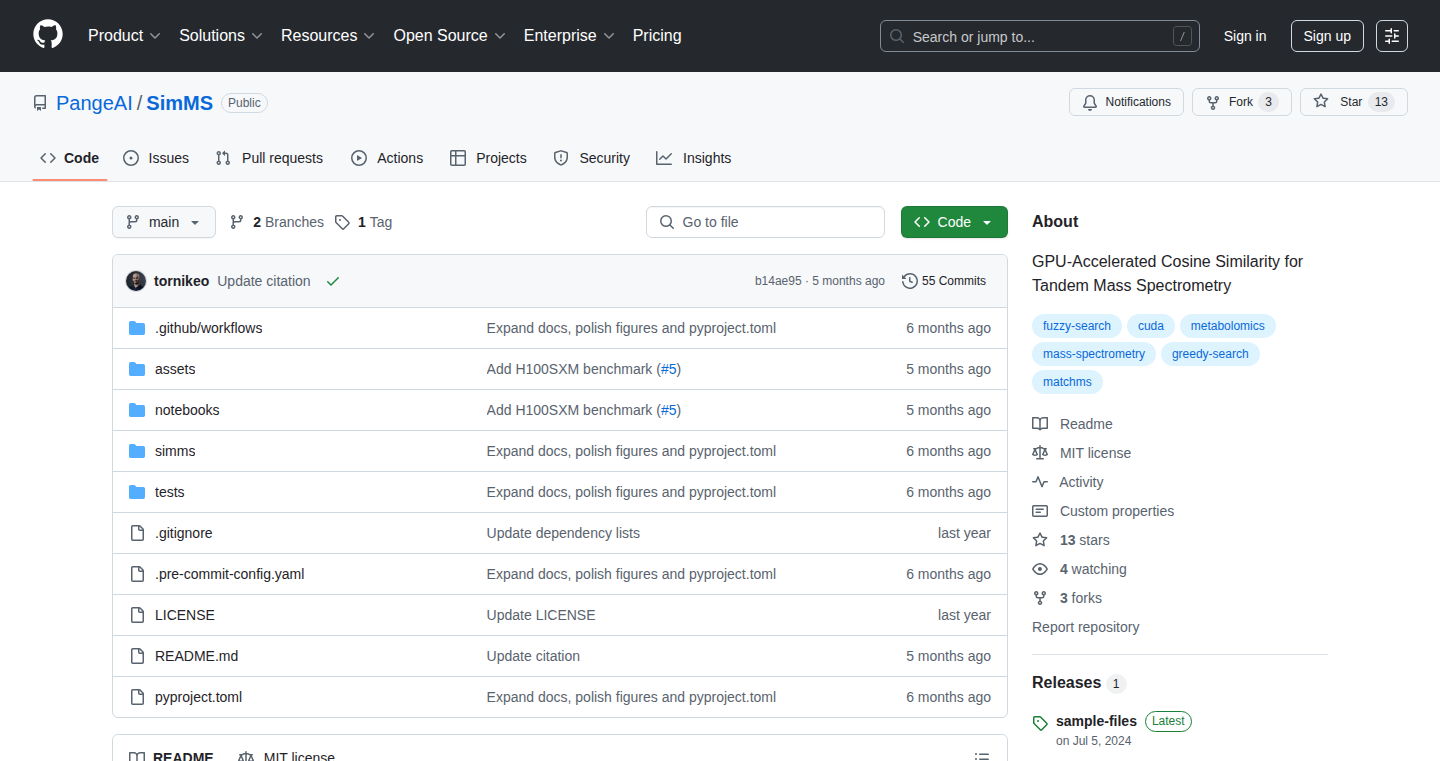
Author
tornikeo
Description
SimMS is a tool designed to rapidly search through mass spectra data, which is essentially a molecular fingerprint. It uses the power of Graphics Processing Units (GPUs) to significantly speed up the process of identifying molecules in complex samples like blood, urine, or food. The core innovation lies in porting the comparison algorithm, a modified cosine similarity, to run on a GPU. This allows for massively parallel comparisons, leading to an impressive speedup of up to 1700x compared to existing solutions. This is a significant advancement in the field of analytical chemistry and related domains.
Popularity
Points 1
Comments 0
What is this product?
SimMS is a software tool that uses the power of a GPU (the same kind used in video games) to quickly compare molecular fingerprints (mass spectra). It does this by implementing a specialized algorithm that is highly efficient when run on a GPU, allowing for a massive number of comparisons to be performed simultaneously. This is like having thousands of tiny computers all working together to find a match. So, if you need to identify a specific molecule among millions in a sample, SimMS can do it much, much faster. This is a big deal because it accelerates the identification of dangerous substances or the discovery of new molecules in biological samples.
How to use it?
Developers can use SimMS by integrating it into their existing mass spectrometry data analysis pipelines. This might involve writing scripts in Python or other programming languages to load spectra data, run the comparison algorithm using SimMS, and interpret the results. The integration process would involve calling SimMS functions to compare spectra data against a database of known spectra. Then, the software will return the matching spectra. For example, developers could use SimMS to create a fast system for detecting drug metabolites in urine samples or identifying contaminants in food. The core of the process relies on feeding the input spectra and database into the GPU-accelerated similarity matching algorithms and interpreting the output.
Product Core Function
· GPU-Accelerated Comparison Algorithm: This is the core function. It takes mass spectra data and uses the GPU to perform the comparison. So what? This allows researchers and scientists to process huge amounts of data at lightning speed, identifying molecules much faster than before. This is useful in identifying unknown substances in environmental samples or discovering new drugs.
· Mass Spectra Data Input: SimMS can take mass spectra data as input. So what? This allows users to analyze data from various mass spectrometers. This means that users can use this to make their analysis on a broad range of instruments in the lab.
· Similarity Score Calculation: The software will calculate a similarity score that gives the developer an idea of how closely two spectra match. So what? This allows users to quickly identify substances, like in a quality control scenario, for example, in the pharmaceutical industry to check if products are pure.
Product Usage Case
· Drug Testing: SimMS can be used to analyze urine samples for the presence of illegal drugs. The system is set up to use the mass spectra of common drugs and the data is compared to the target data from the tested sample. So what? This would speed up drug detection, making it possible to rapidly screen large numbers of samples.
· Food Safety Analysis: Checking food for toxins or contaminants. By analyzing the mass spectra of food samples and comparing them to a database of known toxins. So what? This would allow for the rapid detection of dangerous substances in food, protecting consumers.
· Environmental Monitoring: Identifying pollutants in water samples. This involves running the mass spectra of water samples through SimMS. So what? This allows for quickly identifying and tracking pollutants, helping to protect the environment.
82
StyleCanvas: Real-time Image Restylization Engine
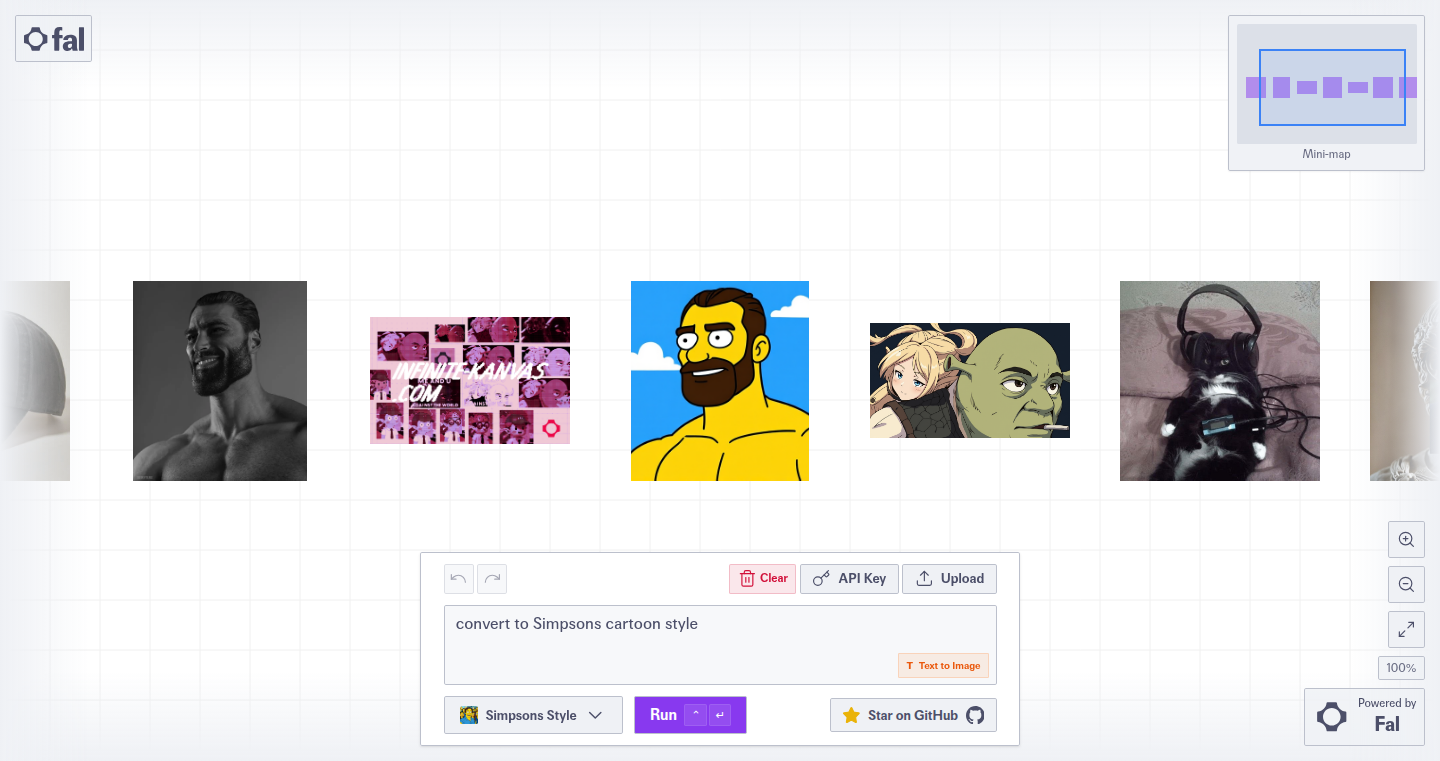
Author
treesciencebot
Description
StyleCanvas is an open-source web application enabling real-time image restylization directly in the browser. It leverages the power of neural networks to apply artistic styles to images without requiring any server-side processing. This project focuses on providing a fast and interactive way to explore different artistic styles on images, highlighting the efficiency and potential of in-browser machine learning.
Popularity
Points 1
Comments 0
What is this product?
StyleCanvas allows you to transform your images into works of art in real-time, directly within your web browser. It works by using pre-trained neural networks to understand and apply artistic styles (like those of Van Gogh or Monet) to any image you upload. The innovative aspect is that all the processing happens locally on your computer, meaning no data is sent to a server, and the results are generated almost instantly. So this is essentially a fast and private way to artify your photos.
How to use it?
Developers can use StyleCanvas as a library or a starting point to build image manipulation features in their own web applications. They can integrate the core restylization engine, which can be customized and extended to include different style models. You can use it in your photo editing software, online design tools, or even interactive art installations. This makes it simple for developers to quickly add style transfer capabilities to their projects without worrying about setting up and managing a backend server.
Product Core Function
· Real-time Style Transfer: Apply artistic styles to images instantly. This feature enables users to quickly experiment with different art styles and see the results in real-time. So this gives you immediate visual feedback on how the image will look.
· In-browser Processing: All processing happens in the user's browser. This feature ensures privacy and speed, as the images don't need to be uploaded to a server. So this means your images are safe, and it works quickly, even with a slower internet connection.
· Open-source and Customizable: The project is open-source, allowing developers to modify and adapt it to their specific needs. This means you can learn from the code, add new styles, or customize the interface to match your brand or project.
Product Usage Case
· Photo Editing Apps: Integrating StyleCanvas into a photo editing application allows users to apply artistic filters without relying on cloud services. You can let users transform ordinary photos into unique artworks directly from their browser.
· Online Design Tools: Design tools can incorporate StyleCanvas to provide users with creative options to stylize images for social media posts, marketing materials, or graphic designs. This lets your users create visually stunning content with ease.
· Interactive Art Installations: Artists and creators can utilize StyleCanvas to build interactive art experiences where users can change the style of an image in real-time. This will provide an interactive and engaging experience for your audience.
83
GGUF Quantization Explainer: Demystifying AI Model Compression

Author
irt24
Description
This project provides an unofficial explainer and documentation for GGUF quantization, a popular technique for compressing large language models (LLMs) like Llama, making them run efficiently on CPUs. It tackles the problem of sparse documentation and complex concepts in GGUF quantization by breaking down the technical details in a more accessible way. Instead of relying on AI-generated content, the author painstakingly researched and explained the core ideas behind quantization techniques like K-quants, I-quants, and the importance matrix, providing a valuable resource for developers working with quantized models. So, it's a practical guide for anyone wanting to understand and use quantized AI models, making it easier to run sophisticated AI on everyday hardware.
Popularity
Points 1
Comments 0
What is this product?
This project is an explainer for GGUF quantization. GGUF is a method to shrink the size of AI models so they can run faster and use less memory, especially on computers that don't have powerful graphics cards. The project explains the core concepts behind GGUF, such as how it works, the techniques used to compress the models (like K-quants and I-quants), and the factors that determine the quality of the compressed model. It also delves into how different parts of the model are 'quantized' or compressed, which is crucial for understanding the underlying technology. So, it is like a manual that unlocks the secrets of making AI models smaller and faster.
How to use it?
Developers can use this explainer as a reference when working with GGUF-quantized models. It provides the understanding needed to apply quantization to their models or optimize existing quantized models. This involves several key stages. First, developers need to choose a suitable model. Next, they can decide which quantization methods to apply based on the project and hardware limitations. During quantization, parameters are converted into a lower precision format (e.g., from 32-bit to 8-bit integers) to compress model size and accelerate inference. Finally, understanding the quantization process helps troubleshoot issues related to performance, quality, and memory usage. The explainer helps developers to navigate the technical landscape of model compression, enabling them to reduce the size and computational cost of their AI models. So, you can learn how to shrink those massive AI models and make them run on your laptop.
Product Core Function
· Provides a comprehensive overview of GGUF quantization, including its history, advantages, and limitations. This is valuable because it provides context and helps developers understand why and when to use quantization.
· Explains key concepts in GGUF quantization, such as K-quants, I-quants, and the importance matrix. This enables developers to decode complex quantization terms and better grasp the technical inner workings.
· Details the quantization process, including the steps involved in transforming model weights and activations into a smaller size. This helps developers execute and understand the quantization process at a deeper level.
· Offers guidance on selecting appropriate quantization methods and parameters based on hardware, use case, and desired balance between model size, speed, and accuracy. This helps the developer create more specific models.
· Acts as a practical resource for developers, providing them with the knowledge needed to work with GGUF-quantized models, optimize their performance, and troubleshoot potential issues. This is extremely useful for accelerating and simplifying the process.
Product Usage Case
· A developer is working on a project that requires running an LLM on a low-powered device. The explainer helps them understand how to use GGUF quantization to compress the model, allowing it to run efficiently on the limited hardware. So, you can run that huge language model on your old computer.
· An AI researcher wants to understand the impact of different quantization techniques on the performance of their model. The explainer provides the technical details and background needed to evaluate and compare various quantization methods. So, you can refine your AI model by picking the right compression methods.
· A developer encounters performance issues when running a GGUF-quantized model. The explainer helps them understand the inner workings of quantization, enabling them to troubleshoot and optimize the model for better performance. So, you can figure out why your AI model is running slow and fix it.
· A software engineer wants to build an application that leverages AI capabilities but needs to ensure that the model fits within the memory constraints of the target device. The explainer gives them a deep dive on the quantization steps. So, you can get that AI app on your phone without issues.
84
TaskFlow: Weekly-to-Daily Task Transformation Engine
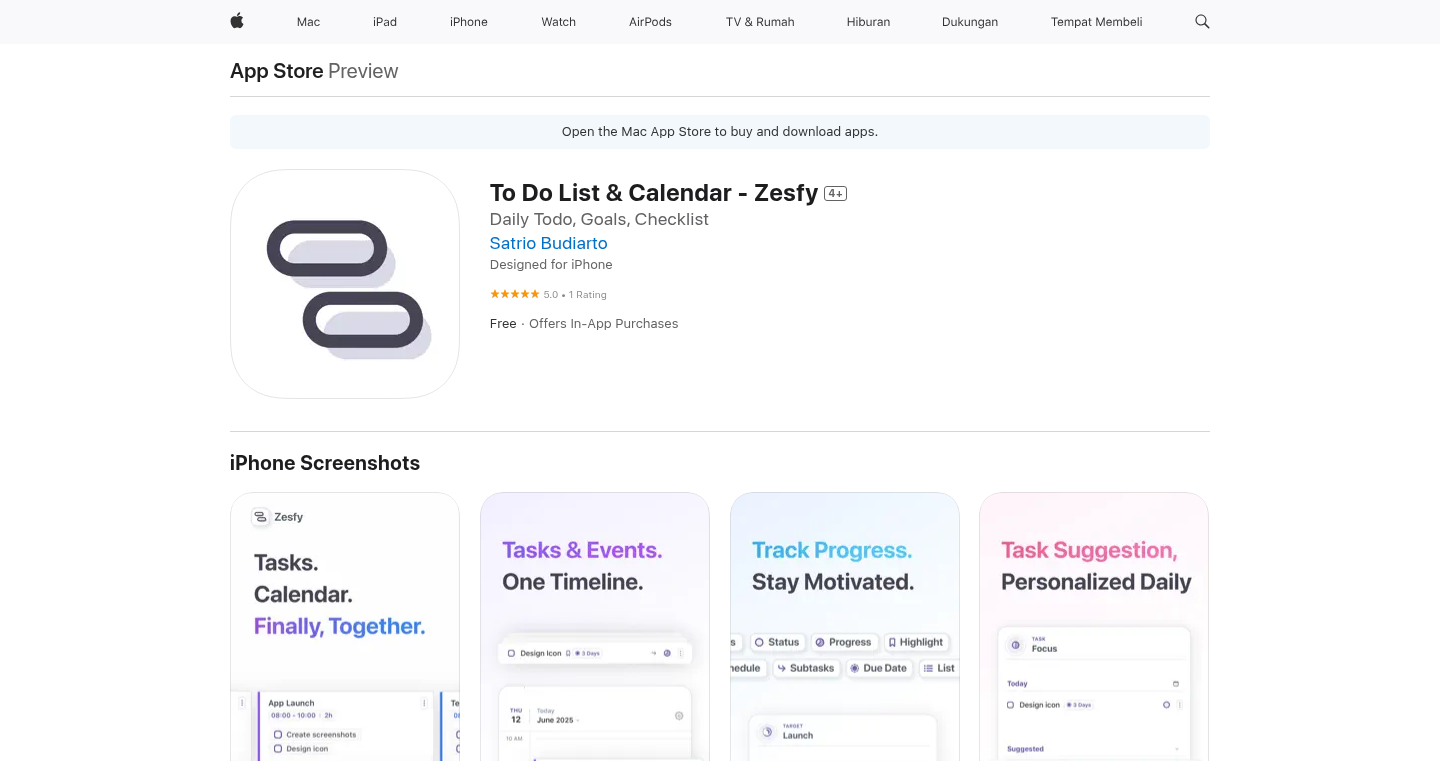
Author
zesfy
Description
TaskFlow is a handy web application designed to automatically convert your weekly to-do list into daily tasks. It analyzes your weekly goals and intelligently distributes them across the days of the week, saving you time and effort in planning your daily schedule. The core innovation lies in its natural language processing (NLP) capabilities, allowing it to understand the context and priorities of your tasks and generate a sensible daily task breakdown. It addresses the common problem of inefficiently managing weekly goals by offering an automated solution.
Popularity
Points 1
Comments 0
What is this product?
TaskFlow uses advanced NLP techniques, similar to how your phone's virtual assistant works, to understand the meaning of your weekly tasks. It then employs algorithms to break down these tasks into manageable daily steps. Think of it as a smart planner that does the hard work of organizing your to-do list for you. So this is useful because it automatically adapts your big goals into daily actionable items.
How to use it?
Developers can interact with TaskFlow through a simple web interface. You would simply input your weekly to-do list, and the application will generate a daily task list. You could also integrate it into your existing project management tools or personal productivity apps by using its API (if available). The generated daily lists can be easily exported and used within your preferred task management systems. So this allows for flexible integration into your existing workflow.
Product Core Function
· Weekly Task Input: Allows users to enter their weekly to-do items, either manually or through copy-pasting. The value is the starting point for the entire process: without input, no output.
· NLP-based Task Analysis: Employs NLP to analyze the weekly tasks, understanding their content and intent. This is valuable as it enables the application to comprehend the tasks' nature, dependencies, and priorities without manual intervention.
· Daily Task Generation: Breaks down the weekly tasks into daily assignments, optimizing the distribution based on factors such as urgency and estimated time needed. This is valuable because it transforms long-term goals into actionable daily activities.
· Prioritization and Scheduling: Uses intelligent algorithms to prioritize tasks and schedule them across the days of the week. This ensures that important tasks are addressed promptly. So this allows you to be more focused on important tasks, improving overall productivity.
· Export and Integration: Provides options to export the daily task lists and integrate them with various productivity and project management tools. This is valuable as it makes the results of TaskFlow easily accessible and usable in other applications.
Product Usage Case
· Personal Productivity: A user can input their weekly goals (e.g., 'Complete Project Report,' 'Exercise 3 times'). TaskFlow intelligently breaks these down into daily tasks like 'Write Introduction (30 minutes)' or 'Go to the gym (60 minutes)'. So this is useful because it provides structure to chaotic weeks.
· Project Management: A project manager inputs project milestones and tasks. TaskFlow automatically assigns daily tasks to team members, helping to keep the project on track. So this facilitates efficient team collaboration.
· Content Creation: A blogger inputs their weekly content plan. TaskFlow breaks it down into daily tasks, such as 'Write first draft of blog post' or 'Edit images'. So this assists content creators with task decomposition.
· Academic Planning: A student inputs their weekly assignments and study goals. TaskFlow can generate a daily schedule that balances study sessions and assignment deadlines. So this helps students manage time effectively.
85
mdts - Markdown Tree Server
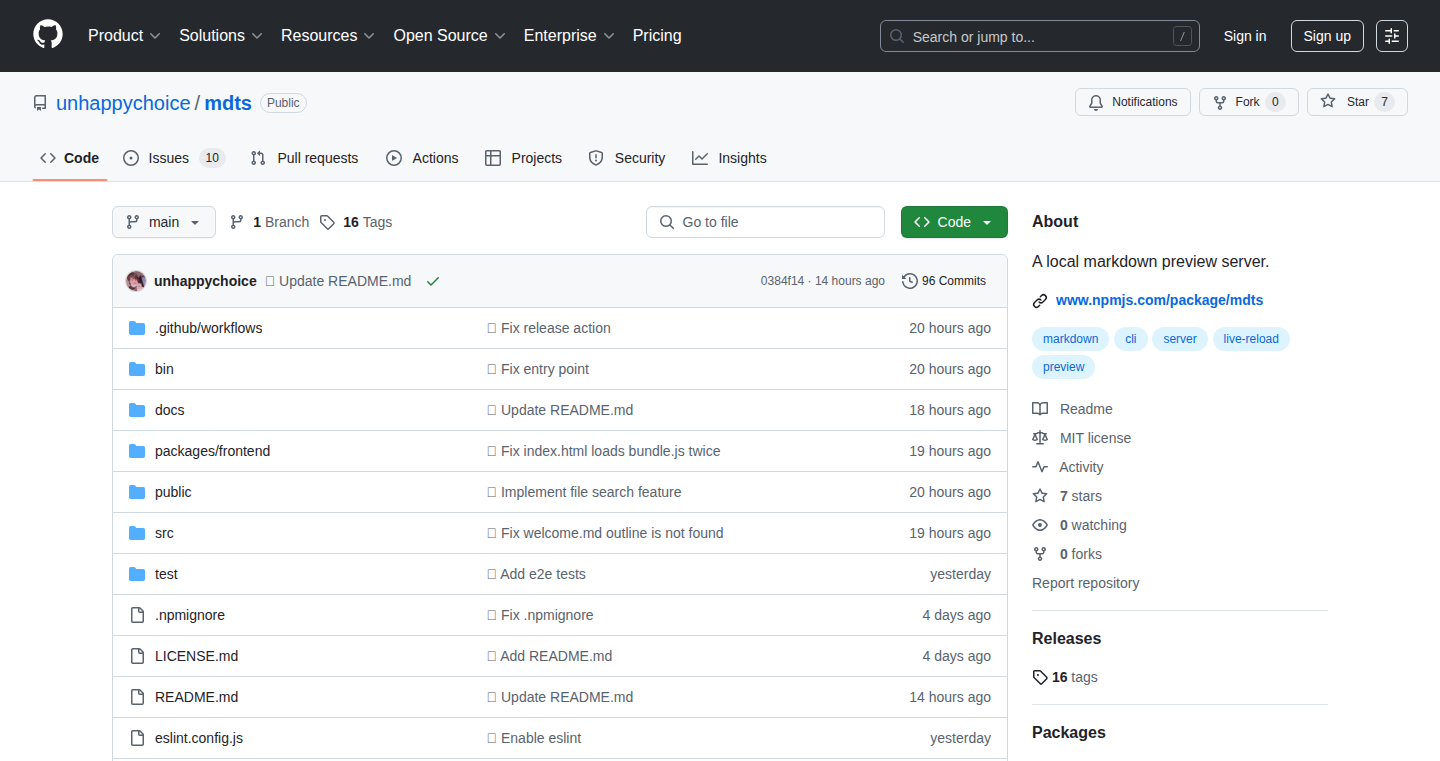
Author
unhappychoice
Description
mdts is a command-line tool that allows you to easily serve your local Markdown files from a directory, presenting them with a web-based interface that includes a file tree for navigation. The core innovation lies in its simplicity: it requires zero configuration and provides instant previews of your Markdown content within your web browser. It solves the common problem of easily browsing and navigating through local Markdown files, making it ideal for personal notes, documentation, and wiki structures.
Popularity
Points 1
Comments 0
What is this product?
mdts is essentially a tiny web server specifically designed for Markdown files. It works by taking a directory containing Markdown files and creating a web-based interface. This interface features a file tree, allowing you to navigate your files, and it instantly renders the Markdown content, providing a preview in your browser. The innovation is its ease of use; you launch it with a single command. It leverages technologies like a simple web server (likely built with Node.js or a similar framework) to serve files, and a Markdown parser to convert the `.md` files into HTML for display in the browser. So this allows you to quickly view and navigate your markdown documents in an easy-to-use web format.
How to use it?
Developers can use mdts by navigating to a directory containing Markdown files in their terminal and running the `mdts` command. This starts the server, and opens the Markdown content in a web browser automatically. It’s integrated as a global CLI tool, meaning the user can use it from any terminal/command line and from any directory. For instance, to browse a documentation folder, you would simply `cd` into that folder, type `mdts`, and your documentation would be available in your browser. You can integrate mdts into your workflow for quickly reviewing documentation, personal notes, project documentation or creating a simple knowledge base. It can be used with CI/CD pipelines, where you want to render documentation.
Product Core Function
· File Tree Navigation: The most important feature allows users to browse files through the browser in a file tree format. This is useful in accessing your markdown files quickly.
· Instant Markdown Preview: When you click on a Markdown file in the file tree, the content is instantly rendered and displayed in the browser. This is useful for quickly previewing and reviewing your Markdown files without manually opening each file.
· Zero Configuration: The simplicity is valuable, as the user can start the server and view markdown content with only a single command from the terminal. This speeds up the process and makes it useful.
· Local Directory Serving: It serves markdown files locally, allowing users to keep their content private and accessible only from their local machine. This is important for security, keeping all documents on the local machine.
Product Usage Case
· Personal Note-Taking: A developer can use mdts to easily browse and organize their personal notes written in Markdown. By organizing notes into folders and subfolders and using mdts, notes are easily found and quickly read.
· Project Documentation: Developers can use mdts to preview and navigate project documentation in Markdown. The documentation can be hosted locally and quickly displayed when needed for review or reference.
· Knowledge Base Creation: Using mdts, a team or individual can create a simple knowledge base for their projects or internal documentation. It provides a simple way to navigate through a collection of Markdown files, enabling a useful, quick and accessible documentation system.
86
GoChallenges: Interactive Golang Learning Platform
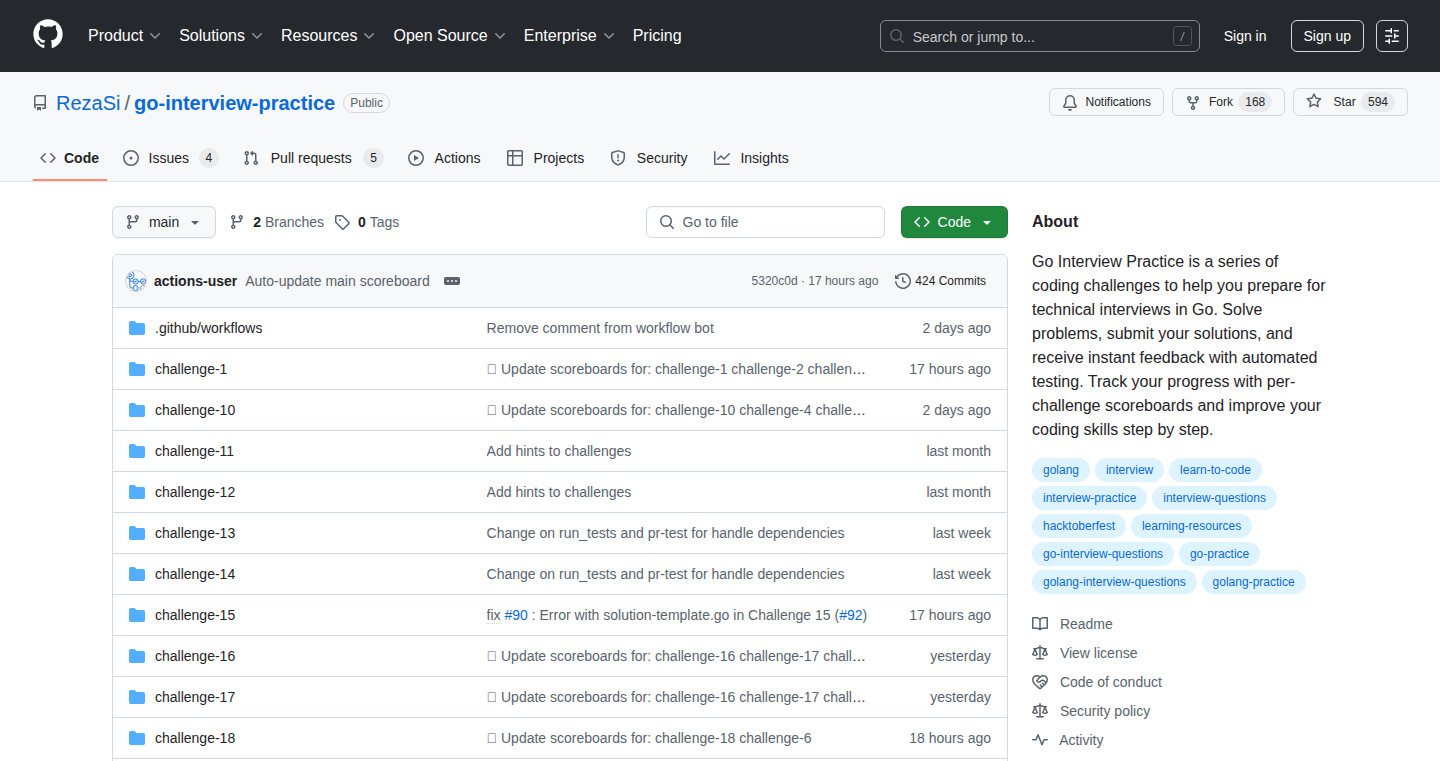
Author
RezaSi
Description
GoChallenges is an interactive platform designed to help developers learn the Go programming language through hands-on challenges. It allows users to write, run, and test Go code directly within the browser, fostering a learn-by-doing approach. The project's technical innovation lies in its ability to execute and validate Go code in a sandboxed environment, preventing any security risks and providing instant feedback on the user's solutions. This addresses the common problem of the steep learning curve associated with learning new programming languages by providing an engaging and immediate feedback loop.
Popularity
Points 1
Comments 0
What is this product?
GoChallenges is like a playground for learning Golang. It allows you to write Go code directly in your web browser and see the results instantly. The innovation lies in how it safely runs your code in the background, without compromising your computer's security. It validates your code to check if it meets the challenge requirements, providing immediate feedback. So, it's essentially a safe and interactive way to practice and master Go.
How to use it?
Developers can use GoChallenges by navigating to the platform in their web browser and selecting a challenge. They then write Go code in the provided editor, which is then executed in a secure environment. The platform provides feedback on whether the solution is correct, along with any compilation errors. You can use it to learn and practice Go, to test your code snippets, or to quickly prototype Golang solutions. For example, a developer could use it to quickly test a regular expression in Go or learn how to write a simple web server.
Product Core Function
· Interactive Code Editor: This feature provides a web-based editor where users can write and modify Go code. It eliminates the need for local setup and allows for code experimentation directly in the browser. So, it allows developers to jump directly into coding without any initial environment setup.
· Real-time Code Execution: GoChallenges instantly executes the user's code and displays the results. This feature enables rapid experimentation and immediate feedback on the code's behavior. Therefore, it enables quick iteration and rapid learning by allowing users to see the results of their code immediately.
· Automated Testing and Validation: The platform automatically checks the user's code against the challenge's requirements, giving instant feedback on correctness. It ensures that the code meets the specified criteria. So, it helps developers confirm their solution is accurate and learn through automated assessment.
· Sandboxed Execution Environment: The execution environment is isolated, preventing malicious code from affecting the user's system. This feature maintains a secure and safe environment. Hence, it provides a secure and isolated way to execute code and prevents unintended consequences.
· Challenge-Based Learning: GoChallenges presents learning materials in the form of interactive challenges, providing a structured learning experience and increased engagement. Therefore, it provides a structured and engaging way to learn Go.
Product Usage Case
· Quick Prototyping: A developer can rapidly prototype a new feature in Go without needing to set up a local Go environment. This allows for quickly testing ideas and validating assumptions. So, you can quickly test your idea using a live playground.
· Learning and Education: Students or junior developers can use GoChallenges to learn the basics of Go or to practice coding exercises. This fosters practical skills and improves their understanding of the language. Therefore, it accelerates the learning process for new Go programmers.
· Code Snippet Testing: Developers can use it to test snippets of Go code before integrating them into a larger project. This improves code quality and reduces errors. Thus, you can ensure your small code snippets function as intended without integrating to the whole project first.
· Problem Solving Practice: Developers can use GoChallenges to practice common coding challenges, honing their problem-solving skills. Thus, it helps developers improve their problem solving ability with dedicated practices and tests.
87
Panda.chat: End-to-end Encrypted LLM

Author
wwwee98
Description
Panda.chat is a privacy-focused AI chatbot built on end-to-end encryption using Trusted Execution Environments (TEEs). This means your conversations are protected from prying eyes, including the developers themselves. It leverages powerful AI models like Deepseek R1 and Llama 4 Scout, ensuring both privacy and performance. The project's open-source nature and Ethereum code hash verification further enhance transparency and trust.
Popularity
Points 1
Comments 0
What is this product?
Panda.chat is a secure and private chatbot. It works by running AI models inside a special, protected area on your computer's graphics card (TEE). This secure area encrypts your messages from the moment you type them until the AI responds, and prevents anyone from accessing them. The creators even publish a digital 'fingerprint' of the code on Ethereum to prove that the system hasn't been tampered with. So, this is like having a private conversation with an AI, where only you and the AI can 'hear' the content. So, this protects your sensitive information and conversations, preventing them from being logged or used for other purposes.
How to use it?
Developers can use Panda.chat as a secure foundation for building privacy-conscious applications. They can integrate the provided open-source code to create chatbots or other AI-powered services that prioritize user data protection. You can use Panda.chat by visiting the website, and typing your questions like you would in ChatGPT. So, if you're building an application that handles sensitive information, you can adapt Panda.chat's secure framework to ensure user privacy.
Product Core Function
· End-to-end Encryption: This encrypts your messages before they leave your device and decrypts them only after the AI generates a response. So, your conversations remain private, even from the service provider. The application of this feature ensures privacy, especially in contexts where sensitive information is discussed, such as medical or financial advice.
· Trusted Execution Environment (TEE): Panda.chat uses TEEs within the GPU to isolate and protect the AI model and your data. This prevents unauthorized access and manipulation of your conversations. This has huge implications for security, as it provides a hardware-level safeguard against data breaches and other vulnerabilities.
· Open-Source Code: The project's open-source nature allows for public scrutiny and auditing of the code. Anyone can review the code to verify its security and privacy claims. This provides transparency and builds trust within the community.
· Ethereum Code Hash Verification: The project publishes a cryptographic 'fingerprint' of the code on Ethereum. This acts as proof that the code running the service hasn't been altered or compromised. This helps ensure the integrity of the platform.
· AI Model Integration: Panda.chat integrates powerful AI models like Deepseek R1 and Llama 4 Scout to provide high-quality responses while maintaining privacy. This ensures that you're not sacrificing performance for the sake of privacy.
Product Usage Case
· Secure Chatbot for Healthcare: A healthcare provider could use Panda.chat's framework to build a chatbot that offers medical advice or mental health support, ensuring that patient information remains confidential. This solves the privacy concerns associated with sharing sensitive health data.
· Privacy-focused Financial Advisor: A financial institution could use Panda.chat to create a secure AI-powered financial advisor that offers personalized advice without compromising the user's financial information. This solves the potential for data breaches and maintains customer trust.
· Secure Document Analysis: A legal firm could utilize Panda.chat to create a secure system to analyze confidential legal documents using AI, without the risk of data leaks or unauthorized access. This application ensures the confidentiality of the legal information.
· Private Code Generation Tool: A developer could use Panda.chat as a base to create a tool that generates code privately, ensuring that their intellectual property remains protected. This solves the risk of leaking sensitive code during AI-assisted coding tasks.
88
Askk: Reviving YouTube Poll Cards with a Chrome Extension
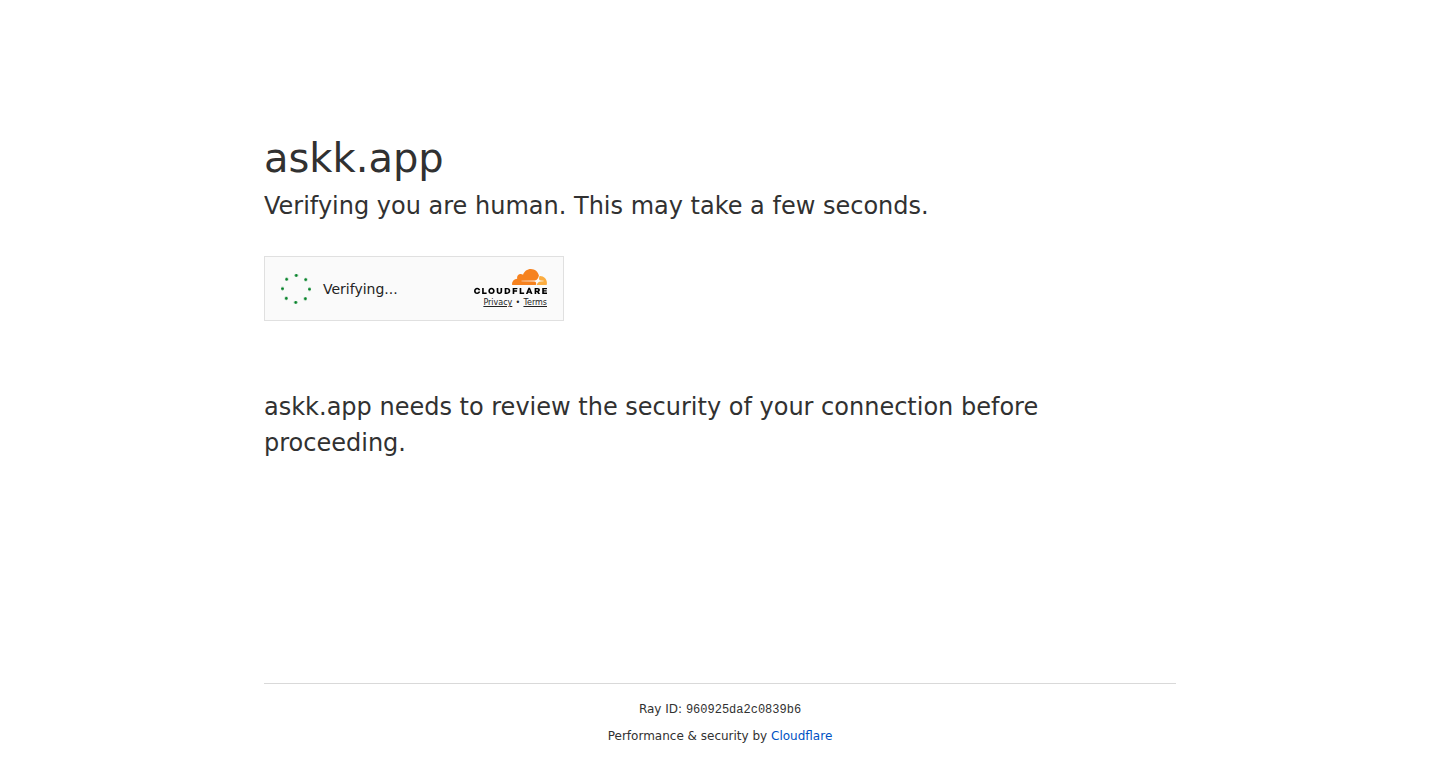
url
Author
yassino
Description
Askk is a Chrome extension that brings back the functionality of YouTube poll cards, which were discontinued by YouTube. It allows creators to engage with their audience by displaying interactive questions at specific times in their videos. This project demonstrates a resourceful solution to a problem faced by many YouTube creators, leveraging the power of browser extensions to restore a valuable feature. It showcases a practical application of web development, allowing the creator to quickly and efficiently implement a solution and make it immediately available to users. So this is useful because it restores an essential feature for audience engagement on YouTube that was removed, improving creator-viewer interaction and content engagement.
Popularity
Points 1
Comments 0
What is this product?
Askk is a Chrome extension that recreates the interactive poll card feature within YouTube videos. This is achieved by injecting custom code into the YouTube video player, allowing the extension to display questions at designated timestamps and capture user responses. The core innovation lies in its ability to circumvent YouTube's decision to discontinue the poll cards by creating a workaround. This means creators can directly interact with viewers via polls within videos, without needing YouTube's original feature. So this means you can get audience feedback, and improve your content based on audience preference.
How to use it?
Developers can use Askk by installing the Chrome extension. After installation, when viewing YouTube videos, creators can configure the extension to display polls at specific points in their videos. The creator defines the questions and answer options. Viewers then interact with the polls directly within the video player. This tool can be integrated into existing YouTube workflow. So this lets content creators immediately re-enable the feature and engage with audiences using a format they already knew and were familiar with.
Product Core Function
· Displaying Interactive Polls: Askk allows creators to add multiple-choice questions that appear at specific times within a YouTube video. This uses JavaScript to manipulate the DOM (Document Object Model) of the YouTube player and create a custom overlay.
· Collecting Viewer Responses: The extension captures viewer responses to the polls. The responses can be collected and stored for creator analysis. It likely utilizes local storage or, in the more advanced versions, some external data storage solution for the responses.
· Timestamp-based Triggering: The polls appear at preset times in the video, allowing creators to time them with specific segments of their content. It leverages JavaScript's ability to monitor the video's current time and trigger actions based on it.
· User-Friendly Interface: The extension provides an easy-to-use interface for creators to configure the polls, including question text, answer options, and the timing of the polls. It enhances audience participation and feedback in a fun and easy way.
Product Usage Case
· Content Analysis and Feedback: A gaming channel could use Askk to ask viewers about their favorite in-game characters during a gameplay video. The feedback can be then used for video editing and future content.
· Audience Engagement & Content Optimization: An educational channel can use Askk to quiz viewers on the material covered in a video. The responses could be aggregated to measure viewers' understanding and tailor future videos to those gaps.
· Live Q&A Sessions: A live streamer could use Askk to conduct real-time Q&A sessions with viewers, gathering questions and displaying polls directly within the video stream.
· Product Reviews: A reviewer could use it to gather feedback on product features from viewers, for example, by asking viewers whether or not they have seen a particular feature or whether it is useful.
89
Entra Copilot: Interactive Azure AD Education and Prototyping
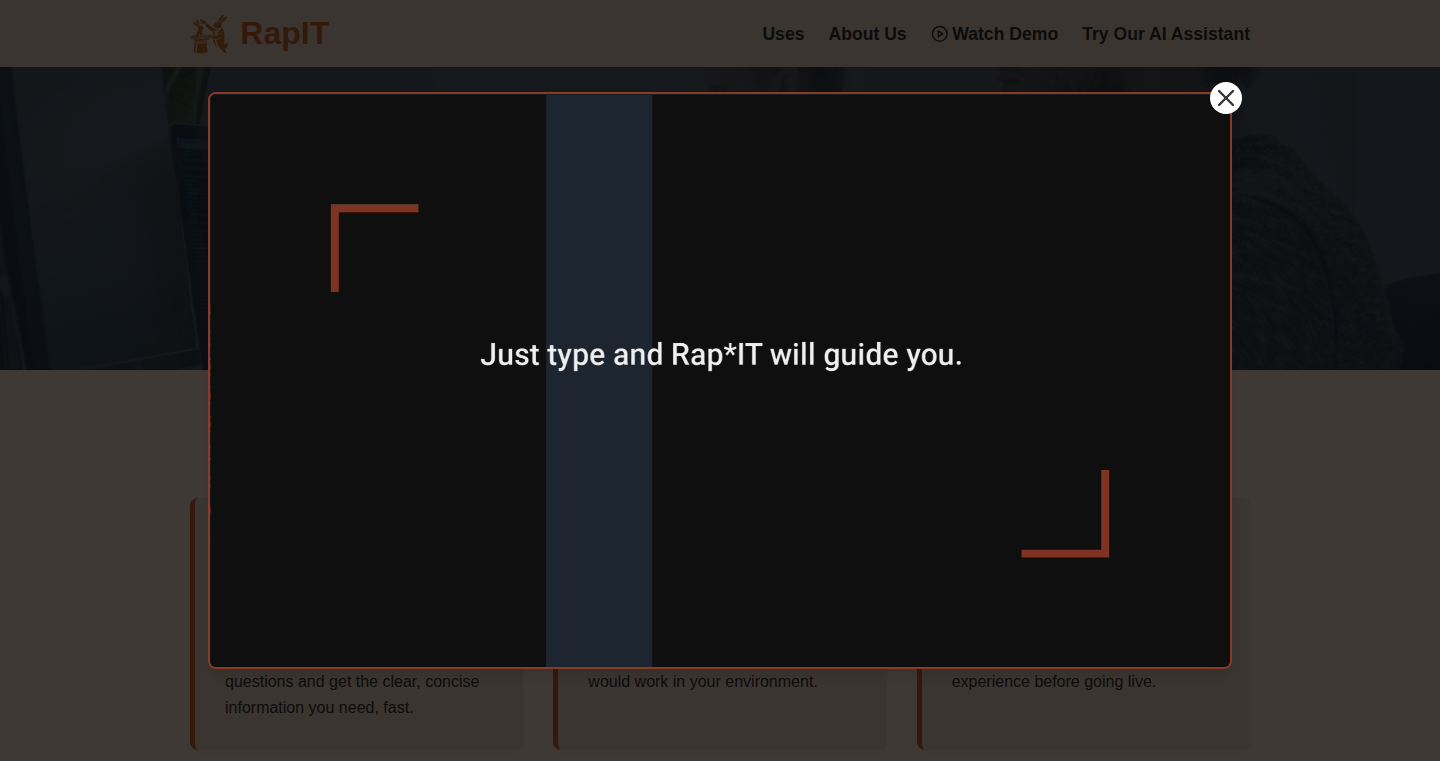
Author
gritlin
Description
This project is an 'AI Copilot' specifically designed for developers working with Microsoft Entra External ID (formerly Azure Active Directory B2C) for external user authentication. It acts as a teacher, providing explanations and helping to prototype solutions for common authentication challenges. The innovation lies in its interactive approach, guiding users through the complexities of Entra ID configuration and allowing them to quickly build and test authentication flows.
Popularity
Points 1
Comments 0
What is this product?
This is an AI-powered tool to help developers understand and implement authentication and authorization systems using Microsoft Entra External ID. It breaks down complex concepts into understandable steps and allows users to experiment with different configurations without needing to become full-blown experts immediately. Its like having a knowledgeable mentor to guide you through the process. So what is the technical principle behind it? It uses a combination of natural language processing (NLP) to understand user queries and generate relevant code snippets, configuration instructions, and explanations. This simplifies the process of building and managing authentication systems. And it can also help users generate prototype solutions.
How to use it?
Developers can interact with the Copilot by asking questions about Entra External ID features, such as setting up multi-factor authentication (MFA), customizing user flows, or integrating with other services. The Copilot will provide step-by-step instructions, code samples, and configuration guides. It can also help you prototype different authentication flows to determine if the product is the right fit for your requirement. The Copilot is expected to integrate with the developer’s workflow, assisting at every stage from the initial planning to debugging. So, you can use this in your daily development cycle, especially when working on any product that needs user login.
Product Core Function
· Interactive Learning: The Copilot answers questions about Entra ID in plain language, making it easier for beginners to understand the concepts and functionalities.
· Prototype Generation: The Copilot helps users generate working authentication flows and configurations, allowing for rapid experimentation and testing.
· Code Snippet Assistance: Provides code snippets and configuration examples, accelerating the development process and reducing the need for manual coding.
· Configuration Guidance: Offers step-by-step instructions on setting up and customizing Entra ID features, simplifying complex configurations.
· Debugging Assistant: Help users to identify and resolve common authentication issues, saving time and effort during troubleshooting. So, this can help you fix bugs in a short amount of time.
Product Usage Case
· Building a Login Flow: A developer can use the Copilot to quickly set up a custom login flow for a web application, including social logins and multi-factor authentication. This significantly reduces development time compared to manually configuring the authentication process. So, this helps speed up your product release.
· Customizing User Profiles: The Copilot assists in creating a customized profile management page for users, allowing them to update their information. This creates better user experience.
· Integrating with APIs: Developers can utilize the Copilot to generate code that integrates with APIs, ensuring secure access control. It helps you to protect your API's data.
· Troubleshooting MFA Issues: When dealing with multi-factor authentication (MFA) setup or access problems, the Copilot's debugging assistance identifies and resolves configuration issues.
· Simulating different authentication scenarios: Developers can easily experiment with different authentication methods and flows. So you can pick the best one for your needs
90
StackView: Your App's Tech Stack Navigator
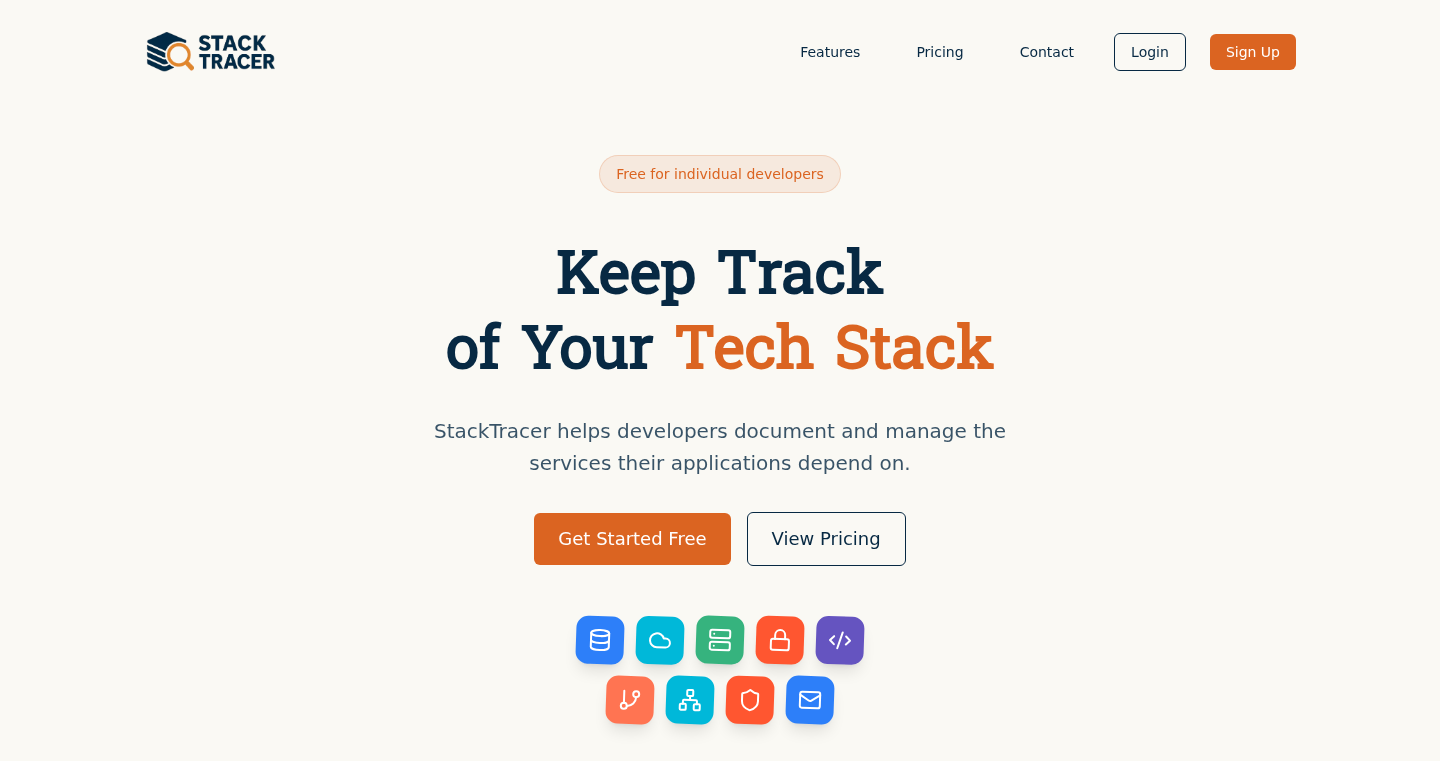
Author
10xdevdotio
Description
StackView is a web application designed to help developers document and manage the third-party services their applications are using. It eliminates the tedious process of rummaging through code repositories and bookmarks to find the services and technologies associated with a project. This is a time-saving solution for developers facing the constant challenge of keeping track of their project dependencies. So this helps me quickly understand and manage all the technologies involved in my projects, ultimately saving me time and effort.
Popularity
Points 1
Comments 0
What is this product?
StackView works by allowing developers to document their software portfolio, including the technologies and third-party services utilized in each application. Think of it like a digital 'tech stack index' for your projects. Its core innovation lies in simplifying the process of tracking and visualizing the dependencies of your apps. Instead of manually searching, you can get a quick overview of everything that is powering your application. So this means I can quickly understand what my projects are built with and see all their dependencies in one place.
How to use it?
Developers can use StackView by creating entries for each of their projects, then listing the technologies, services, and third-party libraries used by each project. Information is entered manually, allowing users to customize entries based on their needs. The data is then stored, making it easy to view a project's tech stack at a glance. You can then reference this information to maintain consistency and reduce friction when working on multiple projects. So this means I can easily maintain documentation and better understand my own projects, which in turn makes team collaboration more effective.
Product Core Function
· Project Documentation: The primary function is to create and manage a directory of all projects and the technologies associated with them. This is a simple, centralized way to track all third-party services and libraries used in a project. Use case: Maintaining a consistent record of all services used, avoiding issues when re-visiting old projects.
· Tech Stack Visualization: Displaying the different components (like APIs, libraries, and databases) used by each project. Users can use this function to have a clear overview of a project's dependencies. Use case: quickly grasping the technical architecture of an application.
· Third-Party Service Tracking: Keep track of external services like payment gateways, authentication providers, and other cloud services used within a project. Use case: avoiding security risks, and streamlining updates.
Product Usage Case
· During a code audit: When taking over a new project, a developer can quickly use StackView to understand the existing tech stack, dependencies, and external services. This reduces the learning curve.
· Managing API keys and settings: Instead of searching in many places, developers can use StackView to document API keys, their uses, settings, and more. It can be stored and updated in a central place.
· Onboarding new team members: New team members get a clear overview of the technology used in a project, without having to read through the entire code or ask multiple questions. Faster onboarding, less wasted time, and easier project maintenance.
91
MCP Adapter: The AI Tool Orchestrator

Author
tartakovsky
Description
MCP Adapter is a clever piece of software that acts as a central hub for your AI coding assistants (like Cursor, Claude, and Copilot). It lets these AI tools connect to other services and tools you use in your daily development workflow. The core innovation is providing a secure and controlled way for AI to interact with your tools, preventing security risks and performance issues that can arise from giving AI unrestricted access. So, it’s like having a smart traffic controller for your AI helpers, ensuring they work smoothly and safely.
Popularity
Points 1
Comments 0
What is this product?
MCP Adapter is essentially a middleman. When your AI coding assistant needs to use another tool or service (like a database or a testing framework), it goes through MCP Adapter. The Adapter manages the connection, ensuring that the AI can access the tool securely and efficiently. The underlying technology is based on a gateway architecture, which allows it to route requests, handle authentication (like usernames and passwords), and control which tools the AI can use. The core technical innovation is in providing a single, manageable point of control for AI access, which is crucial for scalability and security. So this allows your AI tools to access other tools without giving them the keys to the kingdom.
How to use it?
Developers integrate MCP Adapter by configuring their AI coding assistants to communicate through it. They define which tools the AI should have access to and set up authentication details. Then, whenever the AI needs to use a tool, the Adapter intercepts the request, authenticates it, and forwards it to the correct tool. This allows developers to create a controlled environment where they can safely use AI to automate parts of their development workflow. So it enables developers to manage and control how their AI coding assistants interact with other development tools.
Product Core Function
· Tool Routing: MCP Adapter intelligently directs requests from the AI assistant to the appropriate external tools. This streamlines the process and ensures the right tools are used at the right time. So this helps your AI tools work correctly.
· Authentication Handling: It securely manages authentication, ensuring the AI assistant can access tools only with the proper credentials. This protects your sensitive information. So you don't have to worry about your passwords being exposed.
· Access Control: Developers can configure which tools the AI assistant can access, which helps prevent security breaches and optimizes the performance of the AI assistant. So this protects your tools and systems from misuse.
· Centralized Management: Offers a single, central point for managing how AI assistants interact with other services. So this simplifies the setup and maintenance of your AI workflow.
Product Usage Case
· Automated Code Review: Imagine using an AI assistant to review code and access a testing framework. With MCP Adapter, the AI can securely connect to the testing framework, run tests, and report the results back. So, you can have a system that checks your code automatically.
· Database Interaction: If an AI assistant needs to interact with a database to fetch or update information, MCP Adapter can handle the connection and provide access controls. So you can protect your database from unwanted access by AI tools.
· Continuous Integration: In a continuous integration/continuous deployment (CI/CD) pipeline, MCP Adapter can allow an AI assistant to trigger builds and deployments through a controlled gateway. So you can automate your deployment process more safely.
92
Phoaiart: Conversational AI Photo Editor
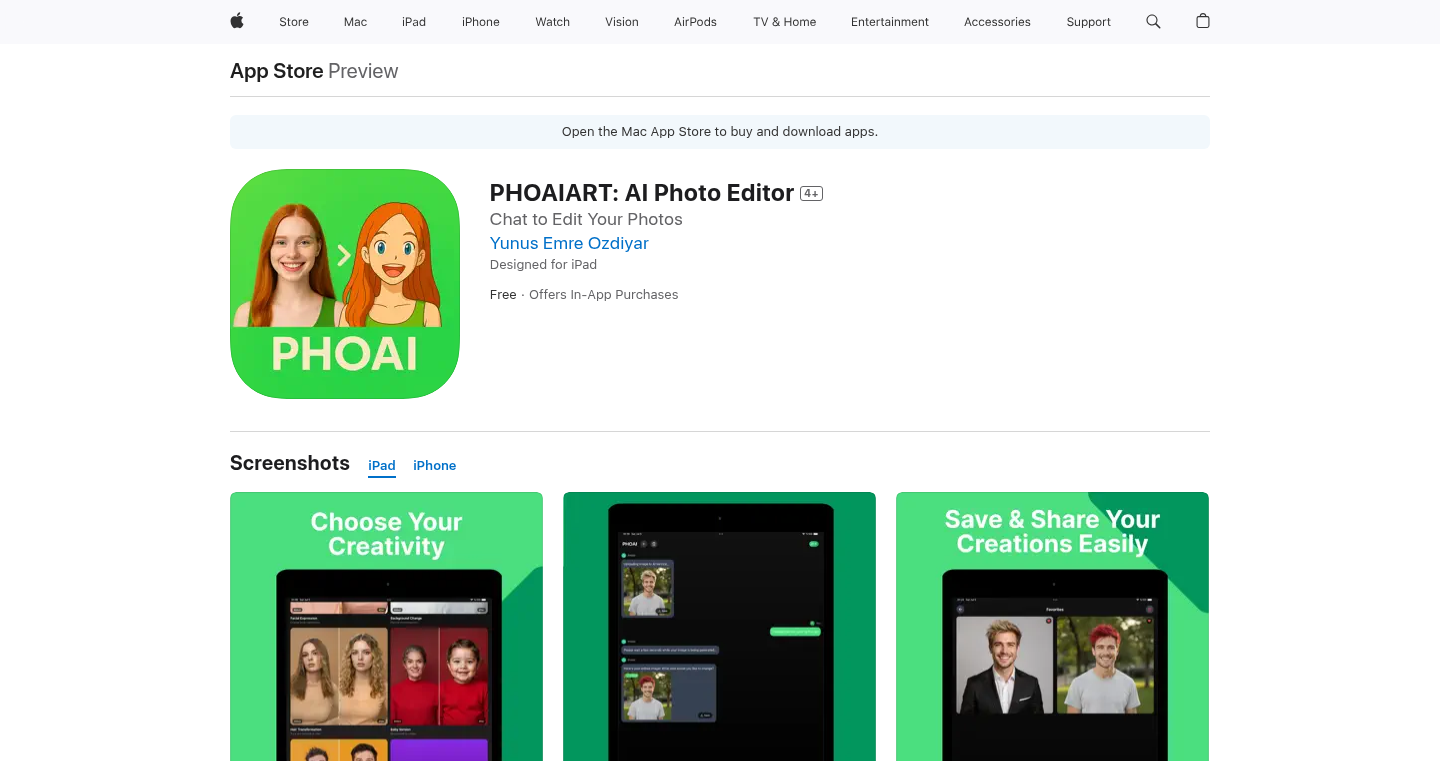
Author
incendies
Description
Phoaiart is an innovative photo editor that allows users to edit images using natural language. Instead of complicated buttons and sliders, you simply chat with the AI, telling it what you want to change (e.g., "make the sky blue") and the AI instantly makes the changes. This leverages cutting-edge AI and machine learning technologies, specifically Flux Kontext, to understand and execute complex image transformations based on simple text commands. It solves the problem of complex and time-consuming photo editing by making it as easy as texting a friend.
Popularity
Points 1
Comments 0
What is this product?
Phoaiart is a photo editing application powered by Artificial Intelligence. It uses a technology called Flux Kontext to understand your natural language commands and then automatically modify the image accordingly. Imagine you want to change the background of your picture; instead of manually selecting and replacing, you can just tell the app, "remove the background" and it will do it for you. So it leverages the power of AI to simplify image editing, making it accessible to everyone regardless of their technical skills.
How to use it?
Developers can integrate the underlying AI engine (Flux Kontext, though the specific integration details are not provided) into their own applications or projects. This could enable them to add intelligent image editing capabilities. For example, a social media app could use this technology to allow users to easily edit their photos directly within the app. A designer could integrate it with other tools to streamline the image creation process. Or, a developer can leverage similar frameworks to experiment with building their own intelligent applications. Phoaiart utilizes React Native for the core app logic, along with Firebase (Firestore + Auth) for backend operations, therefore, other developers can learn from this architecture.
Product Core Function
· Natural Language Processing (NLP) for command interpretation: The core of Phoaiart is its ability to understand and process instructions in everyday language. It transforms human-understandable language into actionable commands for image manipulation. This simplifies complex image editing tasks.
· AI-powered image transformation: Flux Kontext, the technology driving Phoaiart, performs intelligent image modifications based on user commands. This includes tasks like changing colors, removing backgrounds, or adjusting the overall look of the image, all automatically.
· User-friendly interface: The app’s chat-based interface eliminates the need for manual adjustments using sliders and buttons. This design makes image editing more accessible and faster.
· Real-time editing: The app provides almost instant results, allowing users to preview the effect of their commands in real-time.
· Mobile-first design: Built using React Native, the app is accessible on the go. This allows users to edit images anywhere, anytime, without a desktop computer.
Product Usage Case
· Social Media Integration: A social media platform could embed this technology to allow users to edit their photos directly within the application, enhancing user engagement and photo quality. So users don't need to switch between applications and can achieve high-quality images.
· E-commerce Product Photography: E-commerce businesses could use this tool to quickly edit product images, such as changing background colors or removing unwanted elements. This could help to streamline the product image creation process and save time.
· Graphic Design Tools: Graphic designers could integrate this technology into their design workflow to automate repetitive image editing tasks, such as removing backgrounds or adjusting colors, speeding up design projects and creating more visual material.
93
Reeyee.ai - Visual Website Builder
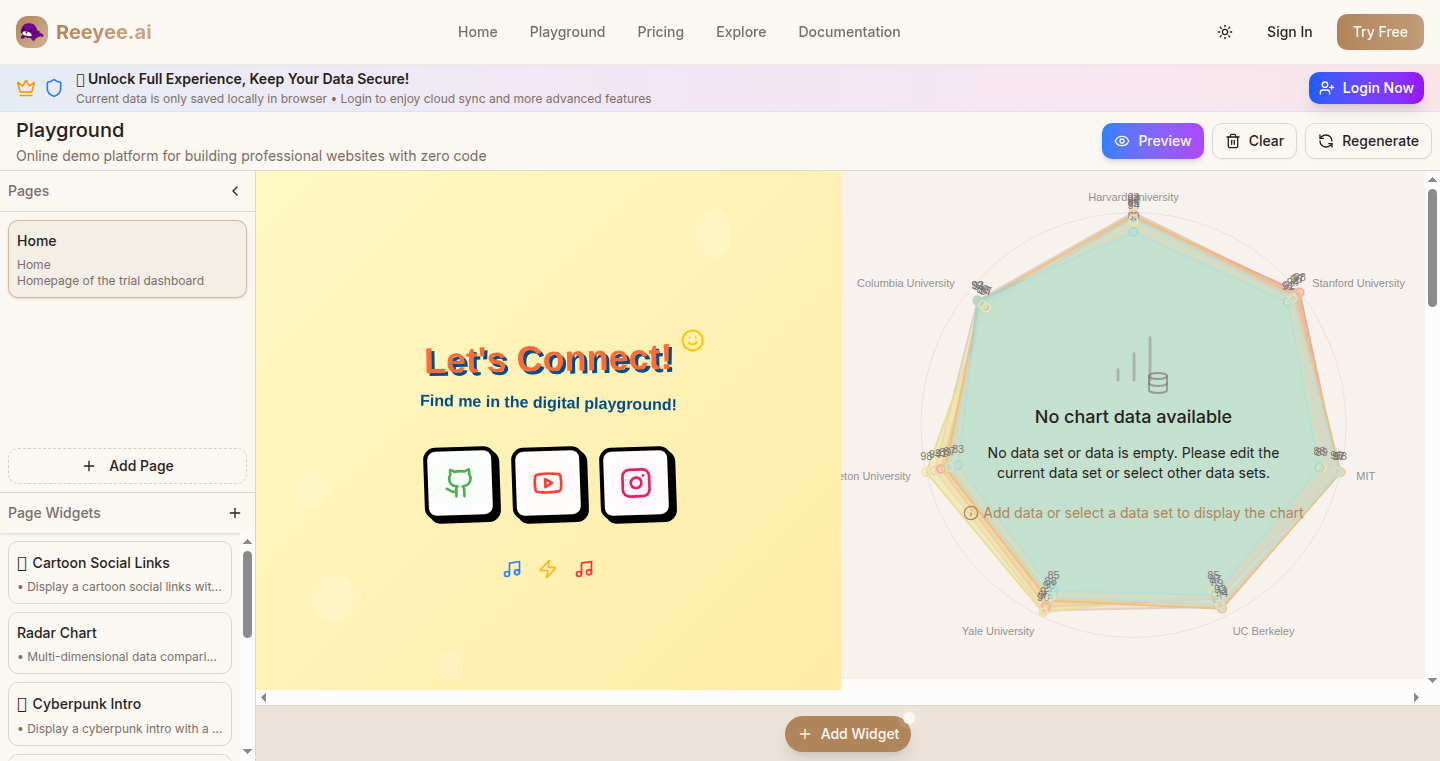
Author
jokera
Description
Reeyee.ai is a tool that allows anyone to build and publish a website visually, without writing any code. It lets you create a website by arranging blocks like text, images, and videos on a dashboard. The key innovation is the combination of a drag-and-drop interface, Notion-style blocks, and instant website deployment. This simplifies website creation and makes it accessible to non-technical users.
Popularity
Points 1
Comments 0
What is this product?
Reeyee.ai is a visual website builder. It works by letting you drag and drop different content blocks (text, images, charts, etc.) onto a dashboard to design your website. Behind the scenes, the tool handles all the technical complexities of creating and hosting a website. It takes inspiration from tools like Notion, but instead of just organizing information, it directly translates your dashboard design into a live, public website. So this is useful because it allows you to quickly create a website without any coding knowledge.
How to use it?
Developers can use Reeyee.ai to rapidly prototype website layouts or create landing pages for their projects. Instead of spending time on front-end development, they can visually assemble the website and then integrate it with their back-end systems. This tool can be integrated with any service or product that needs a website. You can literally launch a website within a few minutes by simply arranging content blocks. The output is a live, fully functional website, hosted by Reeyee.ai (or you can manage your own hosting if that's the choice).
Product Core Function
· Drag-and-drop interface: This allows users to visually arrange content blocks to design their website layout. This is a huge time saver, and it enables anyone with any skill level to build a website. So this is useful because it gets rid of the complex coding.
· Notion-style content blocks: It uses a block-based system, similar to Notion, which allows users to add and customize various content types like text, images, videos, charts, and embedded content. So this is useful because it gives you a modular and flexible way to build a website.
· Instant website deployment: The tool provides one-click publishing, making the website live immediately after the design is complete. This removes the hassle of dealing with hosting, domain names, and other technical aspects. So this is useful because it makes website publishing effortless.
Product Usage Case
· Creating landing pages for SaaS products: Developers can quickly build landing pages to showcase new features or services, testing different layouts and content without writing any code. So this is useful because you can easily change the website with the drag and drop interface
· Building a personal portfolio website: Artists, writers, or anyone wanting to showcase their work can create a professional-looking website in minutes. So this is useful because it is easier than coding a website.
· Developing internal dashboards for projects: Teams can build dashboards to visualize project progress and other data, making it easier to share information. So this is useful because you can quickly assemble and launch internal dashboards.
94
AquaDream: Offline Rain Sounds for Sleep
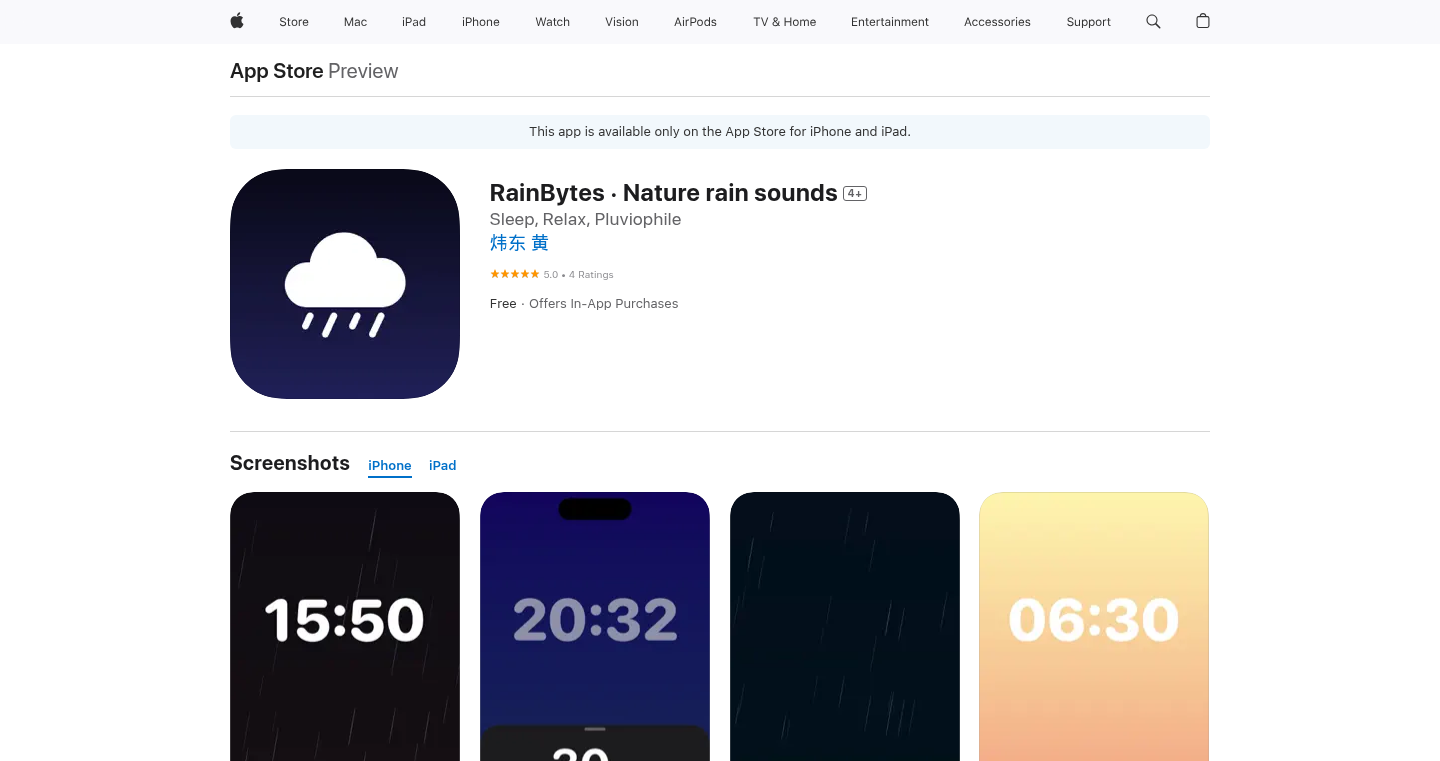
Author
dominichuang
Description
AquaDream is a simple rain sounds application, primarily for iOS and iPadOS, created to help users fall asleep faster. The core innovation lies in its delivery of pure, high-quality rain sounds, designed for offline use, and coupled with smooth rain animations. This addresses the common problem of insomnia by providing a calming auditory and visual environment, without requiring an internet connection or consuming significant device resources.
Popularity
Points 1
Comments 0
What is this product?
AquaDream is an application that generates realistic rain sounds, designed to aid sleep. The technical innovation is its lightweight design, ensuring offline functionality, and smooth rain animations to complement the audio experience. It's built to be energy-efficient, allowing it to run for extended periods without draining the device's battery. So, it's like having a personal rainstorm machine, always ready to soothe you to sleep.
How to use it?
Developers can utilize AquaDream as a reference point for creating sound applications or understanding offline media playback. It showcases how to efficiently manage audio resources, handle offline access, and integrate animations seamlessly. You can incorporate similar techniques in your apps to provide calming audio environments, reduce battery consumption, and ensure functionality even without an internet connection. So, you can learn how to build a resource-efficient app that works anywhere.
Product Core Function
· Offline Audio Playback: The app plays rain sounds without requiring an internet connection. Technical value: This ensures the app works reliably anywhere, even without Wi-Fi or cellular data, maximizing user availability. Application: Useful for creating any app that needs to deliver audio content without relying on an internet connection, such as meditation apps or educational audio guides.
· High-Quality Sound Design: The app focuses on delivering pure, high-quality rain sounds. Technical value: High-fidelity audio enhances the user experience, contributing to the app's effectiveness as a sleep aid. Application: Applicable in any app where audio quality is crucial, for example, podcast players or music streaming services.
· Smooth Rain Animations: The app includes visual rain animations to enhance the user experience. Technical value: Adding visual elements can create a more immersive environment, enriching the relaxation experience. Application: Suitable for use in any app where a calming visual experience can enhance the app’s effectiveness, for instance, nature-themed apps or relaxation tools.
· Lightweight Design: The app is designed to be resource-efficient, running without draining the device’s battery. Technical value: This enhances usability, enabling longer use times and minimizes the app’s impact on the user's device. Application: Useful in any application that requires long-duration running on a mobile device, like fitness trackers or battery-powered gadgets.
Product Usage Case
· Sleep-Aid Application: The app's primary function is to help users fall asleep. In this use case, the technical innovation (offline use, high-quality sound) is vital for providing a reliable and immersive experience. It addresses the user's need to relax, even when away from home or where internet access is poor. So, it solves a real-world problem for people with sleep difficulties.
· Ambient Sound Generator: AquaDream can be used as a general ambient sound generator. By offering offline access and customizability, it provides a continuous calming experience that enhances focus, relaxation, or other activities. This is helpful in creating a peaceful environment.
· Educational Tools Example: The app may be a good example for creating educational tools about audio processing or for beginners to learn sound design within the mobile apps. This provides educational value for developers that want to improve their technical skills and learn something new.
95
CybertraceAI-Ops: Conversational IT Network Navigator
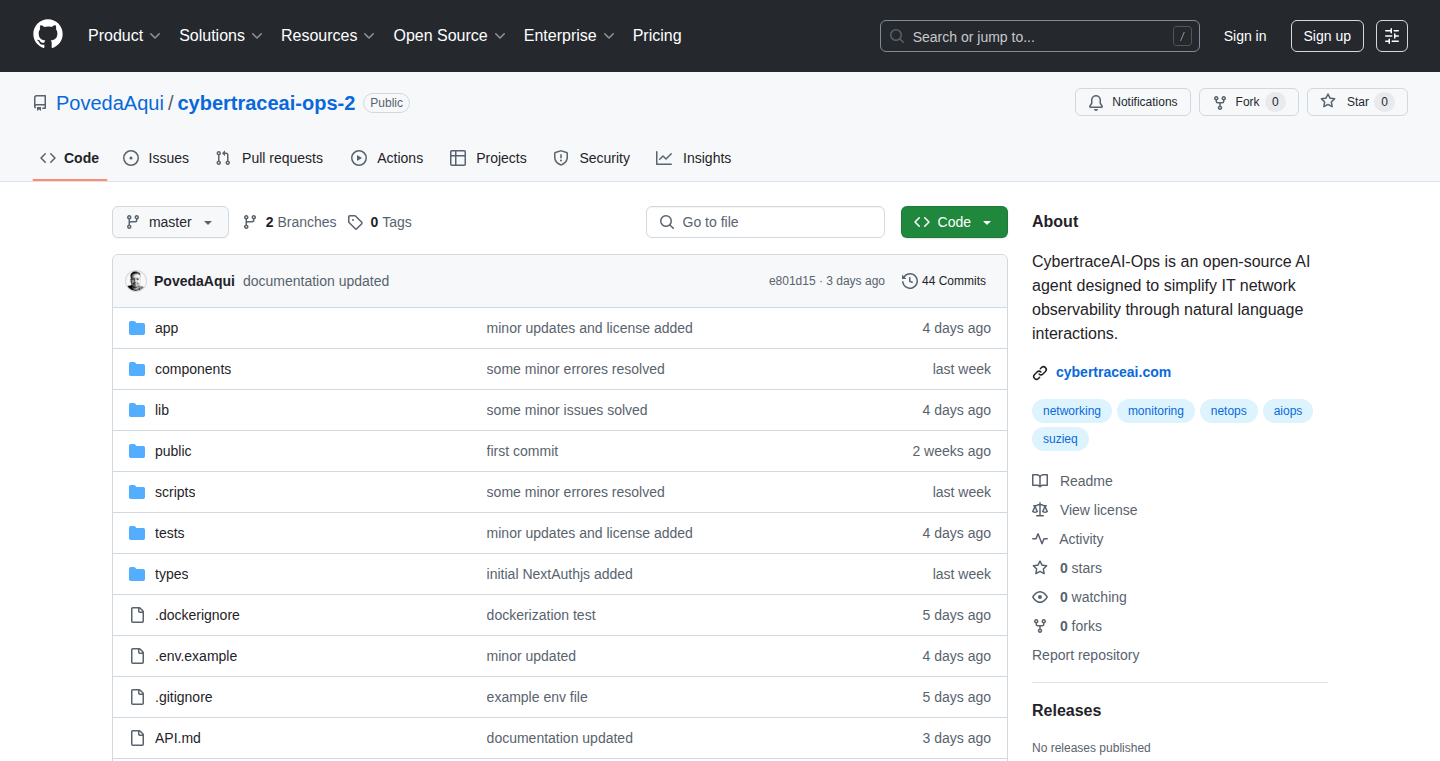
Author
povedaaqui
Description
CybertraceAI-Ops allows you to interrogate your IT network using natural language. Instead of wrestling with complex command-line interfaces or intricate monitoring dashboards, you can simply ask questions like 'Show me all failed login attempts in the last hour' or 'Identify any devices with unusual network traffic'. It leverages the power of AI and natural language processing (NLP) to translate your questions into actionable queries, streamlining network analysis and troubleshooting. This project innovates by simplifying complex IT tasks, reducing the need for specialized technical expertise for basic network investigations. So, this project simplifies network management, making it accessible to a wider audience.
Popularity
Points 1
Comments 0
What is this product?
CybertraceAI-Ops is a tool that lets you 'talk' to your IT network. It uses AI, specifically NLP, to understand your questions phrased in everyday language. Behind the scenes, it translates these questions into the correct commands needed to gather information from your network. It then presents the results in a clear and easy-to-understand format. The innovation lies in making network analysis conversational and accessible. So, instead of memorizing complicated commands, you can simply ask the network what you want to know.
How to use it?
Developers can integrate CybertraceAI-Ops into their existing IT infrastructure. For example, you can use it to build dashboards that display real-time network health, automate routine troubleshooting tasks, or even create custom alerting systems. Integration would involve connecting the system to your network monitoring tools and defining how it interacts with your specific network devices. You could also use it to train custom AI models for even more specialized network inquiries. So, it helps developers create tools that are more user-friendly and less reliant on technical expertise.
Product Core Function
· Natural Language Query Processing: The core function is translating human language into machine-readable queries. It parses your questions and identifies the relevant network components and parameters, allowing for faster information retrieval. For example, 'Show me all devices with high CPU usage' becomes a query that specifically targets CPU utilization data. So, it cuts down on the time spent learning command-line interfaces and parsing complex network logs.
· Network Data Aggregation and Analysis: It gathers data from various network devices and systems, such as firewalls, routers, and servers. It then performs real-time analysis based on your queries. For example, it can correlate events from multiple sources to identify potential security threats. So, it provides developers with a single point of access for network intelligence.
· Automated Reporting and Alerting: The system can automatically generate reports based on specific criteria, and send alerts when unusual activity is detected. Developers can customize these reports and alerts based on their specific needs. For instance, setting up an alert for unusual network traffic from a specific device. So, this enables proactive network monitoring and faster response to potential issues.
· Customizable Interface and Integration: CybertraceAI-Ops offers an API to allow developers to create their own interfaces or integrate the system into existing tools. This enables users to tailor the system to their specific needs and workflow. So, it gives developers the flexibility to adapt the tool to different environments.
Product Usage Case
· Security Incident Response: A security analyst uses CybertraceAI-Ops to quickly investigate a suspicious event. Instead of manually checking multiple logs and dashboards, they simply ask, 'Show me the source of the suspicious traffic'. The system then retrieves the necessary information, allowing the analyst to quickly identify the compromised device. So, it speeds up security investigations.
· Network Troubleshooting: A network administrator uses CybertraceAI-Ops to diagnose a performance issue. By asking, 'What devices are experiencing high latency?' they quickly identify the problematic devices and begin troubleshooting. So, it reduces the time spent on manual troubleshooting.
· Network Monitoring Automation: A developer integrates CybertraceAI-Ops into a dashboard that monitors network health. They create custom alerts that notify them of any unusual network activity, like a sudden spike in traffic. So, it allows developers to build more proactive and automated network monitoring systems.
· Compliance Reporting: A compliance officer uses CybertraceAI-Ops to generate reports on network security and compliance. For example, they can ask, 'Show me all devices that haven't been updated with the latest security patches'. The system then generates the requested report. So, it simplifies compliance reporting and ensures adherence to security standards.
96
BizFlow: Streamlined Business Management with Open-Source Agility
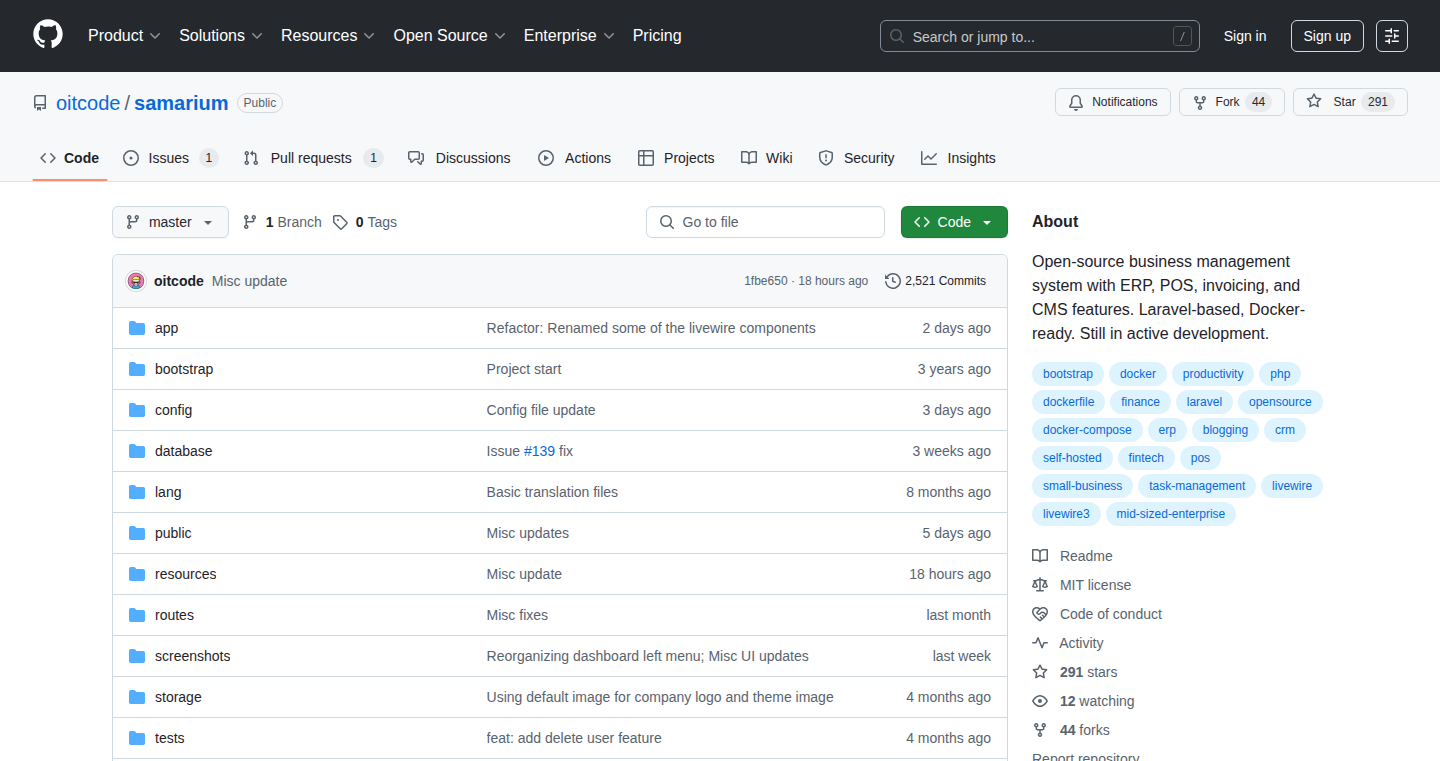
Author
azaz12
Description
BizFlow is an open-source business management tool tailored for small businesses. It streamlines core business processes, such as task management, client communication, and basic financial tracking, all within a single, customizable platform. The innovative aspect lies in its open-source nature, which allows for greater flexibility and customization compared to proprietary solutions, empowering businesses to adapt the tool to their specific needs. This addresses the common problem of inflexible, expensive business management software that doesn't quite fit the unique workflow of a small business.
Popularity
Points 1
Comments 0
What is this product?
BizFlow is essentially a digital hub for managing your business. It's built on open-source technologies, meaning the underlying code is freely available for anyone to inspect, modify, and redistribute. It takes the core elements of business management—like tracking tasks, keeping tabs on clients, and managing basic finances—and bundles them into one platform. The innovation is the open-source model: instead of being locked into a rigid, pre-defined system, you have the freedom to tailor BizFlow to your business's exact needs or leverage contributions from the developer community. So this offers greater control and adaptability than commercial solutions.
How to use it?
Developers can use BizFlow by either downloading and deploying the pre-built application or accessing the source code to customize it. They can integrate the platform into their existing tech stack, tailor it to the business's unique needs by modifying the code, or contribute new features and improvements back to the open-source project. For example, developers can extend the platform by creating plugins for integrations with other services or crafting custom reports for specific performance metrics. This is especially useful for businesses with specialized requirements or developers wanting to build a more tailored platform.
Product Core Function
· Task Management: Allows users to create, assign, and track tasks, ensuring projects stay on schedule. This is useful for project teams, or individual business owners to organize and monitor their work.
· Client Relationship Management (CRM): Provides a basic CRM to manage client information, track interactions, and improve communication. This helps businesses to maintain strong client relationships and improve customer satisfaction.
· Financial Tracking: Offers tools for basic financial management, such as tracking income, expenses, and generating basic financial reports. This helps small businesses to stay organized and monitor financial performance.
· Customization and Extensibility: Due to its open-source nature, users can customize the tool to meet their specific needs. This allows businesses to tailor their management tools to match their workflows.
Product Usage Case
· A small marketing agency can use BizFlow to manage client projects, track billable hours, and communicate with clients, all within a single platform. This streamlines project workflow and eliminates the need for multiple disconnected tools, improving efficiency and client satisfaction.
· A freelance developer can leverage BizFlow's CRM to organize client information and follow-up on leads. The developer could extend the financial tracking functionalities to integrate with payment gateways to automate invoicing and financial record-keeping. This increases business efficiency and helps with revenue tracking.
· A consulting firm can customize BizFlow by adding custom modules for project reporting and time tracking. This creates a tailored platform that allows for more specific monitoring of project activities. It helps track project progress and allocate resources more efficiently.
97
ChainTok: Bitcoin's Eternal Memory Ledger
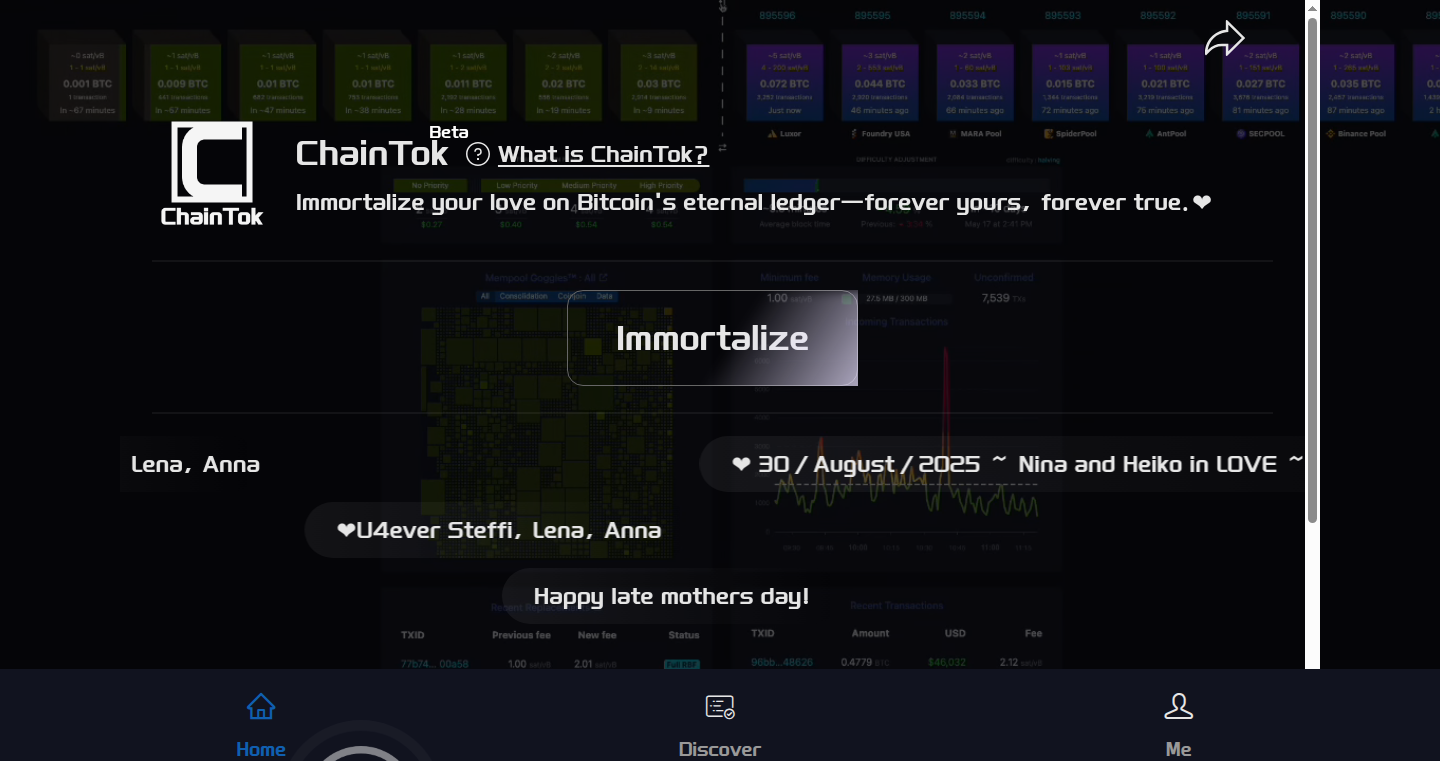
Author
zzhan
Description
ChainTok is a platform that allows users to permanently store memories, messages, or any digital content on the Bitcoin blockchain. It leverages the immutability and security of the blockchain to ensure these memories are preserved forever. The innovation lies in its user-friendly interface that simplifies the process of writing data to the blockchain, which is typically a complex technical operation. This project tackles the challenge of long-term digital preservation by using a decentralized and secure platform.
Popularity
Points 1
Comments 0
What is this product?
ChainTok works by encoding your content (text, images, etc.) and writing it into a Bitcoin transaction. Because Bitcoin transactions are recorded on a distributed, tamper-proof ledger (the blockchain), your data becomes virtually indestructible. Think of it as etching your digital memories into stone that no one can erase. The innovation is making this technical process super simple – just a few clicks. So what? You can securely and permanently preserve important data.
How to use it?
Developers can use ChainTok by integrating it into their applications to offer users permanent data storage. For example, a social media platform could allow users to 'etch' their posts on the blockchain for posterity. An e-commerce site could use it to record purchase receipts, ensuring the transaction history's integrity. The integration is done through ChainTok’s API(if any) or by manually constructing Bitcoin transactions to write specific data, offering developers a permanent data storage solution. So what? You can build applications that offer users guaranteed data persistence, improving trust and long-term value.
Product Core Function
· Memory Encoding: This function converts user content into a format suitable for storage on the Bitcoin blockchain. This process often involves hashing and embedding the content within a transaction. The value is that it ensures data integrity and efficient use of blockchain space. Application: Preserving digital art or important documents.
· Blockchain Transaction Generation: This function creates Bitcoin transactions containing the encoded memory data. It takes care of the technical details of interacting with the Bitcoin network. The value is making it easy for non-technical users to write data. Application: A simple way to immortalize tweets or other short-form content.
· Data Retrieval: This function allows users to retrieve their stored memories from the Bitcoin blockchain by identifying the transaction containing their data. The value is it ensures that users can always access their saved content. Application: Retrieving historical information or records.
· User-Friendly Interface: Providing a straightforward interface to interact with the complex blockchain technology. The value is accessibility – making the process simple for anyone, regardless of their technical skills. Application: Allows anyone to save a birthday message or important document on a decentralized ledger.
Product Usage Case
· Digital Time Capsule: A user wants to preserve a message to their future self. Using ChainTok, they can write a message to the Bitcoin blockchain. This message will be accessible forever. So what? It provides a way to create a lasting digital memory.
· Immutable Record Keeping: A business wants to store invoices and transaction records in an immutable format. They can use ChainTok to 'etch' these records onto the blockchain, guaranteeing they cannot be altered. So what? It makes your records trustworthy and secure.
· Art and Collectibles: An artist wants to ensure the provenance of their digital artwork. By using ChainTok to record the artwork's details on the blockchain, they can guarantee its authenticity. So what? It builds trust and value for digital art.
· Preserving Family History: A family wants to preserve photos and stories for future generations. They can upload these to ChainTok, ensuring the family history's longevity. So what? It makes it easy and secure to pass on your family heritage.
98
GST Calculator: Zero-Dependency Tax Computation Engine

Author
hapJam
Description
A lightweight, zero-dependency GST (Goods and Services Tax) calculator implemented as a Python library. The project focuses on providing accurate tax calculations without relying on external libraries, prioritizing simplicity, and ease of integration. It tackles the common problem of complex tax calculations by offering a streamlined, easily embeddable solution, especially beneficial for developers integrating tax features into their applications.
Popularity
Points 1
Comments 0
What is this product?
It's a Python library that calculates Goods and Services Tax (GST). The cool part is that it doesn't depend on any other complicated software or libraries to work. It's built from scratch. This is innovative because it makes it super easy to add tax calculations to any software you're building, keeping things simple and efficient.
How to use it?
Developers can easily incorporate this library into their Python projects. You simply install it using pip (like installing any other Python package) and then use its functions within your code to calculate GST on transactions. For example, if you're building an e-commerce platform or a billing system, you can use this library to automatically compute the GST for each item or invoice. So this makes it so easy to get tax calculation in your software.
Product Core Function
· GST Calculation: The primary function calculates the GST amount for a given price and tax rate. This simplifies the complex process of tax calculation, offering accuracy and speed. So this helps you correctly calculate taxes in seconds.
· Reverse GST Calculation: It computes the pre-tax price given the final price and tax rate. Useful for scenarios like breaking down the tax component of a received invoice. So this gives you clarity on the actual price without tax.
· Tax Rate Management: The library allows developers to easily configure and modify tax rates. This is essential for adapting to changes in tax regulations. So this allows you to be up-to-date with the current tax rates.
· Zero-Dependency Architecture: Because it needs no other libraries, it simplifies deployment and reduces potential conflicts. This means your code runs smoothly without external dependencies. So this means less trouble when you deploy your application.
Product Usage Case
· E-commerce Platforms: Integrate the GST Calculator to automatically compute taxes during checkout, ensuring compliance with tax regulations. So this makes sure you are following the law.
· Billing Systems: Include the library in invoicing software to accurately generate tax invoices, streamlining financial operations. So this helps in easy and correct invoice creation.
· Financial Modeling: Use the calculator in financial tools to forecast cash flows considering tax implications. So this lets you accurately predict how much money you will have.
· Point of Sale (POS) Systems: Employ the GST calculator in POS systems to generate tax receipts for retail transactions. So this simplifies sales for both seller and buyer.